




Your new environment is unique. We understand what you need to know to be successful in PNG, and· how to manage and enjoy both your business and private lives.
That's why we've provided the "Welcome Guide to Port Moresby" - the most comprehensive and up-to-date source of information you'll need. It's another reason why BSP is the number one choice for banking in Papua New Guinea and the South Pacific.
Contact us to obtain your copy today - bringing your bank closer, with hundreds of ATMs and more branches in more locations throughout PNG.
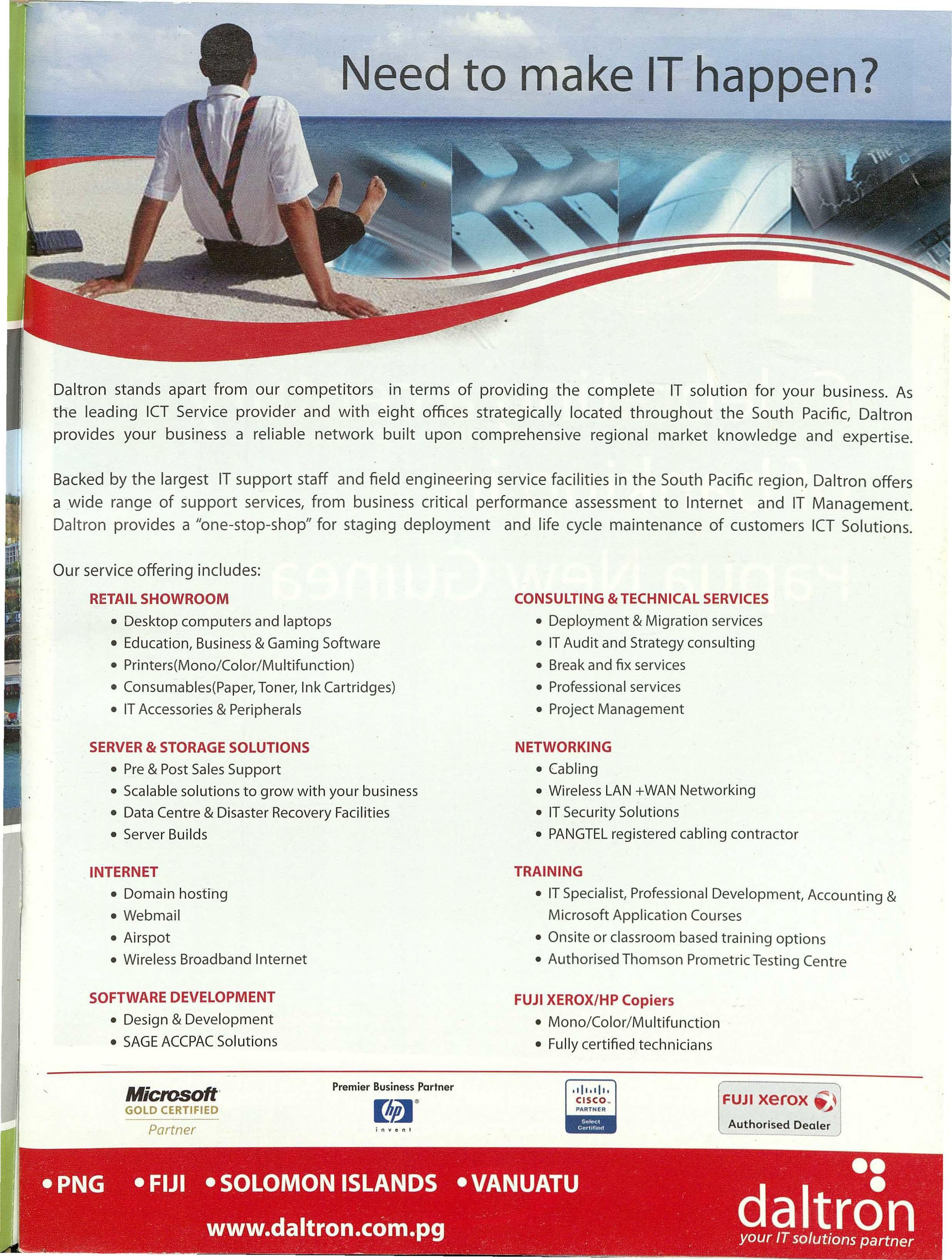
Daltron stands apart from our competitors in terms of providing the complete IT solution for your business. As the leading ICT Service provider and with eight offices strategically located throughout the South Pacific, Daltron provides your business a reliable network built upon comprehensive regional market knowledge and expertise.
Backed by the largest IT support staff and field engineering service facilities in the South Pacific region, Daltron offers a wide range of support services, from business critical performance assessment to Internet and IT Management. Daltron provides a "one-stop-shop" for staging deployment and life cycle maintenance of customers ICT Solutions.
Our service offering includes:
RETAIL SHOWROOM
• Desktop computers and laptops
• Education, Business& Gaming Software
• Printers(Mono/Color/Multifunction)
• Consumables(Paper,Toner, Ink Cartridges)
• IT Accessories& Peripherals
SERVER & STORAGE SOLUTIONS
• Pre & Post SalesSupport
• Scalable solutions to grow with your business
• Data Centre & Disaster Recovery Facilities
• Server Builds
INTERNET
• Domain hosting
• Webmail
• Airspot
• Wireless Broadband Internet
SOFTWARE DEVELOPMENT
• Design & Development
• SAGEACCPACSolutions
CONSULTING &TECHNICAL SERVICES
• Deployment & Migration services
• IT Audit and Strategy consulting
• Breakand fix services
• Professionalservices
• Project Management
NETWORKING
• Cabling
• Wireless LAN +WAN Networking
• IT Security Solutions
• PANGTELregistered cabling contractor
TRAINING
• IT Specialist, ProfessionalDevelopment, Accounting & Microsoft Application Courses
• Onsite or classroom based training options
• Authorised Thomson Prometric Testing Centre
FUJI XEROX/HP Copiers
• Mono/Color/Multifunction
• Fully certified technicians
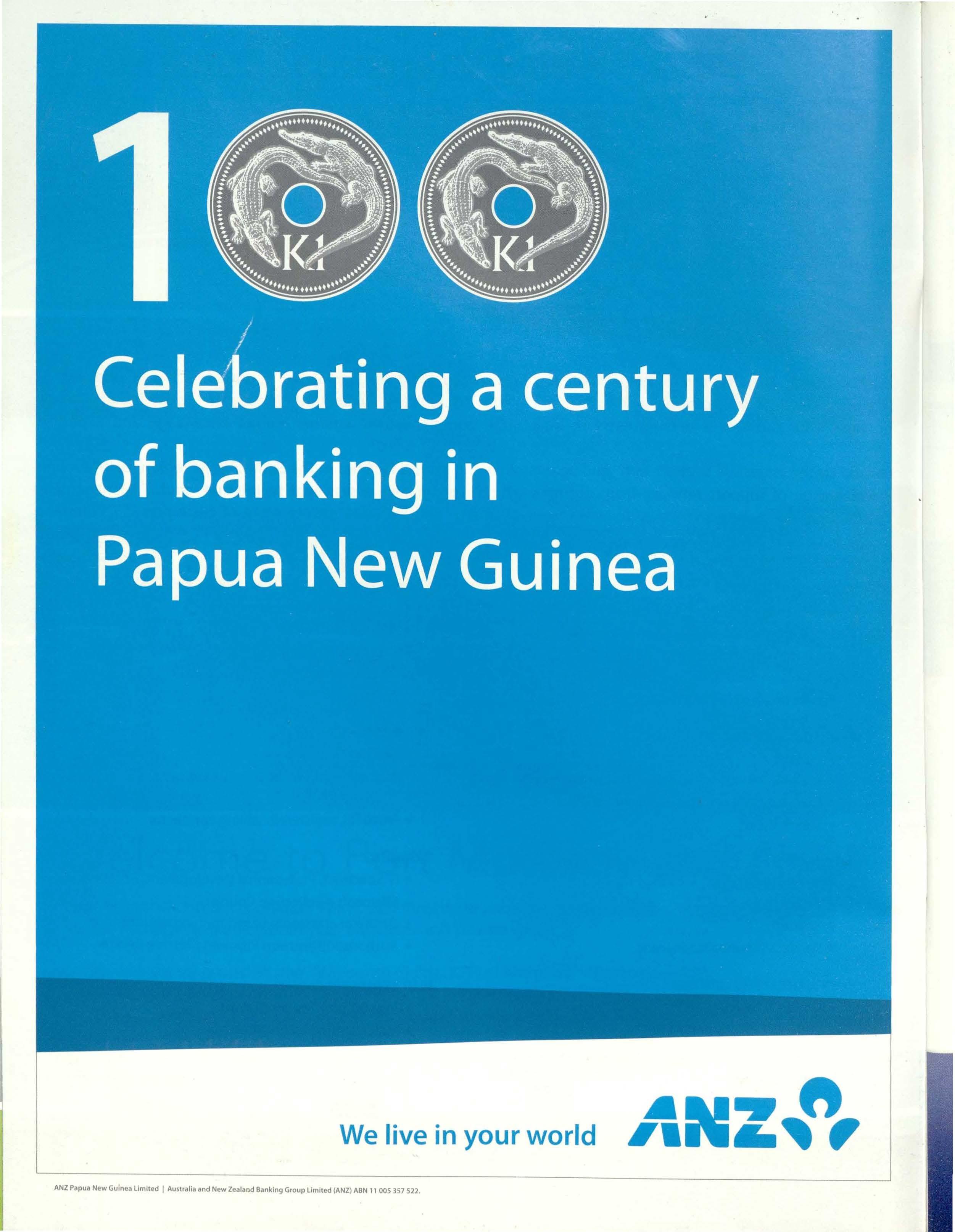
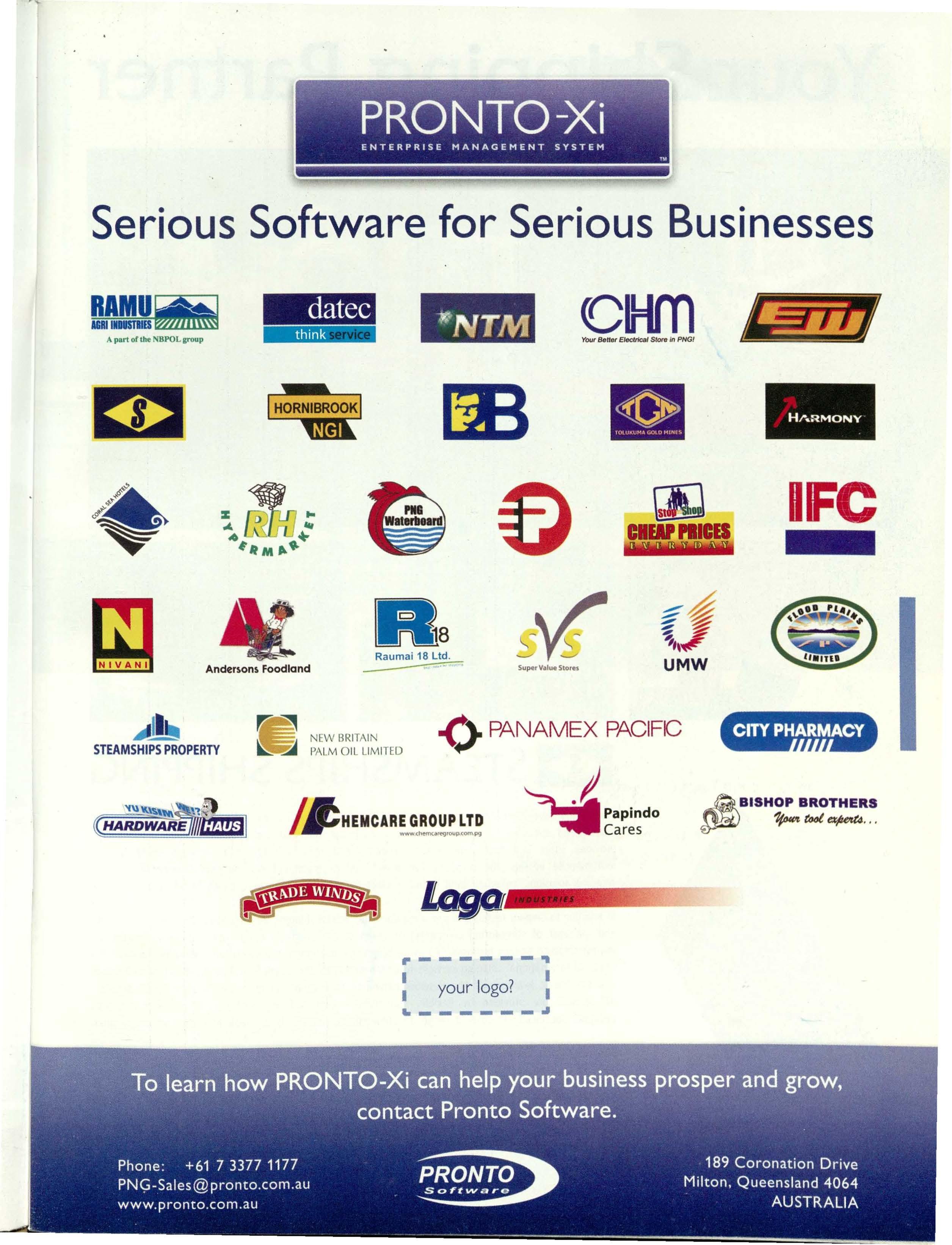
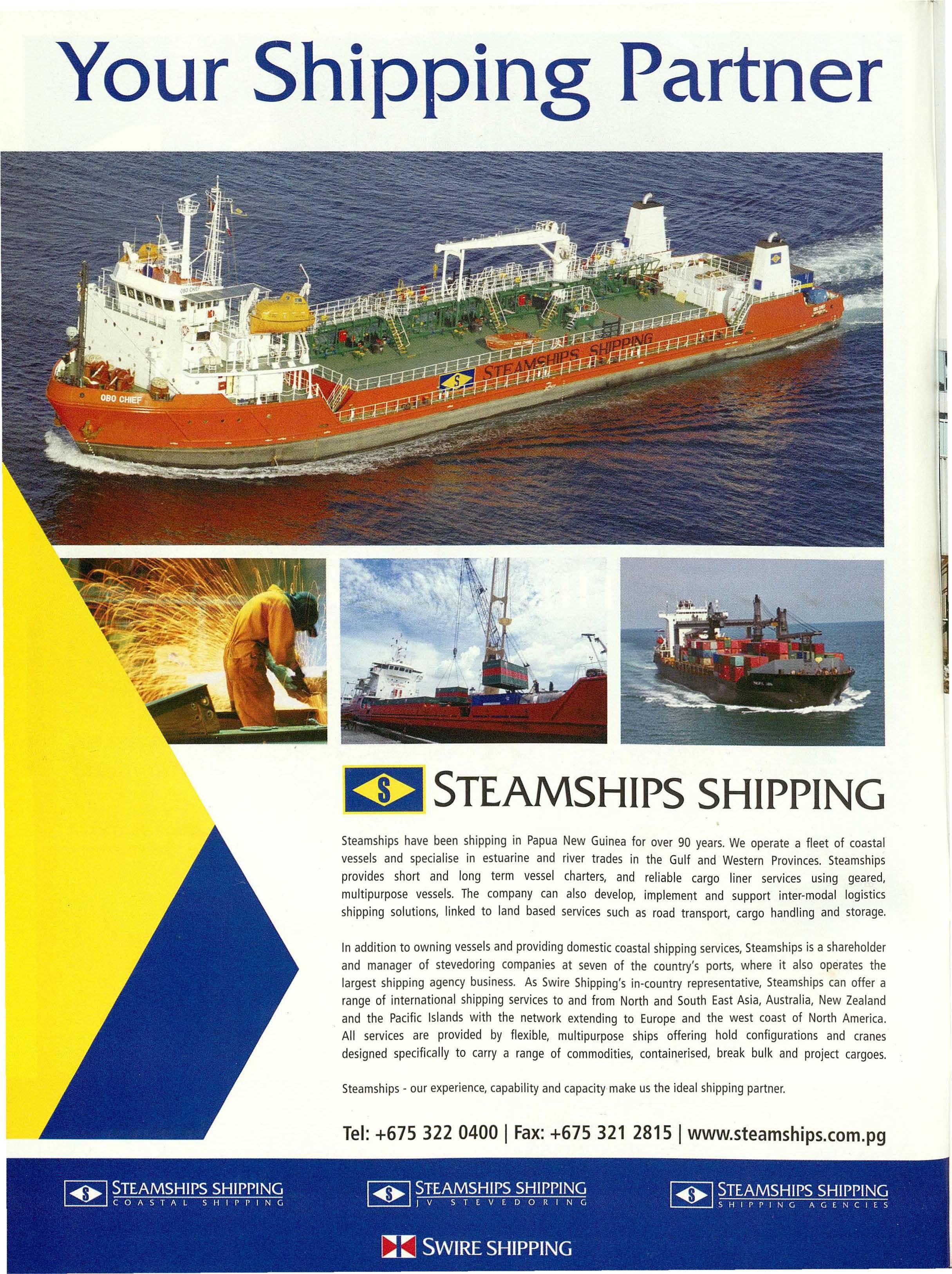
Steamshipshave been shipping in PapuaNew Guineafor over 90 years.We operate a fleet of coastal vesselsand specialisein estuarine and river trades in the Gulf and Western Provinces.Steamships provides short and long term vessel charters, and reliable cargo liner services using geared, multipurpose vessels.The company can also develop, implement and support inter-modal logistics shipping solutions, linked to land based servicessuch as road transport, cargo handling and storage.
In addition to owning vesselsand providingdomesticcoastalshippingservices,Steamshipsis a shareholder and manager of stevedoring companiesat seven of the country's ports, where it also operatesthe largest shipping agencybusiness.As Swire Shipping'sin-country representative,Steamshipscan offer a range of international shipping servicesto and from North and South EastAsia,Australia, New Zealand and the Pacific Islands with the network extending to Europeand the west coast of North America. All services are provided by flexible, multipurpose ships offering hold configurations and cranes designed specificallyto carry a range of commodities,containerised,break bulk and project cargoes.
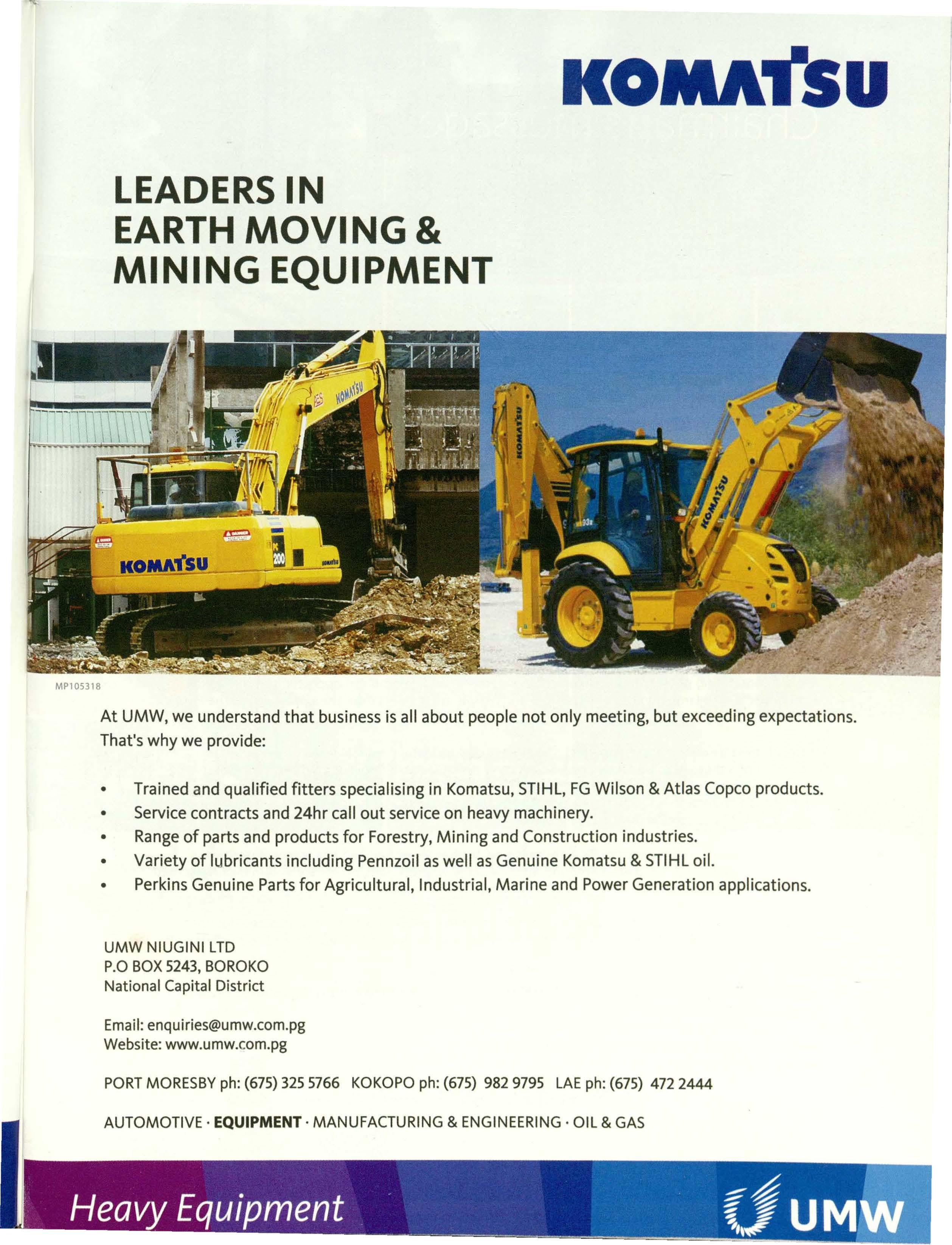
At UMW, we understand that business is all about people not only meeting, but exceeding expectations. That's why we provide:
• Trained and qualified fitters specialising in Komatsu, STIHL, FG Wilson & Atlas Copco products.
• Service contracts and 24hr call out service on heavy machinery.
• Range of parts and products for Forestry, Mining and Construction industries.
• Variety of ILJbricantsincluding Pennzoil as well as Genuine Komatsu & STIHL oil.
• Perkins Genuine Parts for Agricultural, Industrial, Marine and Power Generation applications.
UMW NIUGINI LTD
P.O BOX 5243, BOROKO National Capital District
Email: enquiries@umw.com.pg Website: www.umw.com.pg
PORT MORESBY ph: (675) 325 5766 KOKOPO ph: (675) 982 9795 LAE ph: (675) 472 2444
As this issue of PARADISE will cover December and January, we say goodbye to the old and welcome the New Year.
For Air Niugini, 2010 has been a significant year with many challenges and growth. During the year, we took delivery of a second B767 and two Dash 8 Q400 Next Generation aircraft which have boosted the fleet number to twenty. The introduction of the Q400 on the Port Moresby/Goroka route has been welcomed by the travelling public and already passenger numbers have indicated that the route needed a larger capacity aircraft than the Q300.
The second Boeing 767 on the international routes provided us with the opportunity to continue the current growth in the Asian markets such as Hong Kong and Singapore which have shown increased traffic. In addition, the second Boeing offers improved freight capacity on all the routes. Overall, the last quarter passenger numbers showed a pleasing growth from both international and domestic routes compared to last year. And, of course, we are expecting a very busy holiday season during December and January.
We are considering potential future market developments and commercial opportunities due to the LNG projects with large number of passenger and freight movements from the US, as well as the Pacific countries and the Asian continent to PNG.
With all these developments happening, the airline has successfully established e-ticket agreements with a number of airlines which effectively means that Air Niugini is able to ticket on these airlines' services. The appointment of a General Sales Agent (GSA) in Sri Lanka earlier this year and the recent appointment of a GSA in Bangladesh is in line to position Air Niugini to maximise its presence in these countries where passenger traffic is coming for the LNG projects.
In other airline developments, the PX website is now further revamped and has received positive comments. The Loyalty Program is entering into the stage where loyalty points are automatically accrued at the time of check-in.
We are also pleased to advise our valued customers that the airline now has a new business lounge at Narita Airport in Japan. The new lounge is the American Airlines Admirals Club, located within Terminal Two, main building.
On behalf of the board, management and staff of Air Niugini, I would like to thank you for your support and patronage throughout the year.
Have a wonderful festive celebration and we look forward to providing you with our Bird of Paradise service in the New Year.
Enjoy your flight
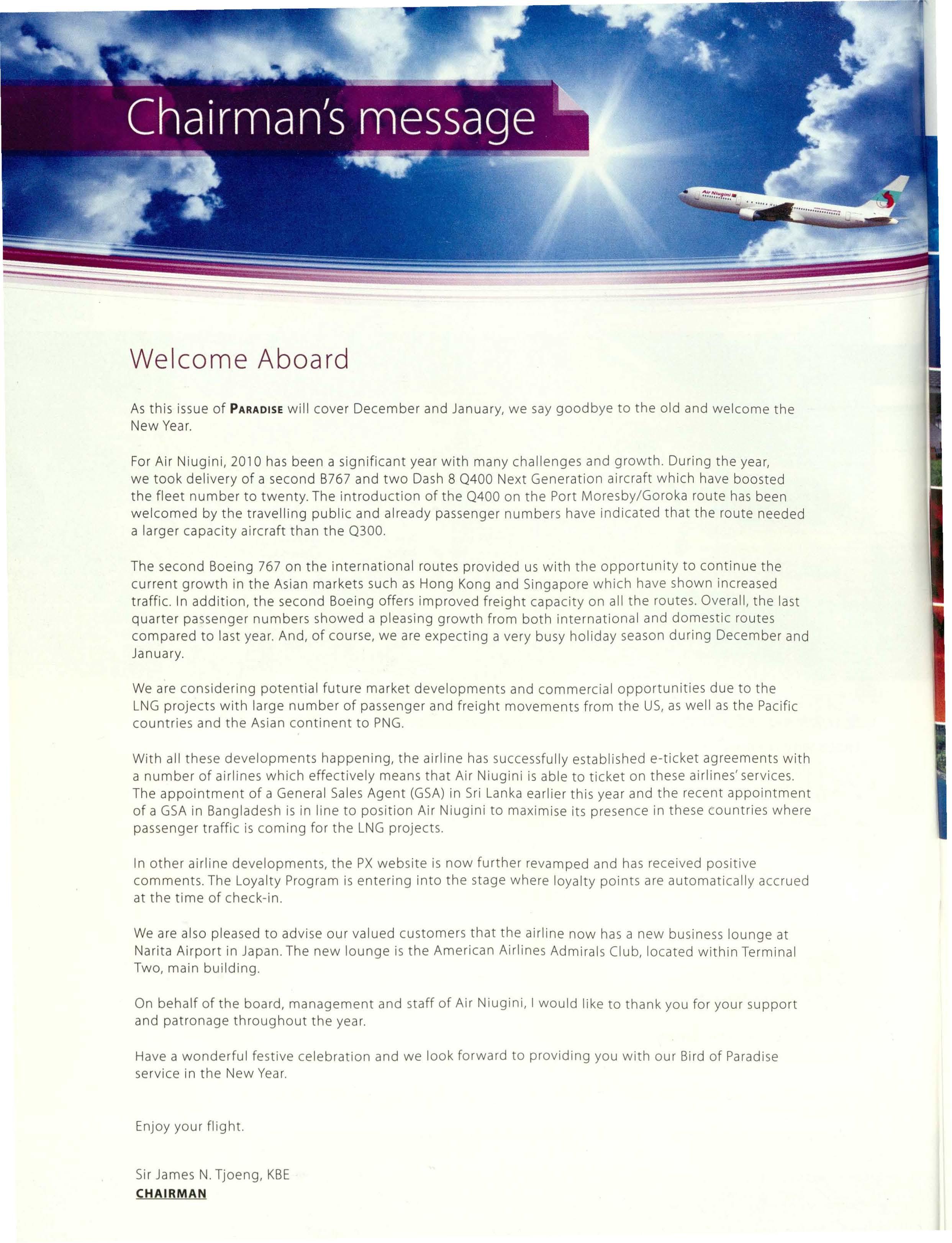
Sir James N. Tjoeng, KBE
CHAIRMAN
Hold your next convention at PNG's top Resort?
Unlike Port Moresby, we can offer diving, snorkelling, kayaks, sailing catamaran, tennis, marina, shopping, three restaurants, four pools, landscaped gardens with two lagoons and an unsurpassed absolute waterfront location. PNG's most stunning location for business, Madang

Resort offers five conference rooms and a convention centre catering for 5 - 400 delegates. Two hundred rooms, bungalows, cottages and townhouses all tastefully furnished with everything you would expect of a five star resort for less than you are probably paying in Port Moresby.
Discover the Madang Resort difference, call today.

Paradise is the complimentary inflight magazine of Air Niugini, Papua New Guinea's international airline. It is published six times a year by Islands Business international.
Publisher/Managing Director
Godfrey Scoullar
Group Editor-in-Chief Laisa Taga
Editorial Consultant EvaArni
Design Stanley Prasad
Advertising & Marketing Manager
Sharron Strettpn
Islands Business International
GPO Box 12718, Suva, Fiji Islands
Tel: +679 330 3108
Fax: +6793301423
E-mail: advert@ibi.com.fj
Correspondence to the airline to: The Chief Executive Officer AirNiugini POBox7186
Boroko, NCD, Papua New Guinea
Tel: +675 327 3458
Fax: +675 327 3550
Editorial correspondence to:
Paradise Inflight Magazine
PO Box 12718, Suva, Fiji Islands
Tel: +679 3303 108
Fax: +679 3301423
E-mail: editor@ibi.com.fj
Printing
Craft Inprint Pty Limited
Cnr Bilsen & Zillmere Roads Boondall, Queensland, 4034 Australia
Unsolicited manuscripts, artwork, transparencies and photographs are submitted at the sender's risk. While all care will be taken neither the publishers nor the airline will accept responsibility for accidental loss or damage. No part of this publication may be reproduced without the written permission of the publisher. Statements, opinions and points of view expressed by the writers are their own and do not necessarily represent those of the publisher, editor, or the airline. Information contained in this publication may be correct only at the time it was originally obtained by the writers and may be subject to change at any time and without notice.
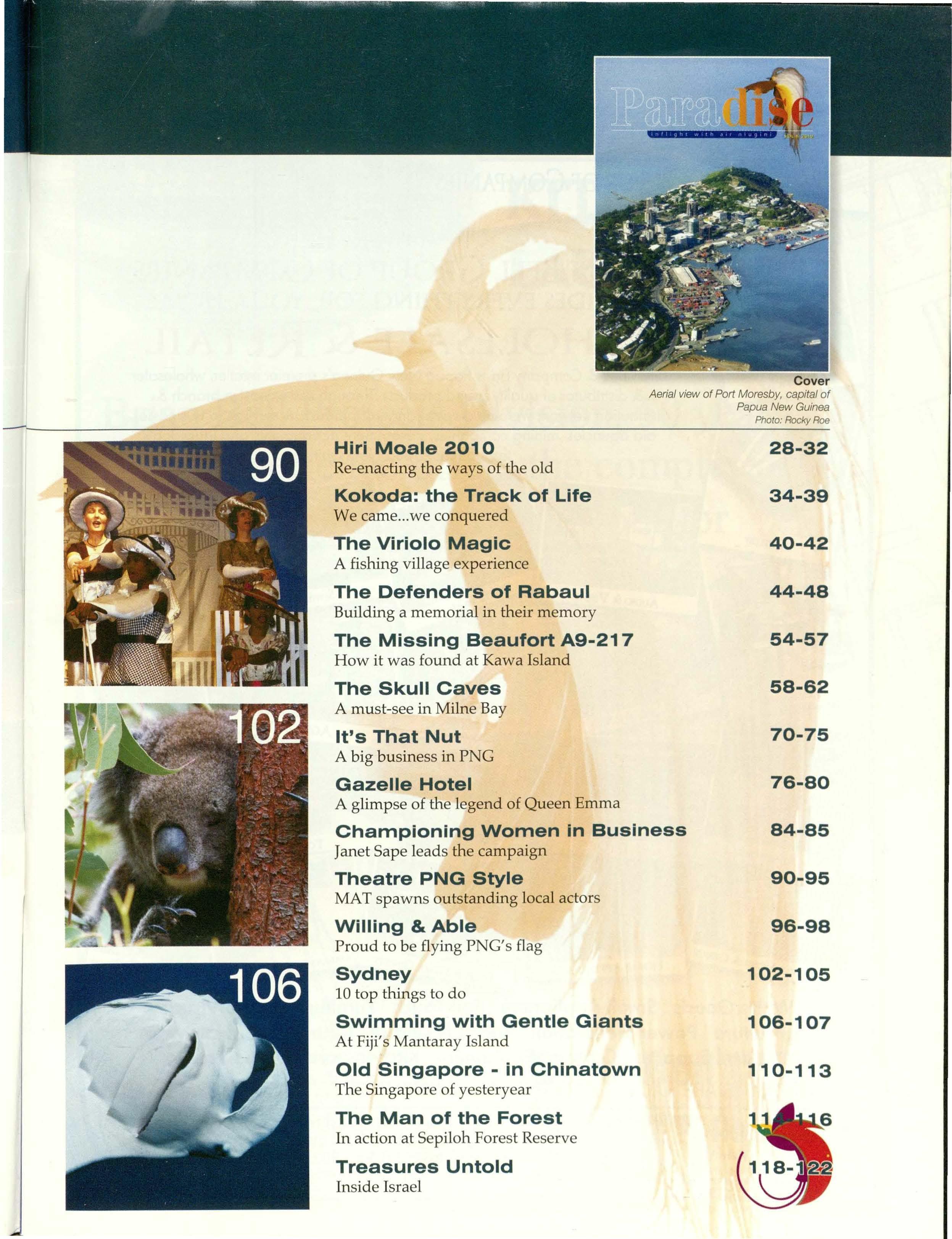
Hiri Moale 2010
Re-enacting the ways of the old
Kokoda: the Track of Life
We came we conquered
The Viriolo Magic
A fishing village experience
The Defenders of Rabaul
Building a memorial in their memory
The Missing Beaufort A9-217
How it was found at Kawa Island
The Skull Caves
A must-see in Milne Bay
It's That Nut
A big business in PN G
Gazelle Hotel
A glimpse of the legend of Queen Emma
Championing Women in Business
Janet Sape leads the campaign
Theatre PNG Style
MAT spawns outstanding local actors
Willing & Able
Proud to be flying PNG's flag
Sydney 10 top things to do
Swimming with Gentle Giants
At Fiji's Mantaray Island
Old Singapore - in Chinatown
The Singapore of yesteryear
The Man of the Forest
In action at Sepiloh Forest Reserve
Treasures Untold
Inside Israel

Brian Bell & Company Ltd is Papua New Guinea's premier retailer, wholesaler & distributor of quality brand products. Through our extensive branch & distribution network we offer a wide range of products & services to businesses, aid agencies, mining companies, government departments and individuals throughout Papua New Guinea.

Brian Bell Projects Division, 50 year
PNG experience offers the complete service - from design to fit-out for
Restaurants
Mining Sites
Hotels
Clubs
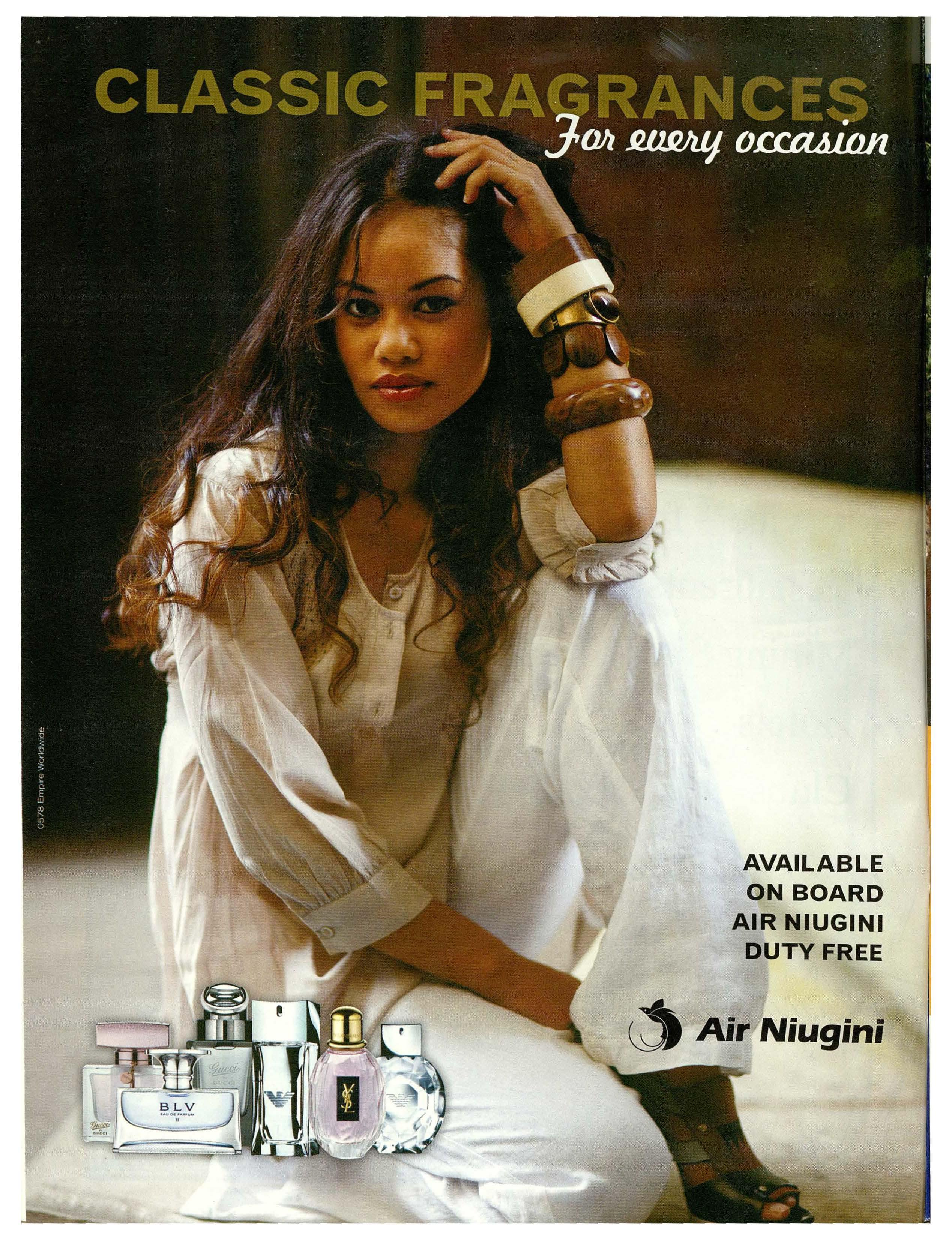

If there is anything our cabin crew can assistyou with during your flight, pleasedo not hesitateto askthem.
Pleaseensurethat your carry on luggage is placed in the overhead locker or under the seat in front of you.
Ensurethat your seat is in the upright position during takeoff and landing. Folding tables must be returned to their original position in the seat back or the armrest.
Your seat belt must be securelyfastened during take off and landing or whenever the seat belt sign is on. When the seat belt sign is off you may move about the cabin as necessary. Howeverwhile seated,keep your seat belt fastened securely in caseof unexpected turbulence.
Cellulartelephones,TV receiversor radio controlled devices are not to be used at any time on board an aircraft.Electronic devicessuch as portable computers,compact discsor cassetteplayersand video games can be used only when the seat belt sign is switched off.
The cabin crew will also be pleasedto assistin preparing your baby'sfood and bottle. Babyfood and diapersare also available. Pleasedo not hesitateto askour friendly cabin crew.
Smoking is not permitted on any Air Niugini flight.

A selection of moviesand music including classical, modern, country and local are availableon international services.Programmescan be found in the in-flight entertainment section of this magazine.
On Internationalflights, pillows and blanketsare available on requestfrom our cabin crew.
Our in-flight* mealshave been speciallypreparedfor your enjoyment. If you requirea vegetarianmeal or you are on a specialdiet, child or baby food, pleaseinform us when making your reservation.
During the flight take some time to look through our In-flight Duty Freebrochure located in your seat pocket. Duty free purchasescan be made after Meal Service. All major credit cardsare accepted.
During your flight, our cabin crew will distribute Immigration and Custom forms before each landing point. Ensurethat you carefullyread and complete these documents and havethem readyfor inspection with your passportat the Immigration and Customs arrivalcounters.
Pleasecheck your seat pocket and overheadlockers before you disembarkto ensureyou have not left any items of value.We look forward to seeingyou when you next fly with us on our Birdof ParadiseService.
Length: 59.94m
Wing span: 47.57m
Range: 8700km
Cruising speed: 857kph
Length: 47.3m
Wing span: 41.lm
Range: 4700km
Cruising speed: 857kph
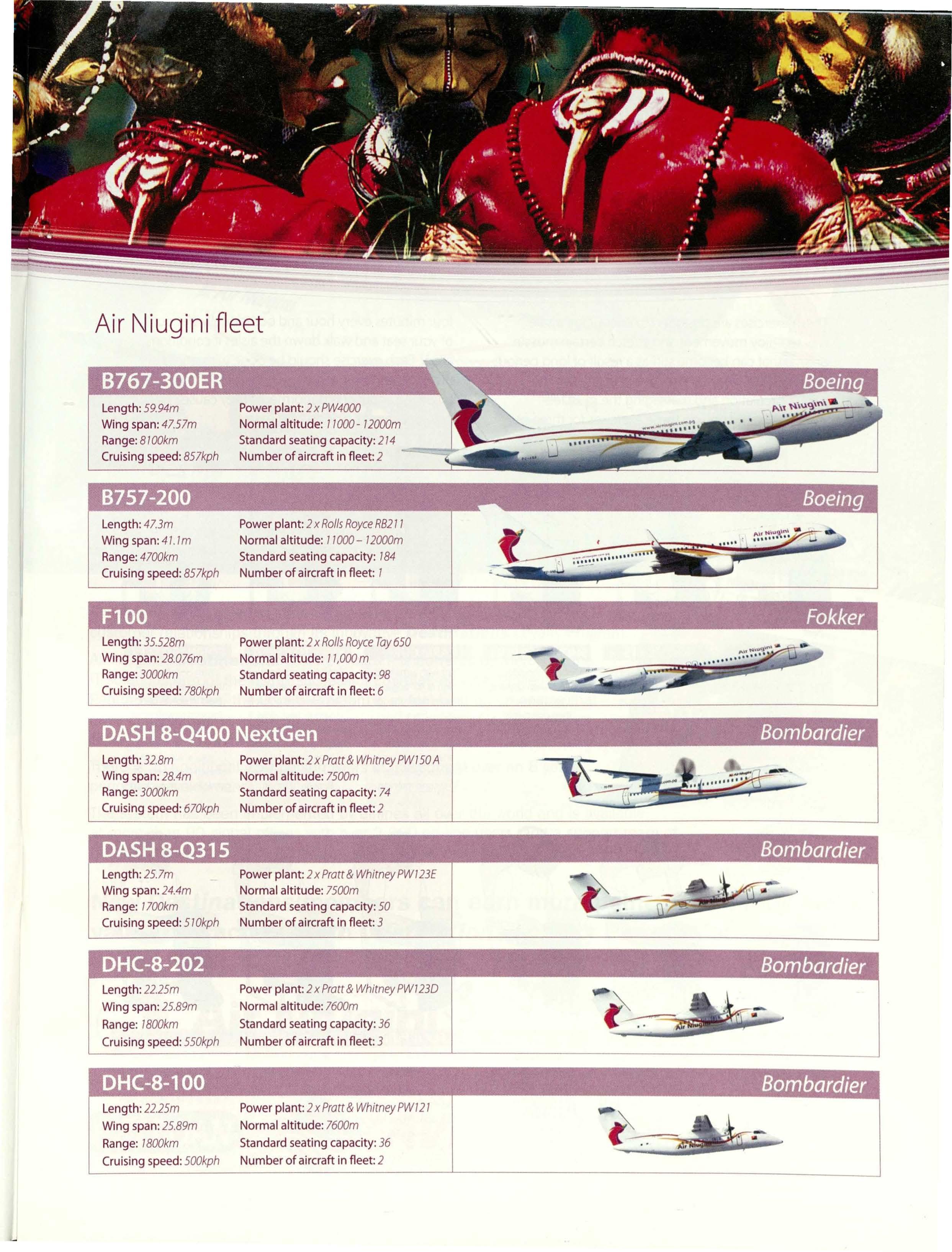
Standard seating capacity: 214
Number of aircraft in fleet: 2
Power plant 2 x RollsRoyceRB211
Normal altitude: 11000- 72000m
Standard seating capacity: 184
Number of aircraft in fleet: 7
Length: 35.528m
Wing span: 28.076m
Range: 3000km
Cruising speed: 780kph
Power plant: 2 x RollsRoyceTay650
Normal altitude: 11,000m
Standard seating capacity: 98
Number of aircraft in fleet: 6
Length: 32.8m
Wing span: 28.4m
Range: 3000km
Cruising speed: 670kph
Length: 25.7m
Wing span: 24.4m
Range: 1700km
Cruising speed: 570kph
DHC-8-202
Length: 22.25m
Wing span: 25.89m
Range: 1800km
Cruising speed: 550kph
DHC-8-100
Length: 22.25m
Wing span: 25.89m
Range: 7800km
Power plant 2 x Pratt& WhitneyPW150A
Normal altitude: 7500m
Standard seating capacity: 74
Number of aircraft in fleet: 2
Power plant: 2 x Pratt& WhitneyPW723E
Normal altitude: 7500m
Standard seating capacity: 50
Number of aircraft in fleet: 3
Power plant: 2 x Pratt& WhitneyPW123O
Normal altitude: 7600m
Standard seating capacity: 36
Number of aircraft in fleet: 3
Power plant: 2xPratt& WhitneyPW721
Normal altitude: 7600m
Standard seating capacity: 36
Cruising speed: 500kph Number of aircraft in fleet: 2
These exercises are designed to encourage a safe way to enjoy movement and stretch certain muscle groups that can become stiff as a result of long periods of sitting. They may be effective in increasing the body's circulation and massaging the muscles. We recommend you do these exercises for three or
four minutes every hour and occasionally get out of your seat and walk down the aisles if conditions allow. Each exercise should be done with minimal disturbance to other passengers. None of the following should be performed if they cause pain or cannot be done with ease.

Lift feet off the floor: Draw a circle with toes, simultaneouslymoving one foot clockwise and the other foot counter clockwise.
Reversecircles. Do each direction for 15 seconds. Repeatif desired.
Lift leg with knee Hunch shoulders bent while contraaing forward,then upward, your thigh muscle. then backward, Alternate legs. then downward Repeat20-30times using a gentle for,eachleg. circularmotion.
Startwith arms held Bendforward slightly. With both feet on high at 90°angle - Clasphandsaround the floor and stomach elbows down, hands left kneeand hug it held in slowly,bend out in front. Raise to your chest.Hold forward to walk your hands up to chest stretchfor 15 seconds. handsdown the front and back down Keepinghandsaround of your legstowards alternating arms. knee,slowly let it your ankles.Hold Do these exercisesin down. Alternatelegs. stretch for I 5 seconds 30 second intervals. Repeat10 times. and slowly sit back up.
Raiseboth arms straight up and over your head. With one hand grasp the wrist of the opposite hand and gently pull to one side. Hold stretch for 15 seconds. Repeatother side.
Reachright hand With shoulders over left shoulder. relaxed,drop ear to Placeleft hand behind shoulderand gently right elbow and gently roll neck forward and presselbow towards to the other side, shoulder.Hold stretch holding each position for 15seconds. about 5 seconds. Repeatother side. Repeat5 times.
Foot motion is in 2. Put both feet flat 3. Lift heelshigh, three stages. on the floor. keepingballsof feet 1. Startwith both heels on floor.Continue on the floor and point thesethree stageswith feet upwardsas high as continuousmotion in 30 secondintervals. you can.
WWw,airniugin1· ,com,pg
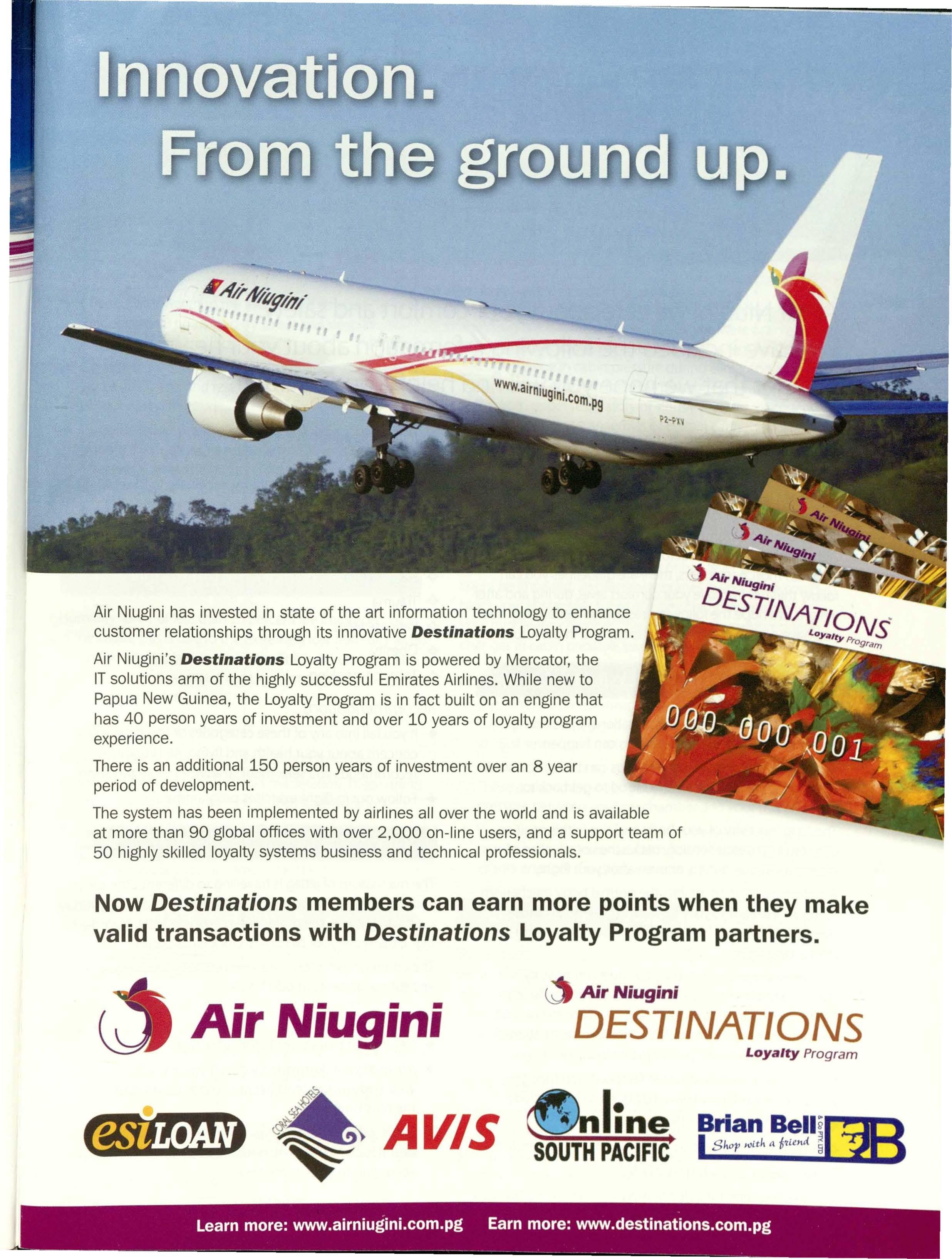
Air Niugini has invested in state of the art information technology to enhance customer relationships through its innovative Destinations Loyalty Program.
Air Niugini's Destinations Loyalty Program is powered by Mercator, the IT solutions arm of the highly successful Emirates Airlines. While new to Papua New Guinea, the Loyalty Program is in fact built on an engine that has 40 person years of investment and over 10 years of loyalty program experience.
There is an additional 150 person years of investment over an 8 year period of development.
The system has been implemented by airlines all over the world and is available at more than 90 global offices with over 2,000 on-line users, and a support team of 50 highly skilled loyalty systems business and technical professionals.
Now Destinations members can earn more points when they make valid transactions with Destinations Loyalty Program partners.
At Air Niuginiwe careaboutyourcomfortand safety. We haveincludedthe followinginformationabout your health in-flightthat we hopeyou will find helpfuland useful.
When you are flying you can be seated and be inactive for long periods of time. The environment can be low in humidity and pressurised up to an altitude of 2240 metres ab_ovesea level. Unlike other forms of transportation, air travel allows for rapid movement across many time zones, causing a disruption to the body's "biological clock". Although these unique factors do not pose a health or safety threat to most passengers, there are guidelines you can follow that will improve your comfort level, during and after a flight. We hope the following recommendations will help you have a more pleasant flight today and in the future.
When you're sitting upright in a stationary position for a long period of time, several things can happen.
The central blood vessels in your legs can be compressed, making it more difficult for the blood to get back to your heart.
The long inactivity of your body muscles in this position can result in muscle tension, back aches or a feeling of excessive fatigue during, or even after, your flight.
A stationary position inhibits the normal body mechanism for returning fluid to your heart, and gravity can cause the fluid to collect in your feet. This results in swollen feet after a long flight.
Studies have concluded that prolonged immobility may be a risk factor in the formation of clots in the legs (DVT - deep vein thrombosis). Particular medication and medical conditions may increase the risk of formation of clots if associated with prolonged immobility.
Medical research indicates that factors which may give you an increased risk of blood clots in the legs include:
Former or current malignant disease
Blood disorders leading to increased clotting tendency
Personal or family history of DVT
Immobilisation for a day or more
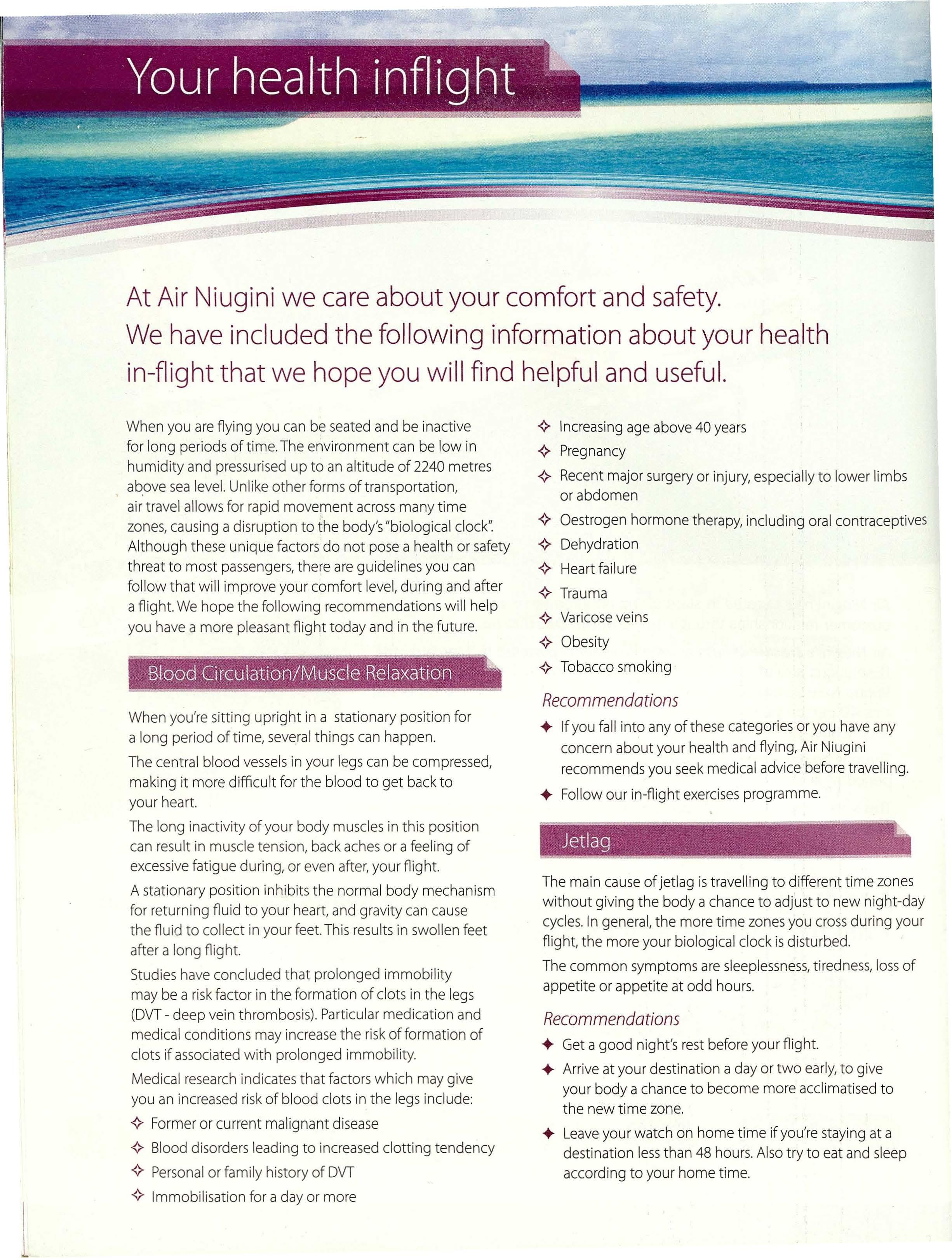
Increasing age above 40 years
Pregnancy
Recent major surgery or injury, especially to lower limbs or abdomen
Oestrogen hormone therapy, including oral contraceptives
Dehydration
Heart failure
Trauma
Varicose veins
Obesity
Tobacco smoking
If you fall into any of these categories or you have any concern about your health and flying, Air Niugini recommends you seek medical advice before travelling. Follow our in-flight exercises programme.
The main cause of jetlag is travelling to different time zones without giving the body a chance to adjust to new night-day cycles. In general, the more time zones you cross during your flight, the more your biological clock is disturbed.
The common symptoms are sleeplessness,tiredness, loss of appetite or appetite at odd hours.
Get a good night's rest before your flight.
Arrive at your destination a day or two early, to give your body a chance to become more acclimatised to the new time zone.
Leave your watch on home time if you're staying at a destination less than 48 hours. Also try to eat and sleep according to your home time.
Changeyour watch to the localtime if your stay is longer than 48 hours,and try to eat and sleepin accordancewith the localtime.
On longer stays,try to preparein advance, adjust your meal and resttimes to be closerto those of your destination.
Try some light exercise- go for a briskwalk,or do some reading if you can't sleepafter arrivalat your destination. It generallytakesthe body's biologicalclock approximatelyone day to adjust per time zone crossed.
Flydirect to minimiseflight time.This allowsyou to relaxmore upon arrival.
Humidity levelsof lessthan 25 percent are common in the cabin.This is due to the extremely low humidity levels of outside air supplied to the cabin.The low humidity can causedrying of the nose,throat, eyesand it can irritate contact lens wearers.
Recommendations
Drink water or juices frequently during the flight
Drinkcoffee,tea and alcohol in moderation.Thesedrinks acts asdiuretics,increasingthe body'sdehydration.
Removecontact lensesand wear glassesif your eyesare irritated.
Usea skin moisturiserto refreshthe skin.
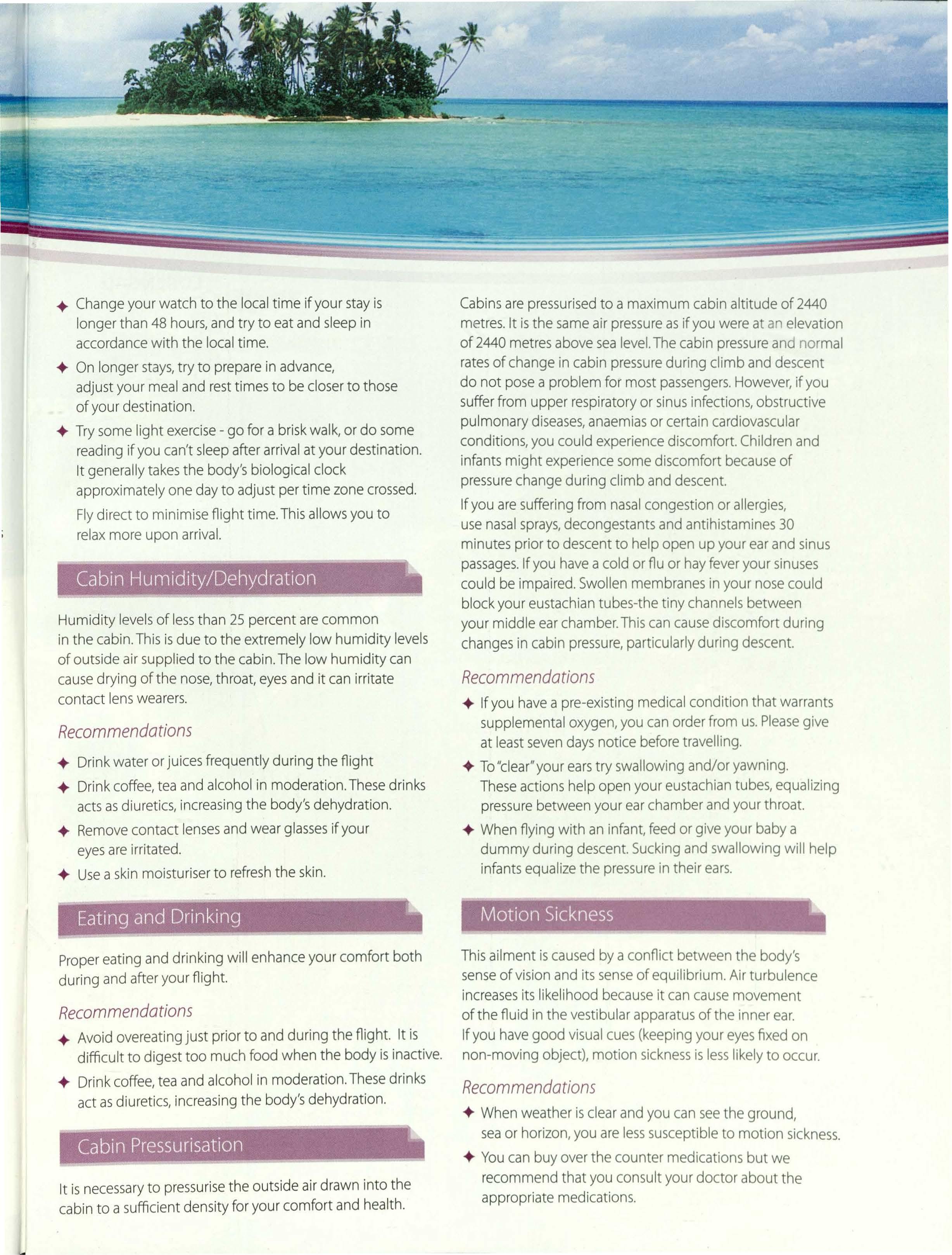
Propereating and drinking will enhanceyour comfort both during and after your flight.
Recommendations
Avoid overeatingjust prior to and during the flight. It is difficult to digest too much food when the body is inactive.
Drink coffee,tea and alcohol in moderation.Thesedrinks act as diuretics,increasingthe body'sdehydration.
It is necessaryto pressurisethe outside air drawn into the cabin to a sufficient densityfor your comfort and health.
Cabinsare pressurisedto a maximum cabin altitude of 2440 metres.It is the sameair pressureas if you were at an elevation of 2440 metresabove sealevel.The cabin pressureand normal ratesof change in cabin pressureduring climb and descent do not pose a problem for most passengers.However,if you sufferfrom upper respiratoryor sinusinfections,obstructive pulmonary diseases,anaemiasor certain cardiovascular conditions,you could experiencediscomfort.Childrenand infants might experiencesome discomfort becauseof pressurechange during climb and descent.
If you are sufferingfrom nasalcongestionor allergies, use nasalsprays,decongestantsand antihistamines30 minutes prior to descentto help open up your ear and sinus passages.If you havea cold or flu or hay feveryour sinuses could be impaired.Swollenmembranesin your nosecould block your eustachiantubes-the tiny channelsbetween your middle ear chamber.Thiscan causediscomfort during changesin cabin pressure,particularlyduring descent.
Recommendations
If you havea pre-existingmedicalcondition that warrants supplementaloxygen,you can order from us.Pleasegive at leastsevendaysnotice beforetravelling. To"clear"yourearstry swallowingand/or yawning. Theseactions help open your eustachiantubes,equalizing pressurebetween your ear chamberand your throat. When flying with an infant,feed or give your baby a dummy during descent.Suckingand swallowingwill help infantsequalizethe pressurein their ears.
Thisailment is causedby a conflict between the body's senseof vision and its senseof equilibrium. Air turbulence increasesits likelihood becauseit can causemovement of the fluid in the vestibularapparatusof the inner ear. If you havegood visualcues (keepingyour eyesfixed on non-moving object), motion sicknessis lesslikely to occur.
Recommendations
When weather is clearand you can seethe ground, seaor horizon,you are lesssusceptibleto motion sickness. Youcan buy over the counter medicationsbut we recommendthat you consult your doctor about the appropriate medications.
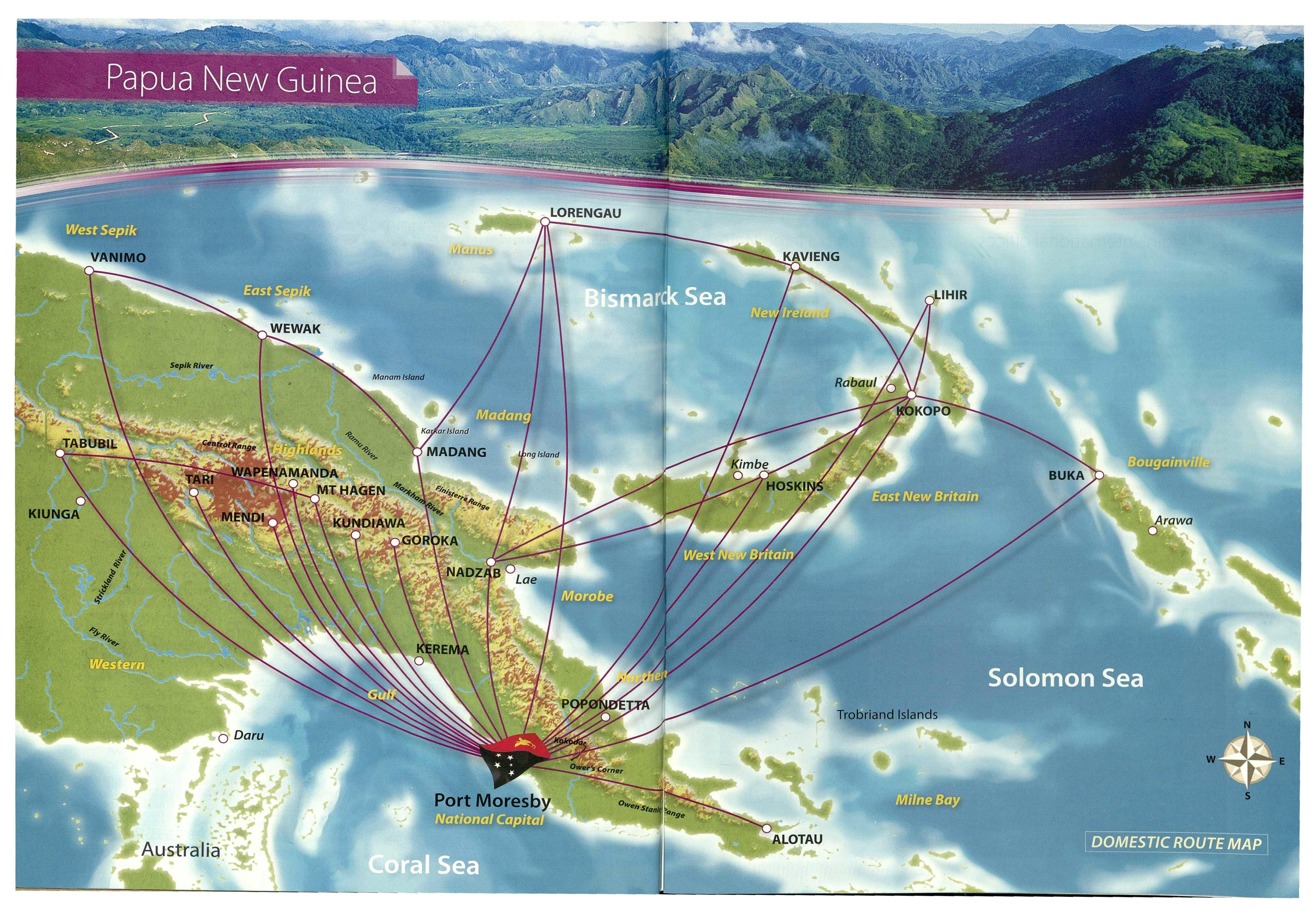
AIR NIUGINIOFFICES
AustraliaWide
LocalCall: 1300361 380
Sydney
SomareHouse
100 ClarenceStreet POBox 5293 SydneyNSW2001
AustraliaTel:(61 2) 9290 1544
Fax:(61 2) 9290 2026
Email:sales.sydney@airniugini.com.pg
Brisbane Level3, 97 CreekStreet
GPOBox 2216 BrisbaneOLD 4001
AustraliaTel:(61 7) 3221 1544
Fax:(61 7) 3220 0040
Email:sales.brisbane@airniugini.com.pg
Cairns
CairnsCorporateTower,Ground Floor 15 LakeStreetCairnsOLD4870Australia
Tel:(61 7)40311611
Fax:(61 7) 4031 3402
Email:sales.cairns@airniugini.com.pg
Manila
3rd Floor
Fortune Office Building 160 LegaspiStreet,LegaspiVillage, Makati City, Philippines
Tel:(63 2) 891 3339/40/41
Fax:(63 2) 891 3393
Email:sales.manila@airniugini.com.pg
Tokyo
6th FloorChiyoda Kaikan 1-6-17Kudan Minami
Chiyoda-KuTokyo 102-0074Japan
Tel:(81) 3 5216 3555
Fax:(81)3 5216 3556
Email:info@air-niugini.co.jp
Website:www.air-niugini.co.jp
Auckland/Cook Islands
WalshesWorld
Tel:(64)9379 3708
Fax:(64) 9302 2420
Fiji
Discount Flight Centre
Tel:(679)331 7870
Fax:(679)331 7873
Frankfurt
PacificDream
Tel:(49) 6963 4095
Fax:(49)6963 1332
Email:info@pngtourism.de
Hong Kong
TamWing Kun Holdings Ltd
Tel:(852)2527 7098
Fax:(852)2527 7026

Honiara
TravelIndustry Services
Tel:(67) 720 336
Fax:(67) 723 887
Email:kevin@gts.com.sb
Italy
SpazioSri
Tel:(39)6482 0280
Fax:(39) 6488 0862
Email:sales.rome@airniugini.com.pg
Jakarta
P.T.Ayuberga
Tel:(62) 218356214-217
Fax:(62) 21 835 3937
KualaLumpur
Abadi Aviation Services
Tel:(603)21484313
Fax:(603)2141 2322
Email:pxkul@abadi.com.my
LosAngeles
PNGTourism
Tel:(1) 949 752 5440
Fax:(1) 9494716 3741
Email:sales.usa@airniugini.com.pg
PortVila
VanuatuTravelServicesLtd
Tel:(67) 822 2836
Fax:(67) 823 3583
Seoul
Sharp Inc
Tel:(82) 2734 7100
Fax:(82) 2734 7108
Singapore
DeksAir
Tel:(65)6250 4868
Fax:(65)6253 3425
Email:px_sales@deksair.com.sg
Taipei
Cha MayTravelService
Tel:(88)6 2500 7811
Fax:(88) 6 2500 7970
United Kingdom
Flight Directors
Tel:(44)0870 24 00 767
Fax:(44)0870 24 02 208
Email:airniugini@fiightdirectors.com
Port Moresby Kavieng Madang Tabubil
POBox7186 Boroko
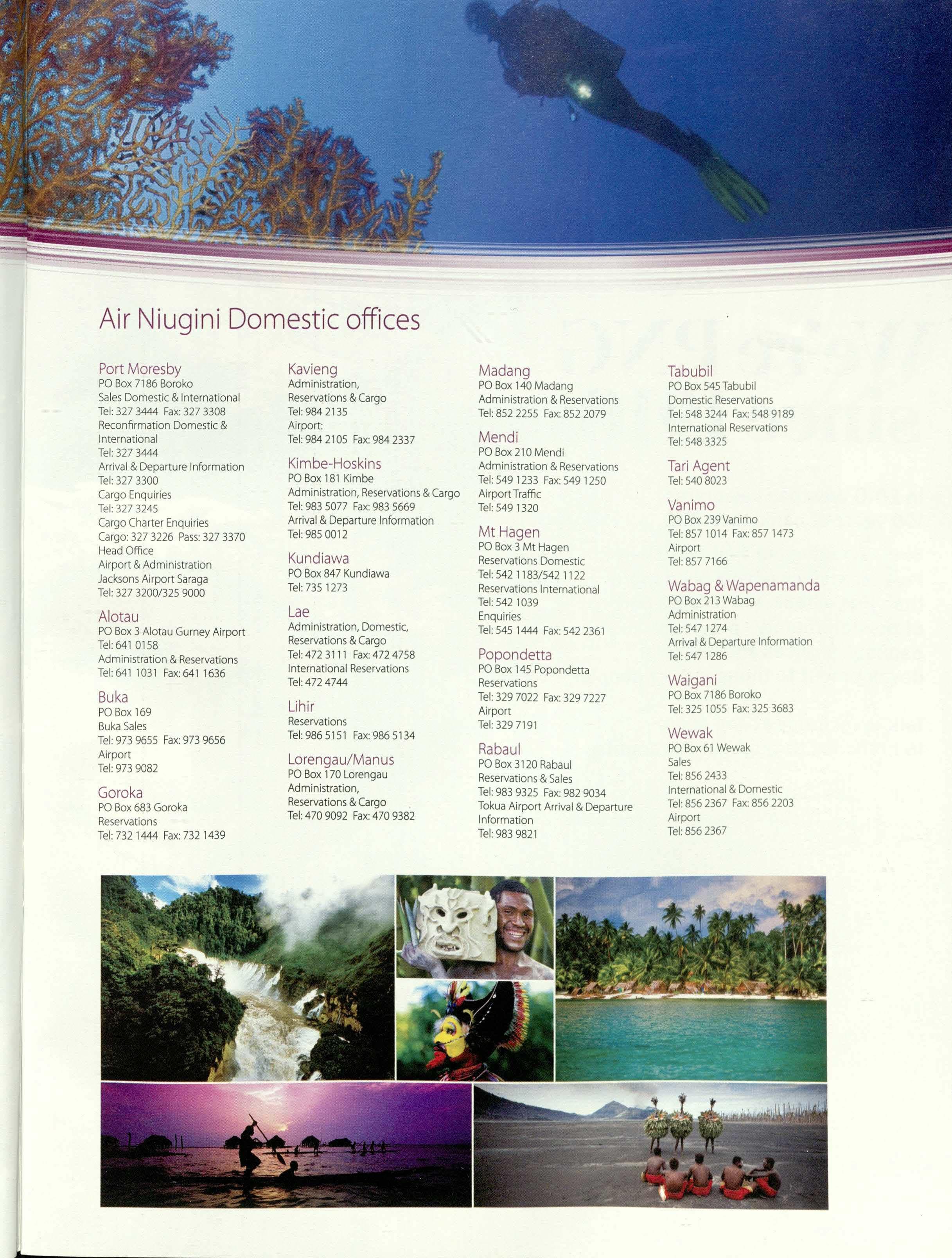
Administration, POBox 140 Madang
SalesDomestic& International Reservations& Cargo
Tel:327 3444 Fax:327 3308
Tel:984 2135
POBox545Tabubil
Administration & Reservations DomesticReservations
Tel:852 2255 Fax:852 2079
Tel:548 3244 Fax:548 9189
ReconfirmationDomestic& Airport: InternationalReservations International
Tel:327 3444
Arrival& DepartureInformation
Tel:327 3300
CargoEnquiries
Tel:327 3245
Tel:984 2105 Fax:984 2337 Mendi
Kimbe-Hoskins
POBox 181Kimbe
Tel:548 3325
POBox210 Mendi
Administration & Reservations TariAgent
Tel:549 1233 Fax:549 1250
Administration,Reservations& Cargo AirportTraffic
Tel:983 5077 Fax:983 5669
CargoCharterEnquiries Arrival& DepartureInformation
Cargo:327 3226 Pass:327 3370 Tel:985 0012
HeadOffice Kundiawa
Airport & Administration
JacksonsAirport Saraga
Tel:327 3200/3259000
Alotau
Tel:540 8023
Tel:549 1320 Vanimo
Mt Hagen
POBox847 Kundiawa
Tel:735 1273
Lae
POBox239Vanimo
Tel:857 1014 Fax:857 1473
POBox3 Mt Hagen Airport
ReservationsDomestic
Tel:542 1183/5421122
Tel:857 7166
ReservationsInternational Wabag& Wapenamanda
Tel:542 1039
Enquiries
POBox3 Alotau GurneyAirport Administration,Domestic, Tel:545 1444 Fax:542 2361
POBox213Wabag
Administration
Tel:547 1274
Tel:641 0158 Reservations& Cargo Arrival& DepartureInformation
Administration& Reservations Tel:472 3111 Fax:472 4758 Popondetta
Tel:641 1031 Fax:641 1636
InternationalReservations
POBox 145 Popondetta
Tel:547 1286
Tel:472 4744 Reservations Waigani
Buka Lihir
Tel:329 7022 Fax:329 7227
POBox 169 Airport
BukaSales Reservations
Tel:973 9655 Fax:973 9656
POBox7186 Boroko
Tel:325 1055 Fax:325 3683
Tel:329 7191
Tel:986 5151 Fax:986 5134 Wewak Airport Rabaul
Lorengau/Manus
Tel:973 9082
POBox61 Wewak
POBox3120 Rabaul Sales POBox 170 Lorengau
Reservations& Sales
Tel:856 2433 Goroka Administration, Tel:983 9325 Fax:982 9034 International& Domestic
POBox683 Goroka Reservations& Cargo TokuaAirport Arrival& Departure
Reservations
Tel:732 1444 Fax:732 1439
Tel:856 2367 Fax:856 2203
Tel:470 9092 Fax:470 9382 Information Airport
Tel:856 2367
Tel:983 9821
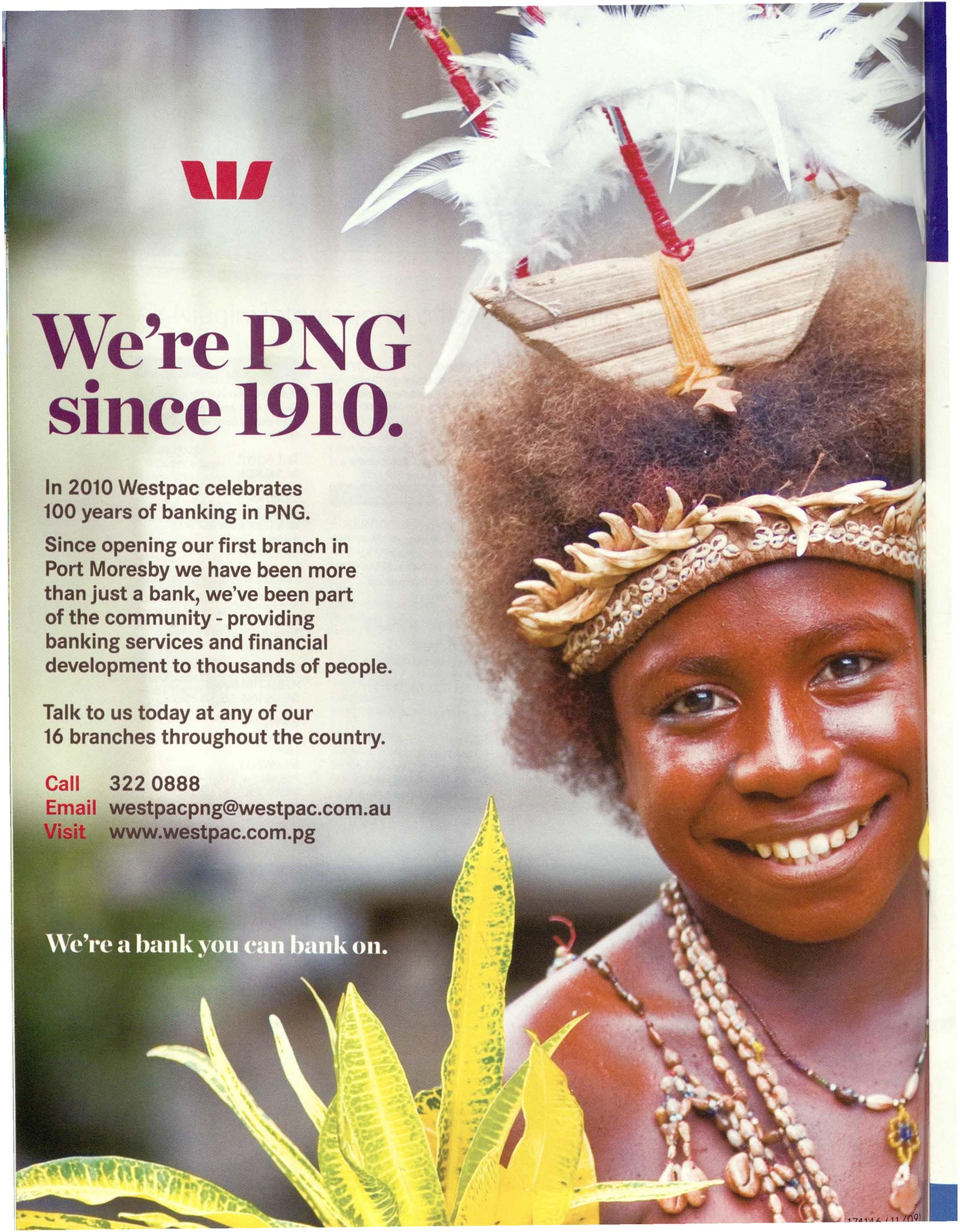
In 2010 Westpac celebrates 100 years of banking in PNG. Since opening our first branch in Port Moresby we have been more than just a bank, we've been part of the community - providing banking services and financial development to thousands of people.
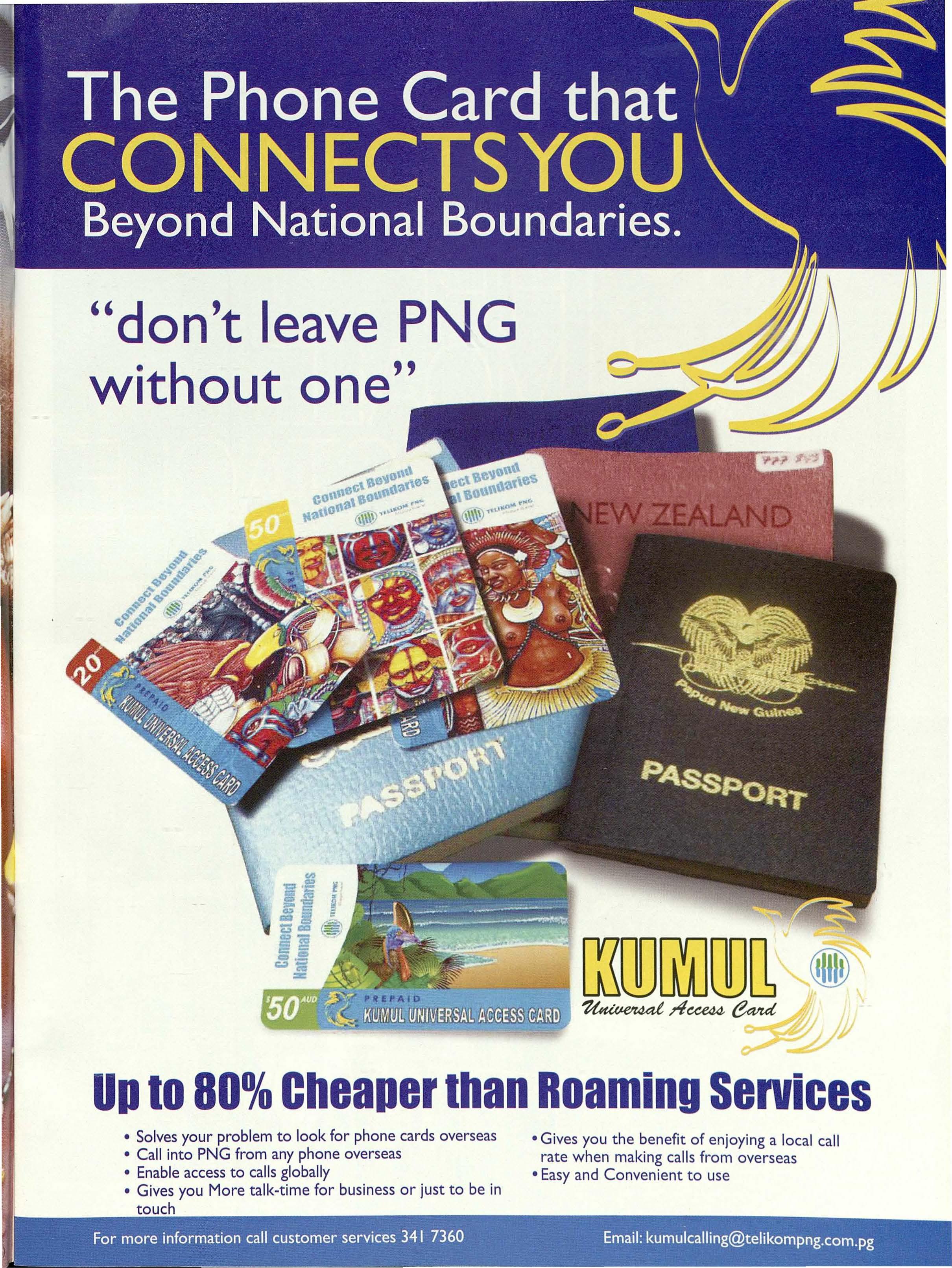
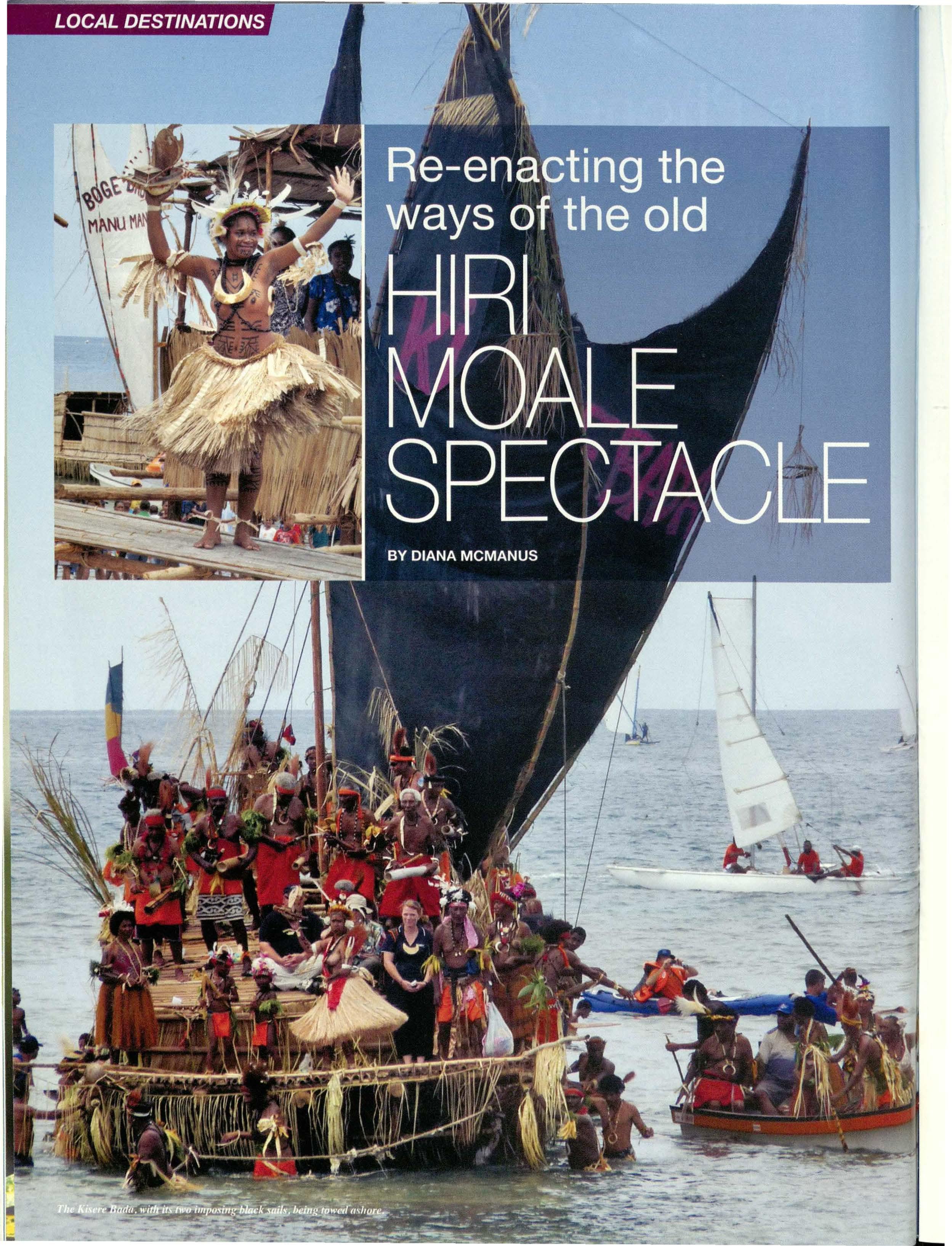
The crowd await the arrival of the lakotois. Below is Manumanu's Boge Bada.

There's nothing quite like the sense of excitement and history which prevails when the huge sails of the /akatois loom on the horizon and the chanting and singing of those on-board echoes across the water.
n shore, the eager villagers are out in force matching the dancing and singing, filled with a sense of anticipation and joy. Historically, the menfolk come home after anything up to nine months away. Womenfolk emerge from seclusion to celebrate the safe return of their husbands and lovers. This is Hiri Moa/e! This historical tradition forms the backbone of Port Moresby's annual independence celebrations.
The word Hiri refers to the traditional coastal trade which took place along the Papuan coast between Motu and Erema (Kerema) villages. Traditionally, the low lying villages of the west would trade their sago, amongst other things for the coveted clay cooking pots of the drier Port Moresby area.
The departure of the lakatois depended upon the seasonal winds. This historical ocean trade is dear to the hearts of all Motuan villages along Papua's coast and embodies their sense of unity and cultural uniqueness.
As Papua New Guinea celebrated its 35th year of independence, the Hiri Moale Festival was bigger and better than ever. Spanning three days, it culminates in the crowning of the Hiri Moa/e Queen at the Hubert Murray Stadium.
Motu villages in the Port Moresby region prepare for this event well before independence on September 16. Each village has its own contest to see who will be their Queen and contest the coveted title.
For the village, it's a sense of pride and honour. For the Hiri Moale Queen, there are many lovely prizes, but it also means a prestigious boost when it comes to the marriage stakes and possible bride price.
Two villages each year are selected by the organising committee to build a /akatoi - a traditional ocean going trading vessel - and sail it to Port Moresby. The skills that this requires brings out the knowledge of the old people and keeps it alive in the youth who have the energy and enthusiasm to sail these behemoths.
Made from two or three huge logs, these vessels need to be fitted out with shelters for the sailors and traders, and for trading goods. Then they need masts, steering gear and one or two of the distinctively shaped /akatoi sails.
This year, it was the villages of Manumanu, to the east; and Gaire, to the west, which created the /akatois. Manumanu's vessel was named Boge Bada, the name of the sea eagle, and
The higillydecoratedKisereBadahad 70 villagerson-board.Right: The Hiri Moalequeensemergefrom theirspeciallybuilt huts after the arrivalof the lakotois. represented the feminine side of the Motuan culture with its one white sail. Gaire, on the other hand, exuded sheer masculinity with its two imposing black sails. It was named Kisere Sada after the village's nearby mountain.
The womenfolk of each village practise their dancing and singing for the big day when they will re-enact the old times and welcome their menfolk at Ela Beach, where the vessels will land. This year, the Manumanu women looked resplendent in their newly made crinkled pandanus skirts for which the eastern Motuans are well known.
Meanwhile, the Hiri Moale queens, representing all young women of the Motu-Erema villages, await the arrival in the custom-made houses built on the beach. After the vessels beach, their passengers alight and gifts of food are made by the villagers to the Chairman of the Motu Koitabu Assembly (Mr Miria lkupu this year).
Speeches are made by the 'baditaunas', skippers of the lakatois, then the girls emerge one by one to symbolise the welcome home and their liberation from home seclusion.
The arrival of the lakatois was a very joyful occasion, hence the word Moale, meaning happiness. The girls' traditional tattoos are painted on these days by knowing relatives. These have special significance as to the social status of the wearer.
Their swishing and swaying dance from the huts along the walkways and to the shore, is the final test involved in the selection process of the Hiri Hanenamo Quest, It is accompanied by a group of Motuans singing and making rhythm to Hehona, a well-known sacred song, as the judges come to their final conclusion. This is announced at the Hubert Murray Stadium on Sunday, where the girls
will once again sway their way down the grandstand amidst roaring and cheering as the skirts flip up to reveal lightning glimpses of thighs and buttocks which excite the crowd.
There, the winner is announced and prizes handed out accordingly. This year's Hiri Hananamo is Kaia Morea Hila from Hanuabada (Poreporena lahara), the very large stilt village on the shore of Port Moresby harbour.
The arrival of the lakatois is always
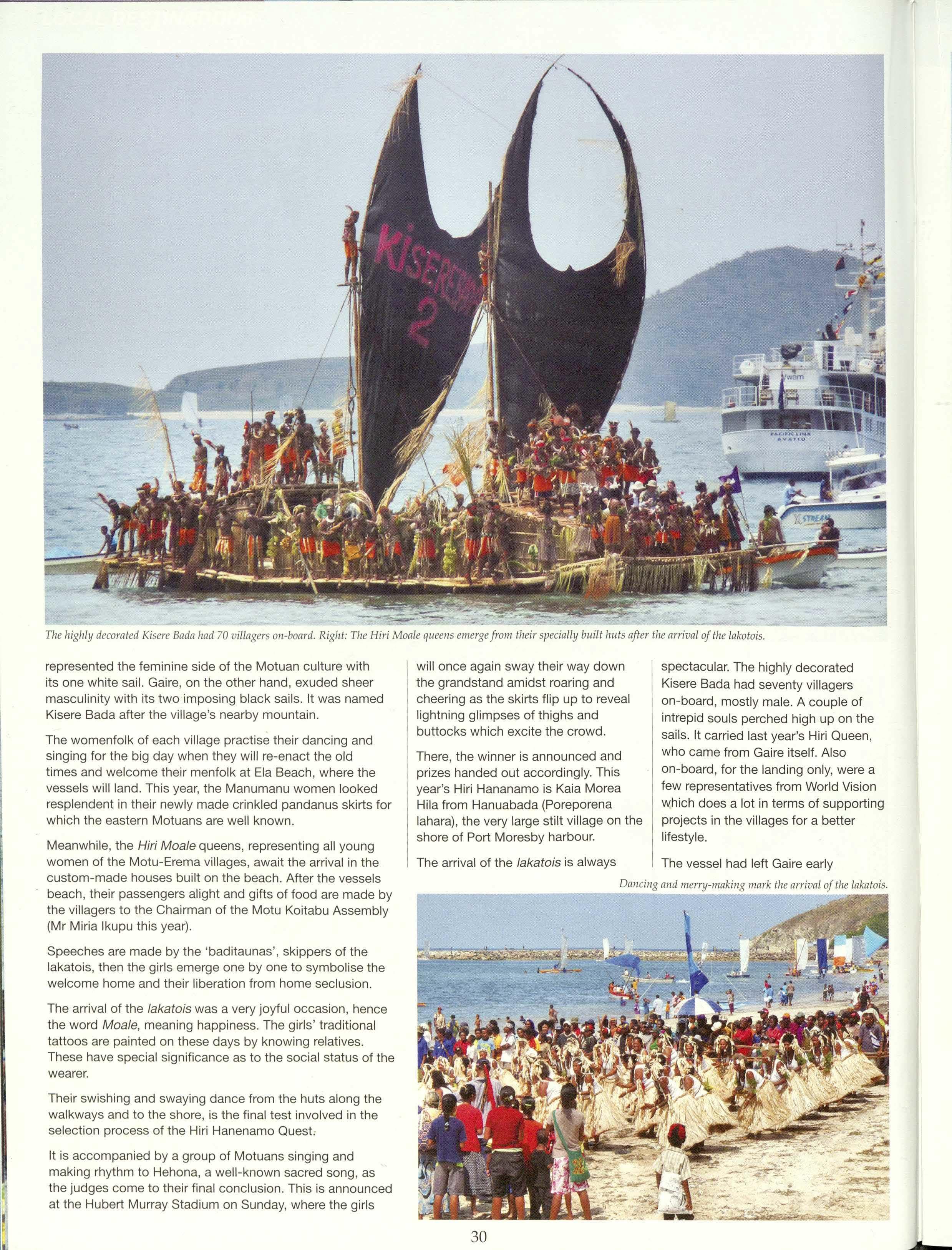
spectacular. The highly decorated Kisere Sada had seventy villagers on-board, mostly male. A couple of intrepid souls perched high up on the sails. It carried last year's Hiri Queen, who came from Gaire itself. Also on-board, for the landing only, were a few representatives from World Vision which does a lot in terms of supporting projects in the villages for a better lifestyle.
The vessel had left Gaire early Dancingand merry-makingmark the arrivalof the lakatois.

...the girls will once again sway their way down the grandstand amidst roaring and cheering as skirts flip up to reveal lightning glimpses of thighs and buttocks which excite the crowd.
Thursday afternoon and now it was Saturday. Imagine how eager the passengers were to get ashore. And imagine what it must have been like for the traders of yesteryear, many of them never made it ashore again, being victims of wild winds and capsized craft.
In Vincent Eri's novel The Crocodile, which provides insights into traditional Papuan village life, there is a short reference to the hero Hoiri's lucky escape from one such incident.
"His first great /akatoitrip had ended in disaster. The smell of salt water still filled his lungs. He was glad, though, that they had capsized at Mirivase, at the mouth of the Lakekamu River. It was only a half-day's journey from Moveave. Thank God not much property was lost. Their clothes had dried several hours after the lakatoi had been refloated "
Unfortunately, there was not enough wind on this particular festival Saturday morning and the two lakatois had to be towed in by a couple of banana boats with their super horse powered outboards. The inevitable delay meant the tide became very low.
Consequently most of the crew of the Kisere Sada leapt into the shallows for the final hundred metres and assisted in hauling the craft ashore. This didn't dampen any spirits however, nor detract from the spectacle.
The arrival of the lakatois is always greeted with enormous enthusiasm by the Port Moresby public and thousands of people flock to the beachside. Many of them have been there for hours preparing their colourful outrigger canoes for the popular canoe races which begin after the welcome. The beachfront is packed with people.
Vendors line the pathways selling drinks, snacks and sizzling sausages. Families gather in little groups with their pots of food to picnic from throughout the day. By early afternoon, there was a light enough breeze for the colourful flotilla of canoes to engage in the highly
popular races, with the first three places taken out by canoes from the Hula village area.
The festival itself begins on Independence Day, September 16. Schools have had their cultural celebration days by now, and work places continue to encourage their employees to dress in traditional attire.
All around the city arenas and large public spaces are prepared as forums for speeches, and people and places are awash in the gold, red and black colours of PNG. Local bands, singers and dancers add light relief to these
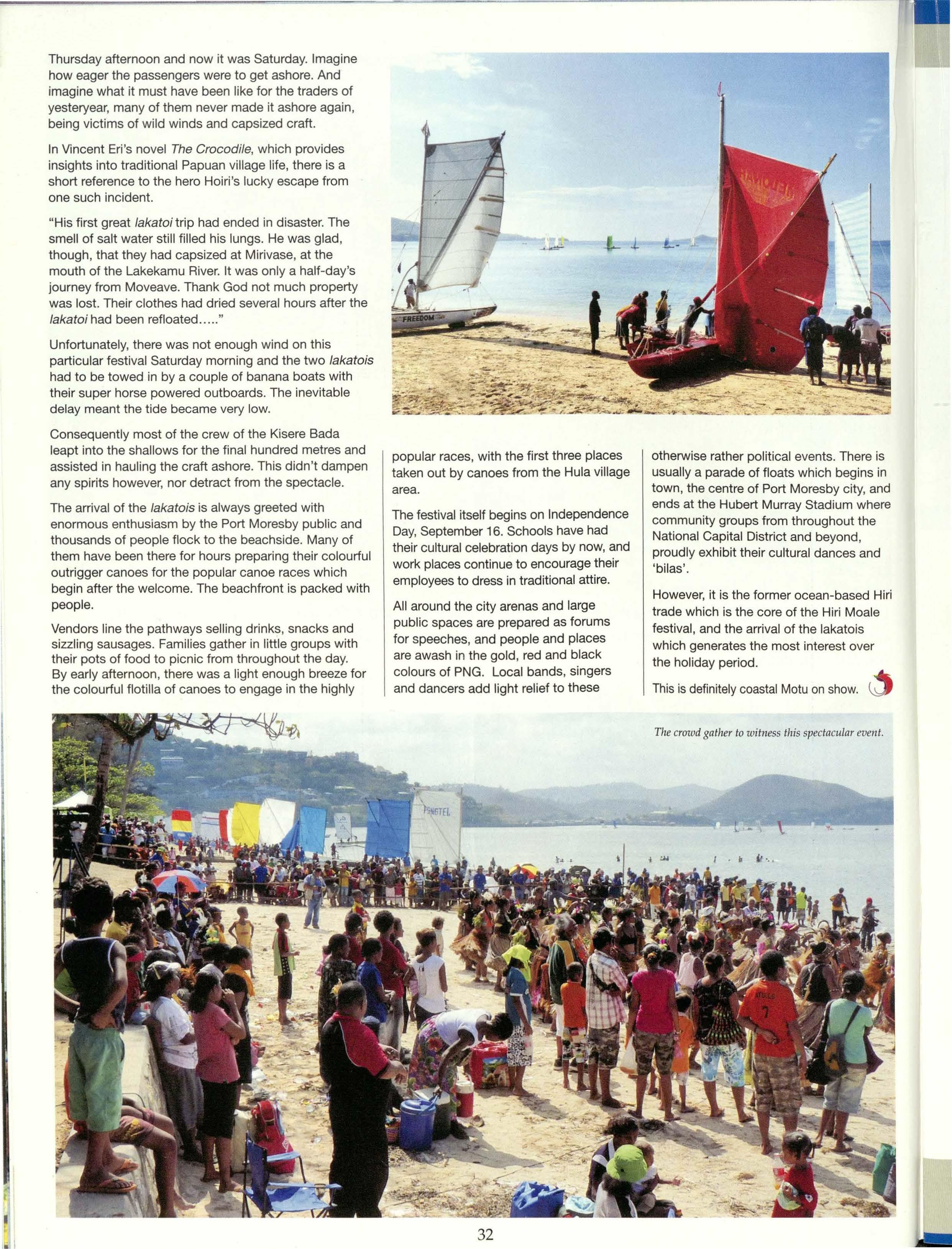
otherwise rather political events. There is usually a parade of floats which begins in town, the centre of Port Moresby city, and ends at the Hubert Murray Stadium where community groups from throughout the National Capital District and beyond, proudly exhibit their cultural dances and 'bilas'.
However, it is the former ocean-based Hiri trade which is the core of the Hiri Moale festival, and the arrival of the lakatois which generates the most interest over the holiday period.
This is definitely coastal Motu on show.
Thecrowdgatherto witness this spectacularevent.

Yes,we've done

BY JODIE BELYEA
day
n
'm sitting on the first of the 1000 steps that make up the Kokoda Steps Memorial Walk in Ferntree Gully, Victoria, Australia.
It's the end of the day, but I'm still in my work clothes and the effort of gearing up for some needed exercise seems just a little too hard.
Hard? That's what catches me, sweeping me back to August 2010.
I and 20 indigenous Australians -13 young people and 7 mentors - were slogging the Kokoda Track. Workday heels and stockings have vanished - this is hiking boots, backpacks and sweat.
It still amazes me that we did it. After months of training, the members of the Jobs Australia Foundation's Indigenous Youth Leadership Programme, now a tight-knit group, successfully completed the track.
The trek was the culmination of six months work spent encouraging these promising young indigenous Australians to find their feet and see their own potential as future leaders.
It proved to be a defining time. The training and talking we did before was essential. Even so, it was the stories of Kokoda's brave warriors - the Australian soldiers, PNG porters and villagers who befriended them and kept them alive - that affected us most deeply.
The idea for this programme first arose in 2009 when the Job Australia Foundation board decided to develop a leadership programme for young
Bridge crossing.
Our trekkerswere deeply stirred to hear from men who had been there. George's wordsrang clearlyfor us all: 'tread lightly with respecton the groundin PapuaNew Guineabecausethere are mates of mine still over there'. indigenous people.
They believe that supporting the development of tomorrow's young leaders is crucial to helping strengthen indigenous communities.
Including Kokoda in the programme, summed up what the foundation hoped to do - build leadership skills. It would tap into their desire for experience and adventure and provide a crucible in which to develop and test their leadership qualities.
As for Kokoda itself, its World War II story of determination and success in the face of adversity spoke directly to these young people and their mentors.
Their knowledge of their own people's suffering and hardship was deep and personal. And the opportunity to experience PNG's own indigenous culture helped these young future leaders to see themselves as part of a larger world and realise that they too could be the
heroes and leaders their communities need.
Kokoda excited, humbled and inspired everyone.
Following the selection of young leaders and their mentors in January 2010, the programme kicked off with a four-day pre-trek leadership training camp.
Preparing everyone so that they were physically and mentally ready to undertake the walk and to make the most of the programme was important groundwork.
That four-day camp started to give everyone involved a mental map of where we were going and what we would need to take on the journey.
We wanted to increase the understanding of what it means to lead and what skills and qualities they themselves already brought to this and to the group itself. We also needed to
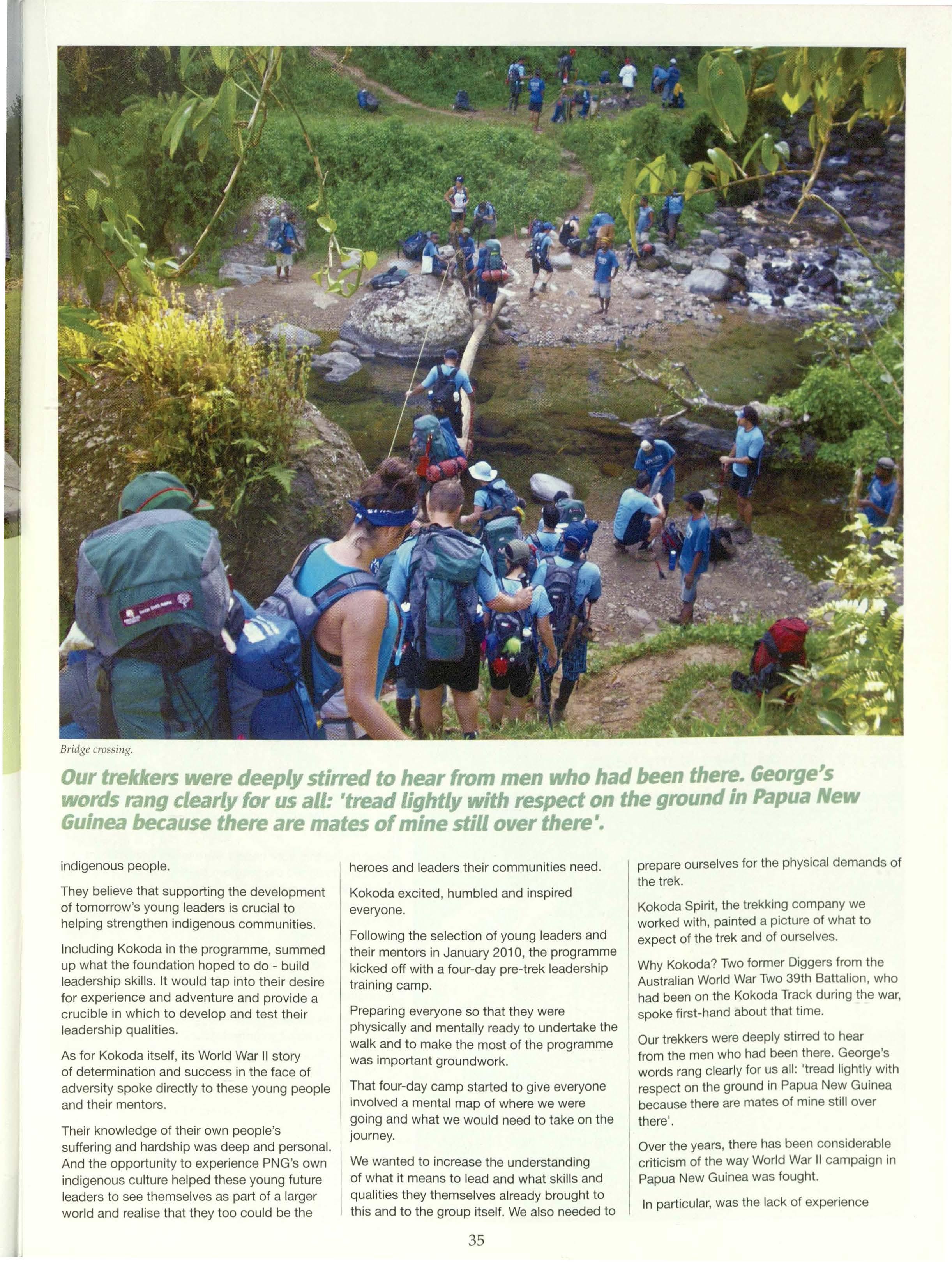
prepare ourselves for the physical demands of the trek.
Kokoda Spirit, the trekking company we worked with, painted a picture of what to expect of the trek and of ourselves.
Why Kokoda? Two former Diggers from the Australian World War Two 39th Battalion, who had been on the Kokoda Track during the war, spoke first-hand about that time.
Our trekkers were deeply stirred to hear from the men who had been there. George's words rang clearly for us all: 'tread lightly with respect on the ground in Papua New Guinea because there are mates of mine still over there'.
Over the years, there has been considerable criticism of the way World War II campaign in Papua New Guinea was fought.
In particular, was the lack of experience
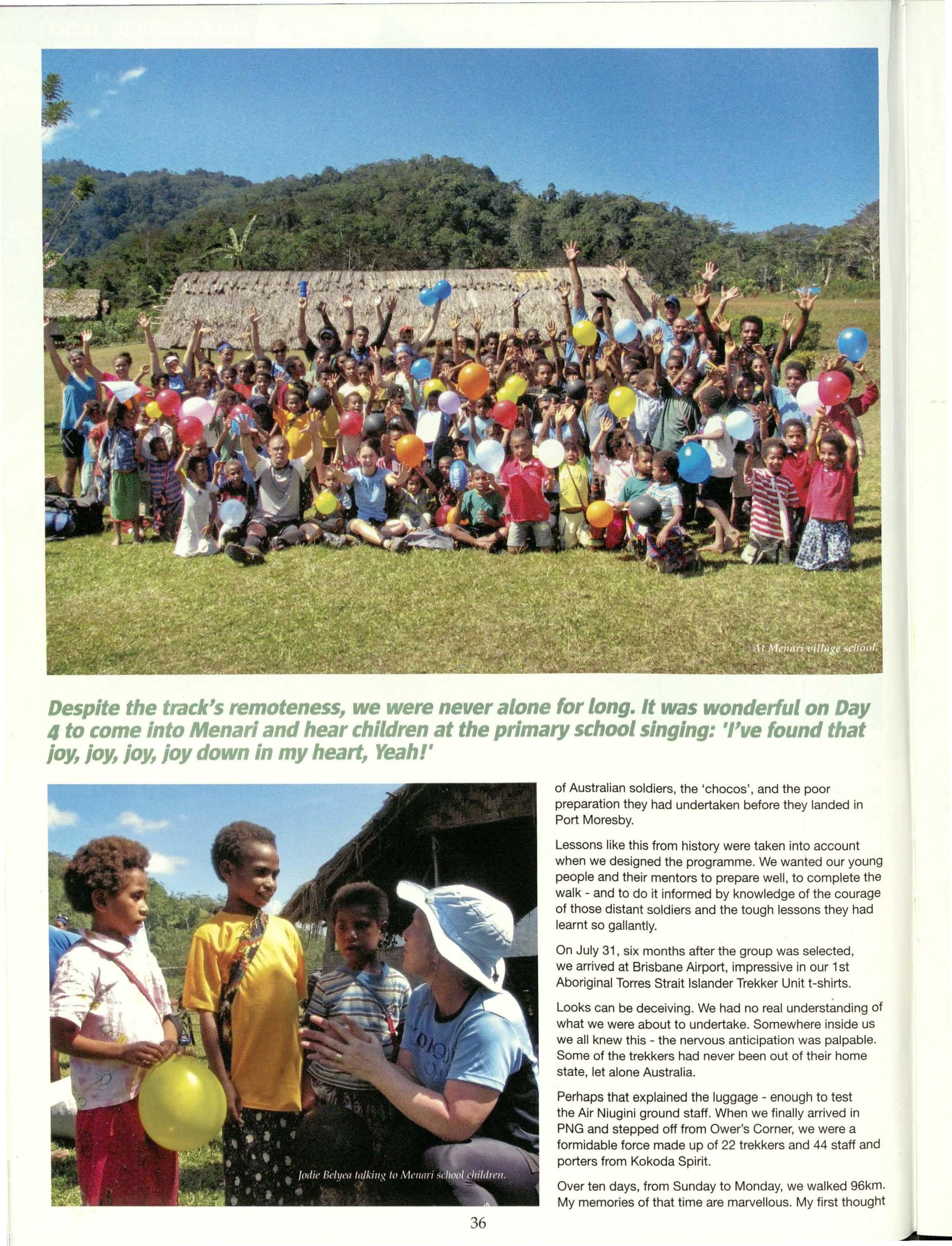
Despitethe track'sremoteness,we were neveralone for long. It was wonderfulon Day 4 to comeinto Menari and hear childrenat the primaryschoolsinging:'I've foundthat joy, joy, joy, joy down in my heart, Yeah!'
of Australian soldiers, the 'chocos', and the poor preparation they had undertaken before they landed in Port Moresby.
Lessons like this from history were taken into account when we designed the programme. We wanted our young people and their mentors to prepare well, to complete the walk - and to do it informed by knowledge of the courage of those distant soldiers and the tough lessons they had learnt so gallantly.
On July 31, six months after the group was selected, we arrived at Brisbane Airport, impressive in our 1st Aboriginal Torres Strait Islander Trekker Unit t-shirts.
Looks can be deceiving. We had no real understanding of what we were about to undertake. Somewhere inside us we all knew this - the nervous anticipation was palpable. Some of the trekkers had never been out of their home state, let alone Australia.
Perhaps that explained the luggage - enough to test the Air Niugini ground staff. When we finally arrived in PNG and stepped off from Ower's Corner, we were a formidable force made up of 22 trekkers and 44 staff and porters from Kokoda Spirit.
Over ten days, from Sunday to Monday, we walked 96km. My memories of that time are marvellous. My first thought
Forthe womenparticularly,one of the most memorabletimeseachday was the time we spent togetherwashingaway the day, swappingstories,rememberingto laughas we did asyounggirls.
was of how slowly we walked as a group.
I don't believe I have ever walked so very, very slowly for such a long time.
Unlike the beautiful, electric blue and black Ulysses butterflies that floated gently around us, we clambered and stomped our way across the trek.
Then, there was the chilling fear of the numerous river crossings and the earth tremors that shook our memorial service at Brigade Hill.
Despite the track's remoteness, we were never alone for long. It was wonderful on Day 4 to come into Menari and hear children at the primary school singing: 'I've found that joy, joy, joy, joy down in my heart, Yeah! Down in my heart yeah! Down in my heart!'
Pulling basketballs, balloons and frisbees from our backpacks and tossing them around with the village children, we were happy to
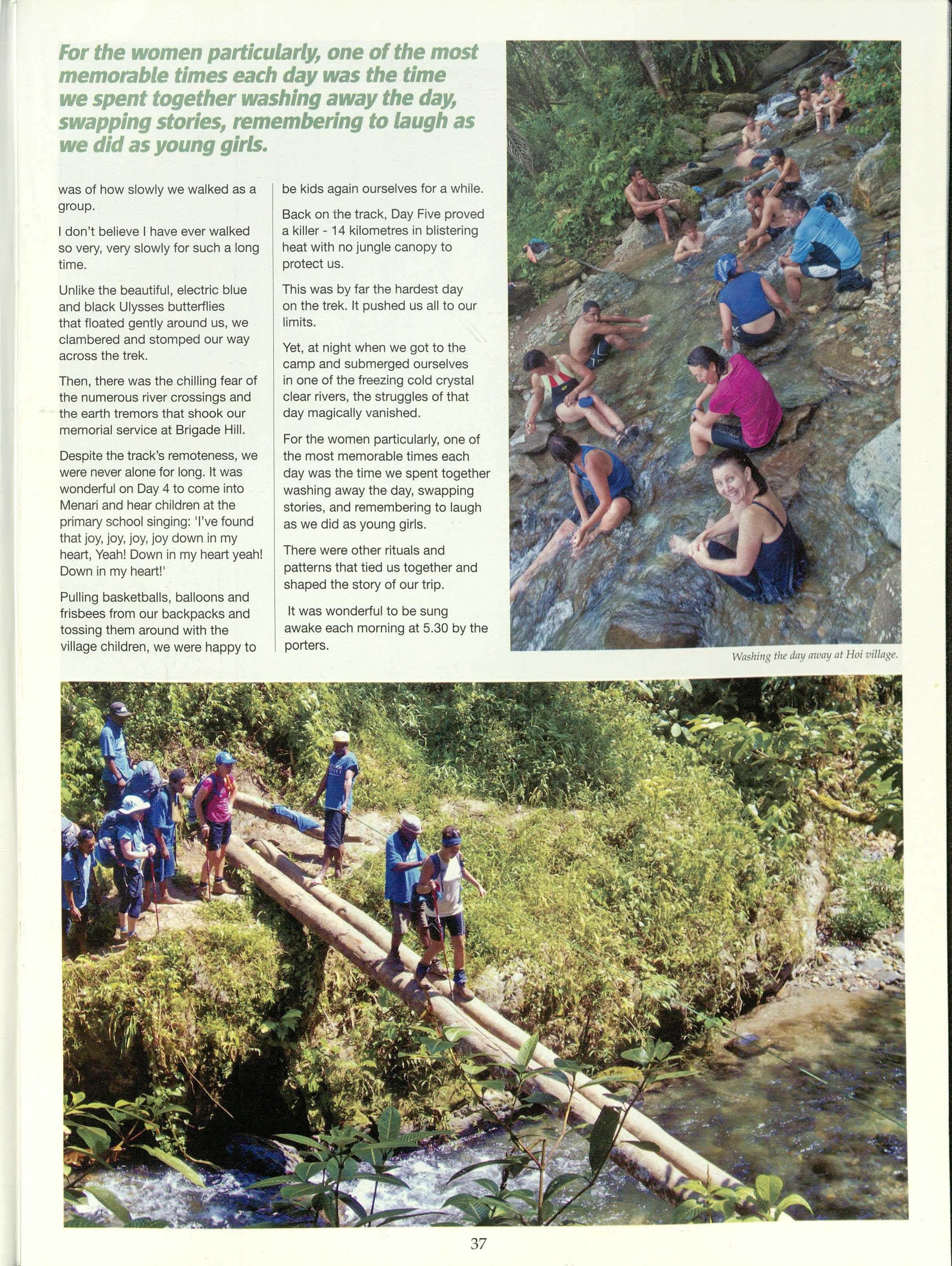
be kids again ourselves for a while.
Back on the track, Day Five proved a killer - 14 kilometres in blistering heat with no jungle canopy to protect us.
This was by far the hardest day on the trek. It pushed us all to our limits.
Yet, at night when we got to the camp and submerged ourselves in one of the freezing cold crystal clear rivers, the struggles of that day magically vanished.
For the women particularly, one of the most memorable times each day was the time we spent together washing away the day, swapping stories, and remembering to laugh as we did as young girls.
There were other rituals and patterns that tied us together and shaped the story of our trip.
It was wonderful to be sung awake each morning at 5.30 by the porters.

Reflectingon how we managedto completea journey that is one of the toughesttreks in the world, I am drawn backto the wordscarvedon the four pillarsat the memorialat the lsuravabattlefield:courage,endurance,mateshipand sacrifice.
I remember singing and dancing around the open fire at nights after a well-deserved feed and laughing uncontrollably as we tried to learn their version of John Denver's Country Road in pidgin.
By the end of the trek, many of us had emptied our backpacks to find gifts to give our kind porters - we all wanted to find ways to show our deep appreciation and gratitude for their support.
It didn't take us long to realise that if it wasn't for the porters, many of us wouldn't have been able to consider, let alone complete the Kokoda Track.
We came increasingly to see the opportunity to travel to Papua New Guinea, to live with the porters on the track and learn about them and their lives was a profound privilege.
As I sit here back in Australia, I feel a deep desire to be back in Papua New Guinea walking and living simply with the time to talk with my fellow trekkers in the junglesurrounded by Arctic Beech trees and Giant Pandanus. At 50 metres tall, they were a
Memorialserviceat BrigadeHill.
calming presence to weary minds and bodies.
Walking and completing the trek imprinted something powerful on each one of us.
The celebration dinner with the porters at the end of the journey was an outburst of joy, pride and satisfaction.
The nervous tension of Brisbane had been replaced with self-confidence and a new awareness and respect for the way others face the challenges life presents to them.
Even so, the physical exertion required to walk those final steps was evident when the group returned to the Gateway Hotel in Port Moresby, downing their first meal back in civilisation in seconds.
Reflecting on how we managed to complete a journey that is one of the toughest treks in the world, I am drawn back to the words carved on the four pillars at the memorial at the lsurava battlefield: courage, endurance, mateship and sacrifice.
These were the qualities displayed and valued by the Diggers and the Fuzzy Wuzzy angels during the Kokoda campaign. It was these qualities that we hoped to develop in our young trekkers.
Strangely though, we had unwittingly packed something in our backpacks that proved central for many of the trekkers in making sense of what they were seeing and confronted with, both around and within themselves. This was poetry.
It was writing poetry that gave several of our trekkers the means to make sense of what they were feeling when the experiences seemed overwhelming and the circumstances we found ourselves in simply surreal.
Rhett Burraston, a member of the group from Bradbury in New South Wales, used poetry to capture his feelings about the Kokoda campaign.
Tears run down my face
I'll never forget those we cannot replace. So many decisions were made in haste. So much talent put to waste, I hesitate and then rephrase I could not call those efforts a waste.
The mateship and courage, I envy.
The endurance and sacrifice, helped create me. If it wasn't for them, I wouldn't be here.
I'm forever thankful, with your spirit near, I'll never forget you, as I shed this tear.
What was experienced and learnt on the

walk were in many respects metaphors for life, examples of how to live and what it means to lead.
Everyone felt differently. But the Kokoda challenge had given everyone the time to examine who they are and where they want their lives to go.
Kyle Vander Kuyp, a former Olympic hurdler, admitted it was the hardest thing he has ever done.
Aaron Thomas, one of the programme's mentors, captured some of the challenge in his poem, Kokoda - The Track of Life, which he wrote on his return from the trek:
The track is tough: such as life. With lots of ups and downs. Sometimes you slip, sometimes you fall, sometimes you stop and don't move at all.
The track is rough: such as life with lots of paths and hurdles. Preparation and knowledge, was the key to our success, and learning from the mistakes from those who lay in rest.
The track is forever changing: such as life. The track has changed me for the rest of my life.
Kokoda is the track of life.
• Jodie Belyea is the Project Manager, Jobs Australia Foundation.
ishing nets, floaters, snorkelling flippers and masks hang out to dry. Dinghies, canoes afloat under huge houses with large kitchens and verandahs built on tall, crooked mangrove stilts over the sea, and children swimming and laughing - these are typical sights at the fishing village of Viriolo.
Viriolo is located at Cape Rodney, a three-hour drive down the Magi Highway, southeast of Port Moresby.
It is the second last village on the Aroma coast and the
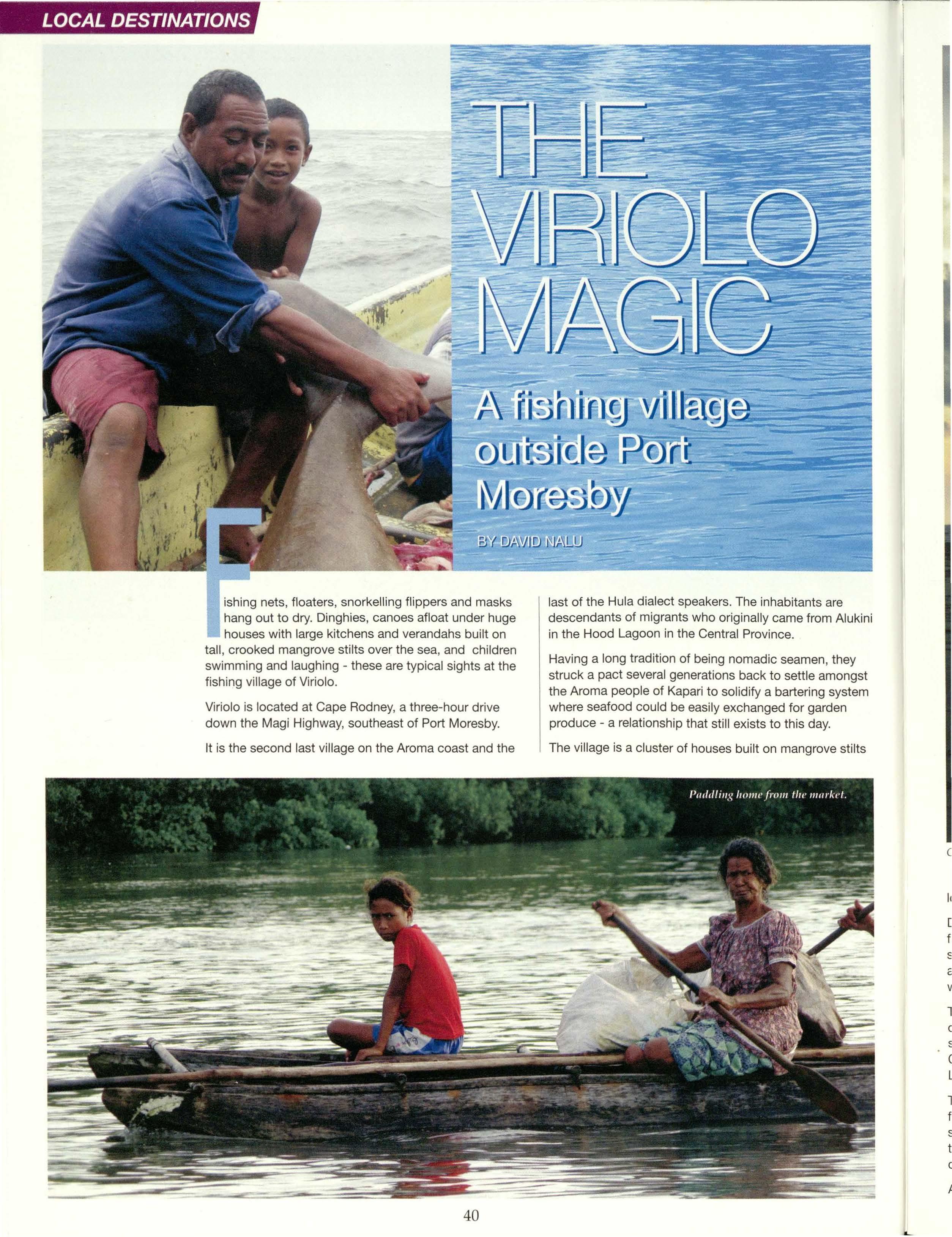
last of the Hula dialect speakers. The inhabitants are descendants of migrants who originally came from Alukini in the Hood Lagoon in the Central Province.
Having a long tradition of being nomadic seamen, they struck a pact several generations back to settle amongst the Aroma people of Kapari to solidify a bartering system where seafood could be easily exchanged for garden produce - a relationship that still exists to this day.
The village is a cluster of houses built on mangrove stilts
located at the mouth of an estuary.
During high tide, the tidal plain is completely flooded and during low tide, it serves as a sports field for cricket and rugby. Sports activities are scheduled around the times when the tide has receded.
The people are peaceful, harmonious and definitely happy, practising an evolving culture steeply entwined and shaped by the United Church, which can trace its roots to the London Missionary Society.
This has set the foundation for a solid social fabric that promotes discipline, respect and social order that has been able to withstand the onslaught of external influences and change.
All daily social activities revolve around song,
Thepeople are obliviousto occurrences of the outsideworld, with their only care being their daily existenceand happiness. Sharingof catchesensuresall membersof the villagecommunityare caredfor.

dance and church. Melodious voices and sounds of ukeleles and guitars in the typical Aroma Coast tunes fill the early evenings as young people gather to socialise or the sounds of the peroveta (prophet songs) as elders meet for daily prayers in the early mornings and evenings.
Given that the peoples' livelihood depend on the sea, they are seasoned seafarers whose quest to fish the oceans see no boundaries.
A regular fishing trip will easily last two days involving two to three dinghies with 6 - 10 divers venturing to offshore reefs as far as the waters off Milne Bay and deep into the Coral Sea in search of all that is edible and saleable the sea can offer.
sisters, mothers warm the fires and prepare tea and food for the returning fishermen.
Reef fish, turtles, dugongs are regularly brought back and smoked and prepared for sale in the local markets or in town.
A simple ritual is always observed where only fishermen will unload and distribute the catch for consumption and sale.
Wives and sisters are dispatched to take the catch by PMV into Port Moresby to sell and bring back food supplies of rice, flour, sugar, tea, salt, tobacco and fuel.
The people are oblivious to the occurrences of the outside world with their only care being their daily existence and happiness. The village rises
Smoki11gfisl,to be sold at the market.
of the village community are cared for. Their ancient values retained from a nomadic tradition is the cohesive force that ensures the survival of this fishing community. It is a stark contrast to the individualistic crusade that westernisation promotes.
It is also a reminder of our Melanesian heritage and of the identity crisis suffered by the masses as a result of rapid changes and western influences.
How does one get there?
Viriolo is not your usual travel destination and does not offer the usual luxuries expected. But if you have a keen sense of adventure, a desire to experience something different and a day to spare, then a trip down to Viriolo might be just the thing for you. The scenic sights on
Theirancientvaluesretained from a nomadictraditionis the cohesiveforce that ensuresthe survivalof this fishing community.It is a starkcontrastto the individualistcrusadethat westernisation promotes.
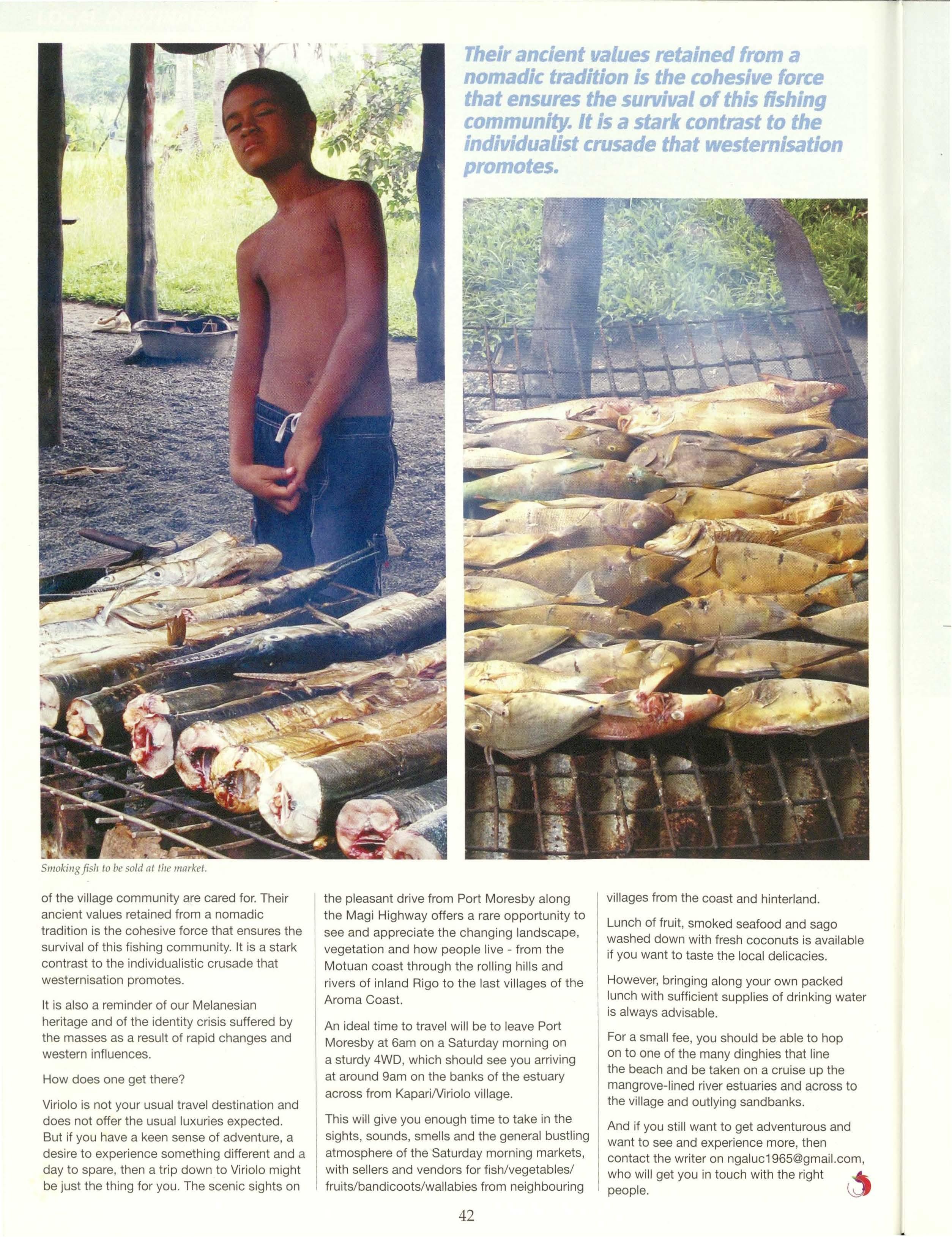
the pleasant drive from Port Moresby along the Magi Highway offers a rare opportunity to see and appreciate the changing landscape, vegetation and how people live - from the Motuan coast through the rolling hills and rivers of inland Rigo to the last villages of the Aroma Coast.
An ideal time to travel will be to leave Port Moresby at 6am on a Saturday morning on a sturdy 4WD, which should see you arriving at around 9am on the banks of the estuary across from KapariNiriolo village.
This will give you enough time to take in the sights, sounds, smells and the general bustling atmosphere of the Saturday morning markets, with sellers and vendors for fish/vegetables/ fruits/bandicoots/wallabies from neighbouring
villages from the coast and hinterland.
Lunch of fruit, smoked seafood and sago washed down with fresh coconuts is available if you want to taste the local delicacies.
However, bringing along your own packed lunch with sufficient supplies of drinking water is always advisable.
For a small fee, you should be able to hop on to one of the many dinghies that line the beach and be taken on a cruise up the mangrove-lined river estuaries and across to the village and outlying sandbanks.
And if you still want to get adventurous and want to see and experience more, then contact the writer on ngaluc1965@gmail.com, who will get you in touch with the right ._ people.
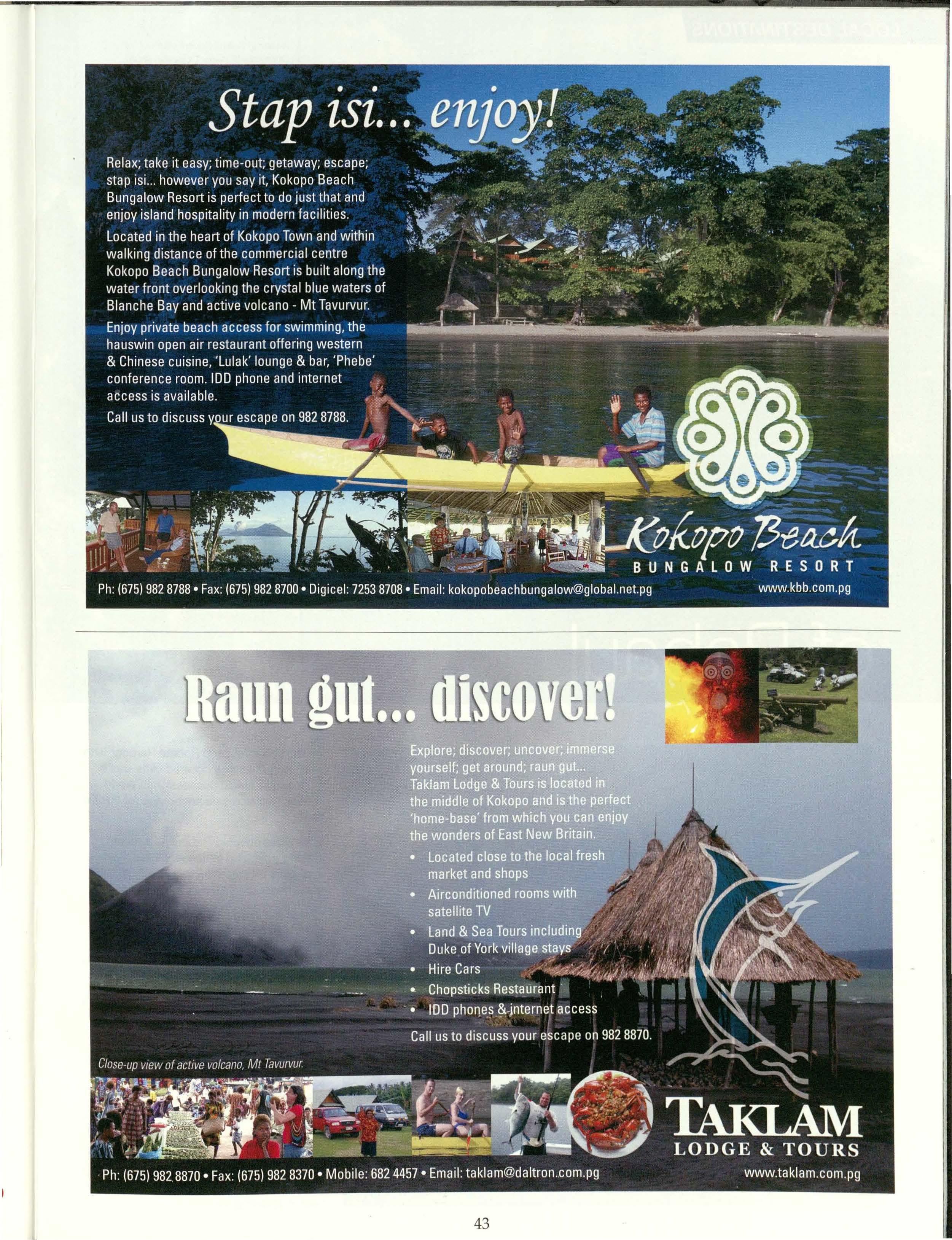
BY BOB LAWRENCE

The beautiful deep Rabaul Harbour with its ring of foliage covered cliffs was a prized strategic possession in World War Two as a safe anchorage for Pacific fleets.
Both sides coveted Rabaul as a major staging post, and in January 1942, the Japanese invading force took it from the under-resourced Australian military.
One of the saddest wartime stories, the sinking of the Montevideo Maru, which resulted from the Japanese capture of Rabaul, was recently commemorated in the Australian Parliament.
At the outbreak of World War II in 1939, the New Guinea Volunteer Rifles was formed. In February 1941, Australia despatched an AIF garrison of some 1400 troops, designated as Lark Force, to Rabaul due to fears of invasion by the German fleet or possible aggression by the Japanese who had invaded Manchuria, China, a few years earlier.
Shortly after the attack on Pearl Harbor on December 7, 1941, whereby Japan entered the war, the Japanese ordered an invasion fleet to take Rabaul.

We have been providing engineering and project management solutions for PNG and the South Pacific for more than 30 years. Solutions that meet the evolving needs of our clients, our region and its people.
In often challenging locations and demanding conditions, our team is delivering some of the region's leading aviation, health, education and resources facilities.
From concept development to detailed engineering and design, we combine world-class thinking and project execution with our local knowledge to add value at every stage of the project lifecycle.
With offices in Papua New Guinea, Australia, Samoa, Tonga, Solomon Islands, Fiji and Vanuatu we have the team, expertise and experience you need right here in PNG and the South Pacific.
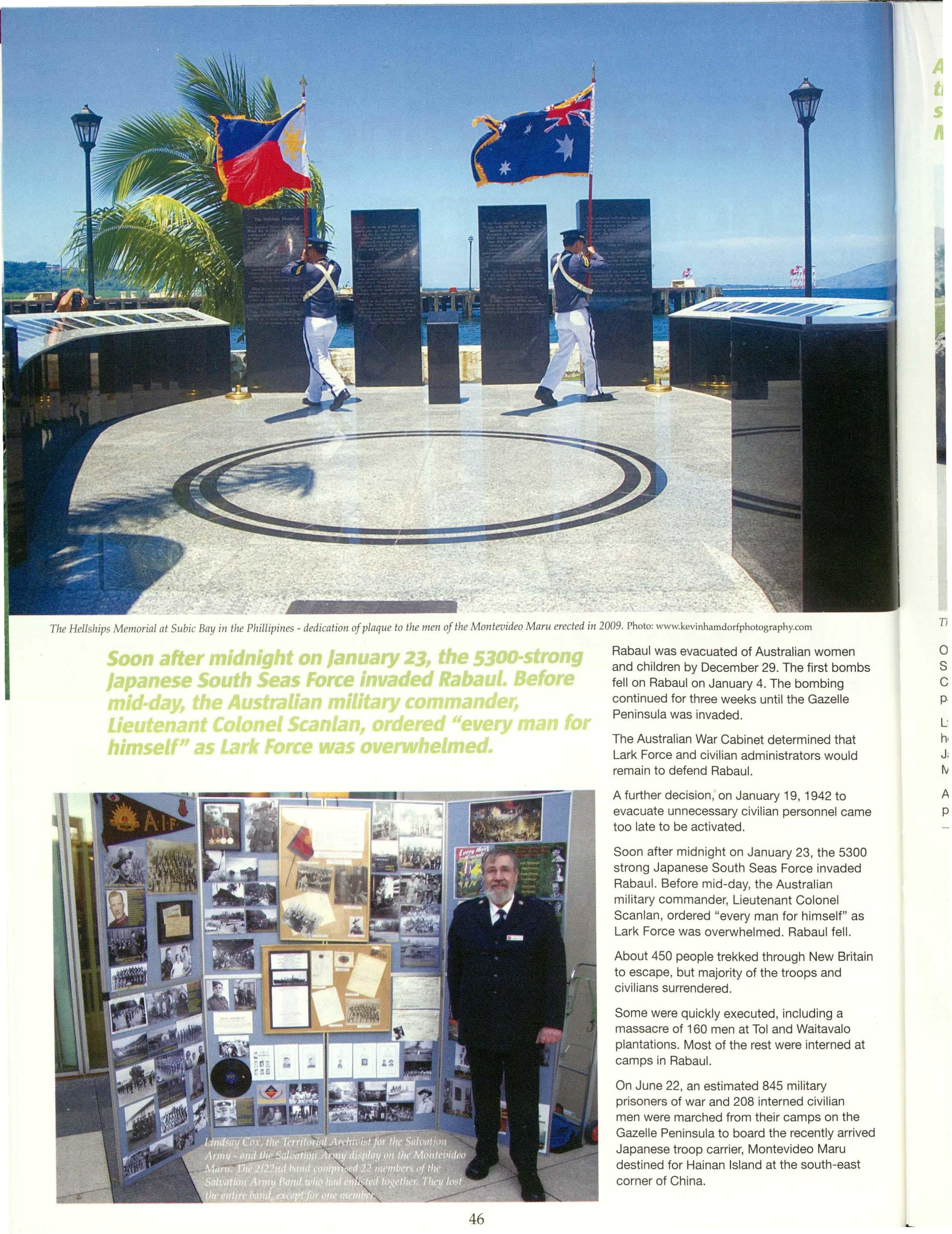
TileHellshipsMemorialat Subic Bay in tile Pilillipines-dedicationof plaqueto the men of the MontevideoMaruerectedin 2009. Photo: www.kevinhamdorfphotography.com , JapaneseSouthSeasForceinvadedRabaul.Before mid-day,the Australianmilitary commander, LieutenantColonelScanlan,ordered "everyman fo himself" as LarkForcewas overwhelmed.
Rabaul was evacuated of Australian women and children by December 29. The first bombs fell on Rabaul on January 4. The bombing continued for three weeks until the Gazelle Peninsula was invaded.
The Australian War Cabinet determined that Lark Force and civilian administrators would remain to defend Rabaul.
A further decision, on January 19, 1942 to evacuate unnecessary civilian personnel came too late to be activated.
Soon after midnight on January 23, the 5300 strong Japanese South Seas Force invaded Rabaul. Before mid-day, the Australian military commander, Lieutenant Colonel Scanlan, ordered "every man for himself" as Lark Force was overwhelmed. Rabaul fell.
About 450 people trekked through New Britain to escape, but majority of the troops and civilians surrendered.
Some were quickly executed, including a massacre of 160 men at Toi and Waitavalo plantations. Most of the rest were interned at camps in Rabaul.
On June 22, an estimated 845 military prisoners of war and 208 interned civilian men were marched from their camps on the Gazelle Peninsula to board the recently arrived Japanese troop carrier, Montevideo Maru destined for Hainan Island at the south-east corner of China.
As there are no survivingrecordsof who was on-board the ship, no one is sure whichmen died between the start of the Japaneseinvasionand the embarkationof the MontevideoMaru.

TheMontevideoMnn, Memorialnt Rabnul.
On the night of June 30, the US submarine Sturgeon, under the command of Lieutenant Commander William 'Bull' Wright, was on patrol west of Luzon in the Philippine waters
Lt Cdr Wright's log reports sighting a ship that he thought may be the troop carrier, Rio de Janeiro Maru, a sister ship to the Montevideo Maru.
As with all Japanese and Allied ships carrying prisoners of war, Montevideo Maru bore
no special markings as it powered towards Hainan, so Wright was unaware the ship carried allied prisoners.
Over the following hours, the submarine tracked the Montevideo Maru. When the ship slowed, the Sturgeon was able to move close enough to fire four torpedos.
At least one found its target. Following the explosion, it only took about 11 minutes for the Montevideo Maru to sink, stern first, in
4200 metres of water.
It is believed all prisoners perished along with some of the crew and guards.
A subsequent Japanese report to the owners of Montevideo Maru said many of the crew and guards got away in two undamaged lifeboats. Reaching land did not ensure their safety. Most were killed by Filipino guerrillas.
As a result, Rabaul contributed over 1000 of the 8000 Australians who died as prisoners of war of the Japanese.
As there are no surviving records of who was on-board the ship, no one is sure which men died between the start of the Japanese invasion and the embarkation of the Montevideo Maru.
For this reason, the group formed to commemorate the fallen is called the Rabaul and Montevideo Maru Society.
On June 21 this year, families and friends of the departed men congregated at Parliament House, Canberra, for a commemoration organised by the society.
A bi-partisan condolence resolution was passed in both houses of the Australian parliament.
The Minister for Veterans Affairs, Alan Griffin, spoke on a motion commemorating the men who defended Rabaul against hopeless odds.
He later pledged that the Federal Government would contribute A$100,000 towards a memorial to be erected at the Australian War Memorial by the Rabaul and Montevideo Maru Society.
The Shadow Minister for Veterans Affairs Louise Markus, who is married to a Papua New Guinean national, announced that a Coalition Government would honour the promise of the A$100,000 grant. Importantly, this took the issue off the political agenda and ensured that regardless of the result of the
Fax:+61733142321 Email:sales@procureit.com.au • Web:www.procureit.com.au
Smith (neeMacAdam) and Diana Coote(nee Martell),childhoodfriends, meetfor thefirst time after being evacuatedin December1941 during the commemorationceremonyin Canberrathis year. then impending federal election, the grant was safe.
Papua New Guinea was represented at the commemoration ceremony by its High Commissioner, Charles Lepani.
President of the Rabaul and Montevideo Maru Society, Professor Keith Jackson said it was a very significant day for people who served in the
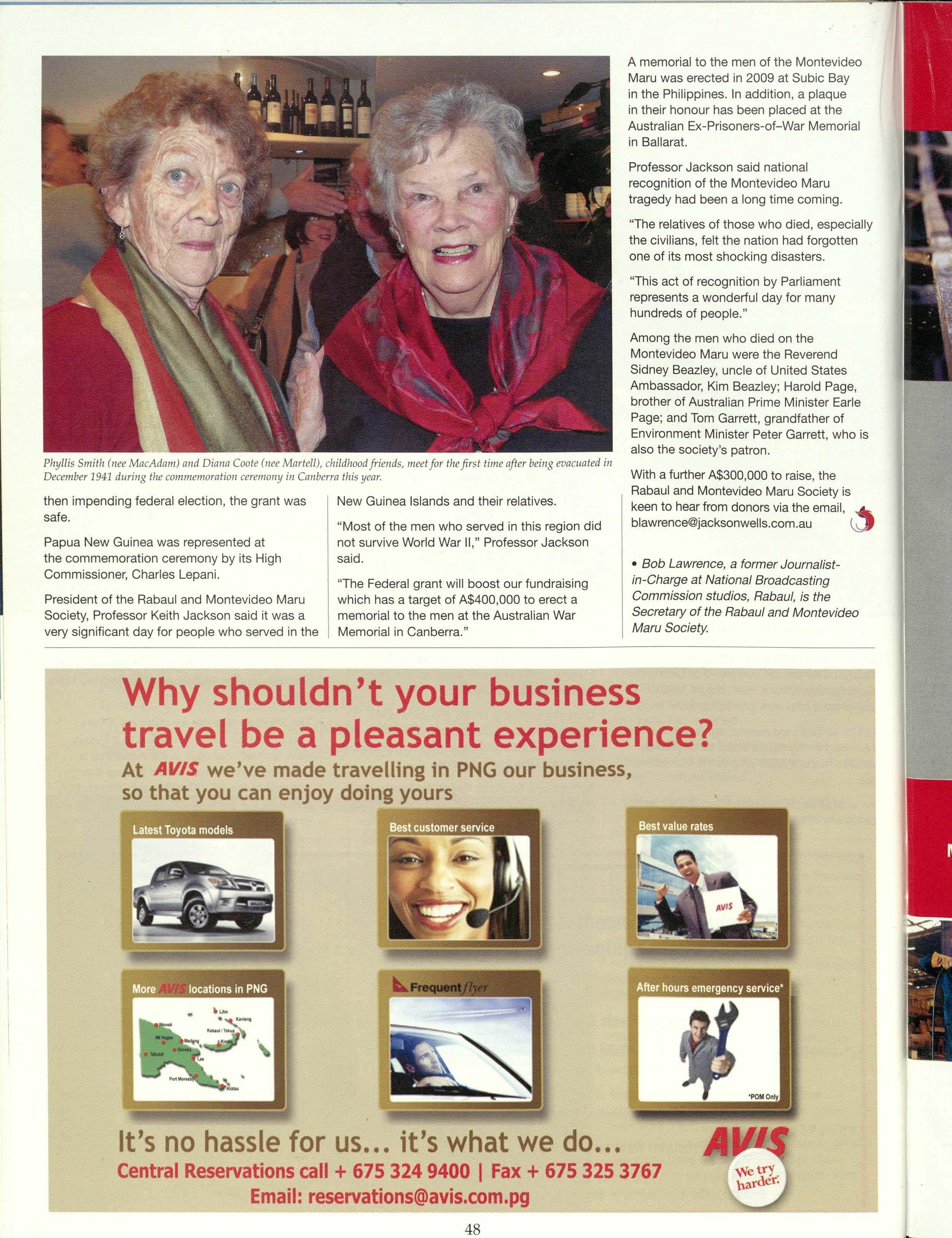
New Guinea Islands and their relatives.
"Most of the men who served in this region did not survive World War II," Professor Jackson said.
"The Federal grant will boost our fundraising which has a target of A$400,000 to erect a memorial to the men at the Australian War Memorial in Canberra."
A memorial to the men of the Montevideo Maru was erected in 2009 at Subic Bay in the Philippines. In addition, a plaque in their honour has been placed at the Australian Ex-Prisoners-of-War Memorial in Ballarat.
Professor Jackson said national recognition of the Montevideo Maru tragedy had been a long time coming.
"The relatives of those who died, especially the civilians, felt the nation had forgotten one of its most shocking disasters.
"This act of recognition by Parliament represents a wonderful day for many hundreds of people."
Among the men who died on the Montevideo Maru were the Reverend Sidney Beazley, uncle of United States Ambassador, Kim Beazley; Harold Page, brother of Australian Prime Minister Earle Page; and Tom Garrett, grandfather of Environment Minister Peter Garrett, who is also the society's patron.
With a further A$300,000 to raise, the Rabaul and Montevideo Maru Society is keen to hear from donors via the email, ._ blawrence@jacksonwells.com.au U
• Bob Lawrence, a former Journalistin-Charge at National Broadcasting Commission studios, Rabaul, is the Secretary of the Rabaul and Montevideo Maru Society.
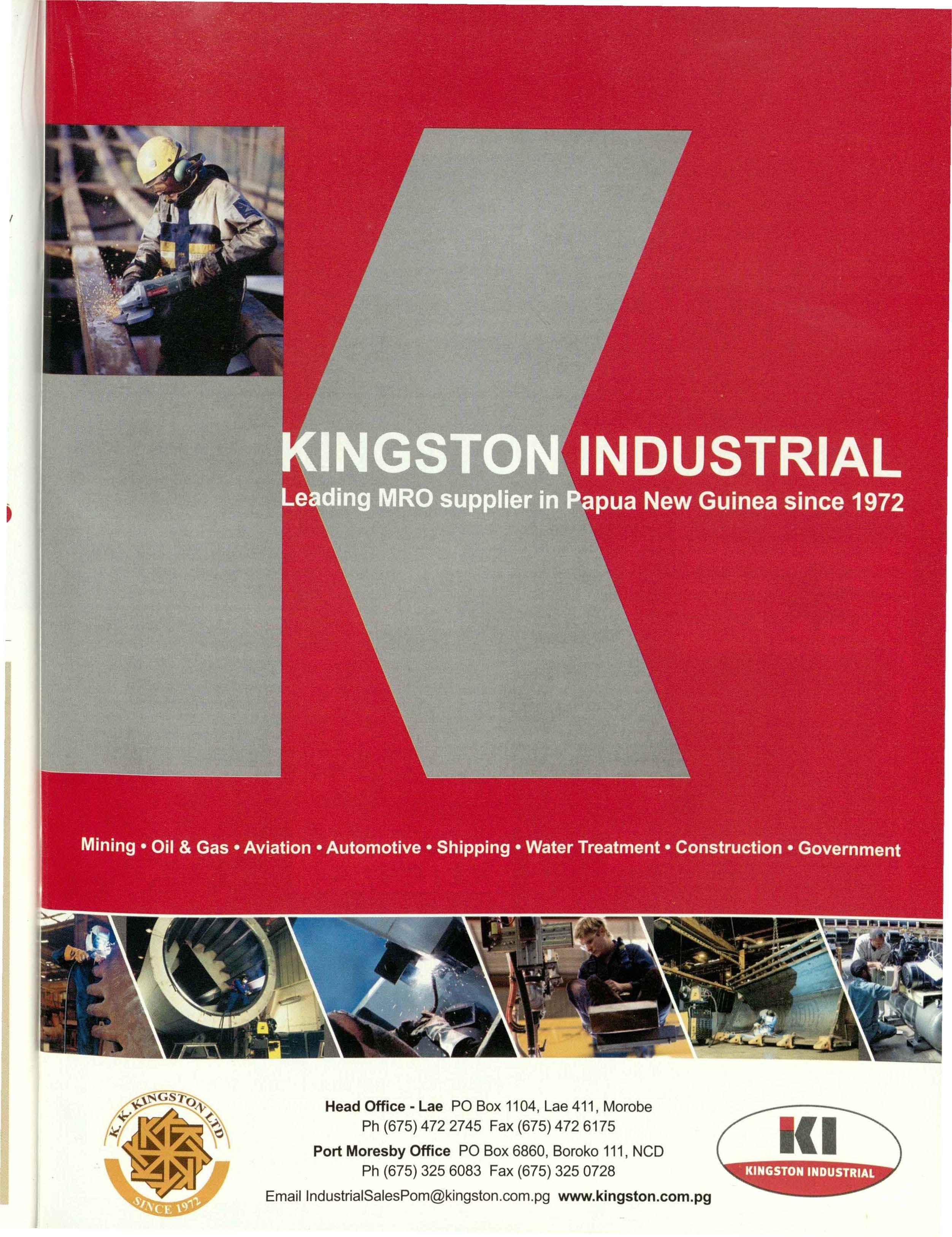
John Swire & Sons and Steamships are proud to support the Swire Papua New Guinea Rainforest Study (SPRS),which was officially launched this year in the Wanang District, Madang Province.
SPRShasbeen coordinated bytheCenterforTropical Forest Science (CTFS)of the Arnold Arboretum of Harvard University and the Smithsonian Tropical Research Institute, in partnership with the New Guinea Binatang Research Centre (BRC), the University of Minnesota, and the University of the Czech Republic.
giving researchers unique opportunities for ecological studies. The centre has accommodation and laboratory space, and is equipped to host national and international researchers. Members of the local community are employed through the Swire Research Centre as field research assistants, giving them the scientific skills required for sustainable forest management.
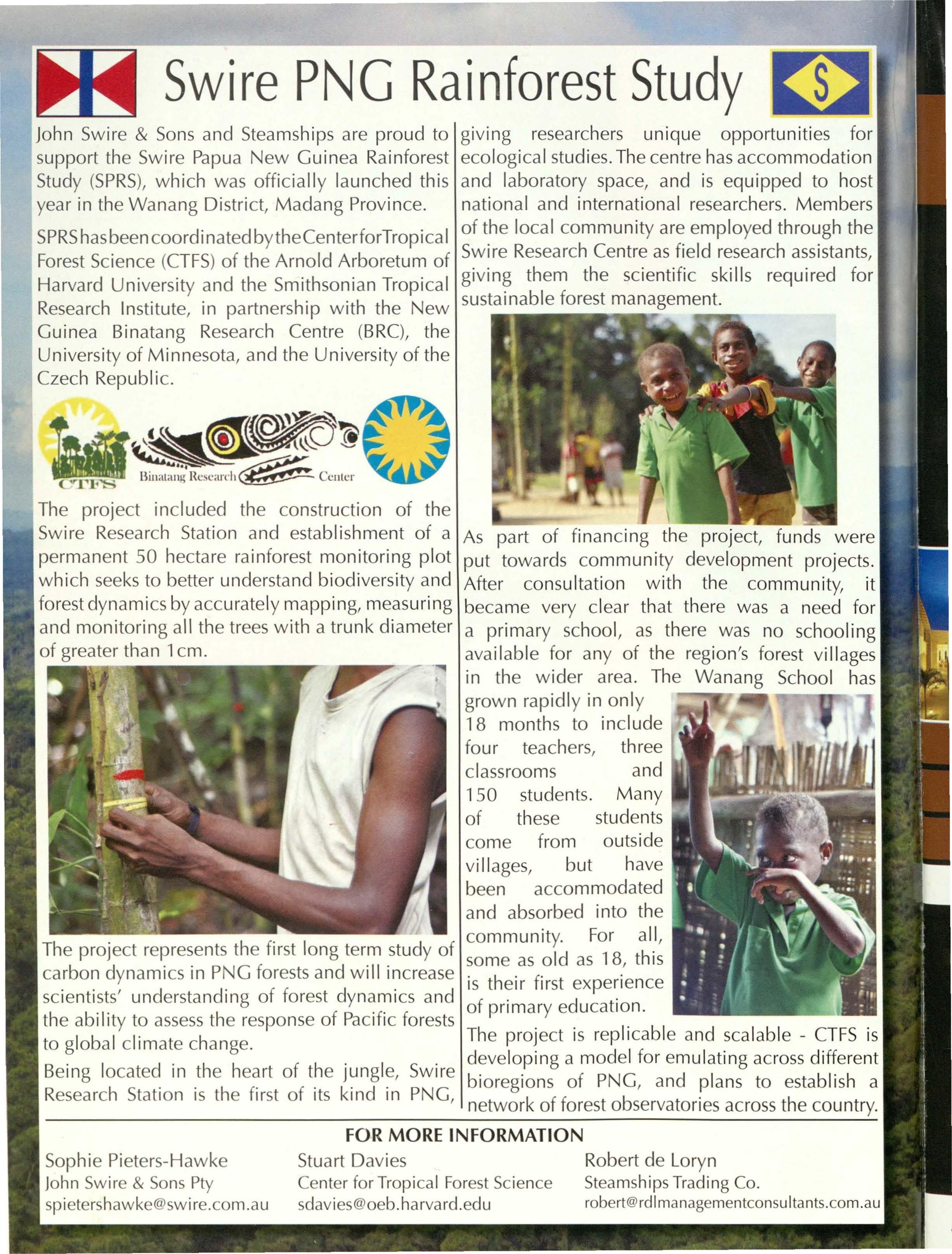
The project included the construction of the Swire Research Station and establishment of a permanent 50 hectare rainforest monitoring plot which seeks to better understand biodiversity and forest dynamics by accurately mapping, measuring and monitoring all the trees with a trunk diameter of greater than 1cm.
The project represents the first long term study of carbon dynamics in PNG forests and will increase scientists' understanding of forest dynamics and the ability to assessthe response of Pacific forests
As part of financing the project, funds were put towards community development projects. After consultation with the community, it became very clear that there was a need for a primary school, as there was no schooling avai Iable for any of the region's forest vi IIages in the wider area. The Wanang School has grown rapidly in only 18 months to include teachers, three classrooms and 150 students. Many of these students come from vi I Iages, but been accommodated and absorbed into the community. For all, some as old as 18, this is their first experience of primary education.
The project is replicable and scalable - CTFS is to global climate change.
Being located in the heart of the jungle, Research Station is the first of its kind in
developing a model for emulating across different Swire bioregions of PNG, and plans to establish a
PNG, network of forest observatories across the country.
Sophie Pieters-Hawke
John Swire & Sons Pty spietershawke@swire.com.au
Stuart Davies
Center for Tropical Forest Science sdavies@oeb.harvard.edu
Robert de Loryn Steamships Trading Co. robert@rdlmanagementconsultants.com.au

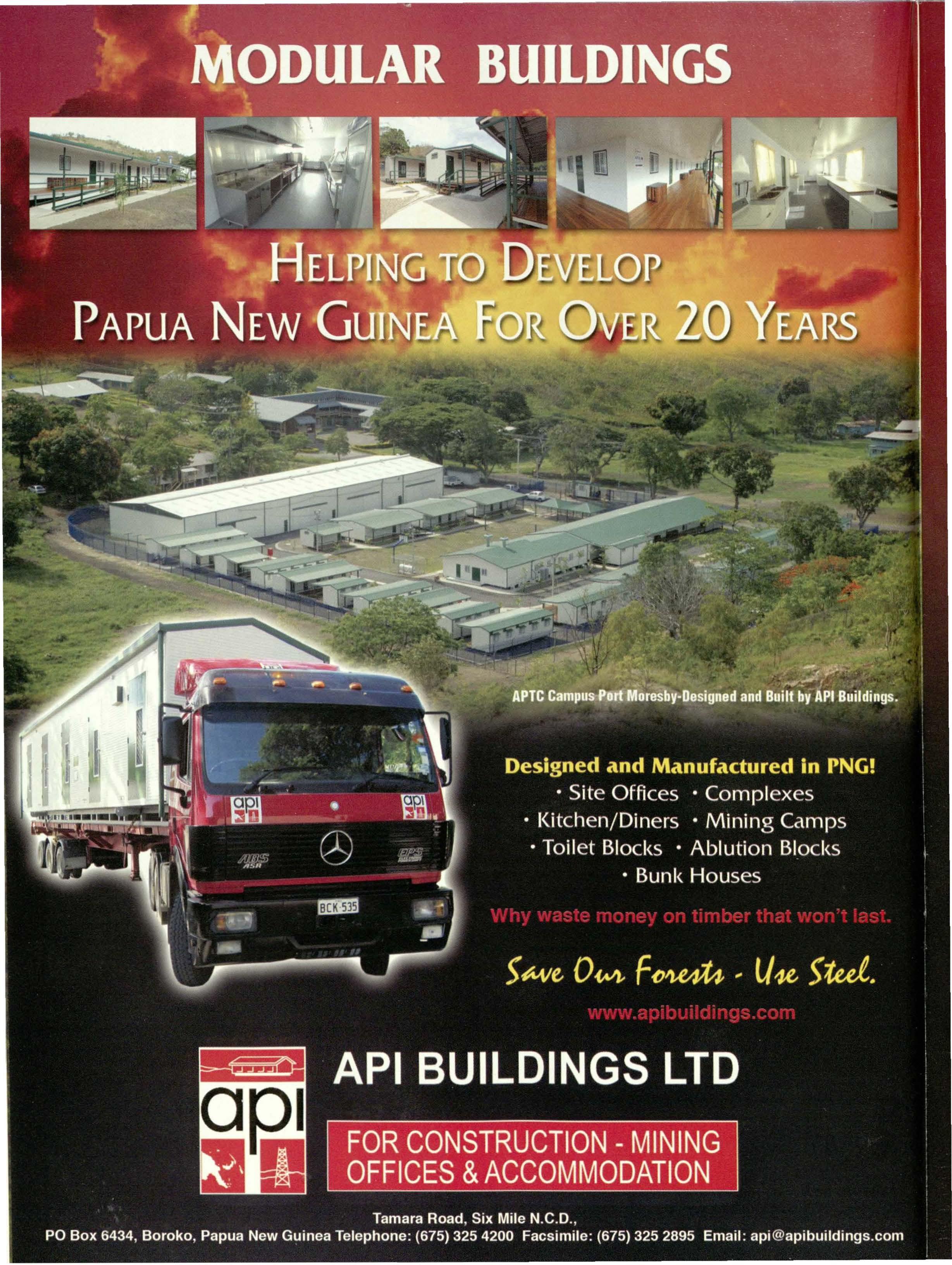

TEXT: ROD PEARCE & PICTURES: BOB HALSTEAD
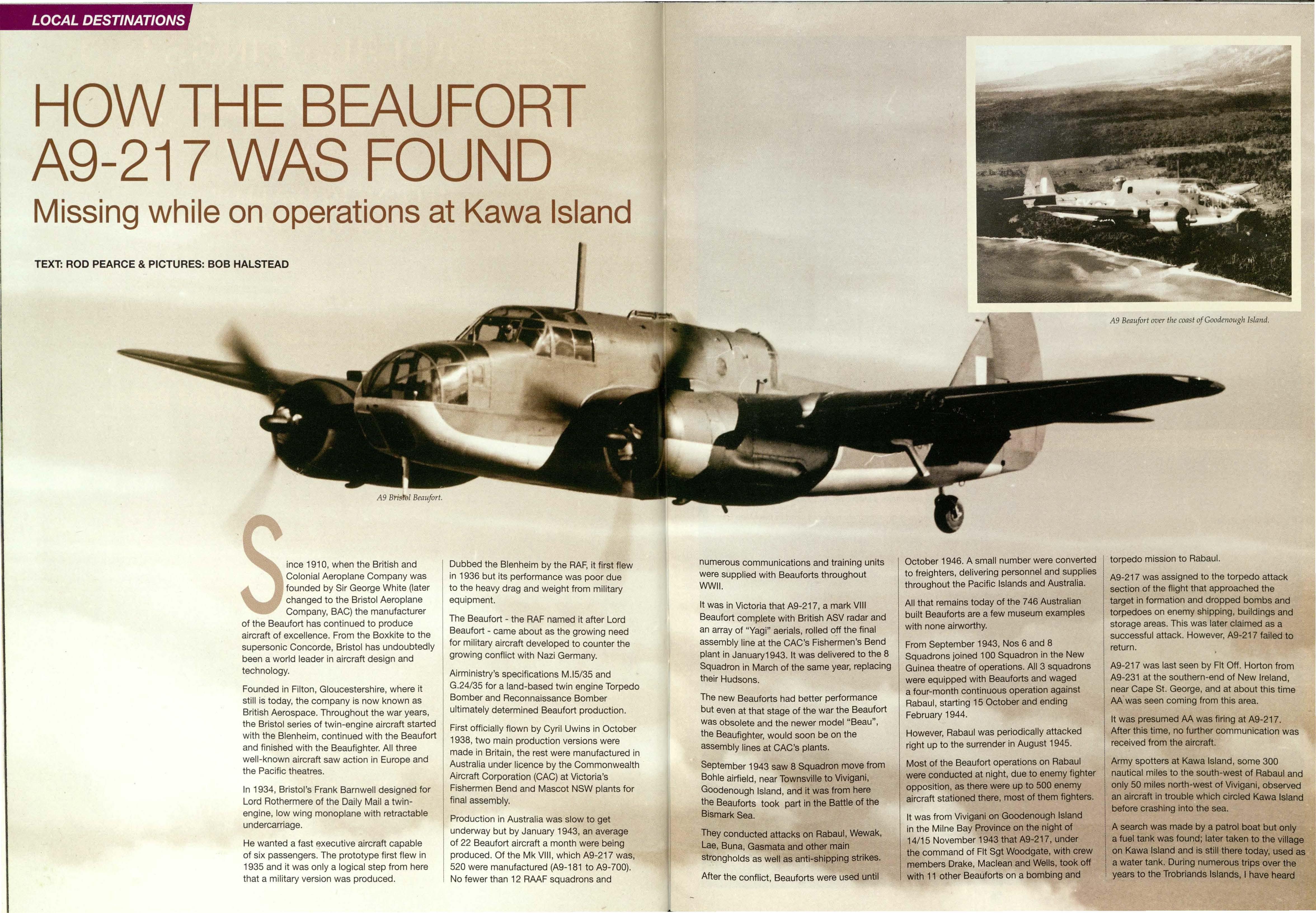
ince 1910, when the British and Colonial Aeroplane Company was founded by Sir George White (later changed to the Bristol Aeroplane Company, BAG) the manufacturer of the Beaufort has continued to produce aircraft of excellence. From the Boxkite to the supersonic Concorde, Bristol has undoubtedly been a world leader in aircraft design and technology.
Founded in Filton, Gloucestershire, where it still is today, the company is now known as British Aerospace. Throughout the war years, the Bristol series of twin-engine aircraft started with the Blenheim, continued with the Beaufort and finished with the Beaufighter. All three well-known aircraft saw action in Europe and the Pacific theatres.
In 1934, Bristol's Frank Barnwell designed for Lord Rothermere of the Daily Mail a twinengine, low wing monoplane with retractable undercarriage.
He wanted a fast executive aircraft capable of six passengers. The prototype first flew in 1935 and it was only a logical step from here that a military version was produced.
the Blenheim by the RAF, it first flew in 1936 but its performance was poor due to the heavy drag and weight from military equipment.
The Beaufort - the RAF named it after Lord Beaufort - came about as the growing need for military aircraft developed to counter the growing conflict with Nazi Germany.
Airministry's specifications M.I5/35 and G.24/35 for a land-based twin engine Torpedo Bomber and Reconnaissance Bomber ultimately determined Beaufort production.
First officially flown by Cyril Uwins in October 1938, two main production versions were made in Britain, the rest were manufactured in Australia under licence by the Commonwealth Aircraft Corporation (CAC) at Victoria's Fishermen Bend and Mascot NSW plants for final assembly.
Production in Australia was slow to get underway but by January 1943, an average of 22 Beaufort aircraft a month were being produced. Of the Mk VIII, which A9-217 was, 520 were manufactured (A9-181 to A9-700). No fewer than 12 RAAF squadrons and
numerous communications and training units were supplied with Beauforts throughout WWII.
It was in Victoria that A9-217, a mark VIII Beaufort complete with British ASV radar and an array of "Yagi" aerials, rolled o_ffthe final assembly line at the CAC's Fishermen's Bend plant in January1943. It was delivered to the 8 Squadron in March of the same year, replacing their Hudsons.
The new Beauforts had better performance but even at that stage of the war the Beaufort was obsolete and the newer model "Beau", the Beaufighter, would soon be on the assembly lines at CAC's plants.
September 1943 saw 8 Squadron move from Bohle airfield, near Townsville to Vivigani, Goodenough Island, and it was from here the Beauforts took part in the Battle of the Bismark Sea.
They conducted attacks on Rabaul, Wewak, Lae, Buna, Gasmata and other main strongholds as well as anti-shipping strikes.
After the conflict, Beauforts were used until
October 1946. A small number were converted to freighters, delivering personnel and supplies throughout the Pacific Islands and Australia.
All that remains today of the 746 Australian built Beauforts are a few museum examples with none airworthy.
From September 1943, Nos 6 and 8 Squadrons joined 100 Squadron in the New Guinea theatre of operations. All 3 squadrons were equipped with Beauforts and waged a four-month continuous operation against Rabaul, starting 15 October and ending February 1944.
However, Rabaul was periodically attacked right up to the surrender in August 1945.
Most of the Beaufort operations on Rabaul were conducted at night, due to enemy fighter opposition, as there were up to 500 enemy aircraft stationed there, most of them fighters.
It was from Vivigani on Goodenough Island in the Milne Bay Province on the night of 14/15 November 1943 that A9-217, under the command of Flt Sgt Woodgate, with crew members Drake, Maclean and Wells, took off with 11 other Beauforts on a bombing and
torpedo mission to Rabaul.
A9-217 was assigned to the torpedo attack section of the flight that approached the target in formation and dropped bombs and torpedoes on enemy shipping, buildings and storage areas. This was later claimed as a successful attack. However, A9-217 failed to return.
A9-217 was last seen by Flt Off. Horton from A9-231 at the southern-end of New Ireland, near Cape St. George, and at about this time AA was seen coming from this area.
It was presumed AA was firing at A9-217. After this time, no further communication was received from the aircraft.
Army spotters at Kawa Island, some 300 nautical miles to the south-west of Rabaul and only 50 miles north-west of Vivigani, observed an aircraft in trouble which circled Kawa Island before crashing into the sea.
A search was made by a patrol boat but only a fuel tank was found; later taken to the village on Kawa Island and is still there today, used as a water tank. During numerous trips over the years to the Trobriands Islands, I have heard
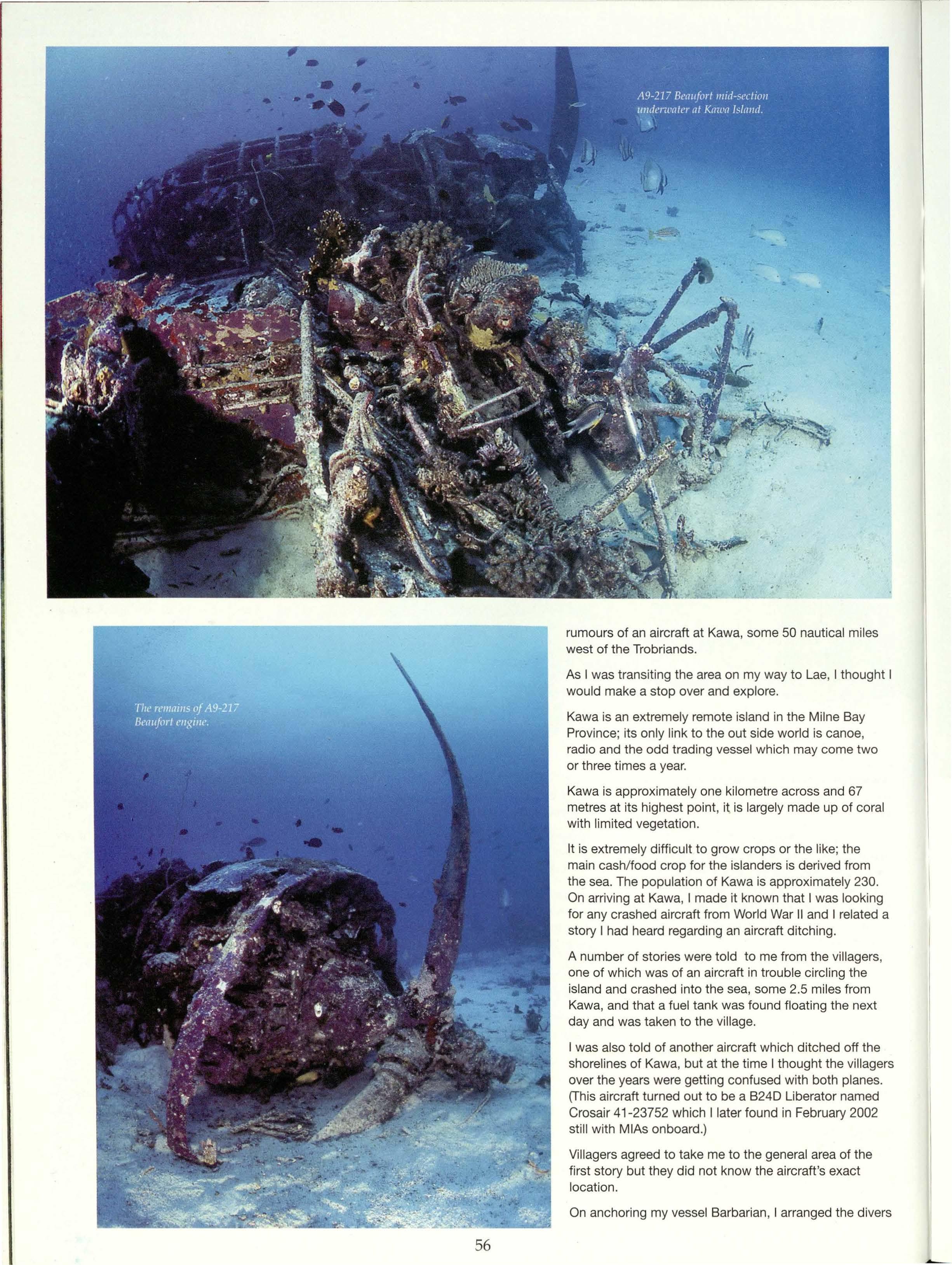
rumours of an aircraft at Kawa, some 50 nautical miles west of the Trobriands.
As I was transiting the area on my way to Lae, I thought I would make a stop over and explore.
Kawa is an extremely remote island in the Milne Bay Province; its only link to the out side world is canoe, radio and the odd trading vessel which may come two or three times a year.
Kawa is approximately one kilometre across and 67 metres at its highest point, it is largely made up of coral with limited vegetation.
It is extremely difficult to grow crops or the like; the main cash/food crop for the islanders is derived from the sea. The population of Kawa is approximately 230. On arriving at Kawa, I made it known that I was looking for any crashed aircraft from World War II and I related a story I had heard regarding an aircraft ditching.
A number of stories were told to me from the villagers, one of which was of an aircraft in trouble circling the island and crashed into the sea, some 2.5 miles from Kawa, and that a fuel tank was found floating the next day and was taken to the village.
I was also told of another aircraft which ditched off the shorelines of Kawa, but at the time I thought the villagers over the years were getting confused with both planes. (This aircraft turned out to be a B24D Liberator named Crosair 41-23752 which I later found in February 2002 still with MIAs onboard.)
Villagers agreed to take me to the general area of the first story but they did not know the aircraft's exact location.
On anchoring my vessel Barbarian, I arranged the divers
to do a sweep of the area. Not much hope was given and I thought it would be a waste of time. But after a long wait, Tim Doyle arrived back on the surface saying he had found the wreckage of an unidentified aircraft in two pieces and in 15 metres of water, not 100 metres from the my anchored vessel.
On entering the water myself and examining the wreckage, I knew straight away it was a Beaufort. Even though the main section was upside down, the tail plane was approx 40-50 metres away but right side up, and visibility was not good.
Crew: Four.
Powerplants: 2 X CAC built Pratt & Whitney
R-1830-S3C4G 14 cylinder air cooled double row radials with 2 speed supercharges, rated at 1,050hp at 13,000 ft.
Dimensions: Wingspan 57ft 10inches (17 .63m)
Length 44Ft 3 in (13.49m)
Height 15ft 10in (4.83m)
Undercarriage track 18ft (5.49m)
Wing Area 503sq ft (46.73m2)
Weights: Max. loaded 22500Ibs (10,206kg)
Armament: Two gimbal mounted 0.303in machine guns, two 0.303in machine guns in hydraulically operated dorsal turret.
Offensive: 2 X 500Ib (227kg) or 4 X 250Ib (113kg) or one 21 in (53cm) torpedo, plus 2 X 250lb (113kg) bombs on underwing racks.
Performance: Max. speed 268mpg (431km/h) at 14,000 ft. 1,060mls (1.706km) with standard fuel.
Special Equipment: British ASA Radar.
Squadron Motto: Seek and Destroy.
Squadron Code: NN, UV, H Casualties: 79 died.
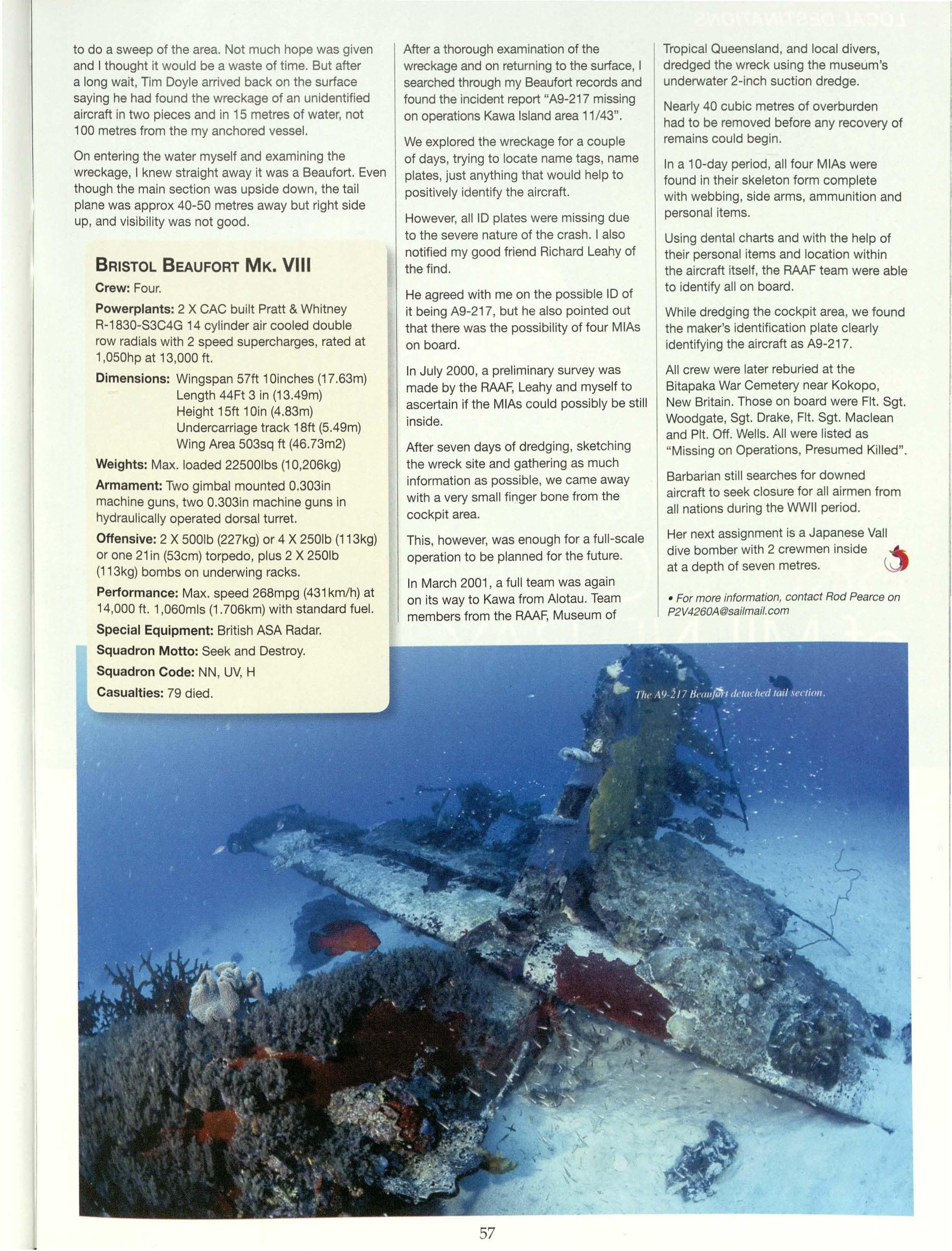
After a thorough examination of the wreckage and on returning to the surface, I searched through my Beaufort records and found the incident report "A9-217 missing on operations Kawa Island area 11/43".
We explored the wreckage for a couple of days, trying to locate name tags, name plates, just anything that would help to positively identify the aircraft.
However, all ID plates were missing due to the severe nature of the crash. I also notified my good friend Richard Leahy of the find.
He agreed with me on the possible ID of it being A9-217, but he also pointed out that there was the possibility of four MIAs on board.
In July 2000, a preliminary survey was made by the RAAF, Leahy and myself to ascertain if the MIAs could possibly be still inside.
After seven days of dredging, sketching the wreck site and gathering as much information as possible, we came away with a very small finger bone from the cockpit area.
This, however, was enough for a full-scale operation to be planned for the future.
In March 2001, a full team was again on its way to Kawa from Alotau. Team members from the RAAF, Museum of
Tropical Queensland, and local divers, dredged the wreck using the museum's underwater 2-inch suction dredge.
Nearly 40 cubic metres of overburden had to be removed before any recovery of remains could begin.
In a 10-day period, all four MIAs were found in their skeleton form complete with webbing, side arms, ammunition and personal items.
Using dental charts and with the help of their personal items and location within the aircraft itself, the RAAF team were able to identify all on board.
While dredging the cockpit area, we found the maker's identification plate clearly identifying the aircraft as A9-217.
All crew were later reburied at the Bitapaka War Cemetery near Kokopo, New Britain. Those on board were Flt. Sgt. Woodgate, Sgt. Drake, Flt. Sgt. Maclean and Pit. Off. Wells. All were listed as "Missing on Operations, Presumed Killed".
Barbarian still searches for downed aircraft to seek closure for all airmen from all nations during the WWII period.
Her next assignment is a Japanese Vall dive bomber with 2 crewmen inside at a depth of seven metres. U
• For more information, contact Rod Pearce on P2V4260A@sailmail.com
BY ROB DUNLOP

The coastal track is lined with tropical vegetation and fallen coconuts.
Flowering red orchards and delicate butterflies provide a striking contrast to what I'm about to uncover.
Leading off the track is a narrower path to a limestone cave with a very dark entrance. Henry, my guide, shines a torch into the cave. I take a peek inside. It smells musty. Further in, beautiful, shimmering stalactites decorate the cave. But at the bottom of the curtain of dripping glistening quartz is a pile of human skulls!
There are around 200 of them. Our guide, Henry, says the skulls are from the victims of inter-village warring between nearby Hiliwau and Wagohuhu. And that it was common practice to keep the skulls in homes as a symbol of strength. But when this practice was outlawed, the skulls were hidden in caves and forgotten about until they were recently discovered.
Today, two caves in the area can be
visited; others too dangerous to enter are said to contain skeletal remains from other body parts. Myth suggests that the body parts also formed part of the cannibalism ritual.
Away from the caves, theories about the origin of the skulls are merrily debated. Another theory is that important tribespeople were once buried upright with their heads above ground, covered by a clay pot. And over time when the skulls eventually dislodged, the skulls were moved to the "skull caves".
Throughout PNG's tropical paradise of Milne Bay Province, in the extreme southeastern peninsular of Papua New Guinea mainland, skull caves are scattered.
Exploration of these two skull caves is offered by the nearby Tawali resort, a 10-minute boat ride away. Apart from being utterly fascinating for visitors, the tour also provides a source of income for local villages, who have granted permission to visit.
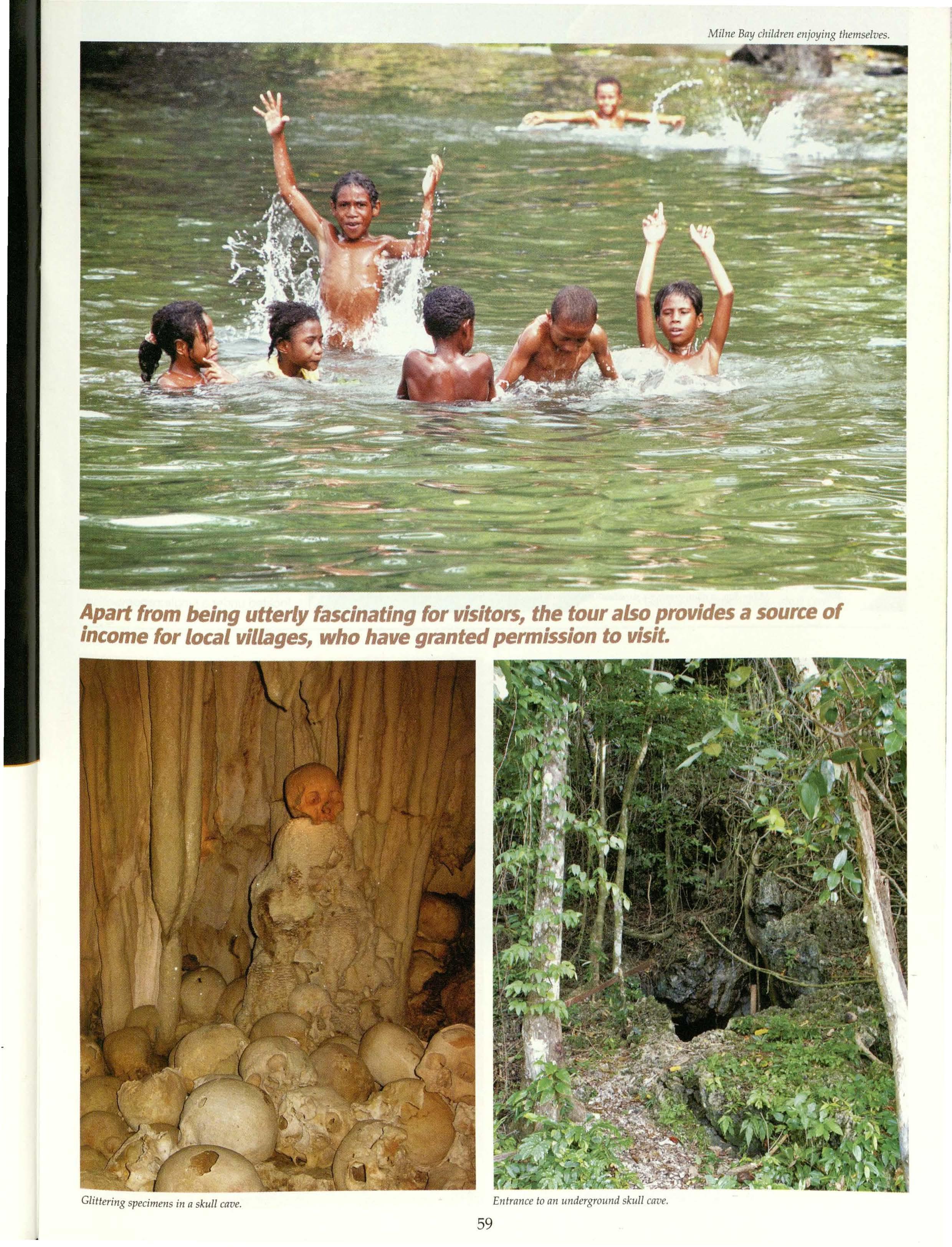
Apart from being utterly fascinatingfor visitors,the tour alsoprovidesa sourceof incomefor local villages,who have grantedpermissionto visit.
Thegreater Milne Bayarea providesaccessto hundredsof islands,caysand atolls offeringperfect opportunitiesfor diving, snorkellingand plain old swimming.
The Tawali resort, hand constructed from local timber by villagers in the mid-1990s, is still considered one of PNG's premier resorts.
Although it was developed by diving enthusiasts to take advantage of some of the best diving opportunities in the world, the remoteness of the resort lends itself to an idyllic South Pacific escapeaway.
Accessible only by boat, after a one-hour flight from Port Moresby, followed by 90-minute drive and then a 30-minute boat trip, the resort straddles a rainforest and a volcanic bluff, overlooking a coral reef.
The underwater magic of Milne Bay can be accessed directly from the resort's white sandy beach and its wharves.
The "house reef" offers a teaser for the underwater walls, caves and caverns, which can be swum through. Marine life includes sea horses, ~at fish and ghost pipe fish.
The greater Milne Bay area provides access to hundreds of islands, cays and atolls - offering perfect opportunities for diving, snorkelling and plain old swimming.
Deacons Reef is a 10-metre shelf located under a jungle canopy,
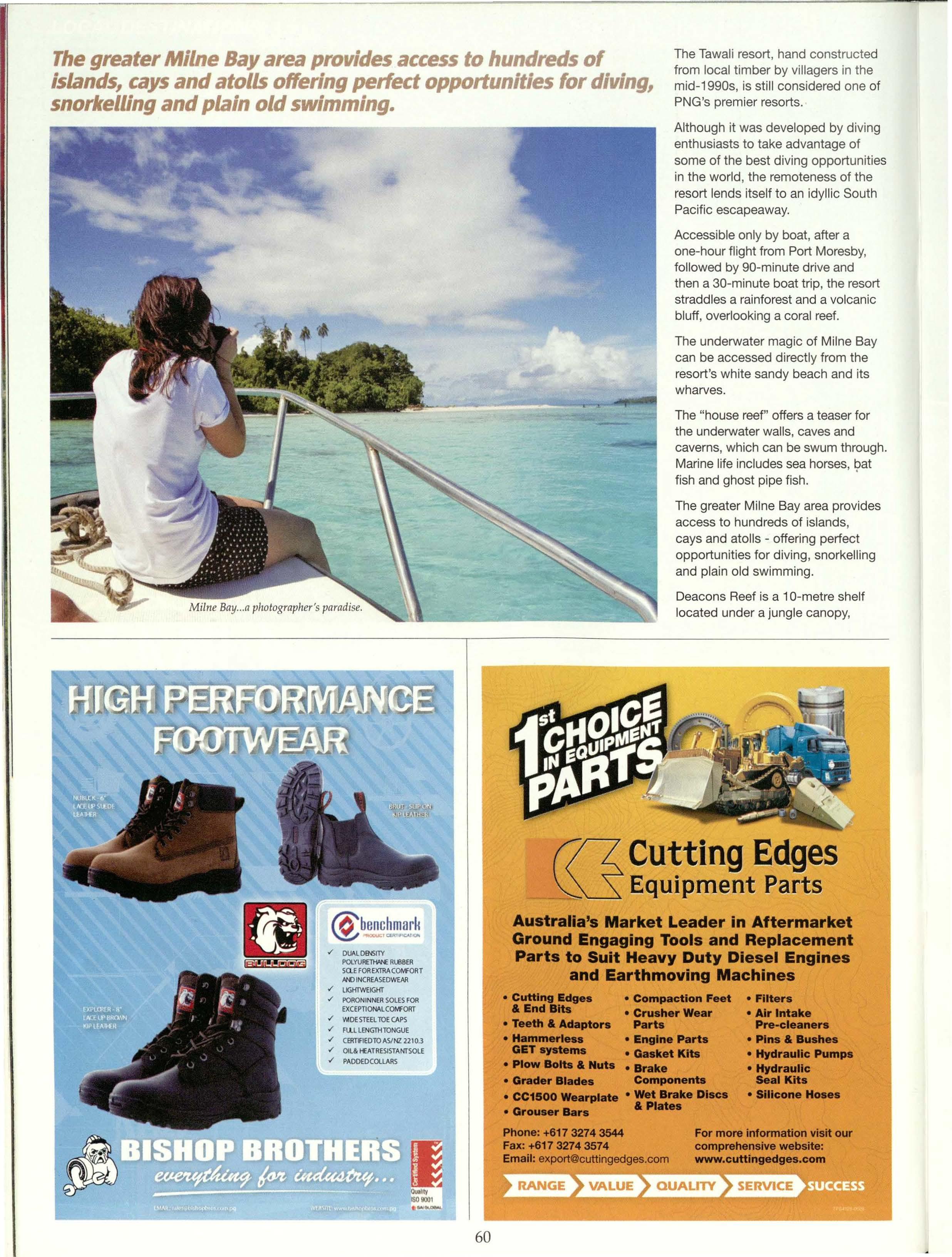
DUALDENSnY
POLYURrn-WERLeBER SO.EFOREXTRACOWfORT N-0 INCREASEDWEAR LIGHTWEIGHT PORONINNERSOLESFOR EXCEPTIONALCOM=ORT 'MOESTEELTOECAPS Fll.l LENGTHTONGUE
CERTF1ED10AS/NZ2210,3
OIL&t-EATRESISTANTSOLE PAODEDCOLLARS
Australia's Market Leader in Aftermarket Ground Engaging Tools and Replacement Parts to Suit Heavy Duty Diesel Engines and Earthmoving Machines
• Cutting &dgea & End Bits
• Teeth & Adaptors
• Hammer! QETayatema
• PI- Bolts & Nuts
• Compaction F-t
• Crusher Wear Parts
• &nglne Parts
• Gasket Kita
• Brake
• Grader Blades Components
• CC1800 Wearplate • Wet Brake Dlaca
• Qr-, Bara & Plates
Phone: +617 3274 3544 Fax: +617 3274 3574 Email: export@cuttingedges.com
• FIiters
• Air Intake Pre-cleaners
• Pina & Bushes
• Hydraulic Pumps
• Hydraulic Seal Kita
• SIiicone Hosea
more information visit our comprehensive website: www.cuttlngedges.com
where gorgonians grow only metres from the rainforest. While divers chance it with whale sharks, hammerheads and mantas, snorkellers can paddle across the beautiful shallow reefs.
Corals are on show for both divers and snorkellers at the Coral Garden site, which has a wonderful collection of hard corals in shallow waters.
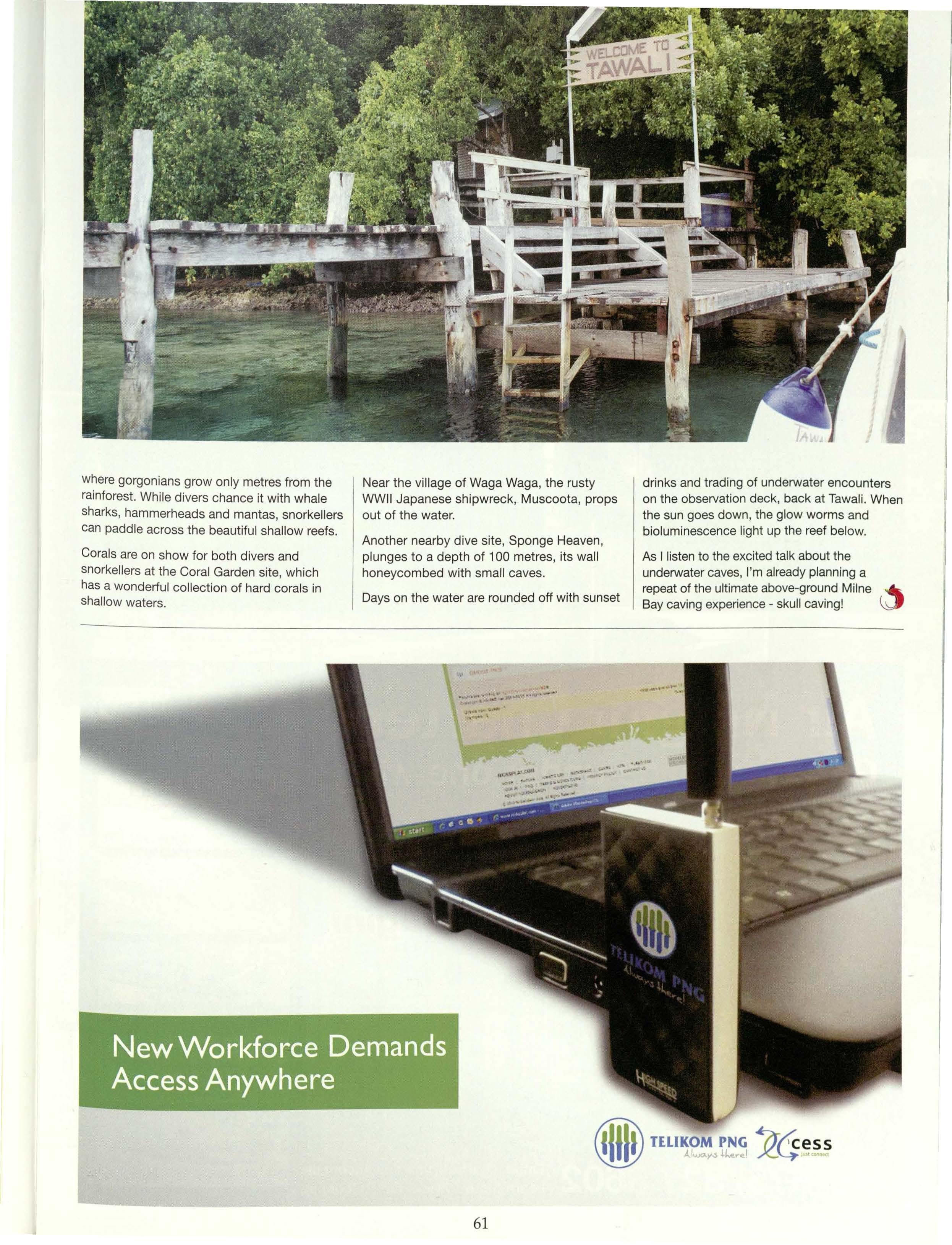
Near the village of Waga Waga, the rusty WWII Japanese shipwreck, Muscoota, props out of the water.
Another nearby dive site, Sponge Heaven, plunges to a depth of 100 metres, its wall honeycombed with small caves.
Days on the water are rounded off with sunset
drinks and trading of underwater encounters on the observation deck, back at Tawali. When the sun goes down, the glow worms and bioluminescence light up the reef below.
As I listen to the excited talk about the underwater caves, I'm already planning a repeat of the ultimate above-ground Milne Bay caving experience - skull caving!
GETTING THERE: Air Niugini flies from Port Moresby to Gurney Airport (Milne Bay). Visit www.airniugini.com.pg
STAYING THERE: Tawali Resort offers a dozen spacious timber cabins located in bushland with water views, and operates two 'live aboard' diving vessels. Phone + 675 641 o 922 or visit www.tawali.com.
Dive packages range from six nights to 14 nights. The sixnight package costs $US1 ,650
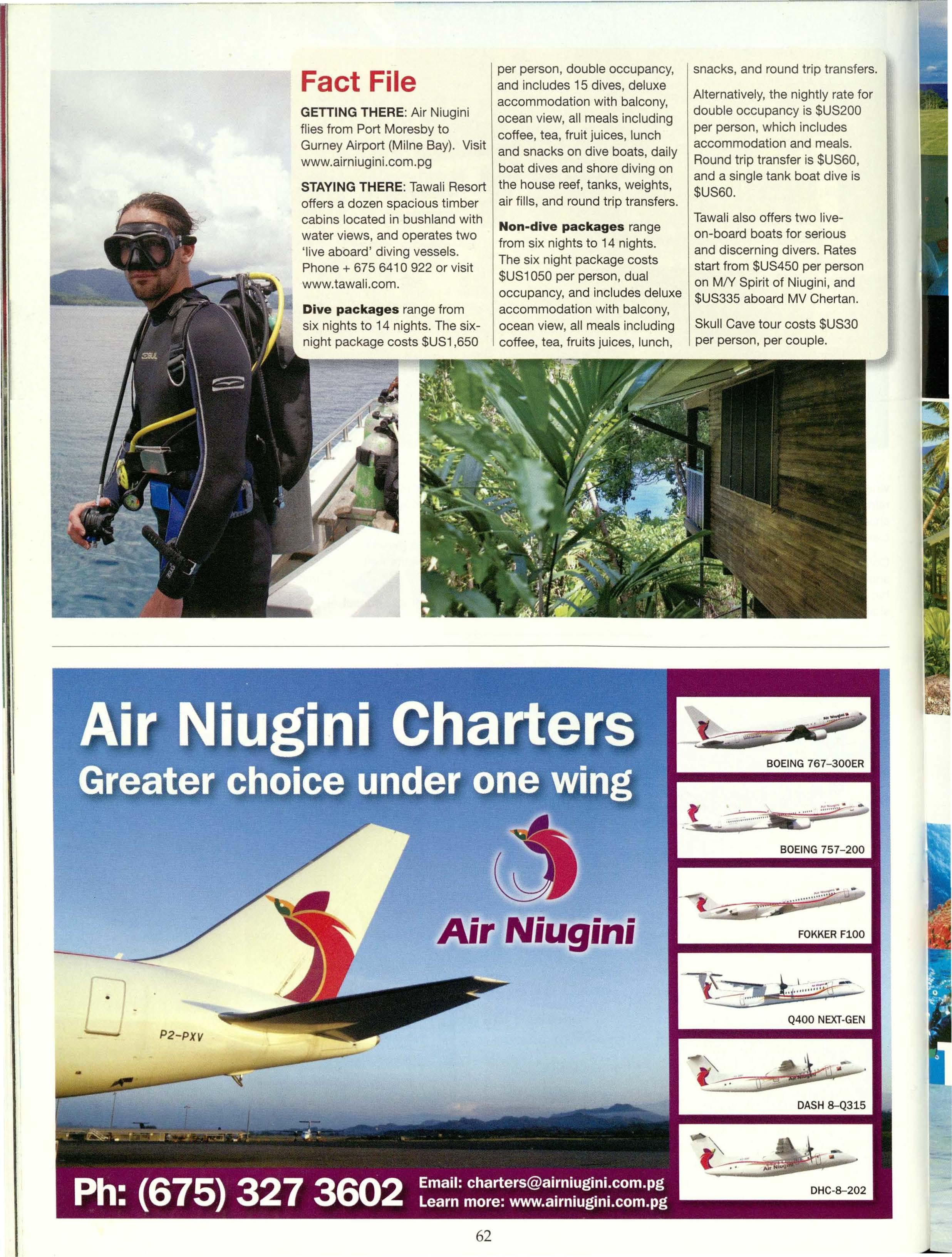
per person, double occupancy, and includes 15 dives, deluxe accommodation with balcony, ocean view, all meals including coffee, tea, fruit juices, lunch and snacks on dive boats, daily boat dives and shore diving on the house reef, tanks, weights, air fills, and round trip transfers.
Non-dive packages range from six nights to 14 nights. The six night package costs $US1050 per person, dual occupancy, and includes deluxe accommodation with balcony, ocean view, all meals including coffee, tea, fruits juices, lunch,
snacks, and round trip transfers.
Alternatively, the nightly rate for double occupancy is $US200 per person, which includes accommodation and meals. Round trip transfer is $US60, and a single tank boat dive is $US60.
Tawali also offers two liveon-board boats for serious and discerning divers. Rates start from $US450 per person on M/Y Spirit of Niugini, and $US335 aboard MV Chertan.
Skull Cave tour costs $US30
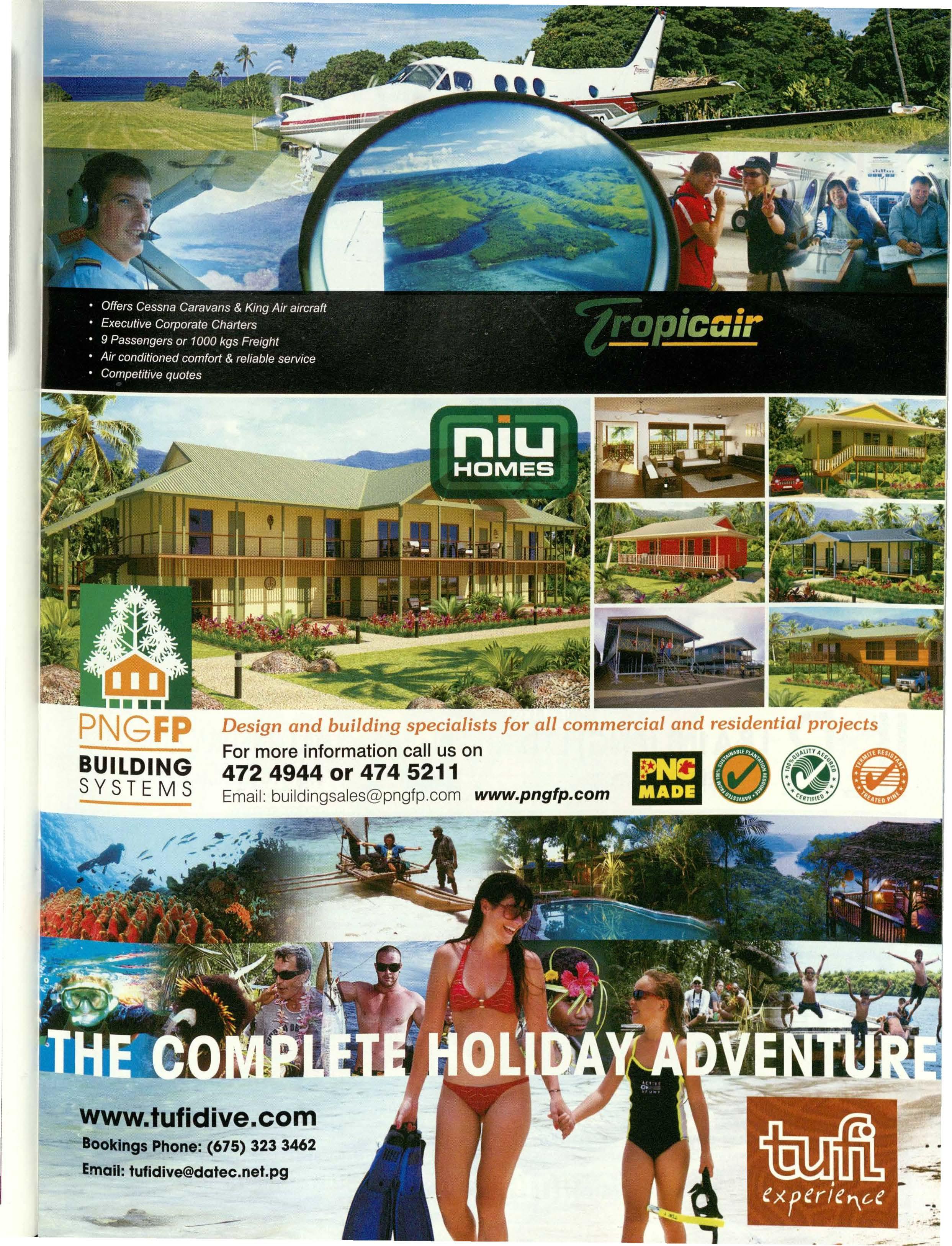
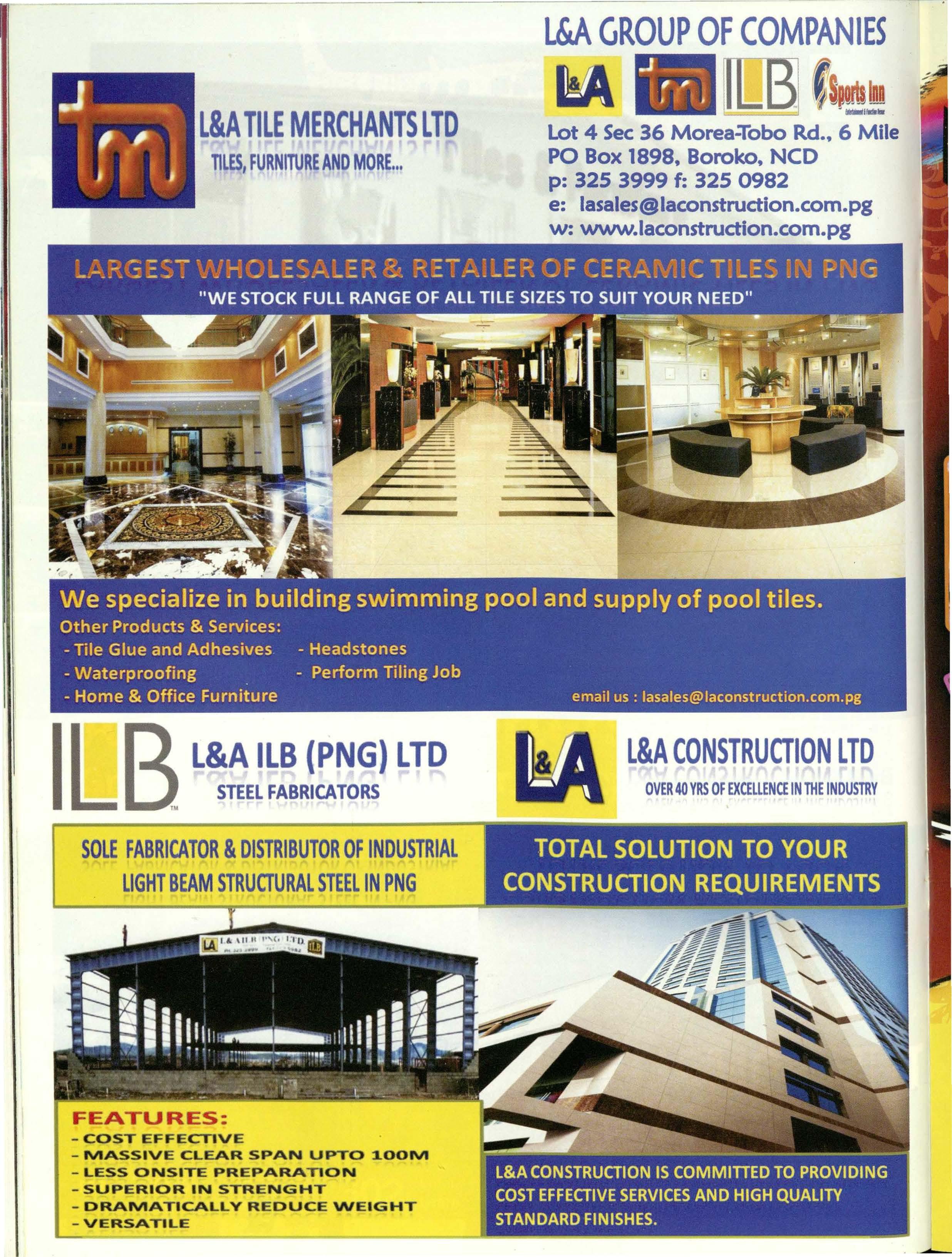
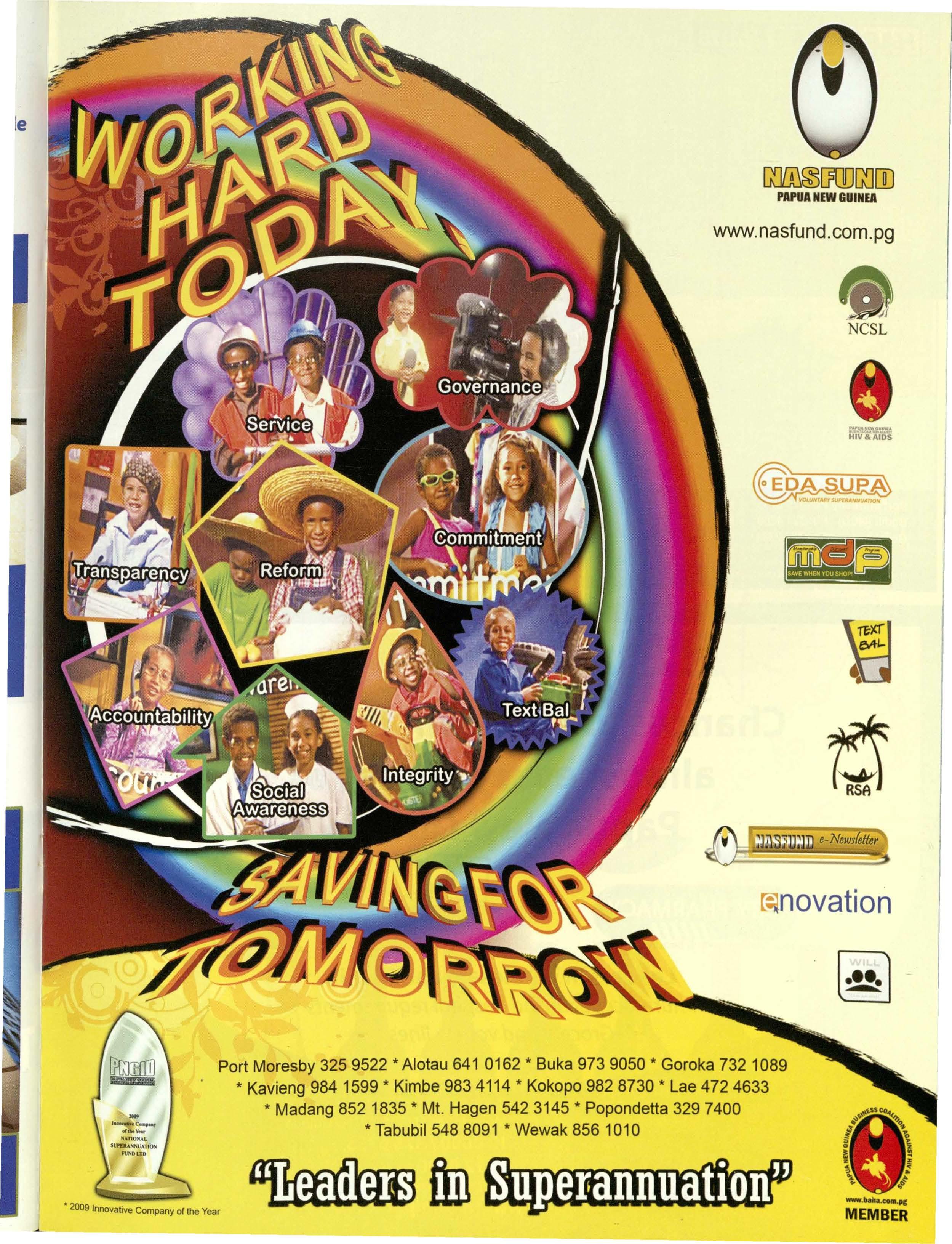
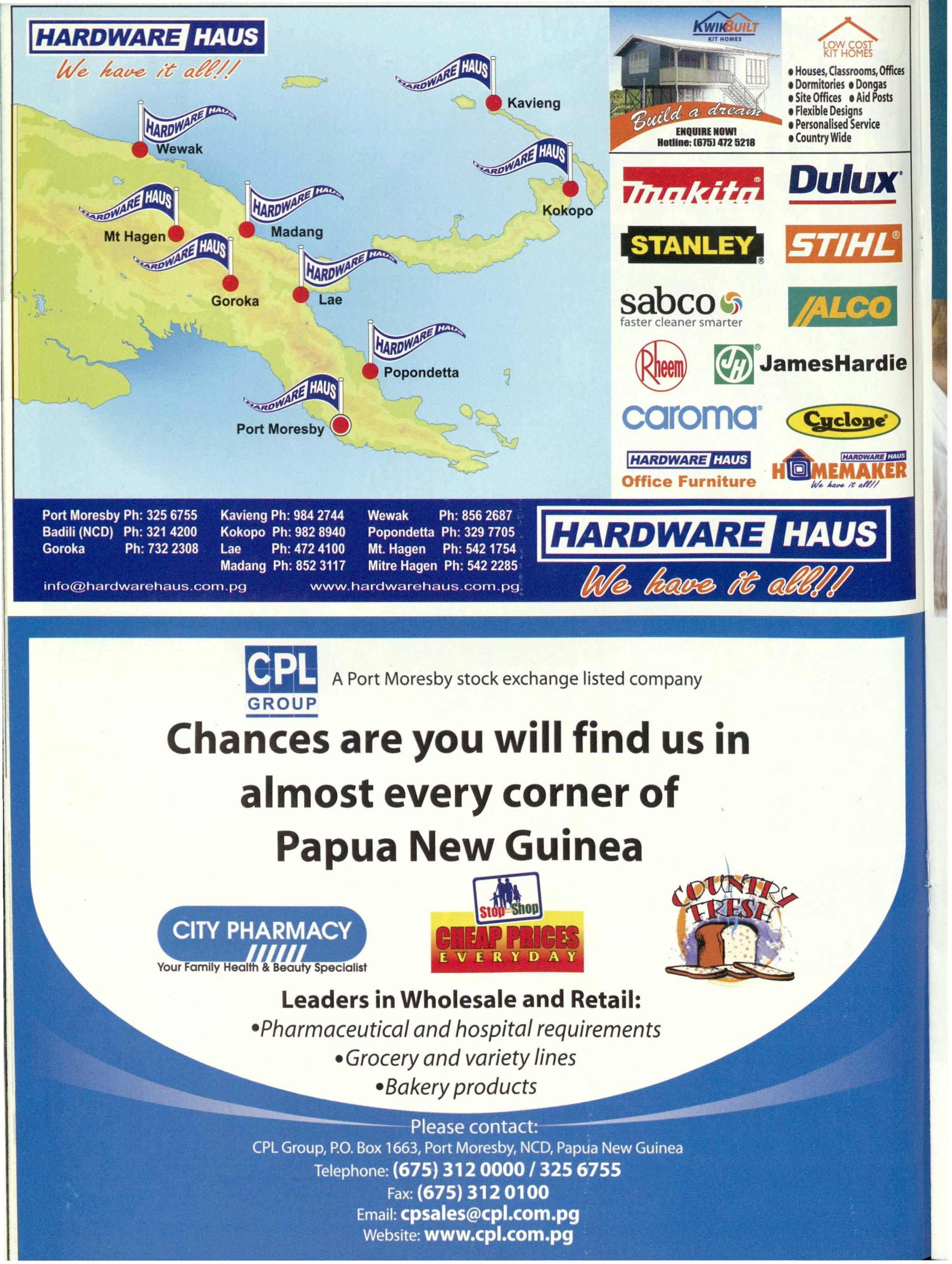
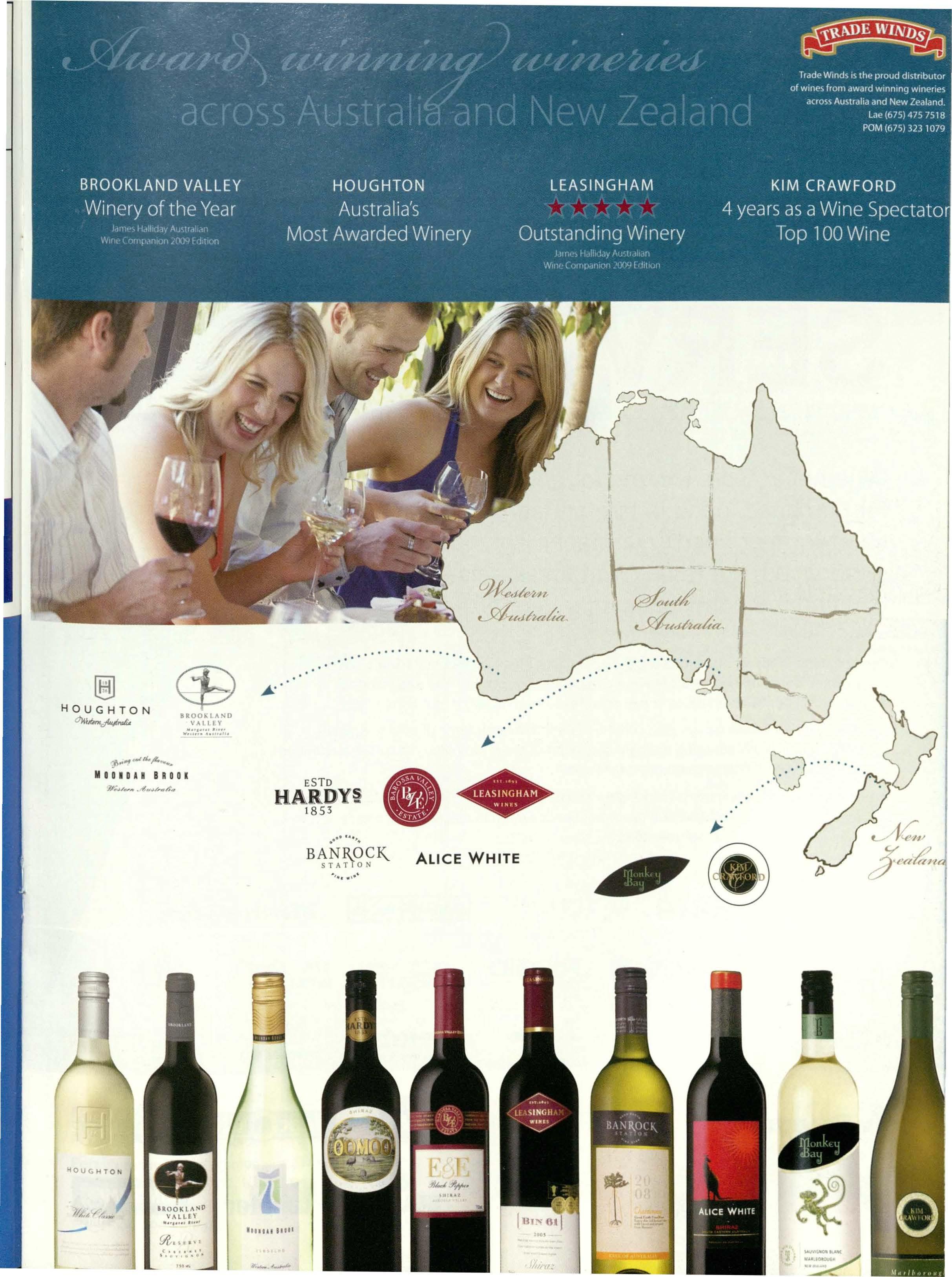

Whether you are looking for new equipment for purchase, need to hire a machine for the short-term or need your machinery maintained or serviced, our team of professionals will Help you find the right solution for your project.
Our business is strong - because of our people. Our Kingston Industrial Team have represented some of the world's leading companies & products. The knowledge & expertise that our team brings to you is what really sets us above our competitors. Our Commitment to our clients is to continue to improve standards of quality & service by selecting, supplying & servicing the best quality products & providing timely & experienced support from our dedicated team of professionals.
If we don't have the equipment you need in stock, we will source it & supply it quickly & efficiently. Contact our experienced customer service team to discuss your needs. We're sure you'll be surprised by what we can offer.

nyone who has ever visited the country knows or has heard about betel nut, more commonly known as buai in pidgin, or buatau in Motu.
It's that nut that many Papua New Guineans chew with lime and is the source of all those blood-red stains on Port Moresby's streets.
Nice people would call betel nut a stimulant, whilst those with a more medical inclination would call it a recreational psycho-active drug, since its consumption causes people to alter their perception, mood or behaviour.
Whatever the description, betel nut is an integral part of Papua New Guinea society.
Betel nut is found throughout Asia, where India is the largest consumer, and its consumption is an important component of religious devotions, often mixed with spices such as cardamom, cloves and even sugar and tobacco.
It is eaten in China, the Philippines, Taiwan, India, Sri Lanka, Pakistan, Myanmar, Cambodia, Thailand, Laos, Vietnam, Malaysia and Indonesia as well as many other Pacific islands nations.
BY JOHN BROOKSBANK
The plant is thought to have been domesticated in South-East Asia thousands of years ago and made its way to PNG along with one or more of the various waves of Austronesian migrants to this part of the world during the last 4,000 years, along with pigs, dogs and chickens.
Today, buai is pervasive in Papua New Guinea, found in towns and villages in all parts of the country. But it wasn't always so.
Betel nut cannot grow at higher altitudes and was unknown in the Highlands until the colonial administration developed roads, Highlands labour was employed on coastal copra plantations and there was greater movement of people around the country.
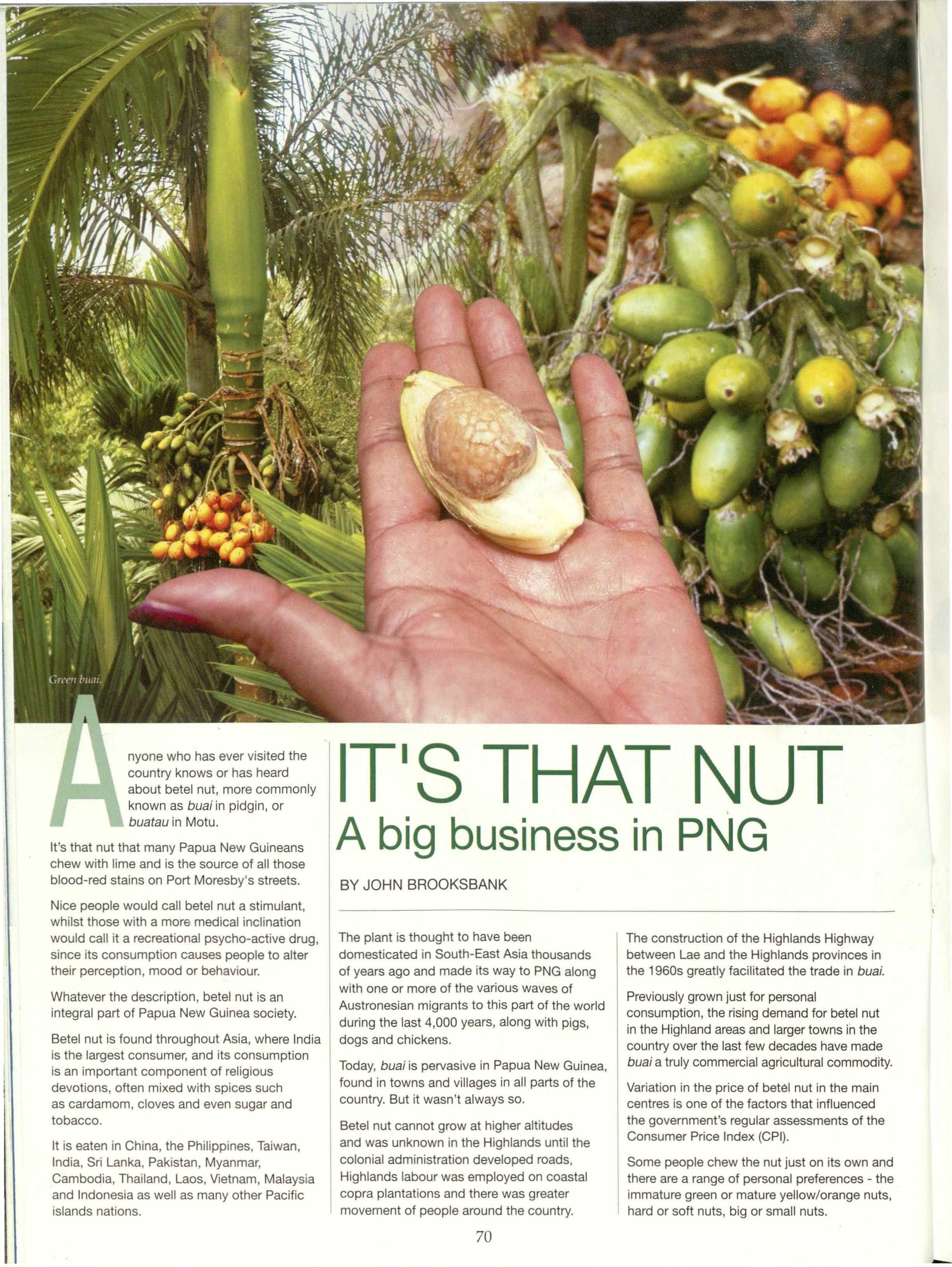
The construction of the Highlands Highway between Lae and the Highlands provinces in the 1960s greatly facilitated the trade in buai.
Previously grown just for personal consumption, the rising demand for betel nut in the Highland areas and larger towns in the country over the last few decades have made buai a truly commercial agricultural commodity.
Variation in the price of betel nut in the main centres is one of the factors that influenced the government's regular assessments of the Consumer Price Index (CPI).
Some people chew the nut just on its own and there are a range of personal preferences - the immature green or mature yellow/orange nuts, hard or soft nuts, big or small nuts.
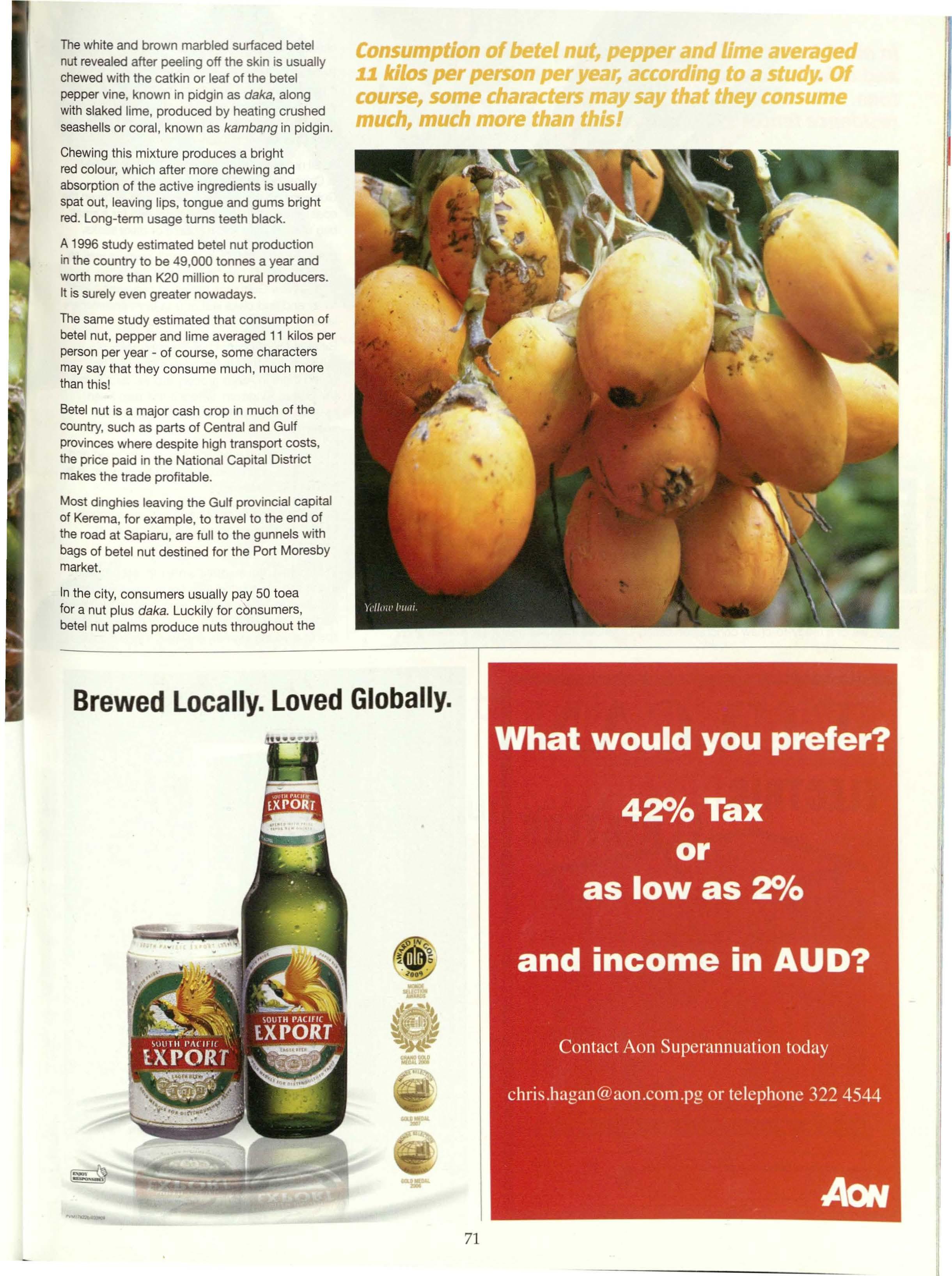
The white and brown marbled surfaced betel nut revealed after peeling off the skin is usually chewed with the catkin or leaf of the betel pepper vine, known in pidgin as daka, along with slaked lime, produced by heating crushed seashells or coral, known as kambang in pidgin.
Chewing this mixture produces a bright red colour, which after more chewing and absorption of the active ingredients is usually spat out, leaving lips, tongue and gums bright red. Long-term usage turns teeth black.
A 1996 study estimated betel nut production in the country to be 49,000 tonnes a year and worth more than K20 million to rural producers. It is surely even greater nowadays.
The same study estimated that consumption of betel nut, pepper and lime averaged 11 kilos per person per year - of course, some characters may say that they consume much, much more than this!
Betel nut is a major cash crop in much of the country, such as parts of Central and Gulf provinces where despite high transport costs, the price paid in the National Capital District makes the trade profitable.
Most dinghies leaving the Gulf provincial capital of Kerema, for example, to travel to the end of the road at Sapiaru, are full to the gunnels with bags of betel nut destined for the Port Moresby market.
In the city, consumers usually pay 50 toea for a nut plus daka. Luckily for consumers, betel nut palms produce nuts throughout the
IIn mosttownsIn PapuaNew Guinea,sellingbetel nut and dakaIs a commonfamilyretail actlllityto earn a few toea. It Is earnedout on small tablesinsideor outside residencefencesand mannedby womenand children.
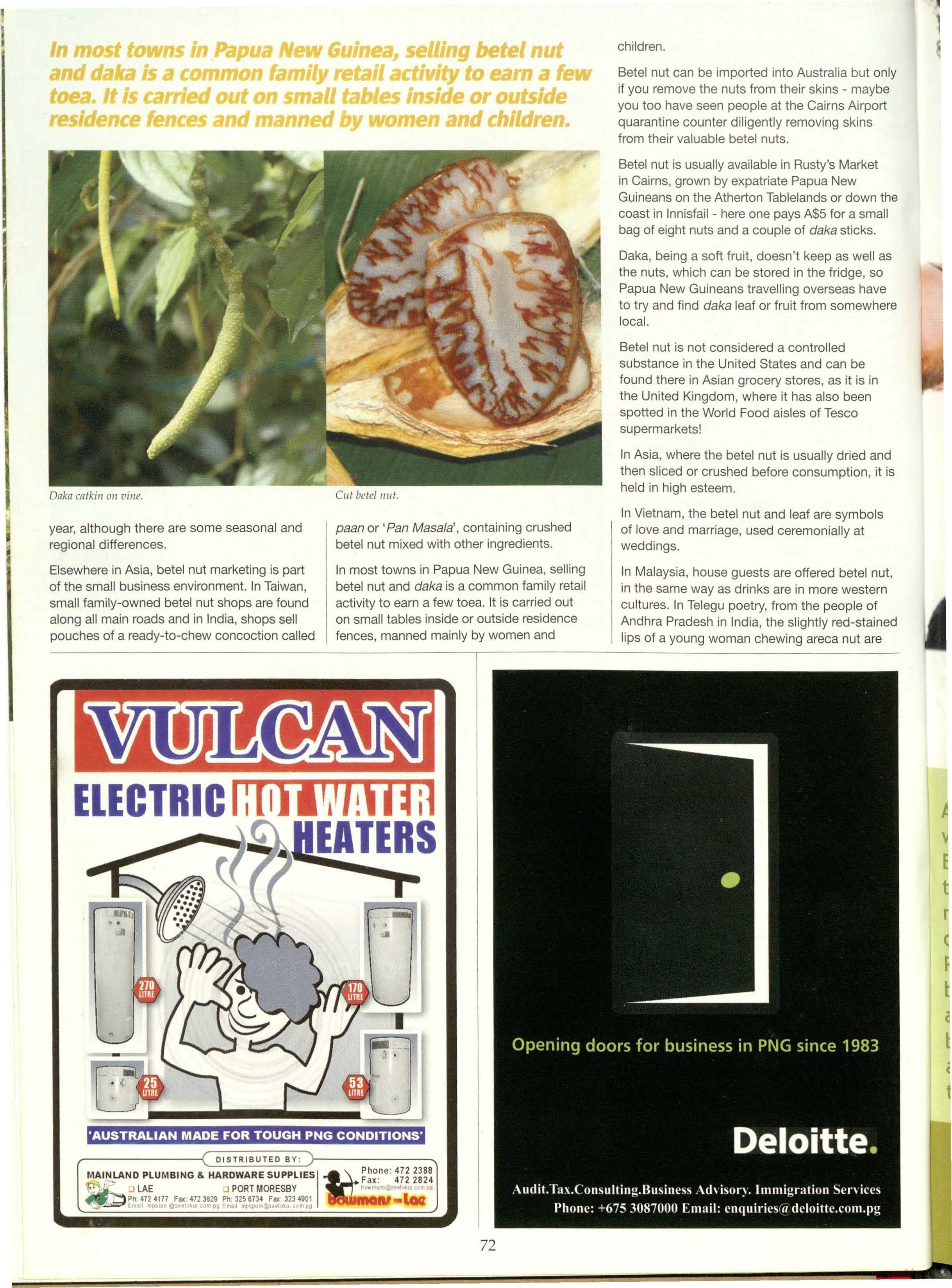
year, although there are some seasonal and regional differences.
Elsewhere in Asia, betel nut marketing is part of the small business environment. In Taiwan, small family-owned betel nut shops are found along all main roads and in India, shops sell pouches of a ready-to-chew concoction called
In most towns in Papua New Guinea, selling betel nut and daka is a common family retail activity to earn a few toea. It is carried out on small tables inside or outside residence fences, manned mainly by women and
children.
Betel nut can be imported into Australia but only if you remove the nuts from their skins - maybe you too have seen people at the Cairns Airport quarantine counter diligently removing skins from their valuable betel nuts.
Betel nut is usually available in Rusty's Market in Cairns, grown by expatriate Papua New Guineans on the Atherton Tablelands or down the coast in lnnisfail - here one pays A$5 for a small bag of eight nuts and a couple of daka sticks.
Daka, being a soft fruit, doesn't keep as well as the nuts, which can be stored in the fridge, so Papua New Guineans travelling overseas have to try and find daka leaf or fruit from somewhere local.
Betel nut is not considered a controlled substance in the United States and can be found there in Asian grocery stores, as it is in the United Kingdom, where it has also been spotted in the World Food aisles of Tesco supermarkets!
In Asia, where the betel nut is usually dried and then sliced or crushed before consumption, it is held in high esteem.
In Vietnam, the betel nut and leaf are symbols of love and marriage, used ceremonially at weddings.
In Malaysia, house guests are offered betel nut, in the same way as drinks are in more western cultures. In Telegu poetry, from the people of Andhra Pradesh in India, the slightly red-stained lips of a young woman chewing areca nut are
"The role we play in the PNG
As an independent business unit, Which is a part of PNG Institute of Banking and Business Management, the Enterprise Centre offers a unique mix of services for the local supplier development arm of the PNG LNG Project. It works to assist capacity buildingof local PNGbusiness,manages an information centre, facilitates businessopportunities and maintains a database of potential suppliers for the PNG LNG Project
,.

Project Information Centre
Maintain a PNG LNG Supplier database
.,,,. Communication of Business Opportunities from the project to PNG Busine~ses
.,,,. Interface between contractors, sub contractors and PNG businesses
Capacity build PNG Businesses
PNG Business Assessments
,, Business Training
,. Mentoring, Advisory and Counseling Services

Fax:3259020
Email:admin@pom.esco.com.pg
P.O.Box1806,Lae Ph:4721933
Fax:4723043
Rabaul / Kokopo
P.O.Box2153,Rabaul Ph:9829154
Fax:9829170
P.O.Box99,Kimbe Ph:9834205 Fax:9834214
considered a mark of beauty.
The Assamese in India use the nut in religious and marriage ceremonies, where it is a fertility symbol. In China and parts of India, powdered areca nut is an important component of traditional Chinese and Ayurvedic medicines used for toothache, bad breath and to remove tapeworms and other internal parasites!
In Papua New Guinea also, chewing of betel nut was traditionally part of ceremony and village good manners. If a visitor came to a home, he or she is offered buai and in Milne Bay, elaborately decorated lime containers are still being used.
Older people whose teeth have rotted away - often leaving red or.black gums - satisfy their appetite for betel nut by crushing it with daka and kambang in a separate wooden vessel, similar to a cook's mortar and pestel, prior to chewing.
Today, buai is sold on almost every street corner, available at any time of the night or day. Along Boroko Drive in Gordons near the SP Brewery roundabout in Port Moresby is 'buai central' - here many roadside stalls are set up to serve hungry customers.
Betel nut is in some way a unifying element amongst Papua New Guinea's numerous languages and cultures, being commonly given as a gift or shared in the same way as cigarettes are shared amongst friends with the same 'drug habit'.
The lowland betel nut palm, Areca catechu, grows in most coastal and lowland areas of the country, up to an altitude of about 1100 metres, where half the population live.
There is also the highland betel nut, Areca
COMPLETERANGEOF:
• SOLARWORLD PANELS Also
• VILLAGELIGHTINGKITS
• SOLARREGULATORS
• SOLARBATTERIES
• 12 VOLT LIGHTS& CABLES
• 12 VOLTSOLARPUMPS
• 12V & 24V INVERTERS
• SOLARREFRIGERATION
MaintenancefreeVRLA Batteriesfor UPSSystems EmergencyLighting & SecuritySystem
macrocalyx, that grows mainly in the Eastern Highlands and Morobe provinces but it is not as popular since it has a smaller fruit. It is probably an indigenous species domesticated after the introduction of the lowland variety from South East Asia.
Betel nuts from the North Solomons are a particularly large variety and are very much sought after by buai 'addicts'.
The betel pepper or daka vine also has two varieties that grow in lowland and highlands areas - known botanically as Piper betle or the much more exciting sounding Piper gibbilimbum, respectively.
Wherever buai is chewed, its effects are similar, due to its mixture of constituent chemicals including three alkaloids found in the areca nut - Arecoline, Arecain & Guvacine - which all have vasoconstricting properties, as does the eugenol found in the betel pepper parts.
Chewing betel nut acts as a mild stimulant, causing a hot sensation in the body and a heightened alertness, although effects vary from person to person.
Personally, during the few times I have tried, buai caused me to sweat profusely, my face to redden and the inside of my mouth to numb which, like a trip to the dentist, was not particularly pleasant.
However, to hardened chewers, chewing buai is an essential part of life, necessary
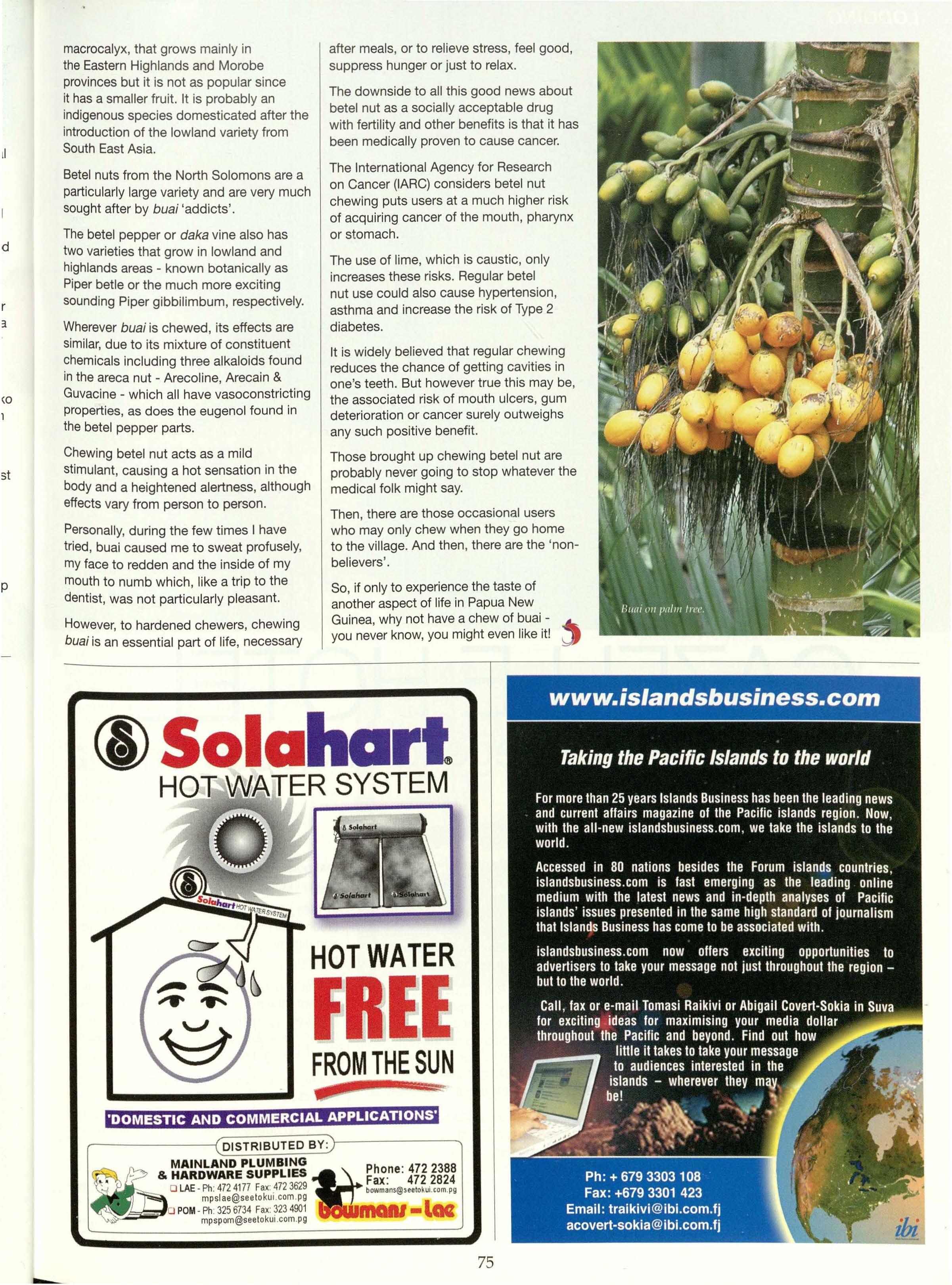
after meals, or to relieve stress, feel good, suppress hunger or just to relax.
The downside to all this good news about betel nut as a socially acceptable drug with fertility and other benefits is that it has been medically proven to cause cancer.
The International Agency for Research on Cancer (IARC) considers betel nut chewing puts users at a much higher risk of acquiring cancer of the mouth, pharynx or stomach.
The use of lime, which is caustic, only increases these risks. Regular betel nut use could also cause hypertension, asthma and increase the risk of Type 2 diabetes.
It is widely believed that regular chewing reduces the chance of getting cavities in one's teeth. But however true this may be, the associated risk of mouth ulcers, gum deterioration or cancer surely outweighs any such positive benefit.
Those brought up chewing betel nut are probably never going to stop whatever the medical folk might say.
Then, there are those occasional users who may only chew when they go home to the village. And then, there are the 'nonbelievers'.
So, if only to experience the taste of another aspect of life in Papua New Guinea, why not have a chew of buai
you never know, you might even like
BY EURALIA PAINE gaze
r ,I He el
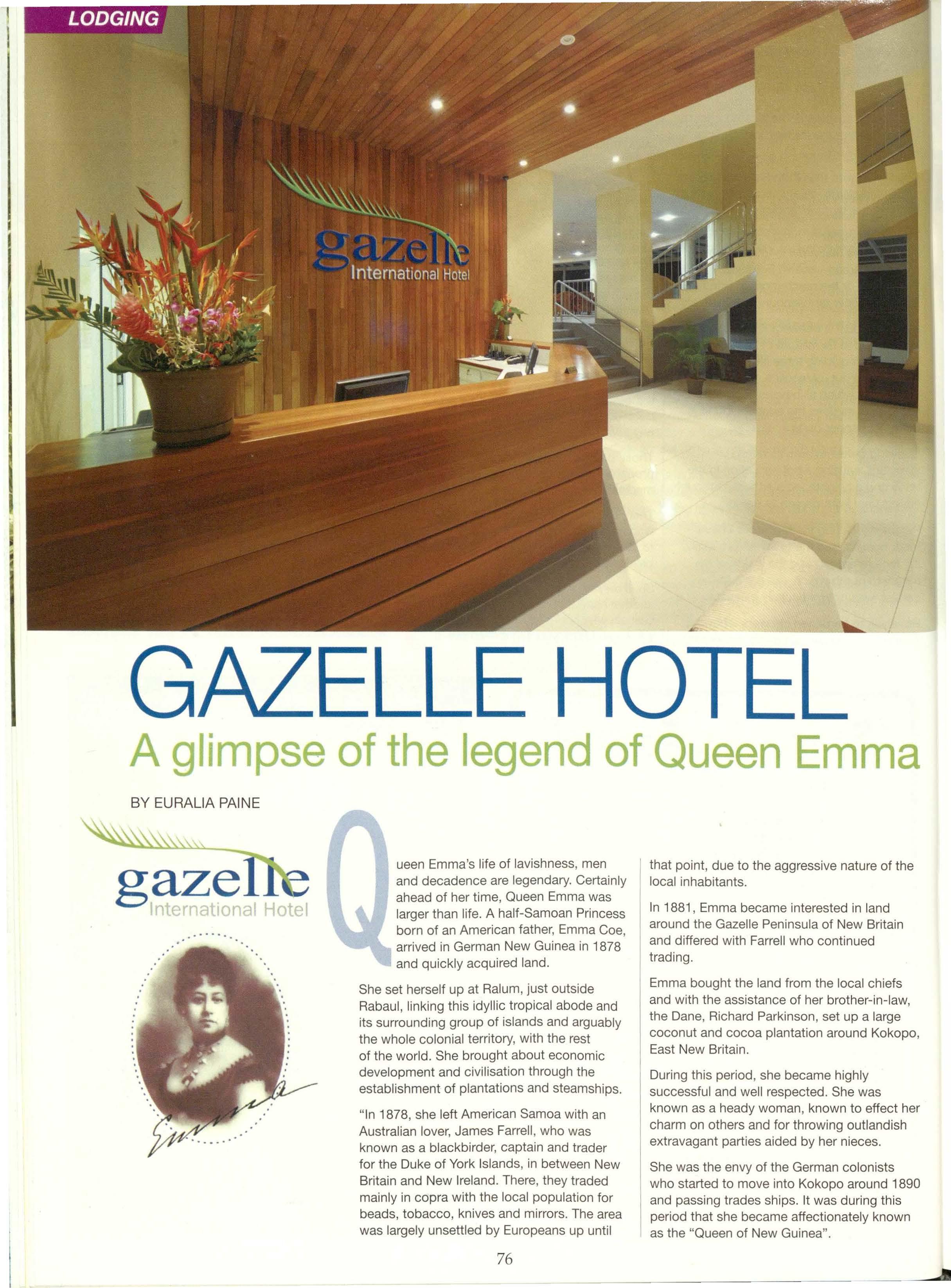
ueen Emma's life of lavishness, men and decadence are legendary. Certainly ahead of her time, Queen Emma was larger than life. A half-Samoan Princess born of an American father, Emma Coe, arrived in German New Guinea in 1878 and quickly acquired land.
She set herself up at Ralum, just outside Rabaul, linking this idyllic tropical abode and its surrounding group of islands and arguably the whole colonial territory, with the rest of the world. She brought about economic development and civilisation through the establishment of plantations and steamships.
"In 1878, she left American Samoa with an Australian lover, James Farrell, who was known as a blackbirder, captain and trader for the Duke of York Islands, in between New Britain and New Ireland. There, they traded mainly in copra with the local population for beads, tobacco, knives and mirrors. The area was largely unsettled by Europeans up until
that point, due to the aggressive nature of the local inhabitants.
In 1881, Emma became interested in land around the Gazelle Peninsula of New Britain and differed with Farrell who continued trading.
Emma bought the land from the local chiefs and with the assistance of her brother-in-law, the Dane, Richard Parkinson, set up a large coconut and cocoa plantation around Kokopo, East New Britain.
During this period, she became highly successful and well respected. She was known as a heady woman, known to effect her charm on others and for throwing outlandish extravagant parties aided by her nieces.
She was the envy of the German colonists who started to move into Kokopo around 1890 and passing trades ships. It was during this period that she became affectionately known as the "Queen of New Guinea".
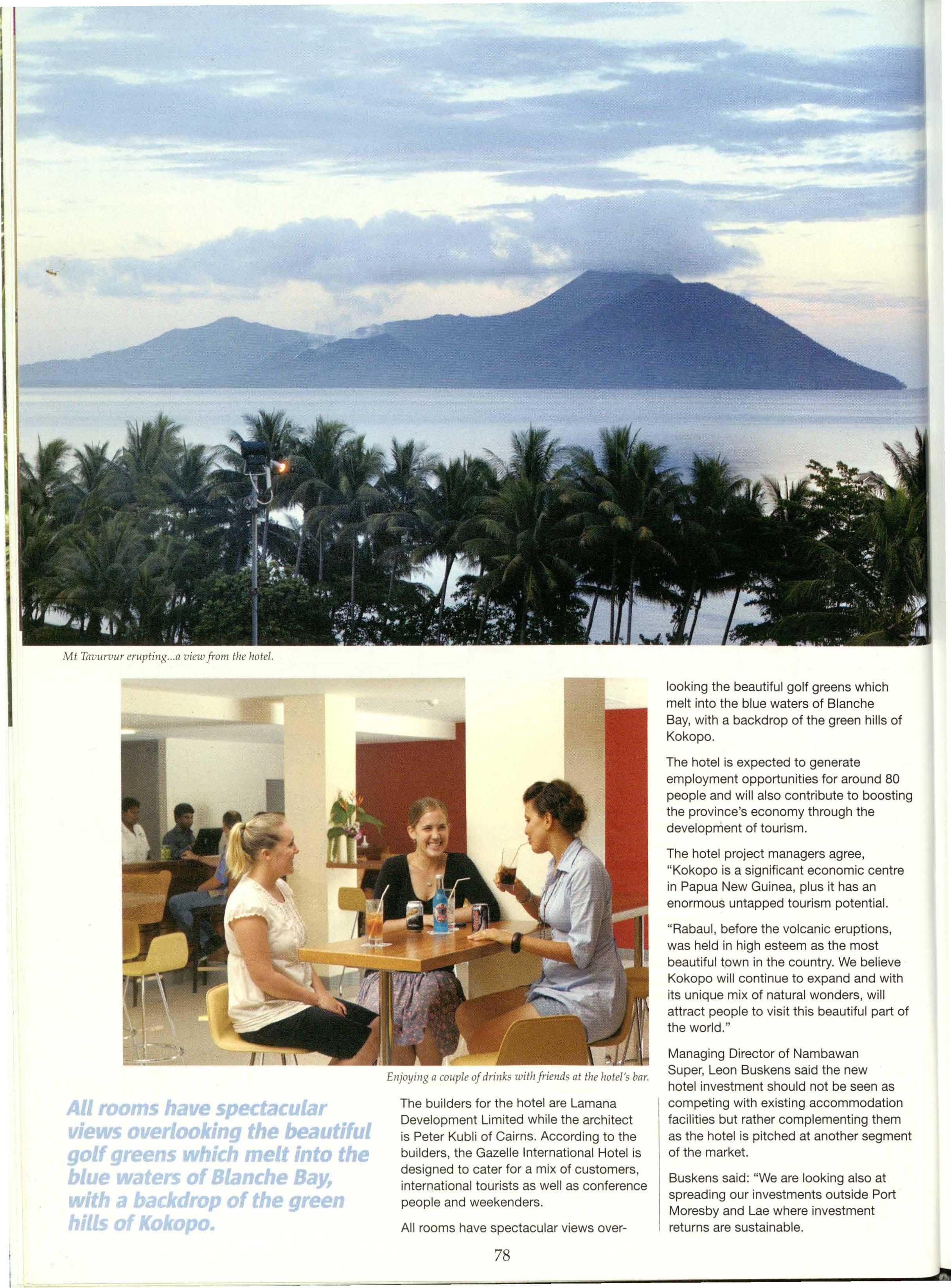
All roomshave spectacular viewsoverlookingthe beautiful golf greens whichmelt into the blue waters of BlancheBay, with a backdropof the green hilts of Kokopo.
Enjoyinga coupleof drinks with friends at the hotel's bar.
The builders for the hotel are Lamana Development Limited while the architect is Peter Kubli of Cairns. According to the builders, the Gazelle International Hotel is designed to cater for a mix of customers, international tourists as well as conference people and weekenders.
All rooms have spectacular views over-
looking the beautiful golf greens which melt into the blue waters of Blanche Bay, with a backdrop of the green hills of Kokopo.
The hotel is expected to generate employment opportunities for around 80 people and will also contribute to boosting the province's economy through the development of tourism.
The hotel project managers agree, "Kokopo is a significant economic centre in Papua New Guinea, plus it has an enormous untapped tourism potential.
"Rabaul, before the volcanic eruptions, was held in high esteem as the most beautiful town in the country. We believe Kokopo will continue to expand and with its unique mix of natural wonders, will attract people to visit this beautiful part of the world."
Managing Director of Nambawan Super, Leon Buskens said the new hotel investment should not be seen as competing with existing accommodation facilities but rather complementing them as the hotel is pitched at another segment of the market.
Buskens said: "We are looking also at spreading our investments outside Port Moresby and Lae where investment returns are sustainable.


• Construction Projects and Services
• Industrial & Commercial Works
• Residential& Civil Works

Services:
• Architectural
• Structural Steel
• Electrical & Air Conditioning
• Glass & Aluminium
• Joinery Manufacturers
• Plumbing & Gas
• Concrete Plant (80m3 per Hour)
Equipment Hire:
• Cranes from 20 to 110tons
• Dozers
• Excavators
• Trucks
• Concrete Mixers
• Rollers
• Backhoes
• Boom-Lifts
• Generators
• Compressors
And many more items
• Tug and barge services
• Harbour facilities
• Sawmill& LoggingOperations
• Kiln Dry Facilities
• Cabinet & Timber Joinery
• Indoor Furniture Furniture Furnishing
• Timber Mouldings
• Outdoor Furniture
Lae
Head Office
Montoro Street P.O.Box 1730
Lae,Morobe Prov.41 I
PapuaNew Guinea
Tel : (675) 472-4000
Fax: (675) 472-5494
Email: lae@lbcgroup.com.pg
Branches:
Madang
Tel: (675) 852-2499
Email: madang@lbcgroup.com.pg
Port Moresby
Tel : (675) 325-0715
Email: lbcpom@daltron.com.pg
Kokopo
Tel : (675) 928-9815
Email: kokopo@lbcgroup.com.pg
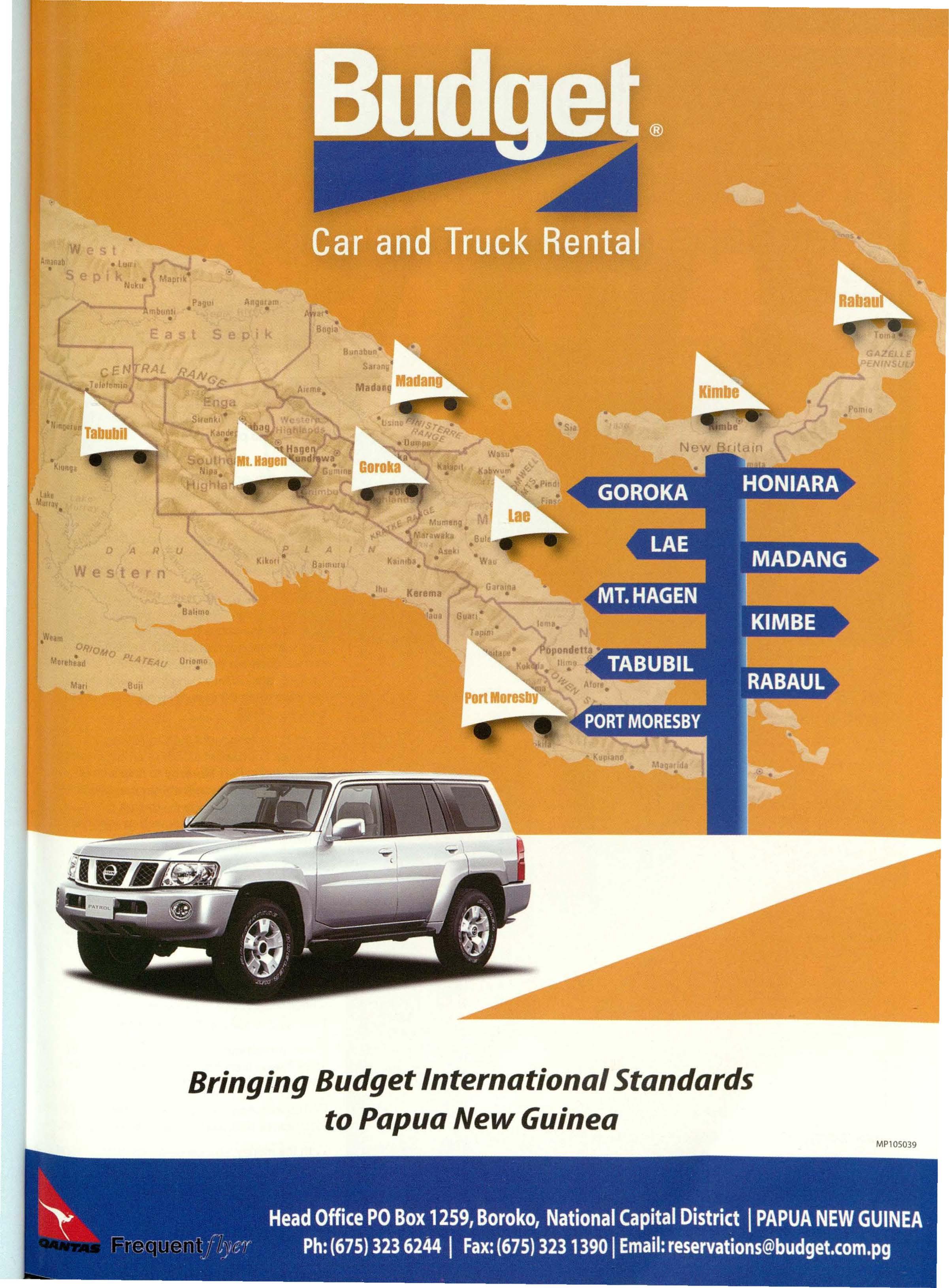
Bringing Budget International Standards to Papua New Guinea
BY OSEAH PHILEMON

anet Sape is a towering woman with a voice that commands respect from all around her.
She is a woman of immense determination, determined to change the lives of Papua New Guinean women; bringing them from poverty to prosperity.
She wants to turn simple Papua New Guinean women with empty wallets to make them become employers of hundreds of other women and youth in her country.
"My vision is for women in Papua New Guinea to gain economic independence. My dream is to create a microbank for women of PNG."
The mother of six and former banker and businesswoman, Sape wants the women of PNG to rise above their present status of haplessness. Not that all PNG women are in this situation but the greatest majority of them certainly are - mainly living in the rural areas - while an increasing number are in the urban centres of PNG.
Janet is the founder of the City Mothers Business Foundation (CMBF) - an organisation she started in Port Moresby to help women get into businesses so that they can become economically independent - to earn their own money to support themselves and their families.
Accessing finance is the worst nightmare for most women all over the world and PNG is no exception. That is why Janet wants to set up a microbank for the women so that they can have access to funds to set up their small businesses.
She is working hard at it and says with confidence that the day will come soon when women throughout PNG can have the money they need to start up their businesses.
Janet worked with the banking business until 1996. It was then that she decided to go into business to support her family.
She approached the Rural Development Bank for a loan of K20,000 and was granted the loan.
With the money, she set up a mini-mart, a food bar and a security company with 80 security guards.
She continued working for the bank and running her own businesses after hours.
voice j her.
1tion, Ja um nean
Jinea 1m is of l in them ,as ·ban ;ation ,me 1eir for is set ~y ,mall •hen ,ney .mtil into ank loan. food rity
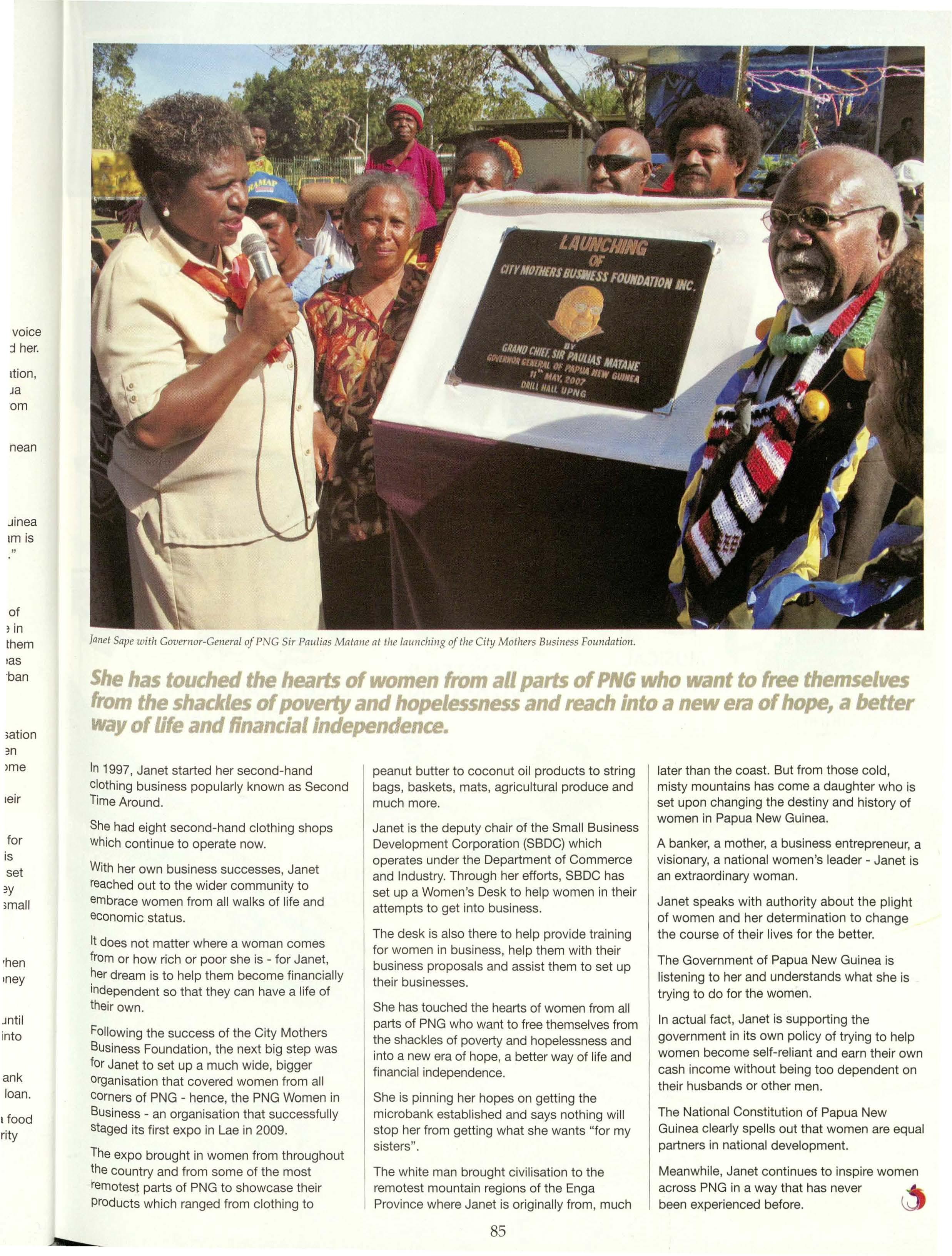
JanetSape
with Governor-Genera/of PNG Sir Paulias Matane at the launching oftlie City Mothers Business Foundation.
Shehastouchedthe heartsof womenfromall partsof PNGwhowantto free themselves fromthe shacklesof povertyand hopelessnessand reachintoa new era of hope,a better wayof life and financialindependence.
In 1997, Janet started her second-hand clothing business popularly known as Second Time Around.
She had eight second-hand clothing shops Whichcontinue to operate now.
With her own business successes, Janet reached out to the wider community to embrace women from all walks of life and economic status.
It does not matter where a woman comes from or how rich or poor she is - for Janet, her dream is to help them become financially independent so that they can have a life of their own.
Following the success of the City Mothers Business Foundation, the next big step was for Janet to set up a much wide, bigger organisation that covered women from all corners of PNG - hence, the PNG Women in Business - an organisation that successfully staged its first expo in Lae in 2009.
The expo brought in women from throughout the country and from some of the most remotest parts of PNG to showcase their Products which ranged from clothing to
peanut butter to coconut oil products to string bags, baskets, mats, agricultural produce and much more.
Janet is the deputy chair of the Small Business Development Corporation (SBDC) which operates under the Department of Commerce and Industry. Through her efforts, SBDC has set up a Women's Desk to help women in their attempts to get into business.
The desk is also there to help provide training for women in business, help them with their business proposals and assist them to set up their businesses.
She has touched the hearts of women from all parts of PNG who want to free themselves from the shackles of poverty and hopelessness and into a new era of hope, a better way of life and financial independence.
She is pinning her hopes on getting the microbank established and says nothing will stop her from getting what she wants "for my sisters".
The white man brought civilisation to the remotest mountain regions of the Enga Province where Janet is originally from, much
later than the coast. But from those cold, misty mountains has come a daughter who is set upon changing the destiny and history of women in Papua New Guinea.
A banker, a mother, a business entrepreneur, a visionary, a national women's leader - Janet is an extraordinary woman.
Janet speaks with authority about the plight of women and her determination to change the course of their lives for the better.
The Government of Papua New Guinea is listening to her and understands what she is trying to do for the women.
In actual fact, Janet is supporting the government in its own policy of trying to help women become self-reliant and earn their own cash income without being too dependent on their husbands or other men.
The National Constitution of Papua New Guinea clearly spells out that women are equal partners in national development.
Meanwhile, Janet continues to inspire women across PNG in a way that has never been experienced before.
COMMUNICATION EQUIPMENT
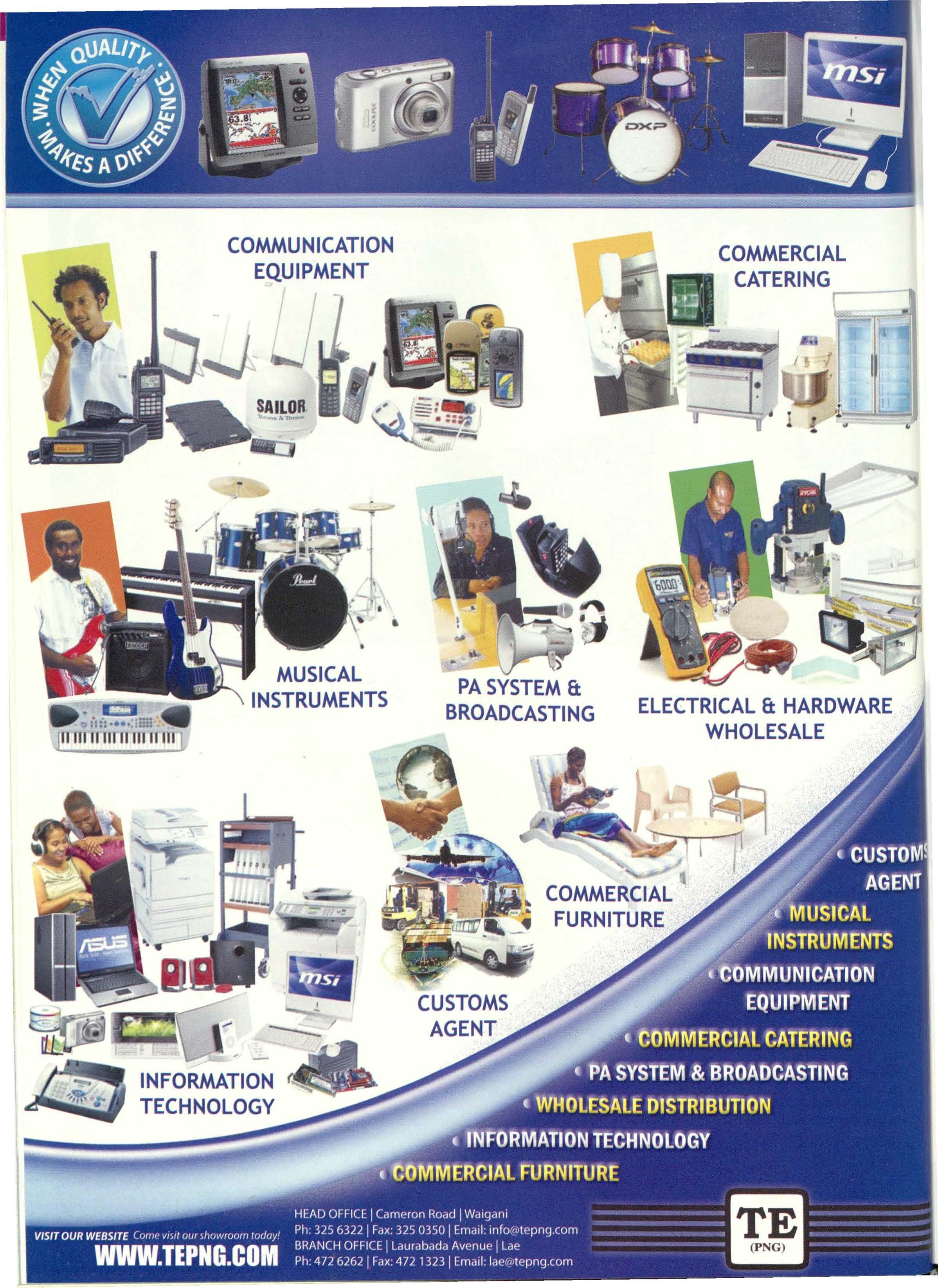
MUSICAL INSTRUMENTS
INFORMATION" TECHNOLOGY
COMMERCIAL CATERING
PASYSTEMEt BROADCASTING
ELECTRICALEtHARDWARE WHOLESALE
PacificMMIInsuranceis a nationalinsurancecompanyoperatingthroughoutPapuaNewGuineaandthe Pacificregion. Weprovidea rangeof personal,commercialandcorporateinsuranceproductsthroughselectedinsurancebrokers,businesspartners,anddirectto thepublic.
Ouruniquecombinationof sizeandexpertiseallowsusto provideyouwithpeaceof mind,personalservice,secureinsuranceproducts, competitiveoptions,andlocalPapuaNewGuineanexpertise.
Wearecommittedto excellencein ourdailybusiness.Ourcontinuedgrowthandsuccessconfirmsour philosophyof a positiveand commerciallysensitiveapproachto yourneeds. If wecanassistyoufurther,pleasecontact:
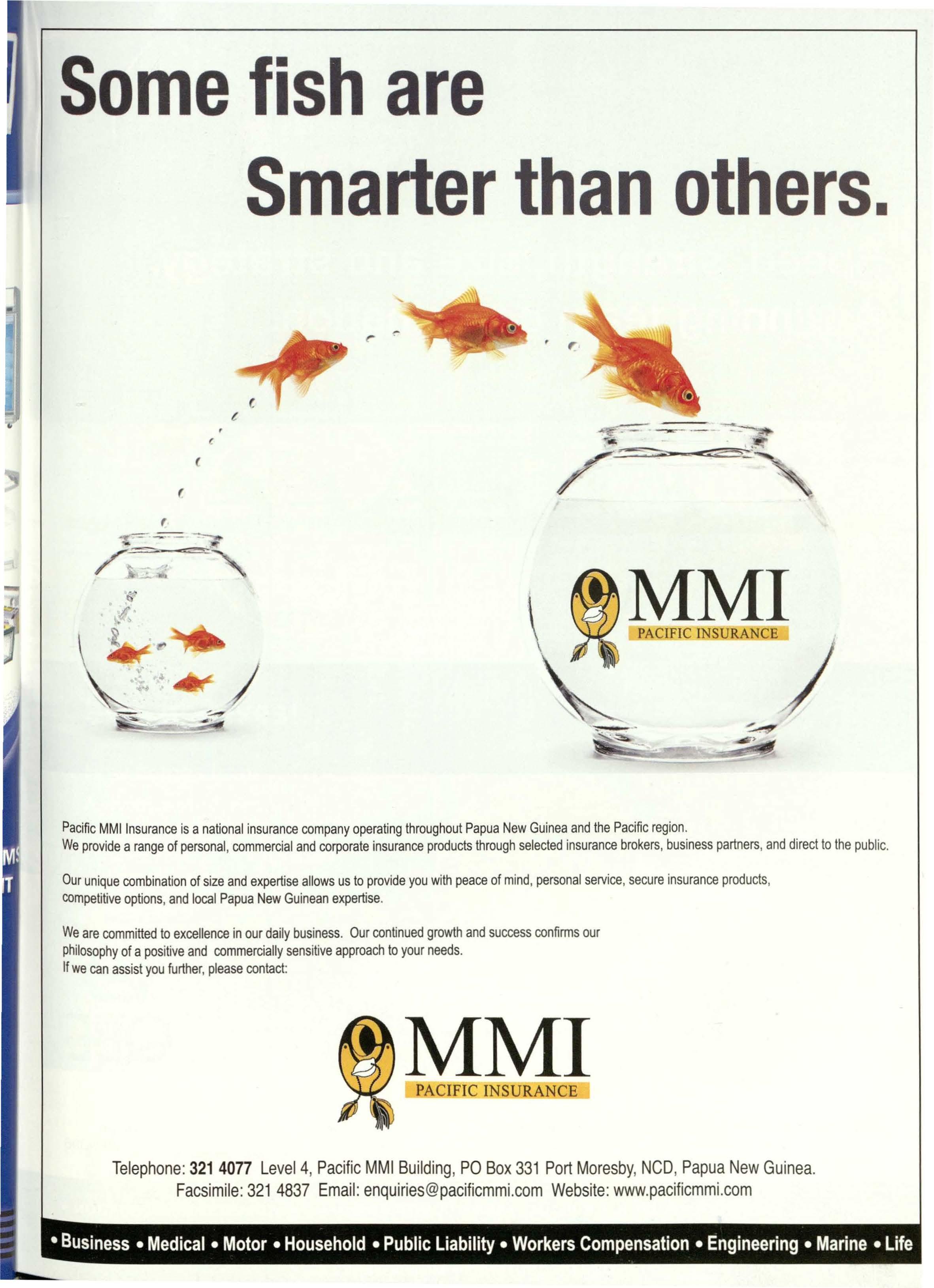
Telephone:3214077 Level4, PacificMMIBuilding,POBox331PortMoresby,NCO,PapuaNewGuinea. Facsimile:3214837 Email:enquiries@pacificmmi.comWebsite:www.pacificmmi.com
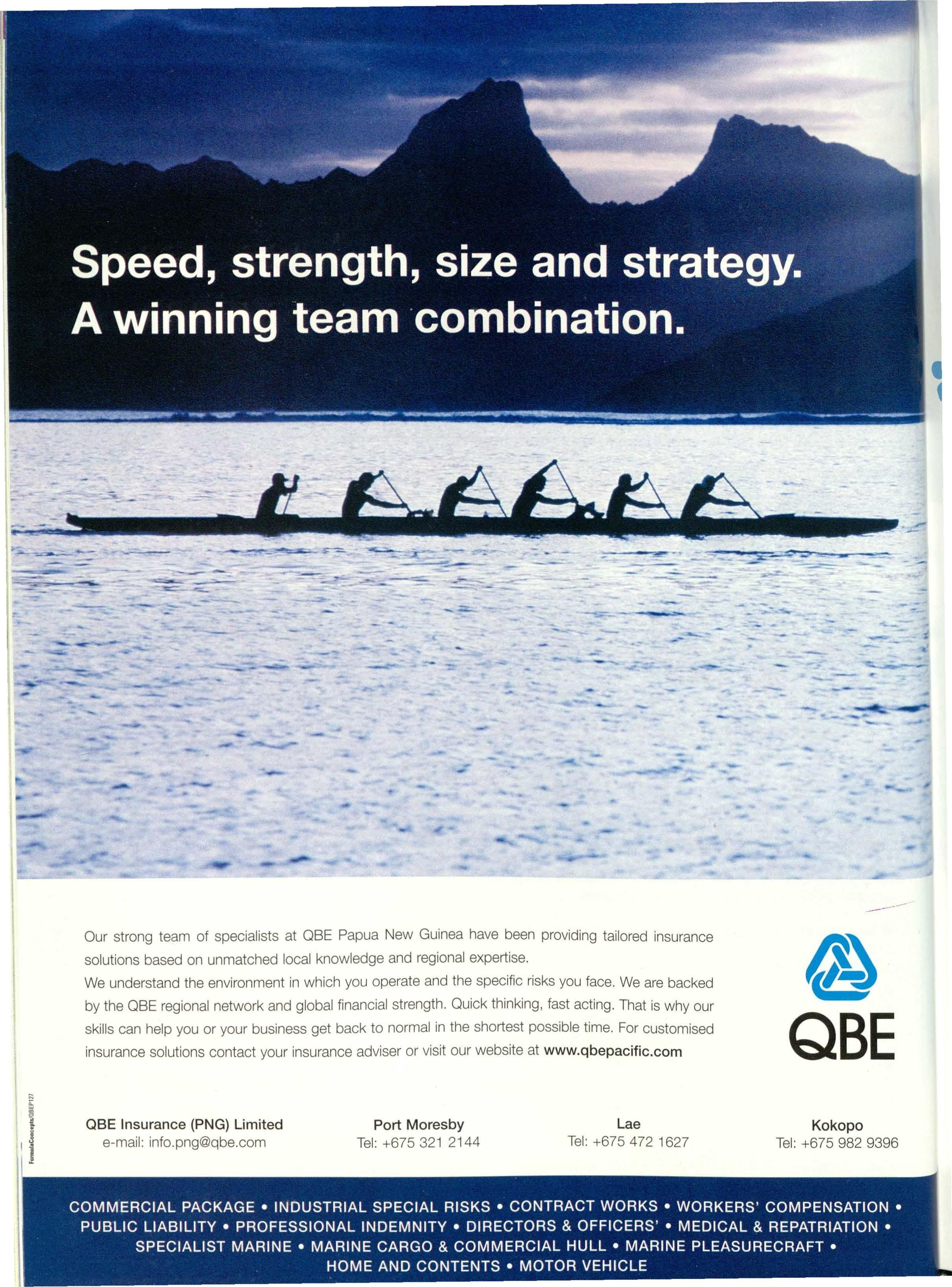
Our strong team of specialists at QBE Papua New Guinea have been providing tailored insurance solutions based on unmatched local knowledge and regional expertise. We understand the environment in which you operate and the specific risks you face. We are backed by the QBE regional network and global financial strength. Quick thinking, fast acting. That is why our skills can help you or your business get back to normal in the shortest possible time. For customised insurance solutions contact your insurance adviser or visit our website at www.qbepacific.com

BY DIANA MCMANUS
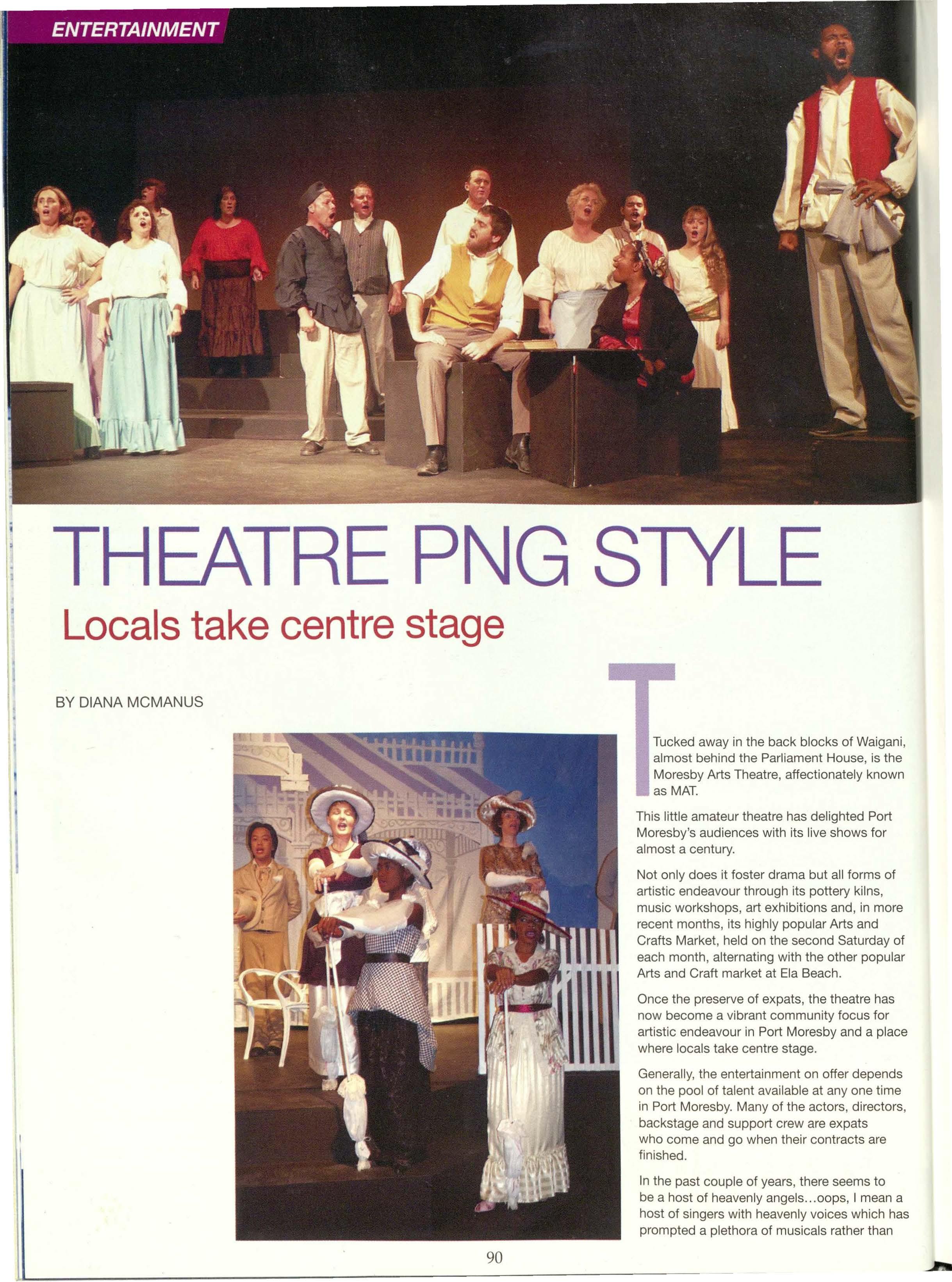
Tucked away in the back blocks of Waigani, almost behind the Parliament House, is the Moresby Arts Theatre, affectionately known as MAT.
This little amateur theatre has delighted Port Moresby's audiences with its live shows for almost a century.
Not only does it foster drama but all forms of artistic endeavour through its pottery kilns, music workshops, art exhibitions and, in more recent months, its highly popular Arts and Crafts Market, held on the second Saturday of each month, alternating with the other popular Arts and Craft market at Ela Beach.
Once the preserve of expats, the theatre has now become a vibrant community focus for artistic endeavour in Port Moresby and a place where locals take centre stage.
Generally, the entertainment on offer depends on the pool of talent available at any one time in Port Moresby. Many of the actors, directors, backstage and support crew are expats who come and go when their contracts are finished.
In the past couple of years, there seems to be a host of heavenly angels oops, I mean a host of singers with heavenly voices which has prompted a plethora of musicals rather than
straight drama.
This year alone has already seen the bizarre musical The Rocky Horror Show with Queen's We Will Rock Youin the making. Rocky Horror Show has probably beenthe most successful production yet in terms of the number of Papua New Guineans involved. Last year, we were treated to An Evening With Andrew Lloyd Weber, My Fair Lady and Wicked. Other recent great musicals were Mamma Mia and Les Miserables. Many of these musicals have seen major input from inimitable local identity Jenny Ramamurthy.
The theatre was founded in 1914 and first operated in Douglas St in town, at the former Library Institute

The current theatre opened in 1974 with The Threepenny Opera. The custom-built theatre seats about 156 people and the company usually stages two or three
major productions annually, as well as a few smaller productions and school musicals. It has played host to a number of stylish school musicals including West Side Story, Friday Knight Fever, When the West Was Warped, High School Musical, Joseph and his Technicolored Dreamcoat,
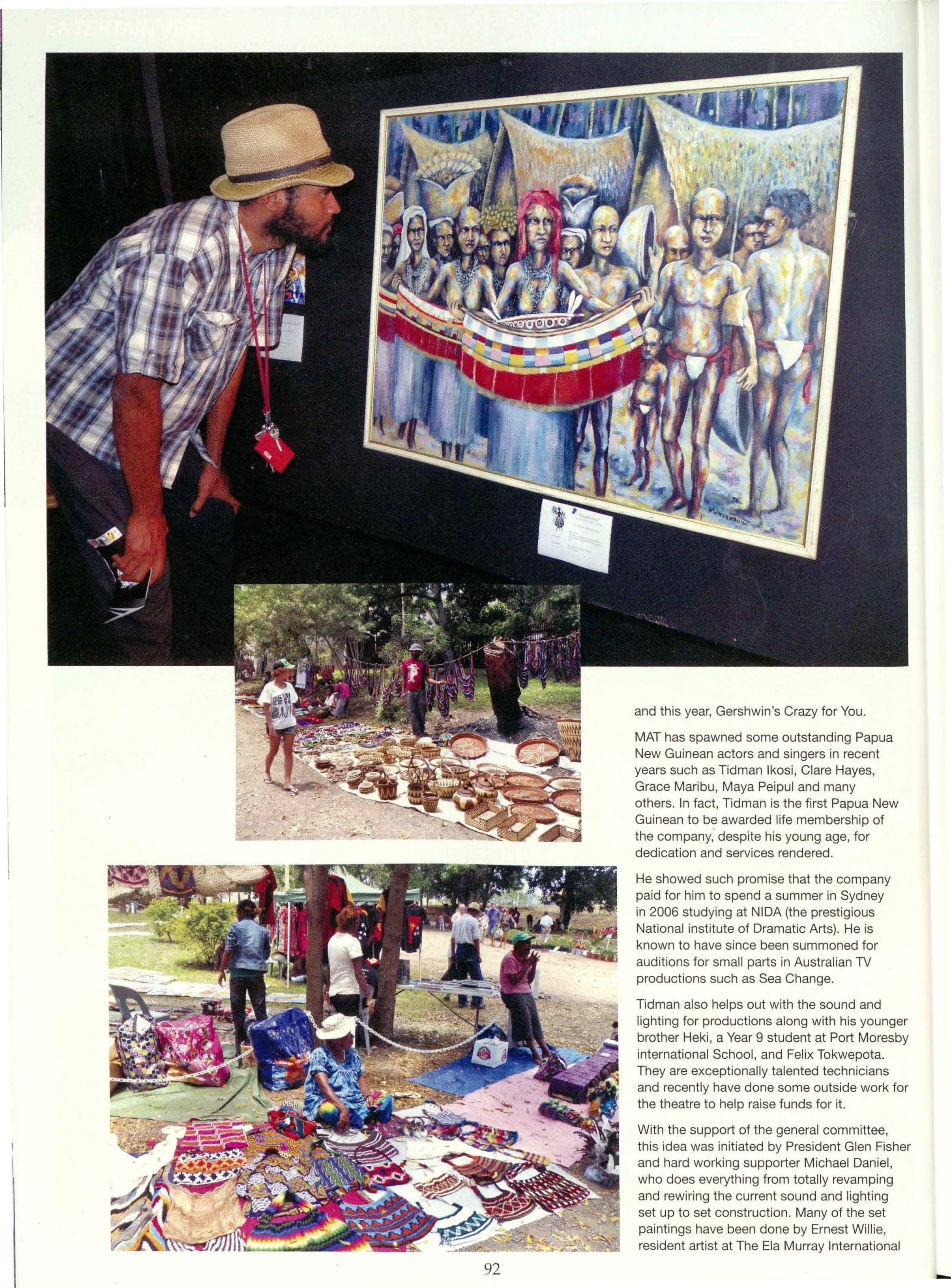
and this year, Gershwin's Crazy for You.
MAT has spawned some outstanding Papua New Guinean actors and singers in recent years such as Tidman lkosi, Clare Hayes, Grace Maribu, Maya Peipul and many others. In fact, Tidman is the first Papua New Guinean to be awarded life membership of the company, despite his young age, for dedication and services rendered.
He showed such promise that the company paid for him to spend a summer in Sydney in 2006 studying at NIDA (the prestigious National institute of Dramatic Arts). He is known to have since been summoned for auditions for small parts in Australian TV productions such as Sea Change.
Tidman also helps out with the sound and lighting for productions along with his younger brother Heki, a Year 9 student at Port Moresby international School, and Felix Tokwepota. They are exceptionally talented technicians and recently have done some outside work for the theatre to help raise funds for it.
With the support of the general committee, this idea was initiated by President Glen Fisher and hard working supporter Michael Daniel, who does everything from totally revamping and rewiring the current sound and lighting set up to set construction. Many of the set paintings have been done by Ernest Willie, resident artist at The Ela Murray International
School (TEMIS).
Eventhough there have been some terrific productions of straight drama such as Agamemnon, The Importance of Being Earnest, Inspector Hound and some collections of Brecht and Chekhov plays, the theatre is not restricted to staging western drama. It is also a forum for presenting some wonderful plays written by Papua New Guineans.
A couple of years ago, we saw a great production of Black Angels from Heaven, based on World War 2 experiences and friendships written by Steven Kelly Pagasa, winner of the 2005 National Cultural Commission's Literature Prize for Playscripts.
Thiswas followed by a credible performance by University Drama students of Russell Soaba's Scattered by the Wind, a tale of family tragedy brought about by cultural misunderstandings and conflict.
This year, we are being treated to more cultural dilemmas through Nora VagiBrash's drama 'City Spirit', a tale of alienation from and reconciliation with culture, in which audiences will be delighted to enjoy Tidman lkosi performing again. Audiences are no longer exclusively expat because live
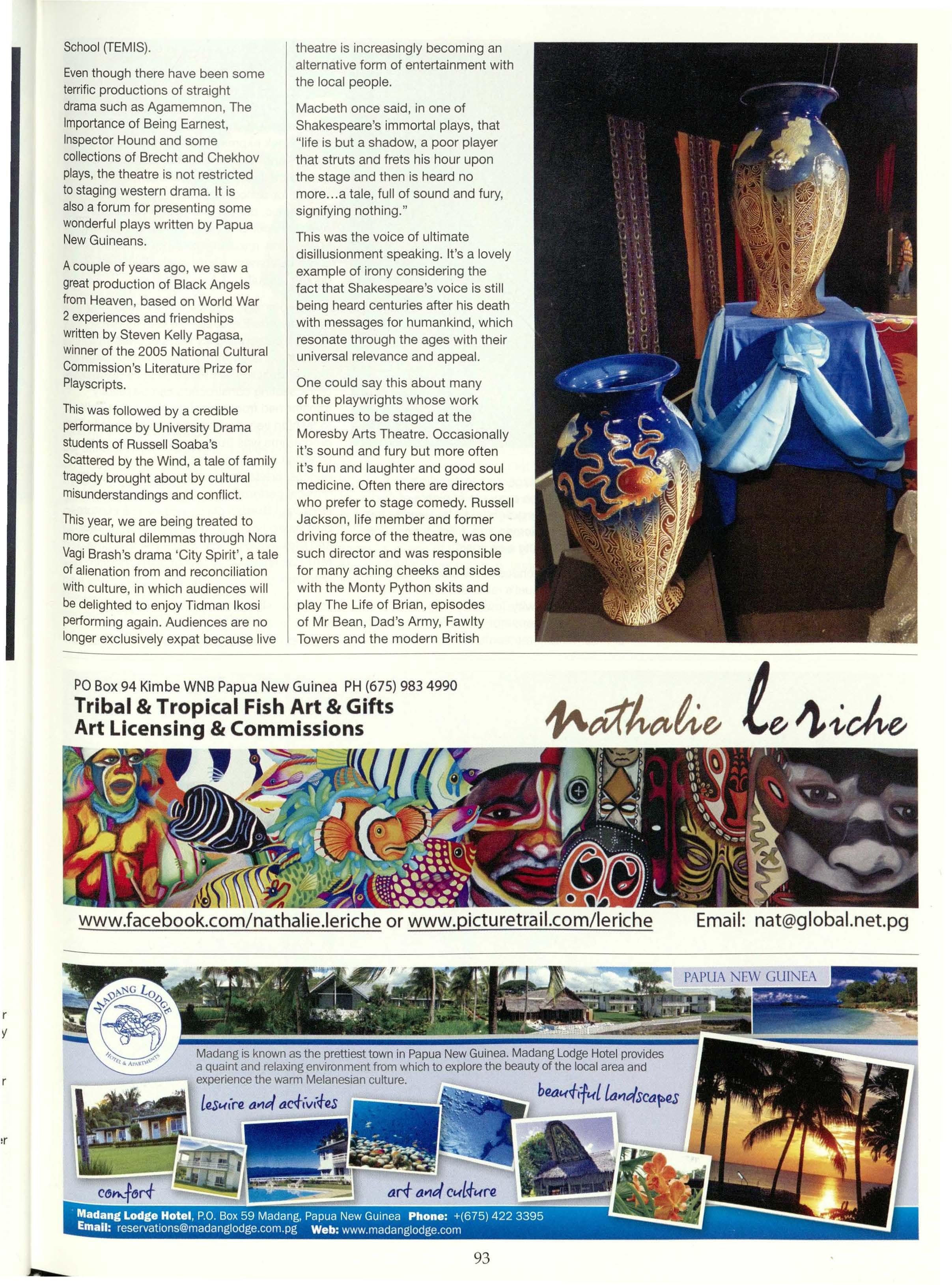
theatre is increasingly becoming an alternative form of entertainment with the local people.
Macbeth once said, in one of Shakespeare's immortal plays, that "life is but a shadow, a poor player that struts and frets his hour upon the stage and then is heard no more a tale, full of sound and fury, signifying nothing."
This was the voice of ultimate disillusionment speaking. It's a lovely example of irony considering the fact that Shakespeare's voice is still being heard centuries after his death with messages for humankind, which resonate through the ages with their universal relevance and appeal.
One could say this about many of the playwrights whose work continues to be staged at the Moresby Arts Theatre. Occasionally it's sound and fury but more often it's fun and laughter and good soul medicine. Often there are directors who prefer to stage comedy. Russell Jackson, life member and former driving force of the theatre, was one such director and was responsible for many aching cheeks and sides with the Monty Python skits and play The Life of Brian, episodes of Mr Bean, Dad's Army, Fawlty Towers and the modern British
show Absolutely Fabulous. And who could forget Anthony Cramer's production of Shakespeare's comedy A Midsummer Night's Dream? The bard himself would have been impressed.
Sometimes the company 'goes outreach'. It has been well supported in the past by Jepello's and Lamana which have made their premises available on occasions to entertain the public with Theatre Restaurant.
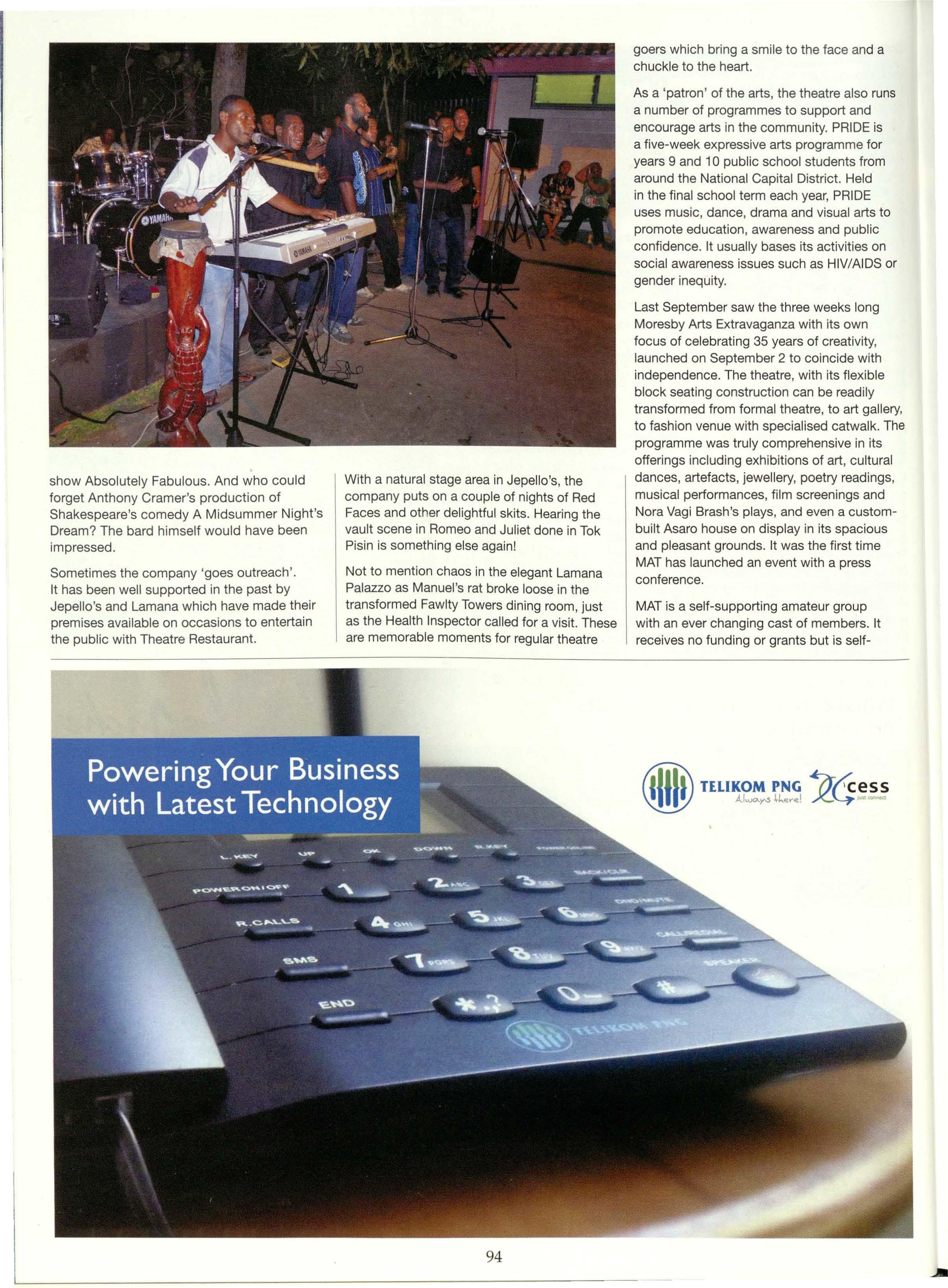
With a natural stage area in Jepello's, the company puts on a couple of nights of Red Faces and other delightful skits. Hearing the vault scene in Romeo and Juliet done in Tok Pisin is something else again!
Not to mention chaos in the elegant Lamana Palazzo as Manuel's rat broke loose in the transformed Fawlty Towers dining room, just as the Health Inspector called for a visit. These are memorable moments for regular theatre
goers which bring a smile to the face and a chuckle to the heart.
As a 'patron' of the arts, the theatre also runs a number of programmes to support and encourage arts in the community. PRIDE is a five-week expressive arts programme for years 9 and 1O public school students from around the National Capital District. Held in the final school term each year, PRIDE uses music, dance, drama and visual arts to promote education, awareness and public confidence. It usually bases its activities on social awareness issues such as HIV/AIDS or gender inequity.
Last September saw the three weeks long Moresby Arts Extravaganza with its own focus of celebrating 35 years of creativity, launched on September 2 to coincide with independence. The theatre, with its flexible block seating construction can be readily transformed from formal theatre, to art gallery, to fashion venue with specialised catwalk. The programme was truly comprehensive in its offerings including exhibitions of art, cultural dances, artefacts, jewellery, poetry readings, musical performances, film screenings and Nora Vagi Brash's plays, and even a custombuilt Asaro house on display in its spacious and pleasant grounds. It was the first time MAT has launched an event with a press conference.
MAT is a self-supporting amateur group with an ever changing cast of members. It receives no funding or grants but is self-
funding through its annual subscriptions, bar sales and premises hire. It relies heavily on the generous support in cash or kind by regular sponsors such as Brian Bell for generator loans and projector, Taubmans Paints, Keynotes with sound equipment and technical advice, TE for musical equipment, Datec for the office Computer, RandP Signs and PNG Gardener. It welcomes major new sponsors such as the CPL Group, SP Brewery and PNG Ports who significantly sponsored the Arts Extravaganza this year. The theatre is proud to be sponsored by
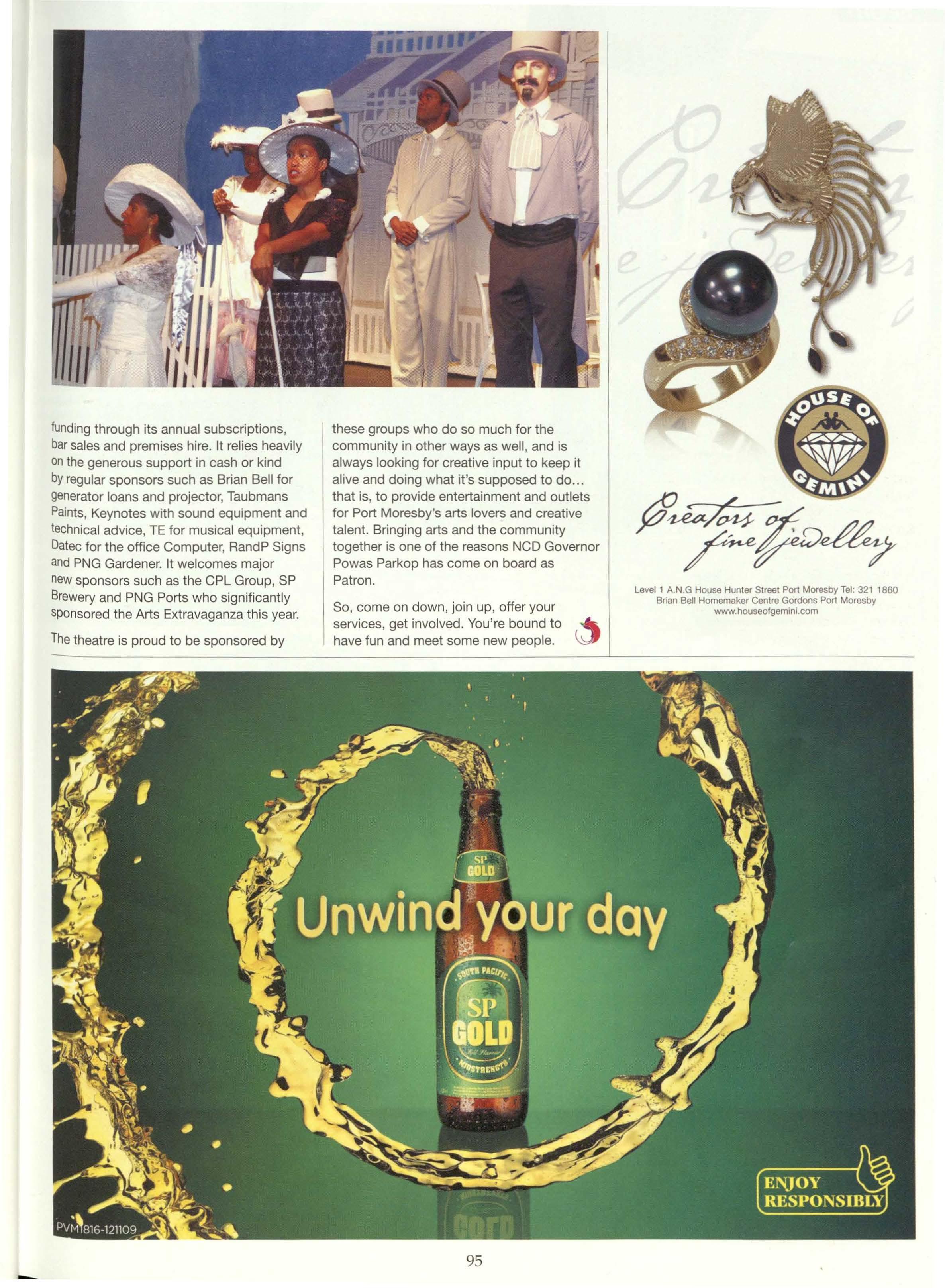
these groups who do so much for the community in other ways as well, and is always looking for creative input to keep it alive and doing what it's supposed to do that is, to provide entertainment and outlets for Port Moresby's arts lovers and creative talent. Bringing arts and the community together is one of the reasons NCO Governor Powas Parkop has come on board as Patron.
So, come on down, join up, offer your services, get involved. You're bound to ...._ have fun and meet some new people.
BY ROWAN MCKINNON
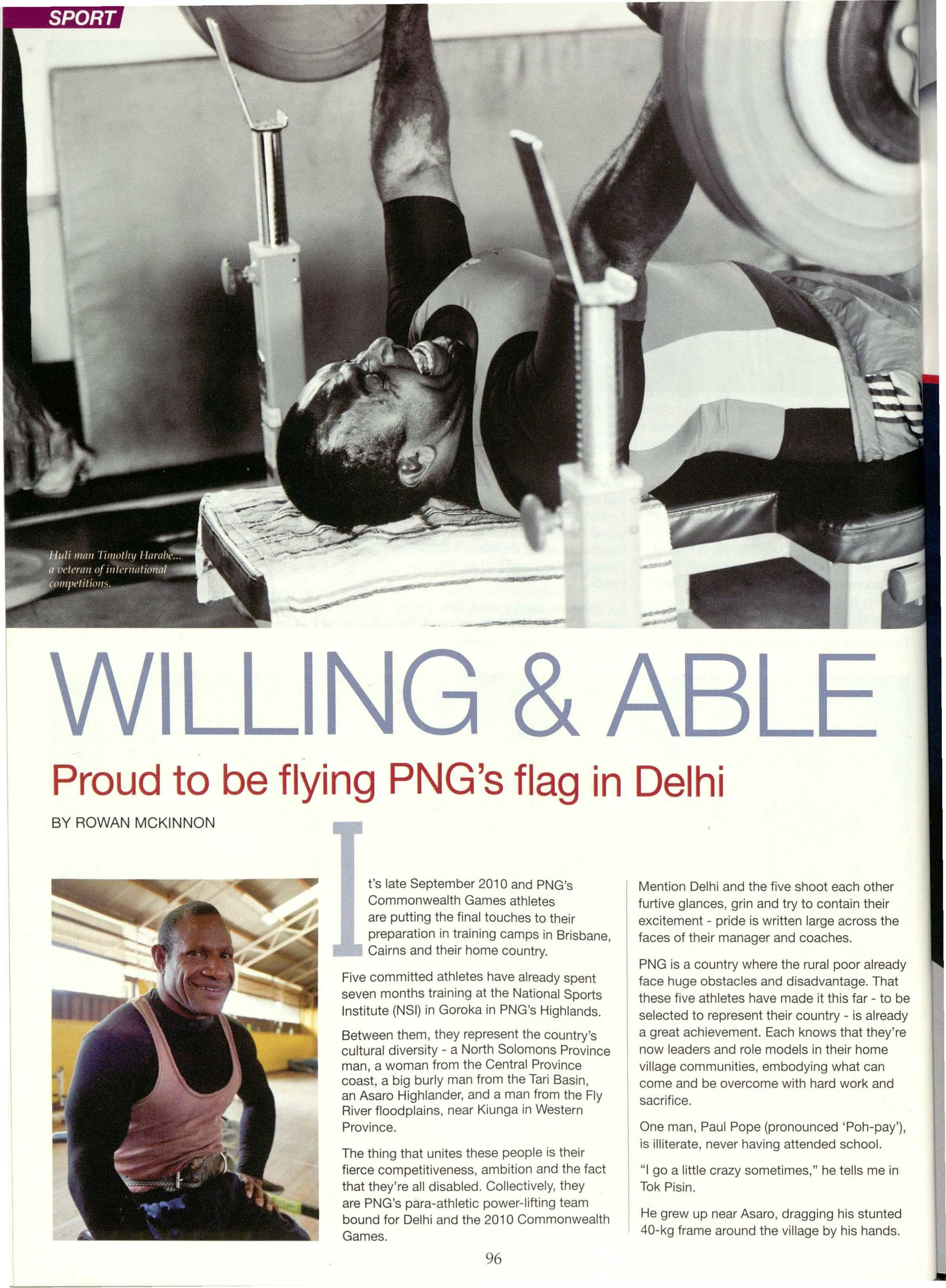
t's late September 2010 and PNG's Commonwealth Games athletes are putting the final touches to their preparation in training camps in Brisbane, Cairns and their home country.
Five committed athletes have already spent seven months training at the National Sports Institute (NSI) in Goroka in PNG's Highlands.
Between them, they represent the country's cultural diversity - a North Solomons Province man, a woman from the Central Province coast, a big burly man from the Tari Basin, an Asaro Highlander, and a man from the Fly River floodplains, near Kiunga in Western Province.
The thing that unites these people is their fierce competitiveness, ambition and the fact that they're all disabled. Collectively, they are PNG's para-athletic power-lifting team bound for Delhi and the 2010 Commonwealth Games.
Mention Delhi and the five shoot each other furtive glances, grin and try to contain their excitement - pride is written large across the faces of their manager and coaches.
PNG is a country where the rural poor already face huge obstacles and disadvantage. That these five athletes have made it this far - to be selected to represent their country - is already a great achievement. Each knows that they're now leaders and role models in their home village communities, embodying what can come and be overcome with hard work and sacrifice.
One man, Paul Pope (pronounced 'Poh-pay'), is illiterate, never having attended school.
"I go a little crazy sometimes," he tells me in Tok Pisin.
He grew up near Asaro, dragging his stunted 40-kg frame around the village by his hands.

Reginawill make historyas being the only womanto ever representPNGin an internationalpowerliftingevent. She clucksand smilesand actslike she'sembarrassedabout this fad.

In the Men's Powerlifting Bench Press Open at the Delhi Commonwealth Games Timothy Harabe placed 14th, Ziggy Satkurin 19th and Paul Pope 20th. In the Women's Open Regina Wala placed 12th.
Regina Wala a newbie to the sport.
Paul, like the others, had never used a wheelchair until he came to the NSI training camp.
Delhi would be his first overseas trip. His lower body is so atrophied that he is strapped to the bench for powerlifting to give him purchase. He bench-presses an astonishing 121kg.
"Is he crazy?" I ask Regina Wala who sits with us.
"Yes," she says, and they both laugh.
Regina will make history in Delhi, being the only woman to ever represent PNG in an international power-lifting event.
She clucks and smiles and acts like she's embarrassed about this fact. Regina's a newbie at this game, but she's rapidly increasing her PB (personal best) as she trains.
Lyons Lopez from Bougainville is another newcomer to power-lifting. Like Regina, he's not paraplegic but gets around with the aid of crutches. He beams when we mention Delhi, but get him to talk? Fat chance.
All the members of this team are shy, reluctant to talk about themselves having lived their lives in the margins of PNG's grass-roots society. They're not used to being the centre of attention and whatever realm of celebrity they belong to now sits uneasily with them. Much of the spruiking of the athletes' prowess is done by team manager and ebullient
motivator, Jeffrie Robby.
Huli man Timothy Harabe is the big boy of the group, with a powerful torso and a naughty grin. He's a veteran of international competitions, having competed in Malaysia and at the 2009 Arafura Games in Darwin. He sneaks into the 75-kg division but his bench-press PB is 162.5kg - well in excess of twice his body weight and way over the 150kg qualifying lift for the London 2012 ParaOlympic Games.
Ziggy Satkurin, in the 52-kg division, is another fella lifting well above the London 2012 qualifying mark. While the lifters egg each other on and flex their biceps for the camera, Ziggy seems more subdued.
Head coach Clive Romulas and assistant Freddy Arinaso believe strongly in sports to develop the whole person - intellectually, physically and spiritually. Prayer is a big part of the training programme and the group convenes in an NSI haus win morning and night to commune with the heavens. Each training session begins and ends with a prayer.
Clive tells me that the PNG government has committed to fielding a team of para-athletes to all international and domestic sporting events. This is a huge boost to the PNG paraathletic programme.
The last time the power-lifters competed together was at the PNG Games in November 2009, and after Delhi, they will look forward to the Darwin's Arafura Games in 2011.
Fridays are 'English days' - Clive and Jeffrie speak to their charges in English only and all conversation must be carried out in English.
"How can Paul Pope get a girl in Delhi if he only speaks pidgin?" Jeffrie asks rhetorically. The group falls about in laughter. "English is the international language and it's important that the team can speak it and understand it," he says.
By first-world standards, the NSI gym facilities are hopelessly out of date. There are some wonky leather medicine balls wrapped in gaffa tape, a dusty Trojan-era vaulting horse.
The weight-lifting gear is better but hardly state-of-the-art. There are no fans in the gym, no ramps at the entrance for the wheelchairs. But the team doesn't even seem to notice. Instead, they're focused and motivated, aware of the opportunity that is before them and keen to realise their full potential.
Amputee sprinter Stanley Luana makes up the sixth member of the PNG contingent. Space-age prosthetics for amputee sportspeople is highly advanced in some countries, not so in PNG. Stanley has one arm and two legs and a steely determination in his eye.
The day ends with a prayer. The athletes, coaches and manager reverently bow their heads and thank the Lord for their good fortune, for his infinite mercy, for all the earth's bounty. I am moved by the cruel irony of this devotion and praise.
P.O.Box 456, Lae. Morobe Province. P.O.Box 1405, Boroko. NCD.
Papua New Guinea
Phone:(675) 472 1111

PapuaNew Guinea
Phone:(675) 325 4700 £ETDKUI
Fax: (675) 472 1335
Email:sklae@seetokui.com.pg
Fax: (675) 325 4474
Email: skpom@seetokui.com.pg SOLE DISTRIBUTORS:
Agency Distributors and Grocery Wholesalers established in Papua New Guinea for over 60 years. Please contact our friendly staff for all your enquries.
Phone: (675) 472 4177
Fax: (675) 472 3629
Box 954, Lae.Aircorps Rd. Papua New Guinea
mpslae@seetokui.com.pg
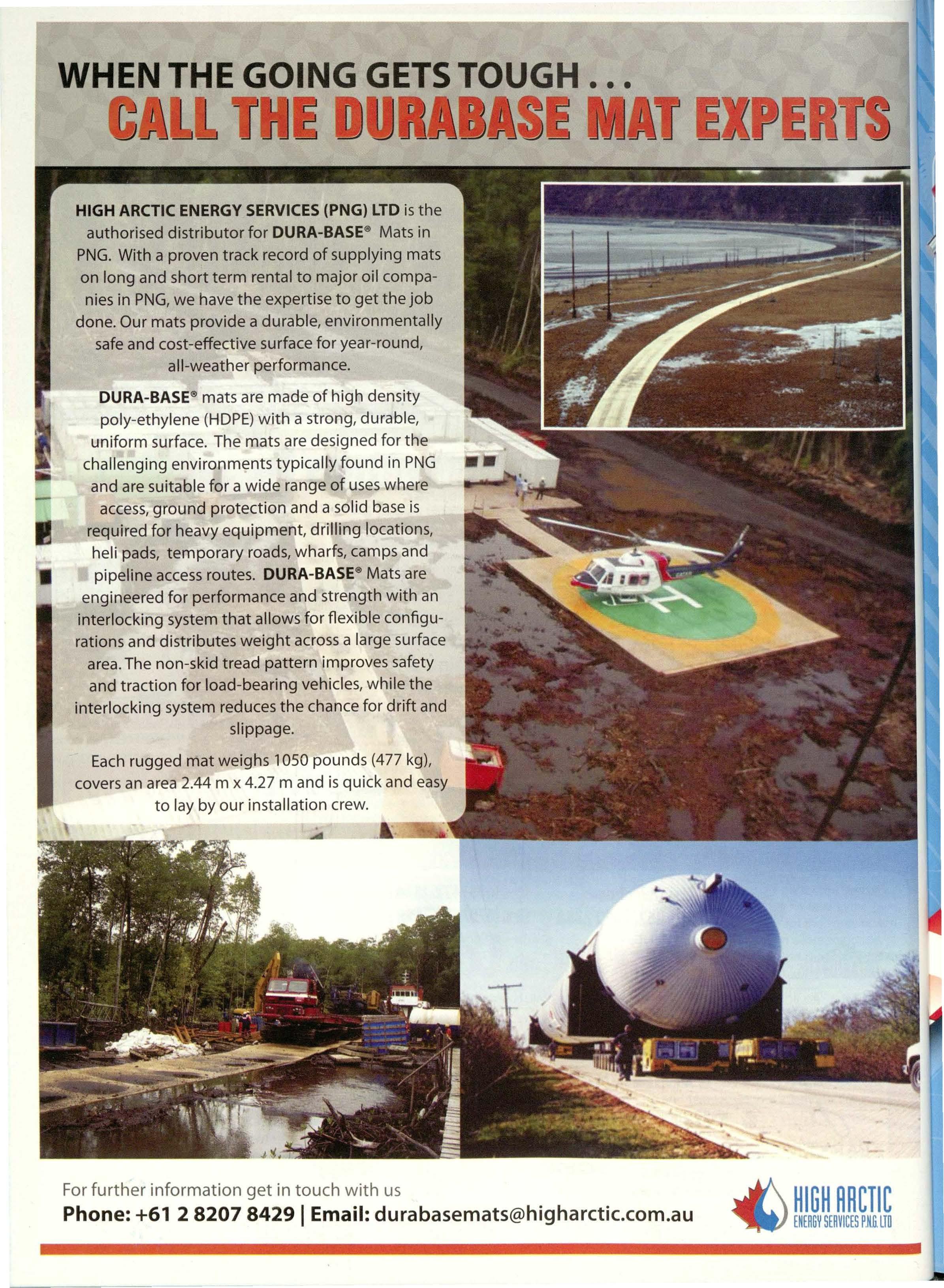
HIGH ARCTICENERGYSERVICES(PNG) LTD is the authorised distributor for DURA-BASE®Mats in PNG. With a proven track record of supplying mats on long and short term rental to major oil companies in PNG,we have the expertise to get the job done. Our mats provide a durable, environmentally safe and cost-effective surface for year-round, all-weather performance.
DURA-BASE®mats are made of high density poly-ethylene (HDPE)with a strong, durable, uniform surface. The mats are designed for the challenging environments typically found in PNG and are suitable for a wide range of uses where access,ground protection and a solid base is required for heavy equipment, drilling locations, heli pads, temporary roads, wharfs, camps and pipeline access routes. DURA-BASE®Mats are engineered for performance and strength with an interlocking system that allows for flexible configurations and distributes weight across a large surface area. The non-skid tread pattern improves safety and traction for load-bearing vehicles, while the interlocking system reduces the chance for drift and slippage.
Each rugged mat weighs 1050 pounds (477 kg), covers an area 2.44 m x 4.27 m and is quick and easy to lay by our installation crew.

Tasting, diving and cycling her way through sensational Sydney, MARIE BARBIERIselects the best amongst an endless choice of thrilling activities.
Like the waters of San Francisco and Rio de Janeiro, Sydney Harbour never sleeps. The city and surrounds are a sprawling forest of glass, steel and national park, offering a plethora of activities for you to become enchanted with.
Cruise Sydney Harbour
Sydney is a harbour like no other. Inside its narrow heads lie more than 250 kilometres of bays, coves, beaches and promontories just waiting to be explored. On its foreshores you will discover world famous landmarks, historical and contemporary jewels of art and architecture, and waterside precincts that wrap up the outdoor, easy-going life of this vibrant city. Natural beauty remains everywhere: in broad and tiny beaches, in wide and narrow bays, on high green headlands and on the water itself, where pleasure sailors mix with ferries, working boats, cargo vessels and ocean liners in a constant swirl of traffic. A Captain Cook
Cruise is the best way to see Sydney Harbour. It has over 20 Sydney Harbour cruises daily. Cruise in daylight, at sunset or with the city night lights as your romantic backdrop. www.captaincook.com.au
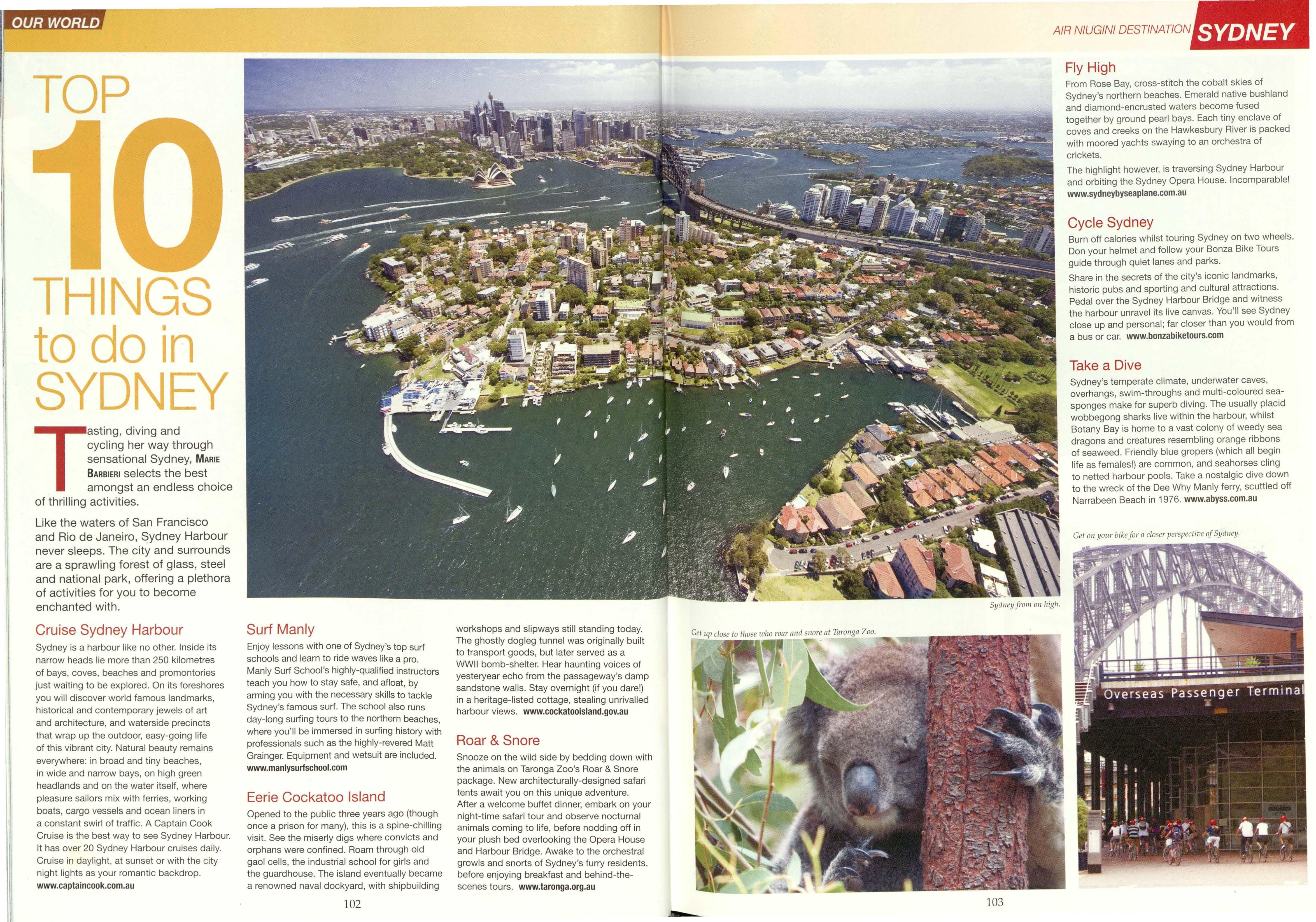
From Rose Bay, cross-stitch the cobalt skies of Sydney's northern beaches. Emerald native bushland and diamond-encrusted waters become fused together by ground pearl bays. Each tiny enclave of coves and creeks on the Hawkesbury River is packed with moored yachts swaying to an orchestra of crickets.
The highlight however, is traversing Sydney Harbour and orbiting the Sydney Opera House. Incomparable! www.sydneybyseaplane.com.au
Burn off calories whilst touring Sydney on two wheels. Don your helmet and follow your Sonza Bike Tours guide through quiet lanes and parks.
Share in the secrets of the city's iconic landmarks, historic pubs and sporting and cultural attractions. Pedal over the Sydney Harbour Bridge and witness the harbour unravel its live canvas. You'll see Sydney close up and personal; far closer than you would from a bus or car. www.bonzabiketours.com
Sydney's temperate climate, underwater caves, overhangs, swim-throughs and multi-coloured seasponges make for superb diving. The usually placid wobbegong sharks live within the harbour, whilst Botany Bay is home to a vast colony of weedy sea dragons and creatures resembling orange ribbons of seaweed. Friendly blue gropers (which all begin life as females!) are common, and seahorses cling to netted harbour pools. Take a nostalgic dive down to the wreck of the Dee Why Manly ferry, scuttled off Narrabeen Beach in 1976. www.abyss.com.au
Get 011your bikefor n closerperspectiveof Syd11ey.
Enjoy lessons with one of Sydney's top surf schools and learn to ride waves like a pro.
Manly Surf School's highly-qualified instructors teach you how to stay safe, and afloat, by arming you with the necessary skills to tackle Sydney's famous surf. The school also runs day-long surfing tours to the northern beaches, where you'll be immersed in surfing history with professionals such as the highly-revered Matt Grainger. Equipment and wetsuit are included. www.manlysurfschool.com
Opened to the public three years ago (though once a prison for many), this is a spine-chilling visit. See the miserly digs where convicts and orphans were confined. Roam through old gaol cells, the industrial school for girls and the guardhouse. The island eventually became a renowned naval dockyard, with shipbuilding
workshops and slipways still standing today. The ghostly dogleg tunnel was originally built to transport goods, but later served as a WWII bomb-shelter. Hear haunting voices of yesteryear echo from the passageway's damp sandstone walls. Stay overnight (if you dare!) in a heritage-listed cottage, stealing unrivalled harbour views. www.cockatooisland.gov.au
Snooze on the wild side by bedding down with the animals on Taronga Zoo's Roar & Snore package. New architecturally-designed safari tents await you on this unique adventure. After a welcome buffet dinner, embark on your night-time safari tour and observe nocturnal animals coming to life, before nodding off in your plush bed overlooking the Opera House and Harbour Bridge. Awake to the orchestral growls and snorts of Sydney's furry residents, before enjoying breakfast and behind-thescenes tours. www.taronga.org.au
QVB for u11iqueretailtherapy.

Old village charm welcomes your approach by ferry to this historic fishing settlement. Seat yourself at the 1885-established Doyles on the Beach, and dine alfresco on a sumptuous seafood platter of blue swimmer crab and fresh oysters. Harbour views are interrupted only by moored millionaire flotillas, before a panorama of Sydney's stylish skyline. For a fraction of the price, sit on the golden sands by upturned boats enjoying a Doyles on the Wharf takeaway of possibly the freshest Barramundi in town. www.doyles.com.au
The palatial 1898-built Queen Victoria Building (QVB), one of the world's most splendid examples of Romanesque architecture, is the pinnacle of shopping in style. Find boutiques from Versace to the QVB Cashmere Collection jewellers such as Swarovski, and rare historic maps at th~ Antique Print Room. Refuel in opulence at The Tea Room (inside the old Grand Ballroom), and raise your little finger to sandwiches, pastries and scones from a three-tiered silver stand. www.qvb.com.au
Doyleson WatsonsBayfor fresh, adventurousseafood.
Best walked in reverse, the 6-km Bondi to Coogee Coastal Walktraverses precipitous sandstone headlands via a cliff-top walk. Pass sandy bays, rock-pools, snorkel sites, Aboriginal carvings and plenty of cafes to recoup in. Visit in early November when the Sculpture by the Sea exhibition is erected between Tamaramaand Bondi, with around 100 sculptures showcased by local and international artists. The trail reaches its climax at Bondi Icebergs Club, where you can swim in their world- ._ famous ocean baths. V
Hoving the strength of the iPi Group of Companies behind our catering division,we offer a diverseclient base specialistand tailor-made solutionsfor all comp catering and foodservice needs.
If quality and proactive involvement in your catering objectives is a must hove, then iPi Catering has the approach and the outcomes for your project.
iPi Catering Limited
P.O. Box 795 Loe, Morabe Province, PNG
Ph: (+675) 475 1400 Fax: (+675) 475 1417
Email: iPiGraup@iPiGraup.cam.pg www.iPiGroup.com.pg
P.O.
n the Yasawa islands of Fiji, you can swim and free dive with one of the biggest, friendliest - and totally harmless - creatures of the sea: the manta ray.
You'll watch the big fish loop and turn upside down, scooping up plankton, gracefully and slowly. It's almost like they are performing their famous manta ray "ballet" for an awestruck audience of snorkellers.
"It's high tide," proclaims Lulu, our Fijian manta guide, just seconds after arriving at Mantaray Island Resort in the Yasawa islands.
He explains that this is the best time to swim with the famous mantas because they are likely to be feeding. "I can take you out now," he suggests, as he drops our bags outside the beach bure.
It's lunch time and most of the new arrivals on the island no doubt value food over a swim. Fearing that I now have to choose between a cheeseburger and a giant ray (both among my favourites in life), Lulu assures me that we WILL get fed after our wildlife encounter.
I grab my mask, snorkel, fins and the big underwater camera, and off we go to have lunch with the mantas.
After a five-minute boat ride from the resort, we arrive at the manta site, just the three of us. Lulu stops and takes a few glances at the surface.
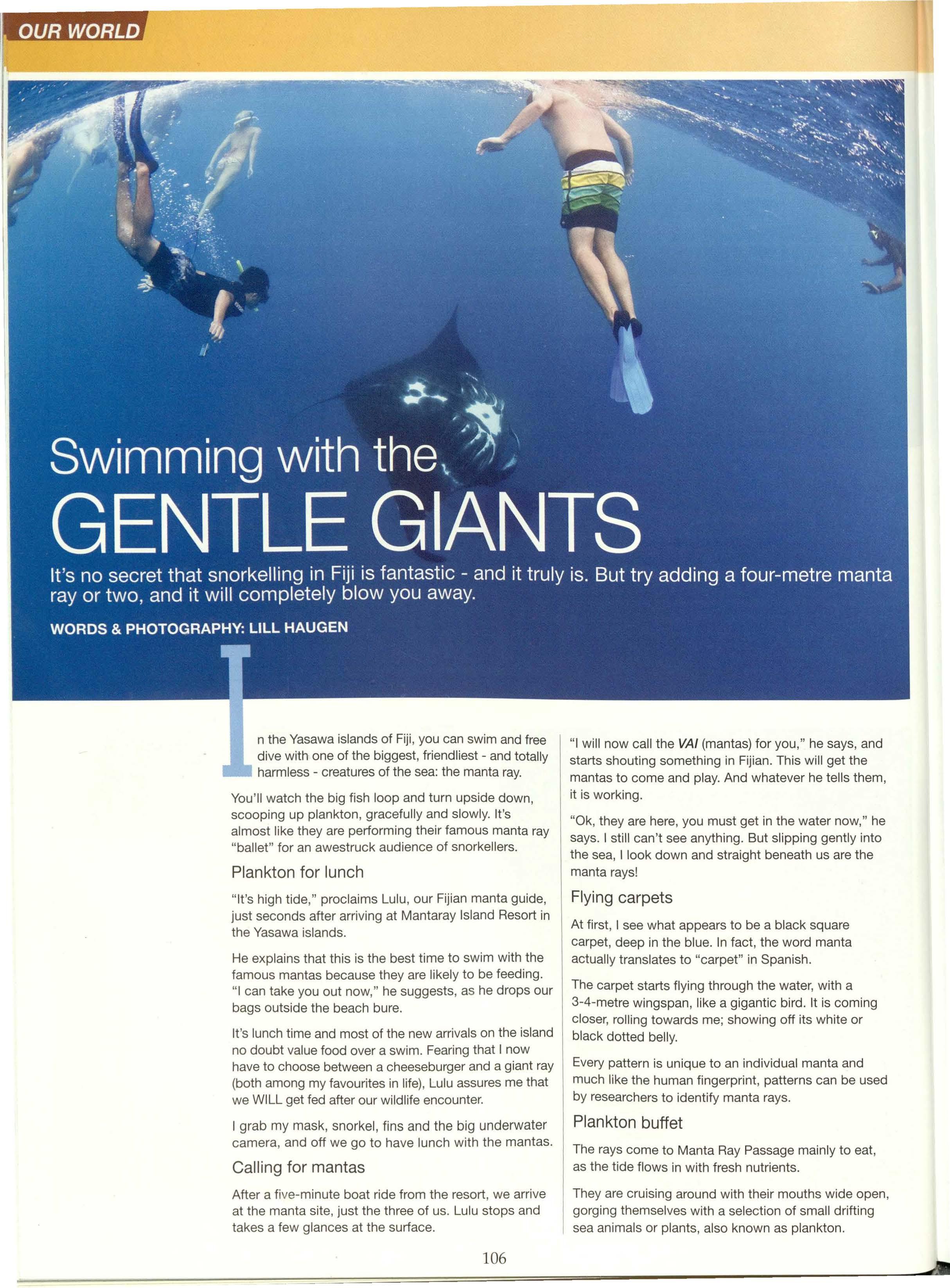
"I will now call the VAi (mantas) for you," he says, and starts shouting something in Fijian. This will get the mantas to come and play. And whatever he tells them, it is working.
"Ok, they are here, you must get in the water now," he says. I still can't see anything. But slipping gently into the sea, I look down and straight beneath us are the manta rays!
At first, I see what appears to be a black square carpet, deep in the blue. In fact, the word manta actually translates to "carpet" in Spanish.
The carpet starts flying through the water, with a 3-4-metre wingspan, like a gigantic bird. It is coming closer, rolling towards me; showing off its white or black dotted belly.
Every pattern is unique to an individual manta and much like the human fingerprint, patterns can be used by researchers to identify manta rays.
Plankton buffet
The rays come to Manta Ray Passage mainly to eat, as the tide flows in with fresh nutrients.
They are cruising around with their mouths wide open, gorging themselves with a selection of small drifting sea animals or plants, also known as plankton.
Becauseof the abundance of plankton, the visibility in the water can be limited. But, these guyscome close enough.
As they feed, they somersault over and over againwith great elegance until they reach the surfaceand come face to face (or more often, bellyto belly) with lucky snorkellers.
Sometimes,their wing-tips even cut through the surface like a shark's fin, providing a heartstopping experience for any swimmer if ever surprised by a friendly ray.
Thefollowing morning, loud drumming interrupts our lazy snooze on the peaceful sandy beach.
We'recompletely relaxed in the cooling shade of swaying coconut palm trees at Mantaray IslandResort. But it's the SIGNAL; it is "manta time"!
Therays have been spotted, and most of the resortguests gather around the activity bure.
A bigger group of swimmers are going out this time. People have come from all over the world - from Italy, Brazil, Australia, Germany, and even Norway.
Some of the visitors did not even know about this hidden treasure until just now, whereas some came specifically to meet the big fish.
All set in the water, we count six mantas feeding, slowly circling toward us in the blue Water.We are just visitors to the sea, peeking into their liquid world.
Theydon't seem to mind the swimmers though; they keep rolling around like big, friendly, submerged dogs. Until one decides to touch one.
He chases after one of the rays, pokes ittwice - and the ray twitches as it swims away. This kind of behaviour is completely forbidden and the reaction is instant.
The whole group, probably 15 people, turns on the mindless guy. "What the hell are you thinking?" says one guy and pokes him straight back, hard. He got the message, and will never touch a manta again.
Order is quickly restored, and no one else is tempted to put their nasty little fingers on the rays.
This is the general rule while visiting the sea; you are welcome to have a look, but NO touching. The wellbeing of the rays is the number one priority.
Fortunately, the mantas seem to have forgiven
us, and soon return to our group. A few times the mantas actually come so close that their wingtips softly touch a few lucky people. But this time touching is ok, because the mantas make the rules now, not the swimmers.
It is a beautiful, rare and valuable experience to be this close to such a large and gentle marine creature. Six manta rays, and 45 mindblowing minutes later, the show is over, and we reluctantly re-enter the boat.
"That was awesome! I had no idea they were so huge - I thought they were just little guys," smiles one of the American girls, slightly sun-burnt, salty and very happy. U
0 Air Niugini flies to Fiji twice a week - Friday and Sunday.

v-Wann,Taki Nanuy1 Ctul,eAtu \ Bal.vu
~antaray Rssort)
THEVASAWA ISLANDS

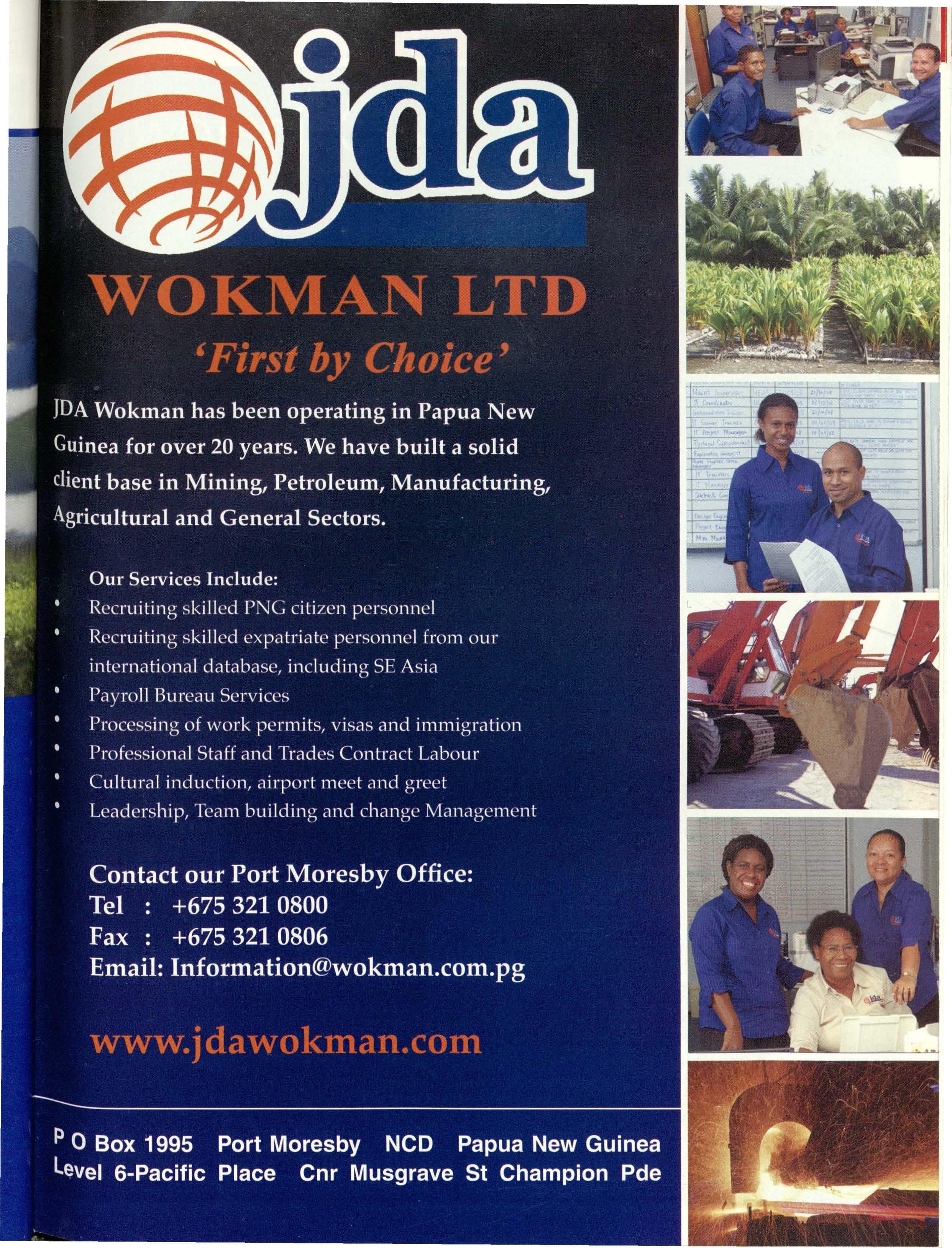
he Singapore most people see today is a sleek, efficient and clean, some might say sanitised, South East Asian city that prides itself on being a modern metropolis with stunning architecture, world class recreational resorts and a thoroughly commercial ethos.
There are flash hotels, the fantastically regular MRT transport system to move people around and, of course, the endless malls and emporia that crowd the Orchard Road district - sufficient to sustain even the most addicted shopaholic.
But it wasn't always like this. Singapore has taken many years to develop into the business entrepot that it is today,
a rival to its Asian neighbour, Hong Kong. But where is the Singapore of yesteryear or has it all been bulldozed in the name of development?
Luckily, the zeal of urban renewal was contained to spare one of the old districts of the city state, just north of the central business district - Chinatown - which today provides a window into the past.
Here, one can wander around and experience what life must have been like before containers replaced the bum boats that plied the Singapore River, transporting goods from shipside to dockside warehouses, known as godowns.

The Chinatown district is in fact one of a number of districts in the city where Chinese immigrants originally settled in crowded urban ghettos along with people of the same language group - Hokkien, Teochew, Cantonese, Hakka and others, mainly from the south of the mainland.
A separate ethnic group of mixed Chinese and Malay ancestry, speaking English Malay and Hokkien, known as Perankans, lived in the suburbs of Geylang and Katong where they were business intermediaries.
People from different parts of China were escaping economic hardship caused by the Opium Wars and gravitated to certain trades and
professions in the various waves of migration to Singapore.
TheTeochiew settled on the banks of the Singapore River and were involved in commerce, fishing and plantations, whilst the Cantonese worked mainly as doctors, politicians, teachers, goldsmiths and tailors and were to be found in the shop houses along Temple, Pagoda and Mosque streets. Interestingly, many of the construction workers in the early 20th century were Cantonese and Hakkawomen.
Many of these ethnic Chinese enclaves have now disappeared under the concrete jungle of 'development' that covers much of the central business district.
But some of the regional schools, temples, and buildings of the clan, language and labour associations, known as kongsi, established to assist migrants in the 19th and early 20th century, still exist today.
When Lieutenant Governor of Java, Sir Stamford Raffles, signed a treaty to establish an East India Company port on the swampy island with Tengku Long, the Sultan of Johore, in February 1819, Singapore was home to a few itinerant Malay fishermen, although there are records of some Chinese presence from the 1400s.
As a convenient port at the tip of the Malay Peninsulaand near the straits of Malacca, Singapore quickly eclipsed other British
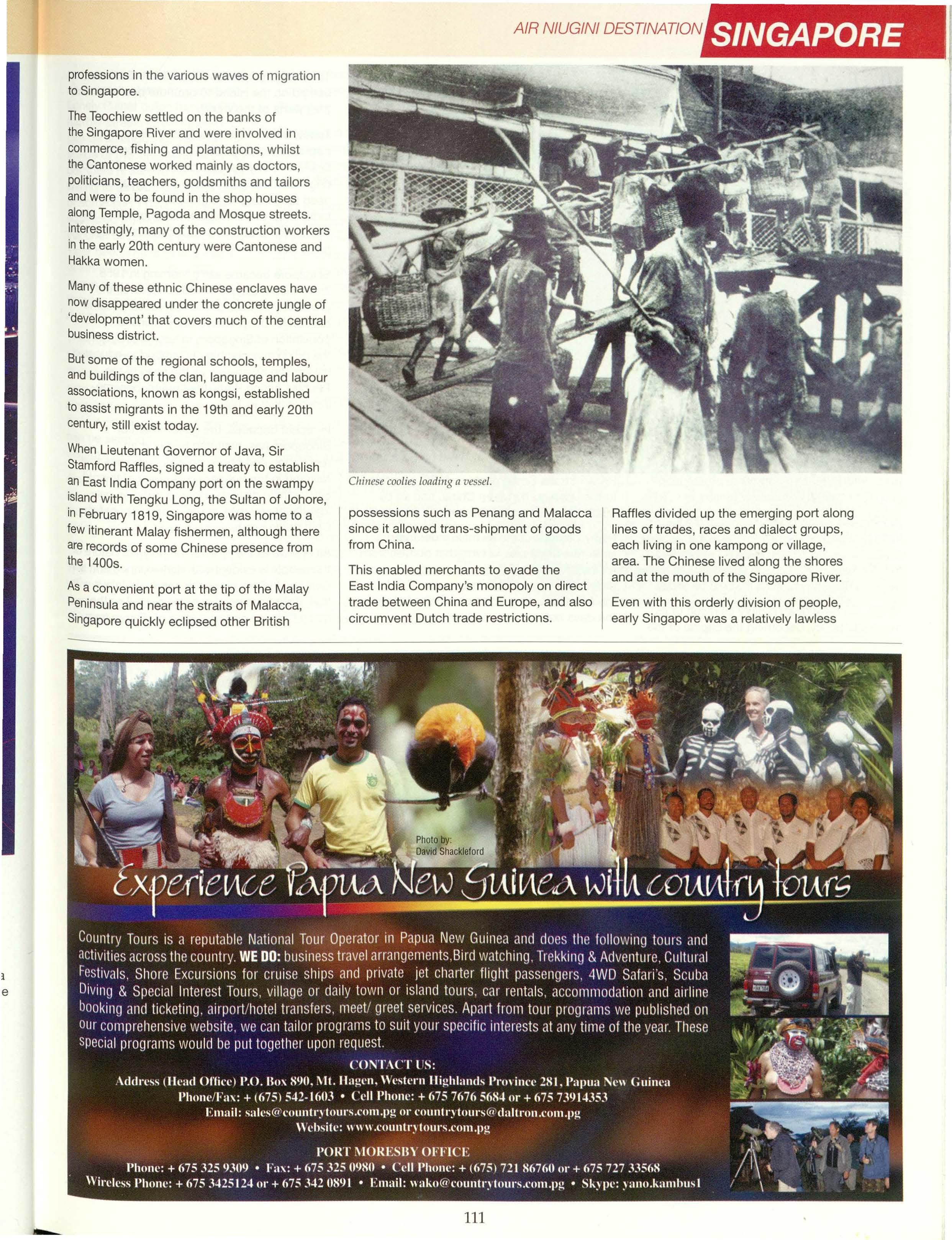
possessions such as Penang and Malacca since it allowed trans-shipment of goods from China.
This enabled merchants to evade the East India Company's monopoly on direct trade between China and Europe, and also circumvent Dutch trade restrictions.
Raffles divided up the emerging port along lines of trades, races and dialect groups, each living in one kampong or village, area. The Chinese lived along the shores and at the mouth of the Singapore River.
Even with this orderly division of people, early Singapore was a relatively lawless
Shopping at down/own Chinatown.
place with extensive gambling, prostitution and drug-taking, particularly opium, rife.
At this time, much of the income of the East India Company derived from the lucrative trade in opium, grown in India and sold in China, so that the high level of opium smoking was not as frowned upon as much as it would be today.
Singapore developed rapidly as result of its free trade policy, becoming the capital of the
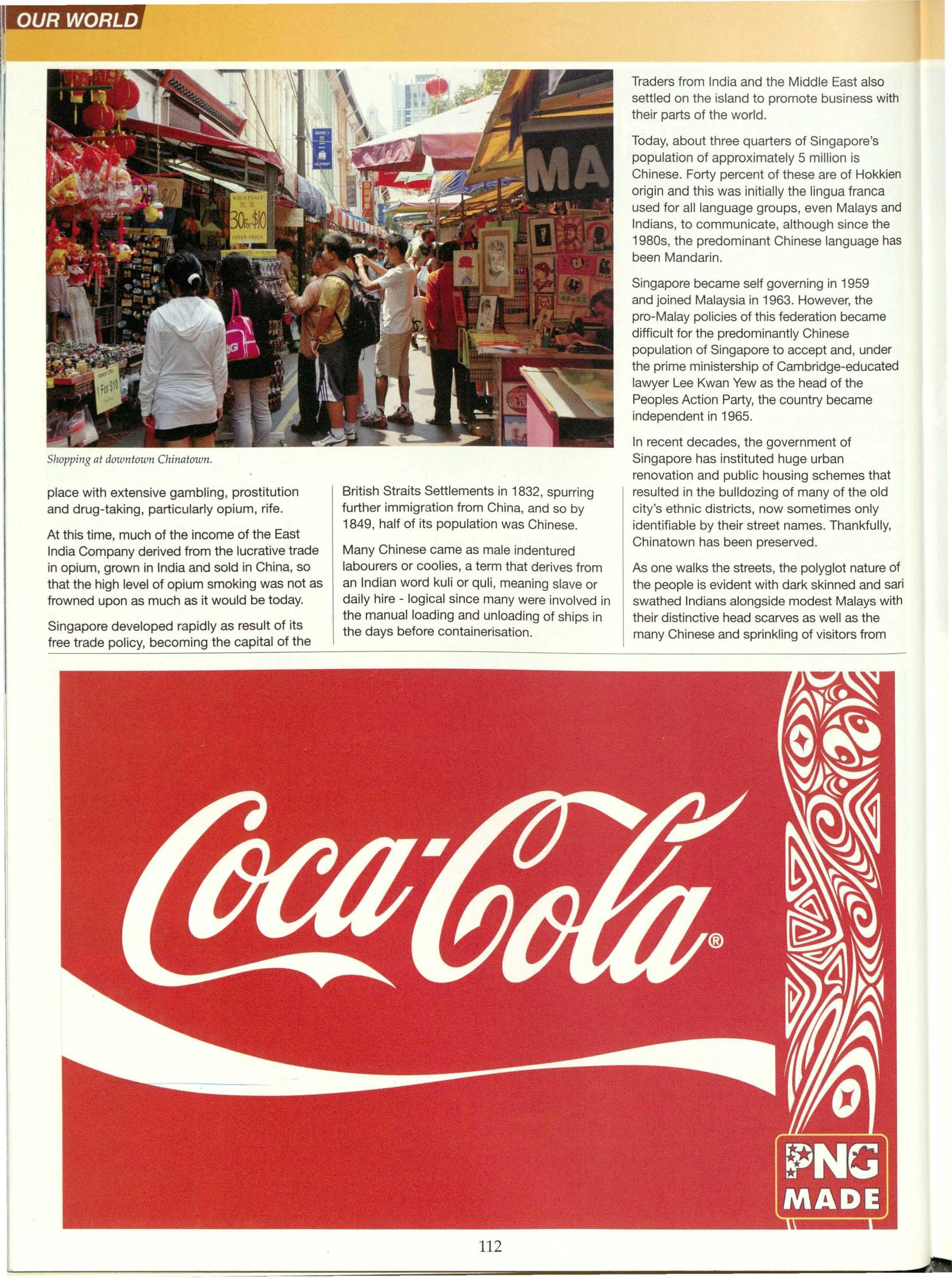
British Straits Settlements in 1832, spurring further immigration from China, and so by 1849, half of its population was Chinese.
Many Chinese came as male indentured labourers or coolies, a term that derives from an Indian word kuli or quli, meaning slave or daily hire - logical since many were involved in the manual loading and unloading of ships in the days before containerisation.
Traders from India and the Middle East also settled on the island to promote business with their parts of the world.
Today, about three quarters of Singapore's population of approximately 5 million is Chinese. Forty percent of these are of Hokkien origin and this was initially the lingua franca used for all language groups, even Malays and Indians, to communicate, although since the 1980s, the predominant Chinese language has been Mandarin.
Singapore became self governing in 1959 and joined Malaysia in 1963. However, the pro-Malay policies of this federation became difficult for the predominantly Chinese population of Singapore to accept and, under the prime ministership of Cambridge-educated lawyer Lee Kwan Yew as the head of the Peoples Action Party, the country became independent in 1965.
In recent decades, the government of Singapore has instituted huge urban renovation and public housing schemes that resulted in the bulldozing of many of the old city's ethnic districts, now sometimes only identifiable by their street names. Thankfully, Chinatown has been preserved.
As one walks the streets, the polyglot nature of the people is evident with dark skinned and sari swathed Indians alongside modest Malays with their distinctive head scarves as well as the many Chinese and sprinkling of visitors from
all over the world, often spotted desperatelyclutching copies of LonelyPlanet guide books. The narrow streets of Chinatown can be stiflingly hot, despite the shade of the innumerable stalls, but there is sure to be someone willing to sell you a cooling drink of some sort - healthy freshly squeezed fruit juice, a green coconut or perhaps even a cold Tiger beer. The area is a maze of streets, shops and stalls abovewhich flutter flagpoles of laundry protruding from upstairs apartment windows.
The old shophouses of Chinatown havebeen restored, yet whenever there is a space, the construction cranes and skyscrapers of the surrounding city, that seems to be in a constant state of renewal, can be seen looming over the district.
Along Pagoda Street, behind the inevitablerow of laneway stalls, is the Chinatown Heritage Centre, Whichonly levies a nominal entrancefee.
This mini museum, within three beautifullyrestored shophouses, documents and displays a wealth of memories and stories of the

migrants who made the perilous journey from their homeland to Singapore.
The place is full of photographs and memorabilia from the early days of Chinatown and the other ethnic districts of the city.
Part of the centre provides an experience of what it was like to live in the cramped quarters of a shophouse. The working and living areas of coolies, seamstresses, tailors, carpenters, other tradesmen and prostitutes have been painstakingly recreated complete with clothing, tools and every day possessions, including opium pipes of course, which give an insight into the lives of early Chinese migrants.
Prices in Chinatown are not negotiable and always clearly marked, but be rest assured they are well below anywhere else in town - so you are advised to make your way to Chinatown on the MRT or by taxi before being tempted by the many shops along Orchard Road - it will ._ certainly be worth it! U
0Thursday.
he trail was slick with mud. Sweat trickled down my back. The air smelt rich and peaty from rotting leaves. Thick jungle muffled the scrapings and scratchings of unseen wildlife. My husband stopped abruptly with a small exclamation of disgust. A leech was exploring his boot.
We were in the Sepilok Forest Reserve in Sabah, Malaysia, on the island of Borneo searching for pongo pygmaeus, better known as orang-utan: The Man of the Forest.
The orang-utan is the only ape in South-east Asia and their numbers are dwindling at an alarming rate. Commercial logging and land clearance for palm oil plantations are the major culprits.
Estimated figures for orang-utans in the wild vary between 15 and 20 thousand which puts them on the critically endangered list.
The Sepilok Reserve comprises approximately 43 square kilometres and we were exploring a tiny section on one edge of it. Sepilok was established in 1931 as an area for experimentation into tropical forest
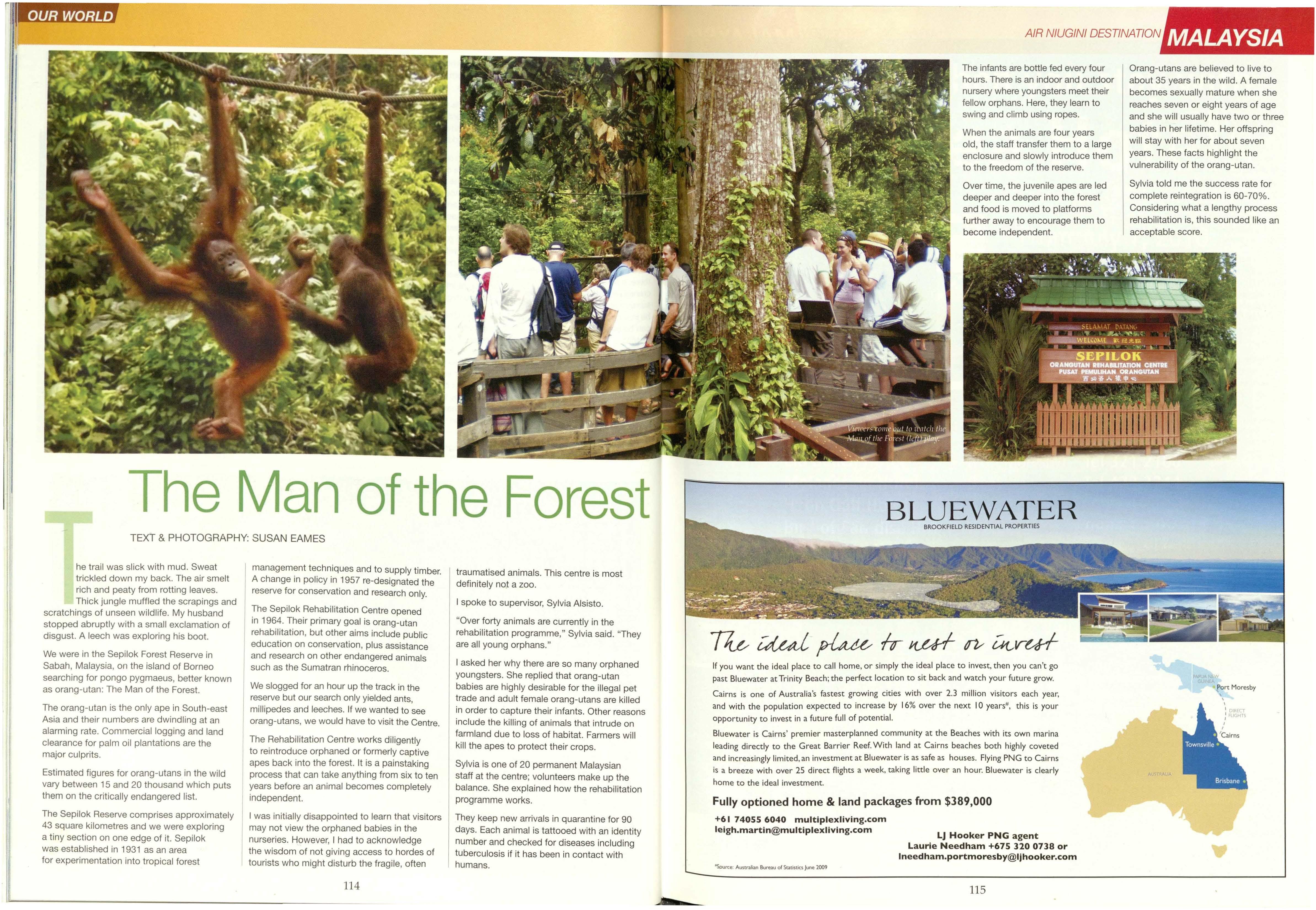
management techniques and to supply timber.
A change in policy in 1957 re-designated the reserve for conservation and research only.
The Sepilok Rehabilitation Centre opened in 1964. Their primary goal is orang-utan rehabilitation, but other aims include public education on conservation, plus assistance and research on other endangered animals such as the Sumatran rhinoceros.
We slogged for an hour up the track in the reserve but our search only yielded ants, millipedes and leeches. If we wanted to see orang-utans, we would have to visit the Centre.
The Rehabilitation Centre works diligently to reintroduce orphaned or formerly captive apes back into the forest. It is a painstaking process that can take anything from six to ten years before an animal becomes completely independent.
I was initially disappointed to learn that visitors may not view the orphaned babies in the nurseries. However, I had to acknowledge the wisdom of not giving access to hordes of tourists who might disturb the fragile, often
traumatised animals. This centre is most definitely not a zoo.
I spoke to supervisor, Sylvia Alsisto.
"Over forty animals are currently in the rehabilitation programme," Sylvia said. "They are all young orphans."
I asked her why there are so many orphaned youngsters. She replied that orang-utan babies are highly desirable for the illegal pet trade and adult female orang-utans are killed in order to capture their infants. Other reasons include the killing of animals that intrude on farmland due to loss of habitat. Farmers will kill the apes to protect their crops.
Sylvia is one of 20 permanent Malaysian staff at the centre; volunteers make up the balance. She explained how the rehabilitation programme works.
They keep new arrivals in quarantine for 90 days. Each animal is tattooed with an identity number and checked for diseases including tuberculosis if it has been in contact with humans.
The infants are bottle fed every four hours. There is an indoor and outdoor nursery where youngsters meet their fellow orphans. Here, they learn to swing and climb using ropes.
When the animals are four years old, the staff transfer them to a large enclosure and slowly introduce them to the freedom of the reserve.
Over time, the juvenile apes are led deeper and deeper into the forest and food is moved to platforms further away to encourage them to become independent.
Orang-utans are believed to live to about 35 years in the wild. A female becomes sexually mature when she reaches seven or eight years of age and she will usually have two or three babies in her lifetime. Her offspring will stay with her for about seven years. These facts highlight the vulnerability of the orang-utan.
Sylvia told me the success rate for complete reintegration is 60-70%.
Considering what a lengthy process rehabilitation is, this sounded like an acceptable score.
BROOKFIELD RESIDENTIALPROPERTIES
If you want the ideal place to call home, or simply the ideal place to invest, then you can't go past Bluewater at Trinity Beach; the perfect location to sit back and watch your future grow.
Cairns is one of Australia's fastest growing cities with over 2.3 million visitors each year, and with the population expected to increase by 16% over the next I O years•, this is your opportunity to invest in a future full of potential.
Bluewater is Cairns' premier masterplanned community at the Beaches with its own marina leading directly to the Great Barrier Reef.With land at Cairns beaches both highly coveted and increasingly limited, an investment at Bluewater is as safe as houses. Flying PNG to Cairns is a breeze with over 25 direct flights a week, taking little over an hour. Bluewater is clearly home to the ideal investment.
Fully optioned home & land packages from $389,000
+61 740S5 6040 multiplexliving.com leigh.martin@multiplexliving.com
-SOurce:AustralianBureauof StatisticsJune2009
LJ Hooker PNG agent Laurie Needham +675 320 0738 or lneedham.portmoresby@ljhooker.com
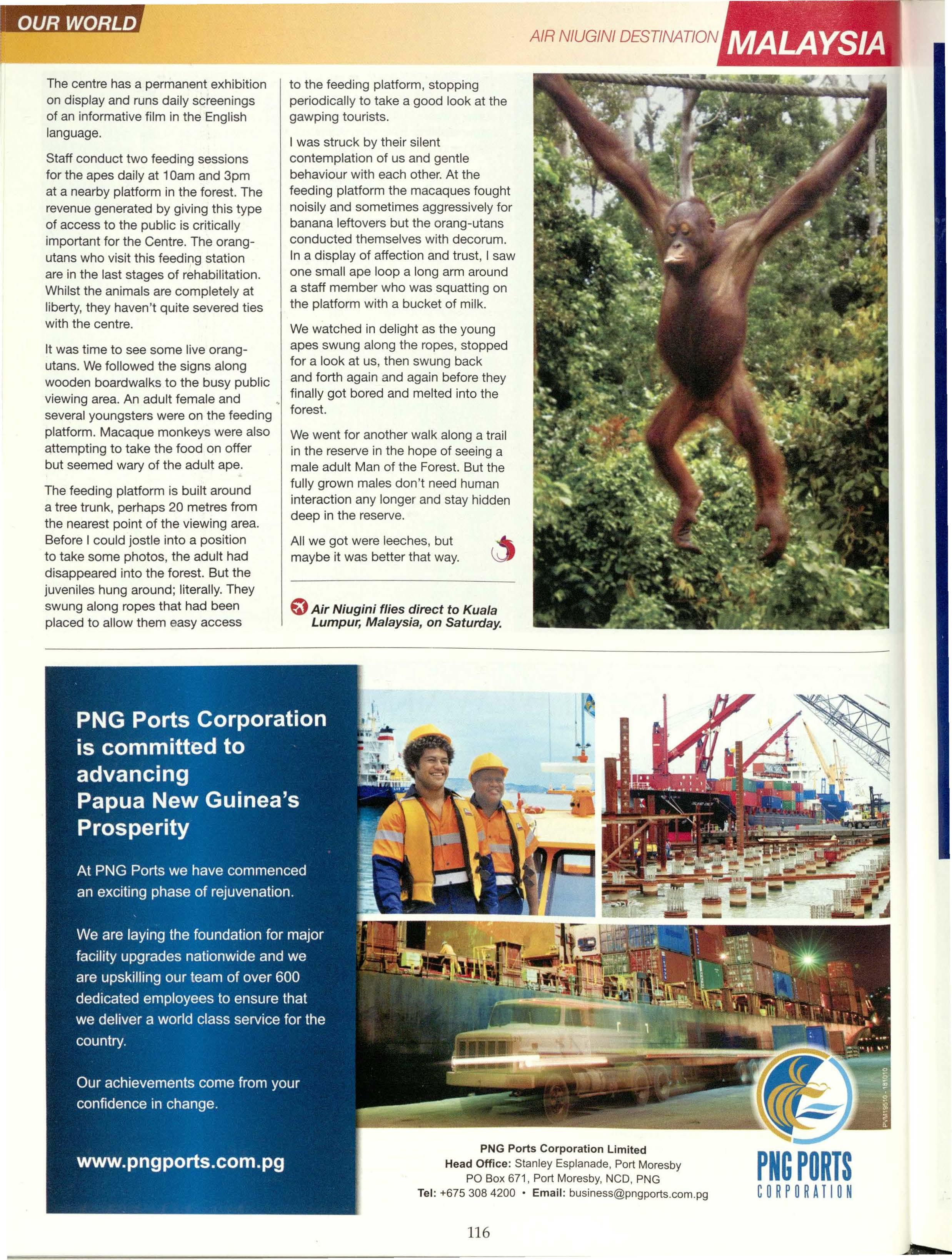
The centre has a permanent exhibition on display and runs daily screenings of an informative film in the English language.
Staff conduct two feeding sessions for the apes daily at 1Dam and 3pm at a nearby platform in the forest. The revenue generated by giving this type of access to the public is critically important for the Centre. The orangutans who visit this feeding station are in the last stages of rehabilitation. Whilst the animals are completely at liberty, they haven't quite severed ties with the centre.
It was time to see some live orangutans. We followed the signs along wooden boardwalks to the busy public viewing area. An adult female and several youngsters were on the feeding platform. Macaque monkeys were also attempting to take the food on offer but seemed wary of the adult ape. The feeding platform is built around a tree trunk, perhaps 20 metres from the nearest point of the viewing area. Before I could jostle into a position to take some photos, the adult had disappeared into the forest. But the juveniles hung around; literally. They swung along ropes that had been placed to allow them easy access
to the feeding platform, stopping periodically to take a good look at the gawping tourists.
I was struck by their silent contemplation of us and gentle behaviour with each other. At the feeding platform the macaques fought noisily and sometimes aggressively for banana leftovers but the orang-utans conducted themselves with decorum. In a display of affection and trust, I saw one small ape loop a long arm around a staff member who was squatting on the platform with a bucket of milk.
We watched in delight as the young apes swung along the ropes, stopped for a look at us, then swung back and forth again and again before they finally got bored and melted into the forest.
We went for another walk along a trail in the reserve in the hope of seeing a male adult Man of the Forest. But the fully grown males don't need human interaction any longer and stay hidden deep in the reserve.
All we got were leeches, but maybe it was better that way.
Q Air Niugini flies direct to Kuala Lumpur, Malaysia, on Saturday.
Comfort and convenience across Papua New Guinea
~~Nluglnl DESTINATIONS Loy11tryProgrMn

CoralSea Hotelsis an officialprogrampartner/participantof Air Niugini'sDestinationsLoyaltyProgram.
Earnpointsonlywhereyou see the officialDestinationsLoyaltyProgramcardand logo.
• MembersmustpresenttheirsignedDestinationsLoyaltycardwith identificationat the timeof checkingin to the hotel.Pointswill not beback-datedeitherduringthe stayor at a laterdate. Pointsareawardedfor accommodationbookingsonlyanddo not applyto GSTor othertaxes.Offerdoesnot applyto food,beverageandotherguestchargesincurredduringa stay.Offer of point_s is availableto individualsonlyanddoesnot includelong-stayapartmentsor guestson a negotiatedlong-stayrate;airlinecrew,staffor disruptedpassengers;inboundwholesale groupsandPNGwholesaleagentsbookinggroups;conferenceattendeesnoremployeesof the SteamshipsGroupof Companies
BY GLENN A. BAKER

t is in the much romanticised image of the Sabra, the native-born Israeli - rugged and handsome, with a plough in one hand and a gun in the other - that the key to understanding Israel can be found.
The word came from the cactus fruit, which is prickly on the outside, sweet on the inside.
It cannot be denied that there is sometimes an abrasiveness, an abruptness about the five million citizens of the dynamic Mediterranean and Middle Eastern nation. Many of the common courtesies of conversation seem to have evaporated.
The pace is swift, sometimes harsh; impatience manifests itself everywhere, particularly in drivers who will honk you at traffic lights in anticipation of the green.
But after a number of wars of survival and a constant state of siege with hostile neighbours of far greater population who, in some cases, have denied the Jewish state's very right of existence, one could not fairly expect all the niceties of social intercourse tc, have survived intact. These people have had a few other things to worry about over the past fifty or so years.
Understanding that reality is essential to successfully coming to grips with the vitality, idealism and drive of a staggeringly diverse, polyglot nation, simultaneously ancient and modern.
There is an exhilaration that comes with being absorbed, however momentarily, into its rich, woven fabric. If stress strengthens and adversity unites, then Israel's boldness and achievements are integral to the nation it believed it was destined to become.
Not that there is a great deal of nation to begin with. For all its historical strategic significance as a crossroad of the world, for all its spiritual importance to Jews, Christians, Muslims and other faiths, Israel is not much more than a geographic flyspeck.
The absurdly tiny dimensions of this compact country, just a tad bigger than New Jersey, are probably noticed less by, say, Brits and Belgiums than by Americans and Australians who find, to their astonishment, that one can drive from the lush green of Galilee to the arid brown of the stony Negev in an easy afternoon.
The bible gives such a sense of importance to the
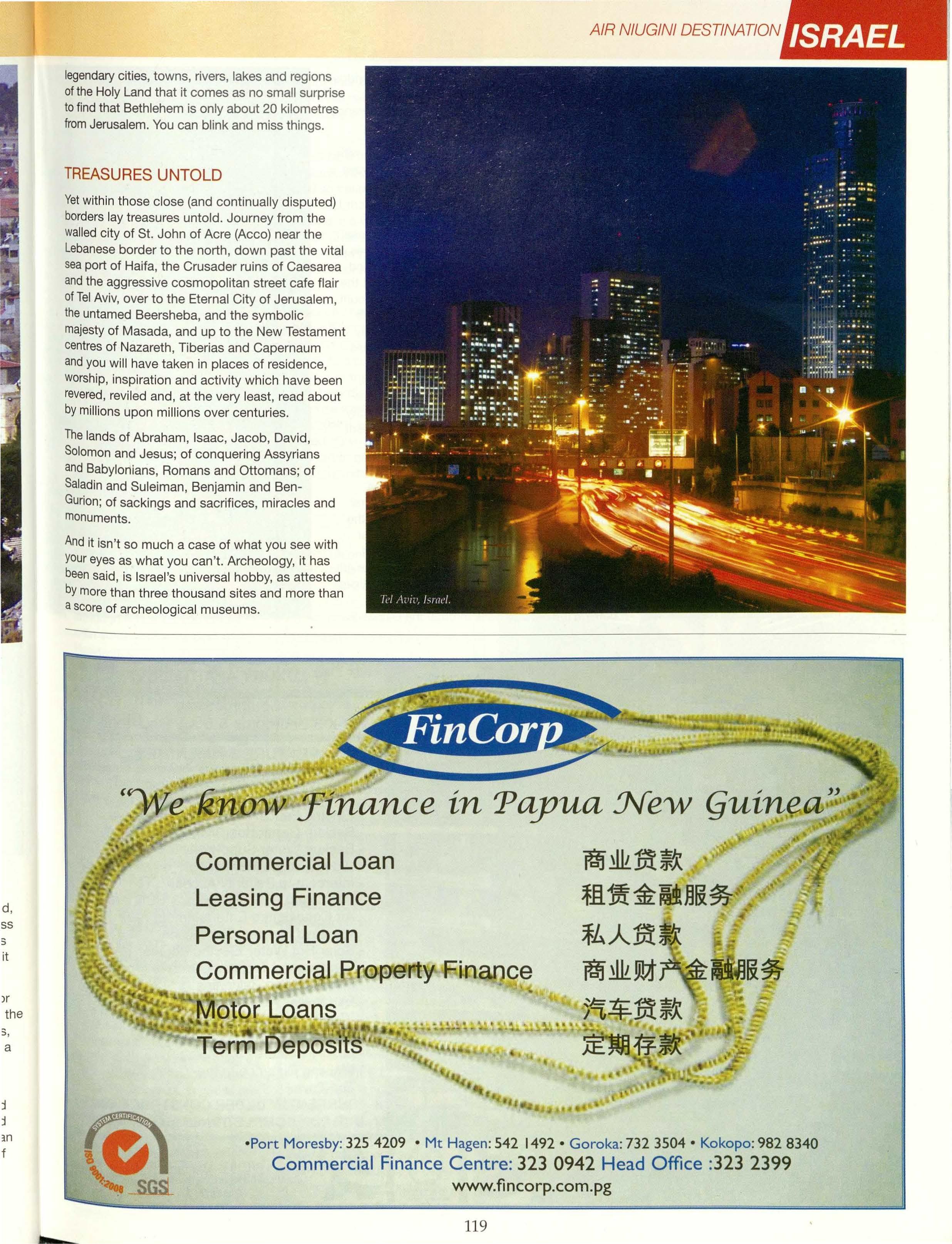
legendarycities, towns, rivers, lakes and regions of the Holy Land that it comes as no small surprise to find that Bethlehem is only about 20 kilometres from Jerusalem. You can blink and miss things.
Yetwithin those close (and continually disputed) borders lay treasures untold. Journey from the walled city of St. John of Acre (Acco) near the Lebanese border to the north, down past the vital sea port of Haifa, the Crusader ruins of Caesarea and the aggressive cosmopolitan street cafe flair of Tel Aviv, over to the Eternal City of Jerusalem, the untamed Beersheba, and the symbolic majesty of Masada, and up to the New Testament centres of Nazareth, Tiberias and Capernaum and you will have taken in places of residence, worship, inspiration and activity which have been revered, reviled and, at the very least, read about by millions upon millions over centuries.
The lands of Abraham, Isaac, Jacob, David, Solomon and Jesus; of conquering Assyrians and Babylonians, Romans and Ottomans; of Saladinand Suleiman, Benjamin and BenGurion; of sackings and sacrifices, miracles and monuments.
And it isn't so much a case of what you see with Youreyes as what you can't. Archeology, it has beensaid, is Israel's universal hobby, as attested by more than three thousand sites and more than a score of archeological museums.

Around Jerusalem, it isn't possible to dig the foundations for a new building, sometimes even to dig a backyard garden, without drilling down through the layers of history, a dozen civilisations and counting. Any occupant comes to realise that he is but a temporary holder of soil that has sustained people and their practices since the dawn of time. With its young, clever, restless population (a third under the age of 14), Israel has made the desert bloom and bear fruit. It sustains itself, exports to the world and can boast imitated initiatives in technology and development.
It also has been known to attract a million and a half tourists and more than US$2 billion in tourism revenue in a year. While the flow has long been dominated by Jewish family reunions, kibbutz volunteers, religious pilgrims, history buffs, or European backpackers looking for a bargain, Moses' Land of Milk and Honey has begun to exert some of its previously hidden charms and decidedly secular attractions.
The pleasure set has descended upon the Mediterranean beaches, Club Meds, Tel Aviv discos, Red Sea diving resorts, Mount Hermon skiing, Eilat snorkelling, Negev camel expeditions, Dead Sea restorative mud and salt baths, the grand and ornate King David
Hotel and, with the opening of the Allenby Bridge over the Jordan River, Jordan's Amman, the ancient sandstone city of Petra and the Lawrence of Arabia realm of Wadi Rum.
For all the burgeoning success it is enjoying with its sun'n'fun playground pitch, Israel will always be a cultural rather than sensual experience. The majority of visitors will still, depending upon religious persuasion, want to count off the stations of the cross along the Via Dolorosa inside the towering walls and decorative gates of Jerusalem, walk up to the Mount of Olives and sit in the Garden of Gethsemane, worship at the Wailing Wall, visit the magnificent Temple Mount and its Dome of the Rock, seek out the Tomb of Zacharia in the Kidron Valley, and generally acquaint themselves with a seemingly endless number of churches, chapels, synagogues, mosques, temples, tombs, museums, pillars, springs, pools, tunnels, chambers and arches held variously sacred and significant in this city of worship by followers of Christianity, Judaism and Islam.
Sacred, but not always unanimously acknowledged, at least in the case of some Christian sites. Although Constantine's mother Helena claimed the tomb of Jesus to be on the site of a Roman temple to Venus and had her son build the church that is now known, and venerated, as the Holy Sepulchre there in the 4th century, many Protestant Christians now believe that the rather more peaceful Garden Tomb, outside the old city walls through the Damascus
Compromising
12 X 3 Bedrooms & 5 X 2 Bedrooms
FEATURE & AMENITIES
- Secure Carparking
- 24 Hour Security Guard Dogs
- Electric Fence
- Backup Generator
- Backup Water Supply
- Video Access Monitoring
- Intercom to Security Access
- Swimming Pool, Sundeck & BBQ Areas
- Air Conditioned Entertainment Area
- Wireless Internet Connection
- Solar Hot Water Electric Booster
- Landscaped Tropical Gardens
- Wrap-Around Balconies
- Expansive Views of the Huon Gulf
- "CrimSafe" Security Screen
- Imported Granite & Ceramic Tiles
- Luxury Features & Finishes
- Walking Distance to the Yacht Club & Top Town
CURRENTLY UNDER CONSTRUCTION DUE FOR COMPLETION IN MARCH 2011
For further information, contact: ARTHURSTRATCHANLTD
Email: astratchan@arthurstratchan.com.pg Ph: 9675) 472 1255
Gate toward East Jerusalem on Nablus Road, is in fact the real Golgotha; a belief enhanced by a distinct skullshaped rock.
That could well be a matter of debate, but then so is everything in Israel, an engaging and sometimes affronting society wedged at the apex of Africa, Asia and Europe in a Great Rift Valley and largely comprised of immigrants from up to 100 countries; Jews whose only conceivable connection is their Jewishness.
Argumentative and opinionated, blunt but articulate, often convivial and charismatic, ever in a state of readiness. People coming to a subject from every conceivable background and viewpoint; aware of their own disparate histories and the immense worth of the sacred sites in their collective safekeeping yet not so weighed down by the past that they can't go out to greet the future with a startling determination.
CLIMATE: Israel climate is temperate and two-seasonal. From a weather perspective, there is no preferred time to visit, although winter can be colder than some visitors expect. However,even if Jerusalem is shivering under a snowfall, the DeadSea resorts, just a hour away,will be invariably sunny and pleasant.
ACCOMMODATION: If you Visitduring the Passover/Easter Periodor later in October, aroundthe Rosh Hashanah, Yorn Kippur and Sukkor celebrations and observances, expect to find much of Israel (including Publictransport) shuttered up and accommodation up to twice the price. Each week the Jewish Sabbath(Shabbat) closes the country down from sundown Fridayto sundown Saturday.
VISAS: In most cases you need 0 nly your passport to visit Israel, Visasare not required. If you Planto visit other Middle Eastern countries (apart from Jordan and Egypt)afterwards it is advisable to request that border posts stamp your entry permit and not Yourpassport. It is now simple and straightforward to cross the Allenby Bridge and enter Jordan, 1n order to visit Amman or Petra. If You enter by air a three month tourist visa is automatically given, though if you enter by land from Egypt or Jordan it
may only be one month. You can not enter by land from Lebanon or Syria. There are cheap and regular El Al and Air Sinai flights between Israel and Egypt.
LANGUAGE: The national languages are Hebrew and Arabic but English is widely spoken. Given Israel's richly cosmopolitan make-up, so too is Russian, Yiddish, French, German, Spanish, Ethiopian and many others.
CURRENCY: The Shekel is the official unit of currency but the U.S. dollar seems to be the most commonly quoted and used, at least when it comes to tourist dealings. Credit cards are widely accepted and ATMs are dotted all over.
ACTIVITIES: Israel has a well-regarded ski field at Mount Hermon in the north, which comes on line in late December. Those with more earthy tastes still seek out the country's Kibbutz Programme, which enables volunteers to work, singly or in groups, on communal farms and orchards.
ENTERTAINMENT:
Entertainment is rich and varied in Israel - from symphony recitals to raging rock bands, cinemas to theatres. There is also a plentiful supply of bookshops and an equally plentiful supply of cafes in which to read your purchases.

FromK13,290
9 nights/13 days per person twin share
An enriching spiritual discovery - experience the historical and fascinating Jordan & Israel.
Package inclusions: Return airfares from Port Moresby to Jordan & Israel via Singapore, airport transfers, twin share accommodation in Singapore, Jordan, Israel, all tours & fees in Jordan & Israel, taxes and surcharges.
- Based on a minimum of group size of 15 persons. Price is subject to change. Strict conditions apply.
- Call toll free on 180 3444 , or contact your nearest Air Niugini Travel Centre or Travel Agent to secure your "Holy Land" package.
All the human components of Israel - Jews, Palestinians, curious tourists and pilgrims - go about their business with an air of industrious endeavour and general accommodation.
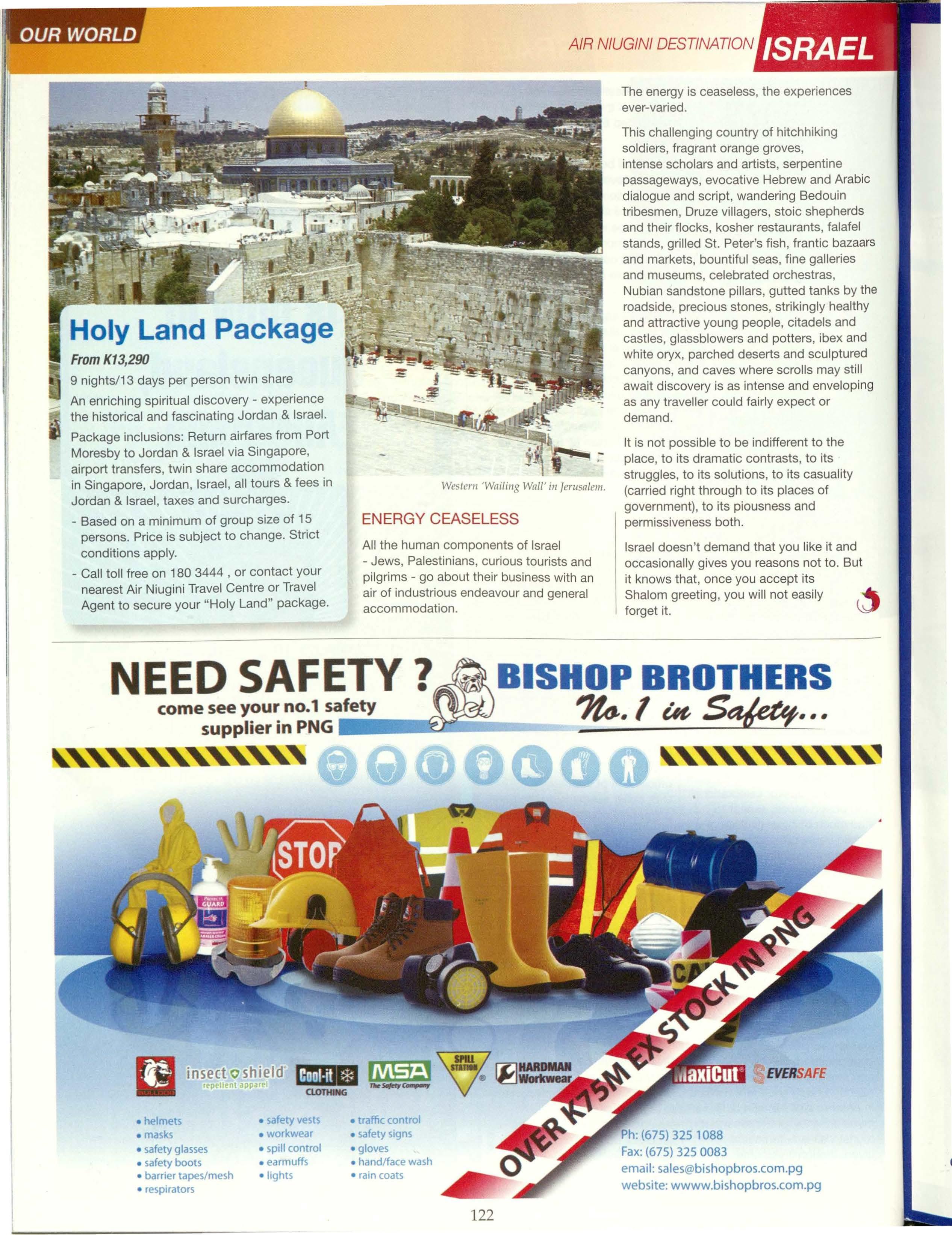
The energy is ceaseless, the experiences ever-varied.
This challenging country of hitchhiking soldiers, fragrant orange groves, intense scholars and artists, serpentine passageways, evocative Hebrew and Arabic dialogue and script, wandering Bedouin tribesmen, Druze villagers, stoic shepherds and their flocks, kosher restaurants, falafel stands, grilled St. Peter's fish, frantic bazaars and markets, bountiful seas, fine galleries and museums, celebrated orchestras, Nubian sandstone pillars, gutted tanks by the roadside, precious stones, strikingly healthy and attractive young people, citadels and castles, glassblowers and potters, ibex and white oryx, parched deserts and sculptured canyons, and caves where scrolls may still await discovery is as intense and enveloping as any traveller could fairly expect or demand.
It is not possible to be indifferent to the place, to its dramatic contrasts, to its struggles, to its solutions, to its casuality (carried right through to its places of government), to its piousness and permissiveness both.
Israel doesn't demand that you like it and occasionally gives you reasons not to. But it knows that, once you accept its Shalom greeting, you will not easily forget it.
Servicing Papua New Guinea since 1945
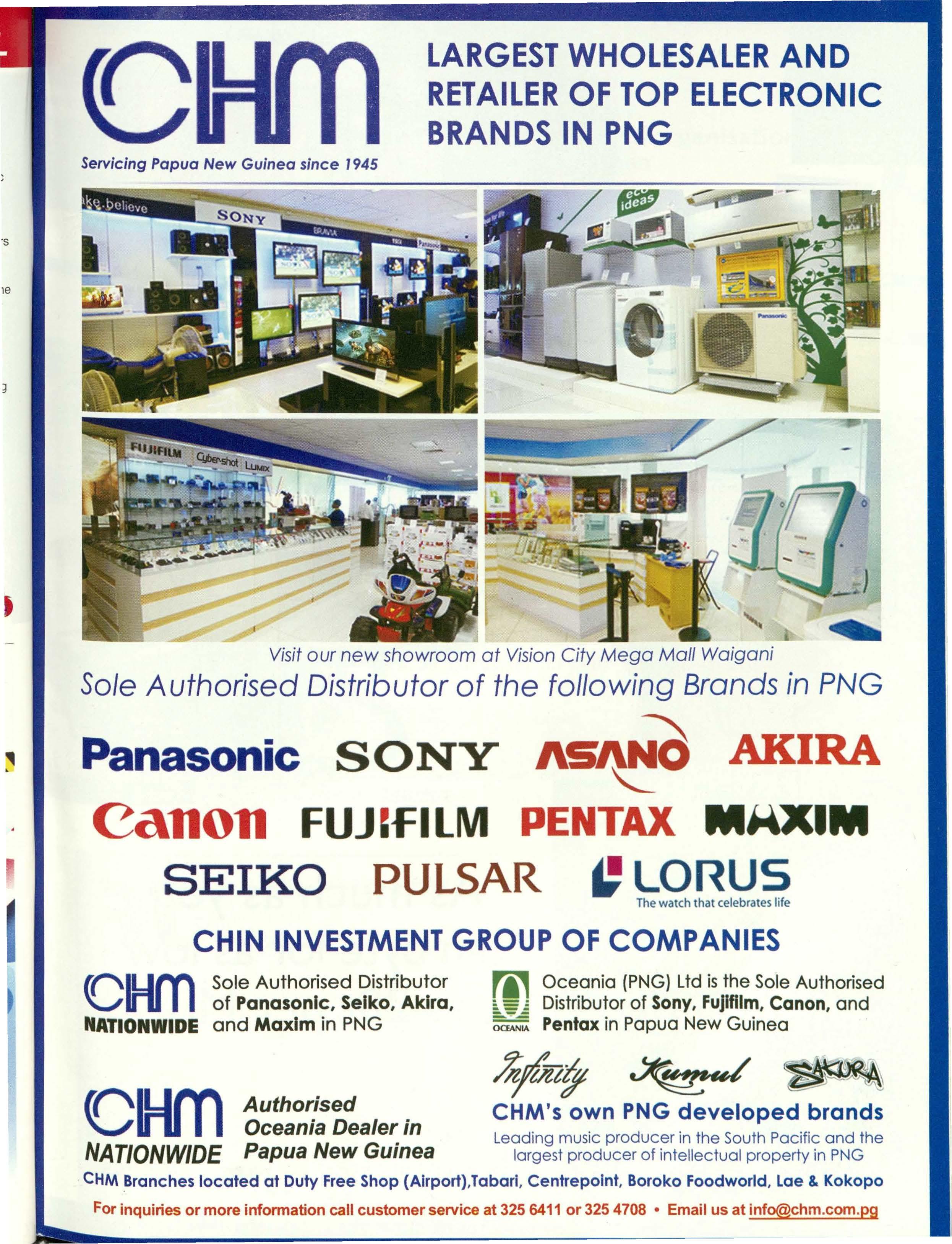
Visit our new showroom at Vision City Mega Mall Waigani
Sole Authorised Distributor of the following Brands in PNG
celebrateslife
CHm NATIONWIDE
Sole Authorised Distributor of Panasonic, Seiko, Aklra, and Maxim in PNG
(f'Hm Authorised V Oceania Dealer in NATIONWIDEPapua New Guinea
ra, Oceania (PNG) Ltd is the Sole Authorised i-:- .A Distributor of Sony,Fujifilm,Canon, and ~=Pentaxin Papua New Guinea
/4~tj
CHM's own PNG developed brands
Leading music producer in the South Pacific and the

The leading security and communications organisation in Papua New Guinea
- Static and mobile security - 24 hour monitoring control room
- Armed and unarmed escorts - Linked monitored alarm systems
- Attack dog security teams - Supply & service of fixed & hand held radios
- Client radio network support & monitoring - Satellite voice & data communication systems
- Extensive UHF and VHF radio network - CCTV security installation and service
G4S Secure Solutions (PNG) Ltd
Head Office: Port Moresby Phone: 325 6377 Fax: 325 8204 www.pg.g4s.com
Branch Offices: Lae, Madang, Goroka, Rabaul, Kimbe & Mt Hagen
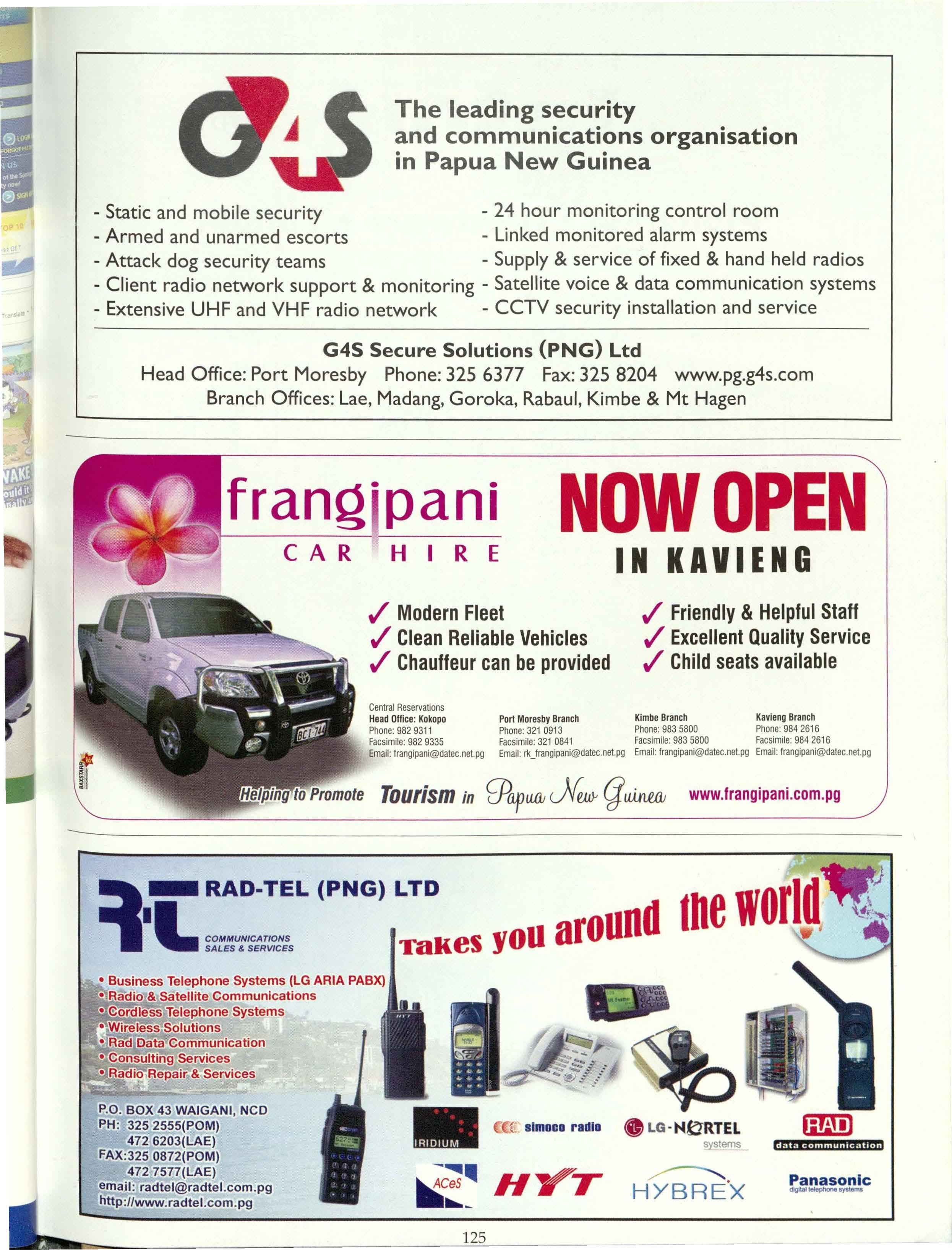
Facsimile:9829335
Email:frangipani@datec.net.pg
Facsimile:3210841
Facsimile:9835800
Facsimile:9842616
Email:rk_frangipani@datec.net.pgEmail:frangipani@datec.net.pgEmail:frangipani@datec.net.pg

• Flat Racks
• Open Tops
• ISO Tanks
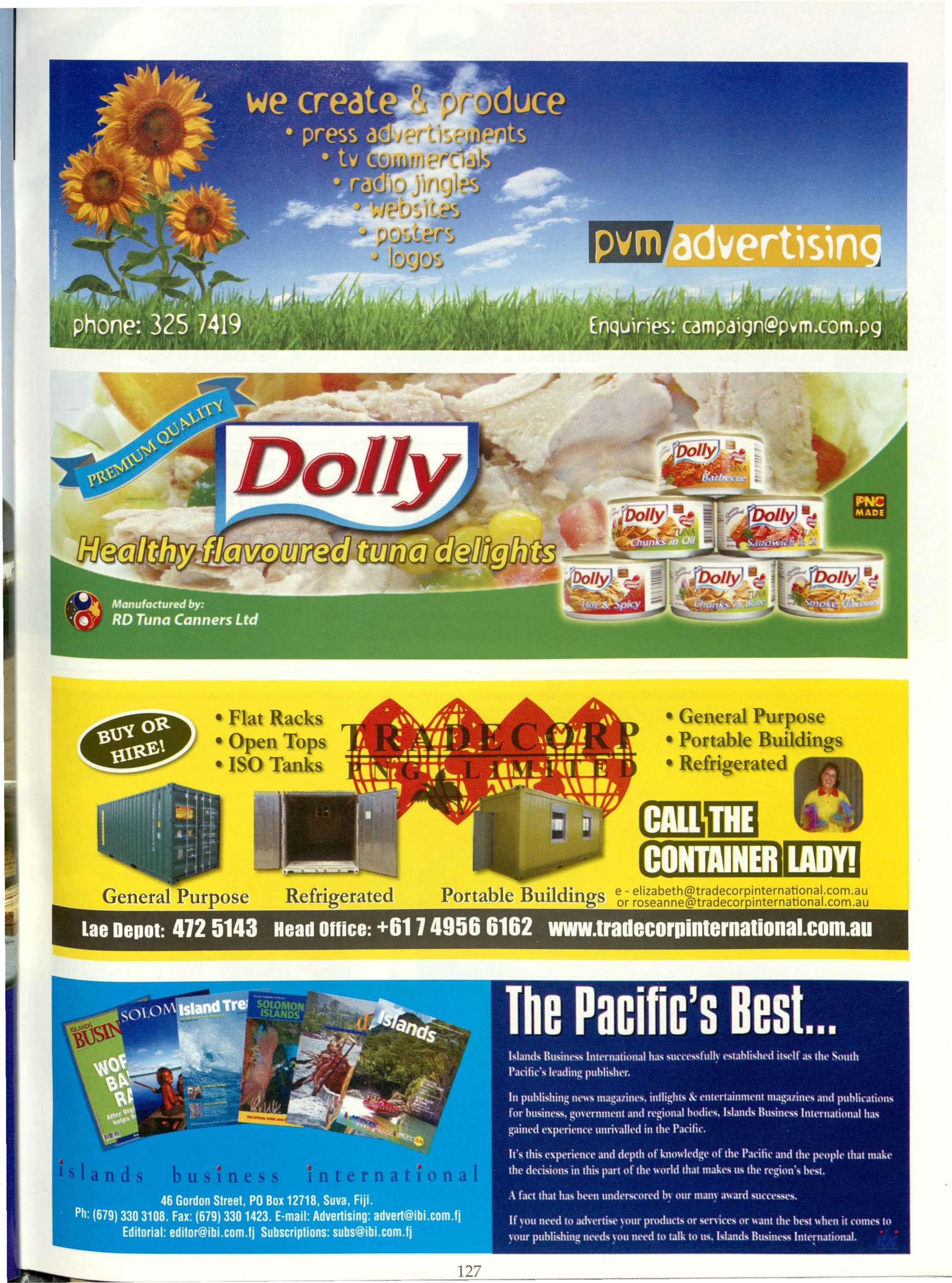
• GeneralPurpose
• PortableBuildings
• Refrigerated
e - elizabeth@tradecorpinternational.com.au or roseanne@tradecor international.corn.au
4th June - 7th June
30th Oct - 31 st Oct
3rd Sept - 4th September
8th September
10th Sept - 11th Sept

Event Description
Madang Festival
Morobe Agricultural Cultural Show Festival
9th National Garamut & Mambu Festival
4th Garamut & Mask Festival
2nd Middle Sepik Festival
Event Description
15th Apr - 18th Apr
5th May - 7th May
11th June-12th June
23rd July
10th Sept- 15th Sept
5th Nov- 7th Nov
National Arts & Craft Exhibition
8th Gogodala Canoe Festival
6th Gulf Mask Festival
New Ireland Cultural Day
Hiri Moale Festival
7th National Canoe Festival
Town/Province
Madang
Lae
Wewak
Rofudogmu Village
Paliambe Village
Town Province
Port Moresby
Balimom Town
Toare Village
Port Moresby
Port Moresby
Alotau
Vanda Fine Dining
's Coffee Shop
Pizz.a
Event Descri tion
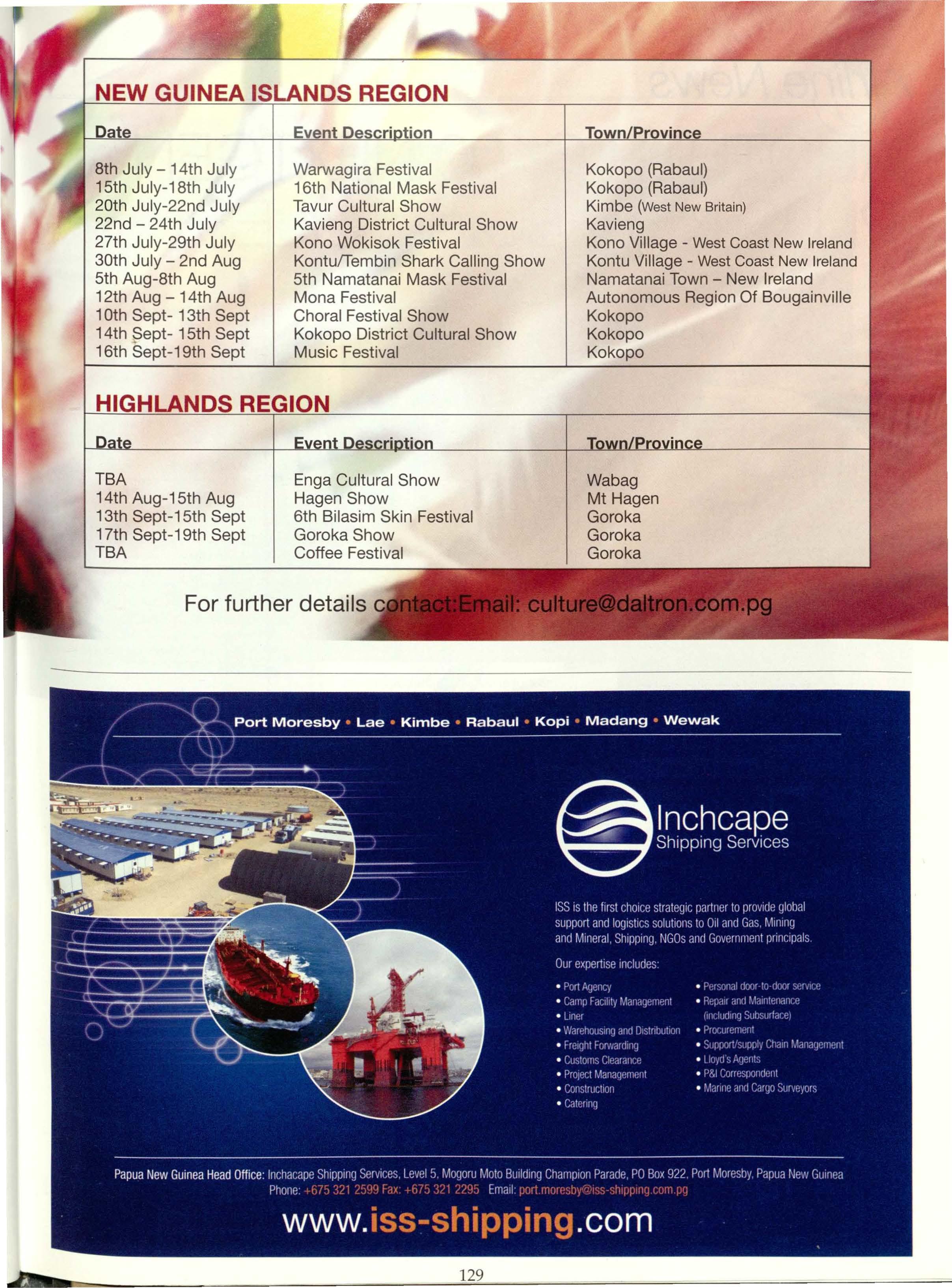
8th July - 14th July
15th July-18th July
20th July-22nd July
22nd - 24th July
27th July-29th July
30th July - 2nd Aug
5th Aug-8th Aug
12th Aug - 14th Aug
10th Sept- 13th Sept
14th ?ept- 15th Sept
16th Sept-19th Sept
Warwagira Festival
16th National Mask Festival
Tavur Cultural Show
Kavieng District Cultural Show
Kono Wokisok Festival
Kontu/Tembin Shark Calling Show
5th Namatanai Mask Festival
Mona Festival
Choral Festival Show
Kokopo District Cultural Show
Music Festival
TBA 14th Aug-1 Sth Aug
13th Sept-1 Sth Sept
17th Sept-19th Sept
TBA
Enga Cultural Show Hagen Show
6th Bilasim Skin Festival Goroka Show
Coffee Festival
For further details
Town Provin
Kokopo (Rabaul)
Kokopo (Rabaul)
Kimbe (West New Britain)
Kavieng
Kono Village - West Coast New Ireland
Kontu Village - WestCoast New Ireland
Namatanai Town - New Ireland
Autonomous Region Of Bougainville
Kokopo
Kokopo
Kokopo
Wabag
Mt Hagen
Goroka Goroka Goroka
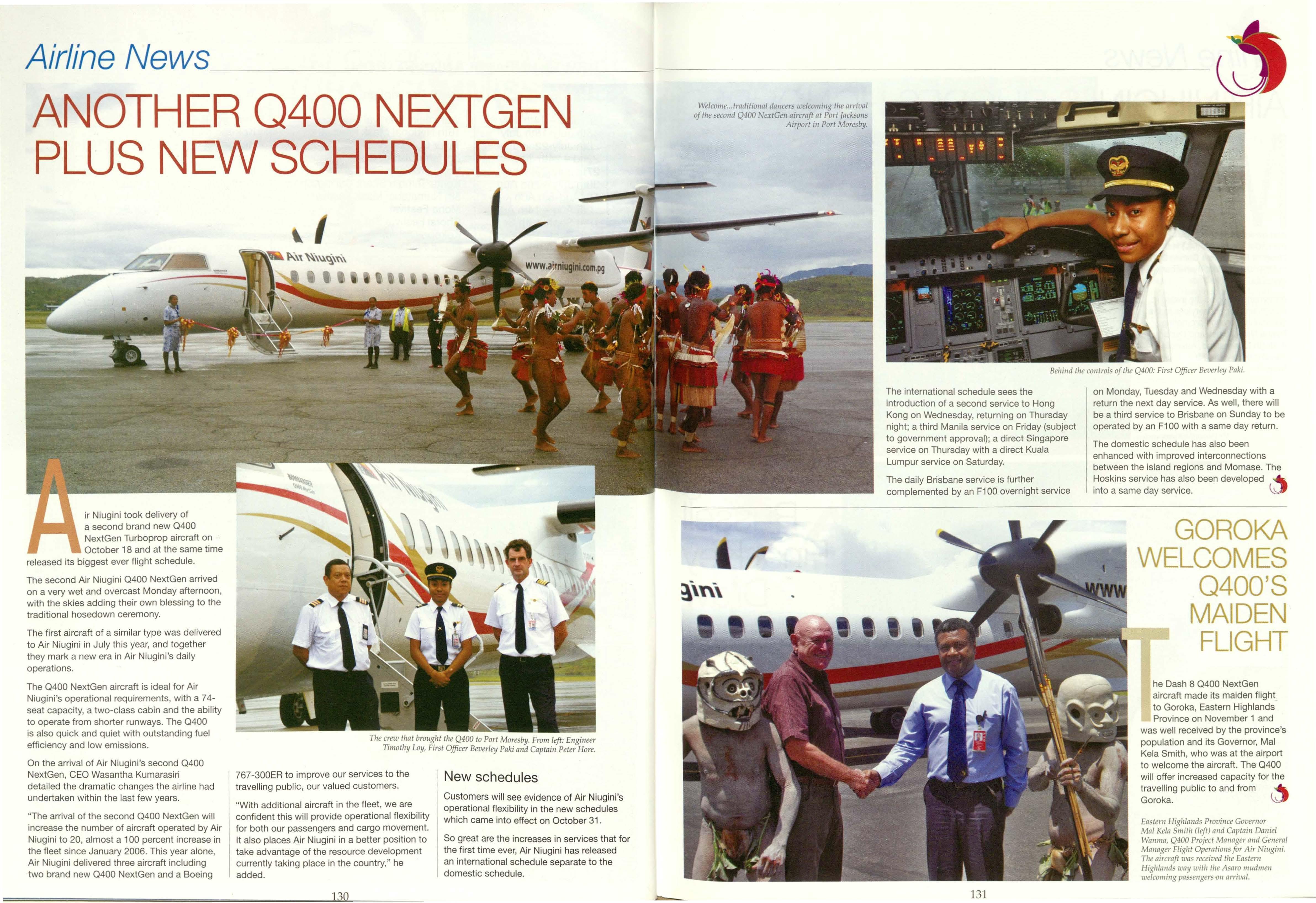
ir Niugini took delivery of a second brand new 0400 NextGen Turboprop aircraft on October 18 and at the same time released its biggest ever flight schedule.
The second Air Niugini 0400 NextGen arrived on a very wet and overcast Monday afternoon, with the skies adding their own blessing to the traditional hosedown ceremony.
The first aircraft of a similar type was delivered to Air Niugini in July this year, and together they mark a new era in Air Niugini's daily operations.
The 0400 NextGen aircraft is ideal for Air Niugini's operational requirements, with a 74seat capacity, a two-class cabin and the ability to operate from shorter runways. The 0400 is also quick and quiet with outstanding fuel efficiency and low emissions.
On the arrival of Air Niugini's second 0400 NextGen, CEO Wasantha Kumarasiri detailed the dramatic changes the airline had undertaken within the last few years.
"The arrival of the second 0400 NextGen will increase the number of aircraft operated by Air Niugini to 20, almost a 100 percent increase in the fleet since January 2006. This year alone, Air Niugini delivered three aircraft including two brand new 0400 NextGen and a Boeing
767-300ER to improve our services to the travelling public, our valued customers.
"With additional aircraft in the fleet, we are confident this will provide operational flexibility for both our passengers and cargo movement. It also places Air Niugini in a better position to take advantage of the resource development currently taking place in the country," he added.
Customers will see evidence of Air Niugini's operational flexibility in the new schedules which came into effect on October 31.
So great are the increases in services that for the first time ever, Air Niugini has released an international schedule separate to the domestic schedule.
Welcome traditionalda11cerswelcomingthe arrival of the secondQ400 NextGe11aircraftat Port Jacksons Airport in
The international schedule sees the introduction of a second service to Hong Kong on Wednesday, returning on Thursday night; a third Manila service on Friday (subject to government approval); a direct Singapore service on Thursday with a direct Kuala Lumpur service on Saturday.
The daily Brisbane service is further complemented by an F100 overnight service
on Monday, Tuesday and Wednesday with a return the next day service. As well, there will be a third service to Brisbane on Sunday to be operated by an F100 with a same day return.
The domestic schedule has also been enhanced with improved interconnections between the island regions and Momase. The Hoskins service has also been developed --. into a same day service.
he Dash 8 0400 NextGen aircraft made its maiden flight to Goroka, Eastern Highlands Province on November 1 and was well received by the province's population and its Governor, Mai Kela Smith, who was at the airport to welcome the aircraft. The 0400 will offer increased capacity for the travelling public to and from Goroka. V
and
rs Annemarie Rhodes, Sales Manager for North Queensland and Northern Territory was awarded the Member of the Order of Logohu (ML) in the Order of Papua New Guinea 2010 Independence Day Anniversary Honours.
Annemarie received the award in recognition for her services to the community through promoting Papua New Guinea and tourism in North Queensland, Australia, Travel Industry and Air • Niugini.
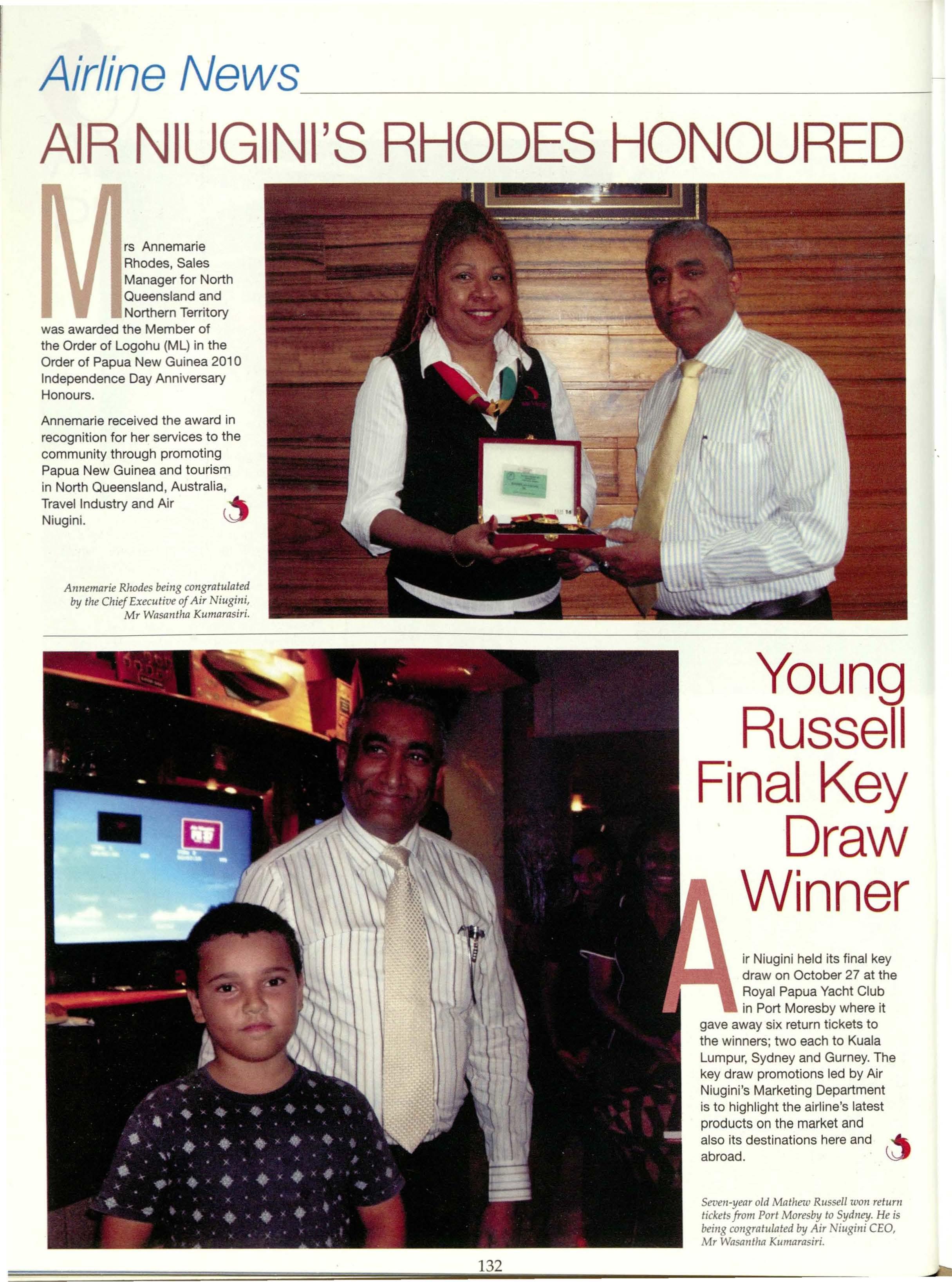
ir Niugini held its final key draw on October 27 at the Royal Papua Yacht Club in Port Moresby where it gave away six return tickets to the winners; two each to Kuala Lumpur, Sydney and Gurney. The key draw promotions led by Air Niugini's Marketing Department is to highlight the airline's latest products on the market and also its destinations here and • abroad. V
Seven-yearold Mathew Russell won return ticketsfrom Port Moresby to Sydney. He is being congratulatedby Air iugini CEO, Mr Wasant}raKumarasiri.
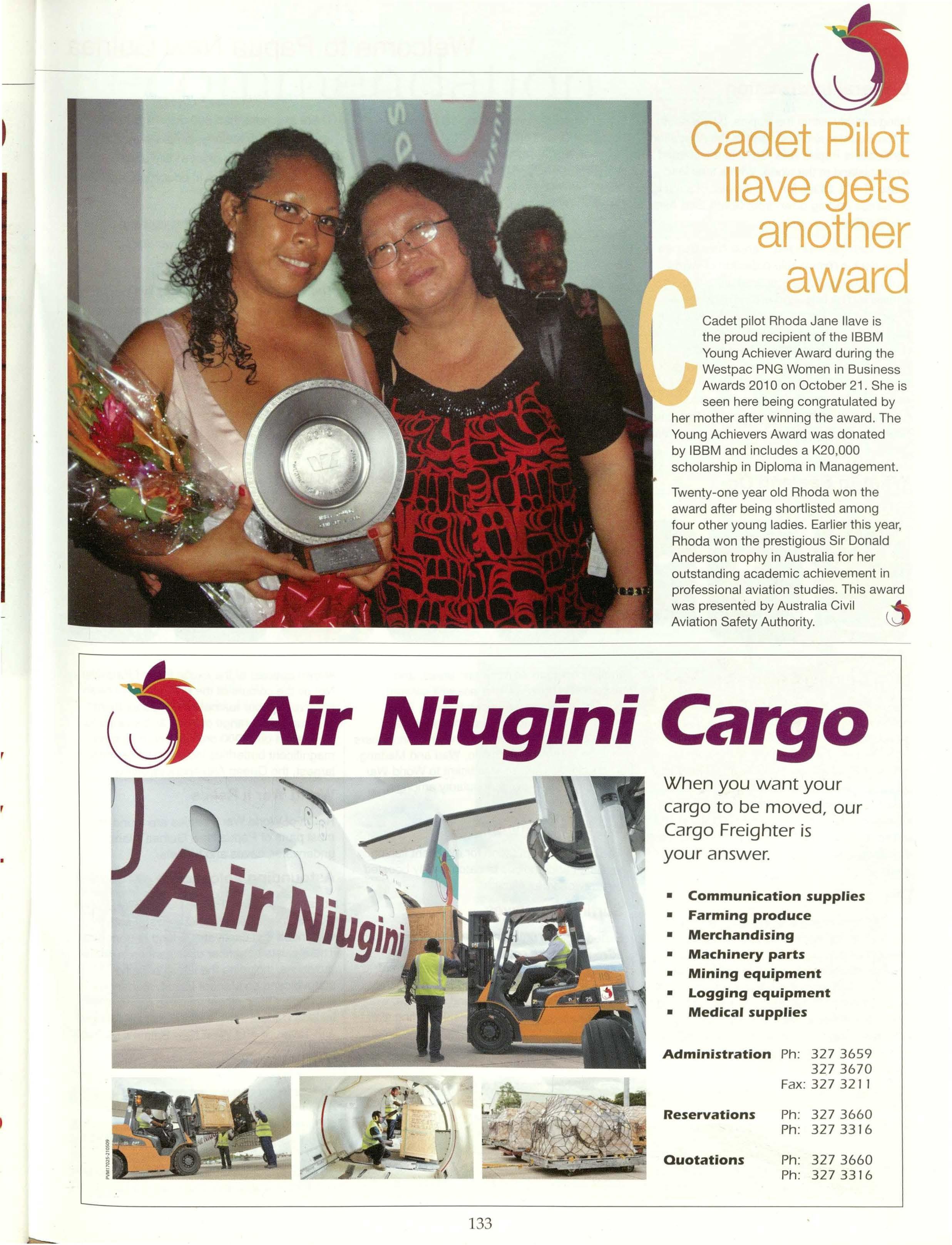
Cadet pilot Rhoda Jane llave is the proud recipient of the IBBM Young Achiever Award during the Westpac PNG Women in Business Awards 201 O on October 21. She is seen here being congratulated by her mother after winning the award. The Young Achievers Award was donated by IBBM and includes a K20,000 scholarship in Diploma in Management.
Twenty-one year old Rhoda won the award after being shortlisted among four other young ladies. Earlier this year, Rhoda won the prestigious Sir Donald Anderson trophy in Australia for her outstanding academic achievement in professional aviation studies. This award was presented by Australia Civil ._ Aviation Safety Authority. V
When you want your cargo to be moved, our Cargo Freighter is your answer.
Communication supplies
Lying entirely within the tropics, barely south of the Equator and just north of the Australian continent is Papua New Guinea, the second largest island in the world. With a total land mass of 473.189sq.km it is the last of a string of Islands spilling down from South East Asia into the Pacific.
Apart from the mainland, Papua New Guinea comprises a remarkable collection of islands, atolls and coral reefs scattered around its coastline. The mainland is divided by the Owen Stanley Range-a rugged central spine with peaks over 4,000 metres high. Great rivers begin their journey to the sea from these mountains-among them, Fly and Sepik waterways. Below the mountain chain, fertile coastal plains, flooded delta regions and mangrove swamps exist alongside broad sandy beaches, sheltered bays and dense rain forests.
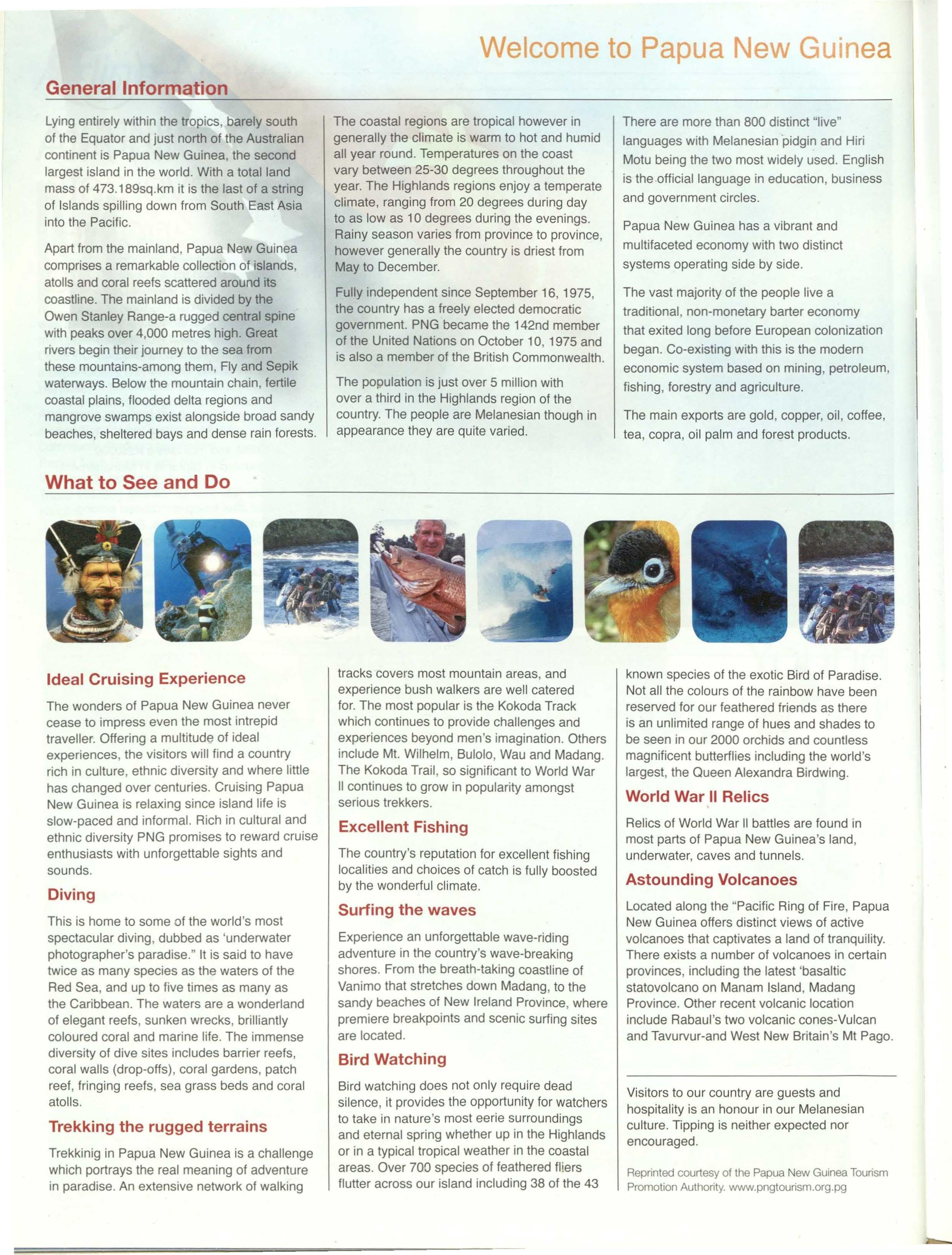
The wonders of Papua New Guinea never cease to impress even the most intrepid traveller. Offering a multitude of ideal experiences, the visitors will find a country rich in culture, ethnic diversity and where little has changed over centuries. Cruising Papua New Guinea is relaxing since island life is slow-paced and informal. Rich in cultural and ethnic diversity PNG promises to reward cruise enthusiasts with unforgettable sights and sounds.
This is home to some of the world's most spectacular diving, dubbed as 'underwater photographer's paradise." It is said to have twice as many species as the waters of the Red Sea, and up to five times as many as the Caribbean. The waters are a wonderland of elegant reefs, sunken wrecks, brilliantly coloured coral and marine life. The immense diversity of dive sites includes barrier reefs, coral walls (drop-offs), coral gardens, patch reef, fringing reefs, sea grass beds and coral atolls.
Trekkinig in Papua New Guinea is a challenge which portrays the real meaning of adventure in paradise. An extensive network of walking
The coastal regions are tropical however in generally the climate is warm to hot and humid all year round. Temperatures on the coast vary between 25-30 degrees throughout the year. The Highlands regions enjoy a temperate climate, ranging from 20 degrees during day to as low as 1O degrees during the evenings. Rainy season varies from province to province, however generally the country is driest from May to December.
Fully independent since September 16, 1975, the country has a freely elected democratic government. PNG became the 142nd member of the United Nations on October 10, 1975 and is also a member of the British Commonwealth.
The population is just over 5 million with over a third in the Highlands region of the country. The people are Melanesian though in appearance they are quite varied.
There are more than 800 distinct "live" languages with Melanesian ·pidgin and Hiri Motu being the two most widely used. English is the.official language in education, business and government circles.
Papua New Guinea has a vibrant and multifaceted economy with two distinct systems operating side by side.
The vast majority of the people live a traditional, non-monetary barter economy that exited long before European colonization began. Co-existing with this is the modern economic system based on mining, petroleum, fishing, forestry and agriculture.
The main exports are gold, copper, oil, coffee, tea, copra, oil palm and forest products.
tracks covers most mountain areas, and experience bush walkers are well catered for. The most popular is the Kokoda Track which continues to provide challenges and experiences beyond men's imagination. Others include Mt. Wilhelm, Bulolo, Wau and Madang. The Kokoda Trail, so significant to World War II continues to grow in popularity amongst serious trekkers.
The country's reputation for excellent fishing localities and choices of catch is fully boosted by the wonderful climate.
Experience an unforgettable wave-riding adventure in the country's wave-breaking shores. From the breath-taking coastline of Vanimo that stretches down Madang, to the sandy beaches of New Ireland Province, where premiere breakpoints and scenic surfing sites are located.
Bird watching does not only require dead silence, it provides the opportunity for watchers to take in nature's most eerie surroundings and eternal spring whether up in the Highlands or in a typical tropical weather in the coastal areas. Over 700 species of feathered fliers flutter across our island including 38 of the 43
known species of the exotic Bird of Paradise. Not all the colours of the rainbow have been reserved for our feathered friends as there is an unlimited range of hues and shades to be seen in our 2000 orchids and countless magnificent butterflies including the world's largest, the Queen Alexandra Birdwing.
Relics of World War II battles are found in most parts of Papua New Guinea's land, underwater, caves and tunnels.
Located along the "Pacific Ring of Fire, Papua New Guinea offers distinct views of active volcanoes that captivates a land of tranquility. There exists a number of volcanoes in certain provinces, including the latest 'basaltic statovolcano on Manam Island, Madang Province. Other recent volcanic location include Rabaul's two volcanic cones-Vulcan and Tavurvur-and West New Britain's Mt Pago.
Visitors to our country are guests and hospitality is an honour in our Melanesian culture. Tipping is neither expected nor encouraged.
Reprinted courtesy

1. Obtain "A Welcome Guide to Port Moresby" - the most comprehensive and up-to-date information source containing everything you need to know to be successful in PNG, and how to manage and enjoy your business and private life.
2. Talk to BSP today.
A new environment is a challenge to work and live in. It can be difficult to know which bank can provide you the security and banking services you'll need.
BSP can help you make the most out of your PNG experience. Bank with confidence with the largest bank in Papua New Guinea.
With more knowledge of the PNG environment and global expertise, we are your bank.
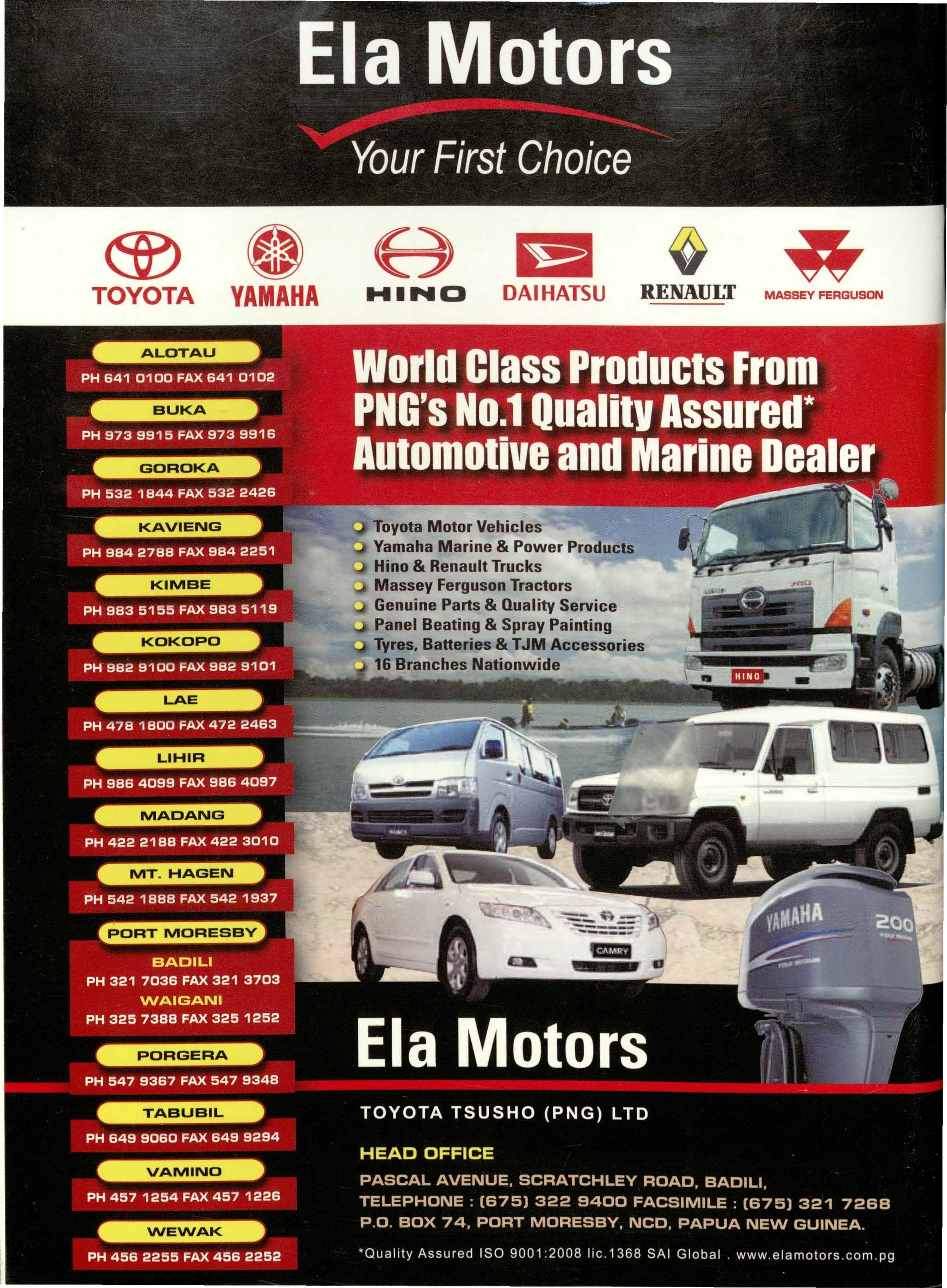
Toyota Motor Vehicles
Yamaha Marine & Power Products
Hino & Renault Trucks
Massey Ferguson Tractors
Genuine Parts & Quality Service
Panel Beating & Spray Painting
Tyres, Batteries & TJM Accessories
16 Branches Nationwide